Discusses Life, Humanity & Passion
The Designs of Pietro Frua
A Paradoxical Harmony of Proportion

























Amanda Stre on’s Life at Speed Packard Performance at its Peak THE
PEBBLE
® Celebrating
BEACH CONCOURS d ’ELEGANCE
the Life & Legacy of the Automobile JACKY ICKX
SPEEDSTER
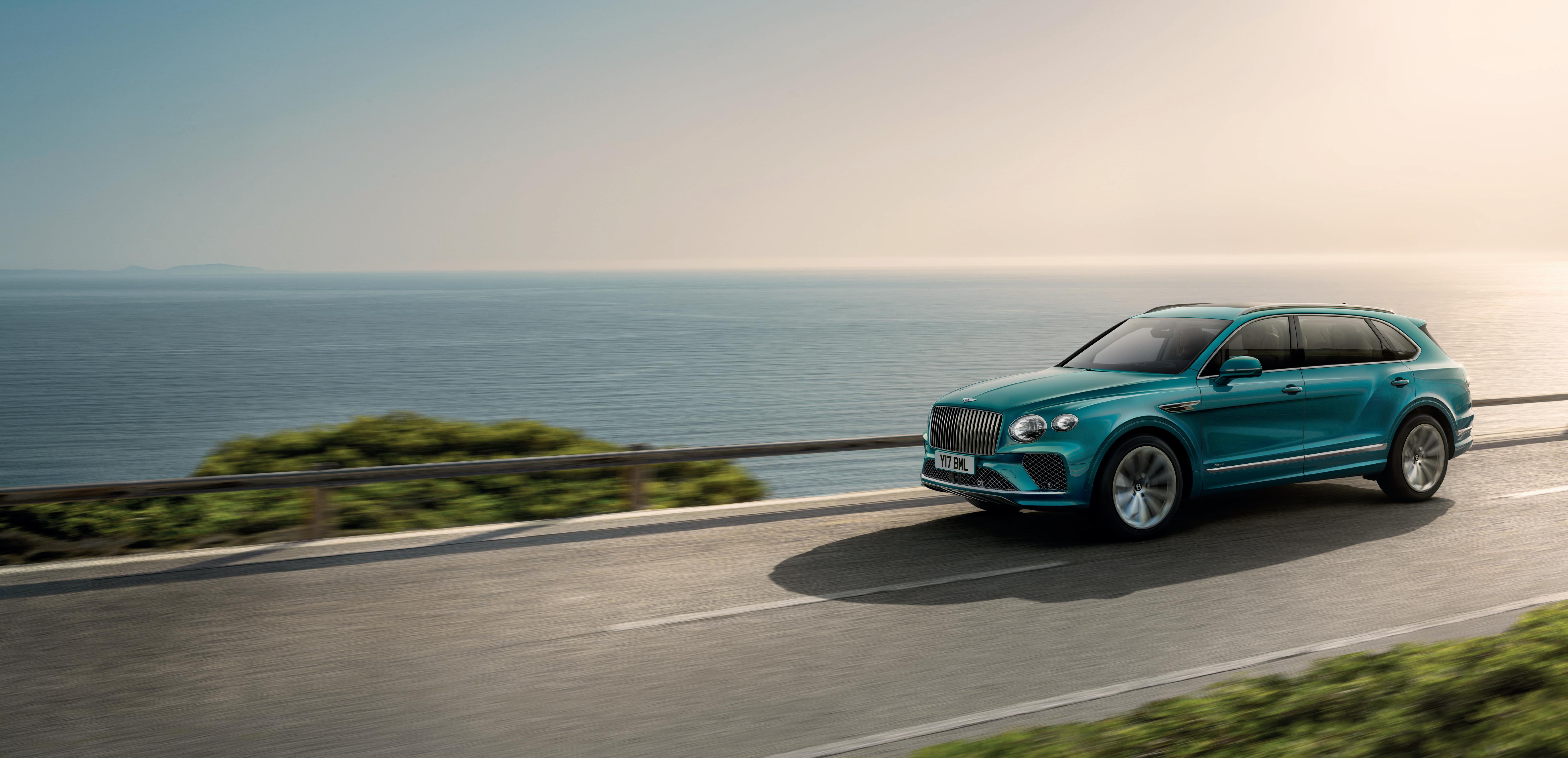

Let the journey inspire you. Discover the Bentayga Extended Wheelbase. Visit BentleyMotors.com to learn more. The name ‘Bentley’ and the ‘B’ in wings device are registered trademarks. © 2024 Bentley Motors Inc. Model shown: Bentayga EWB Azure
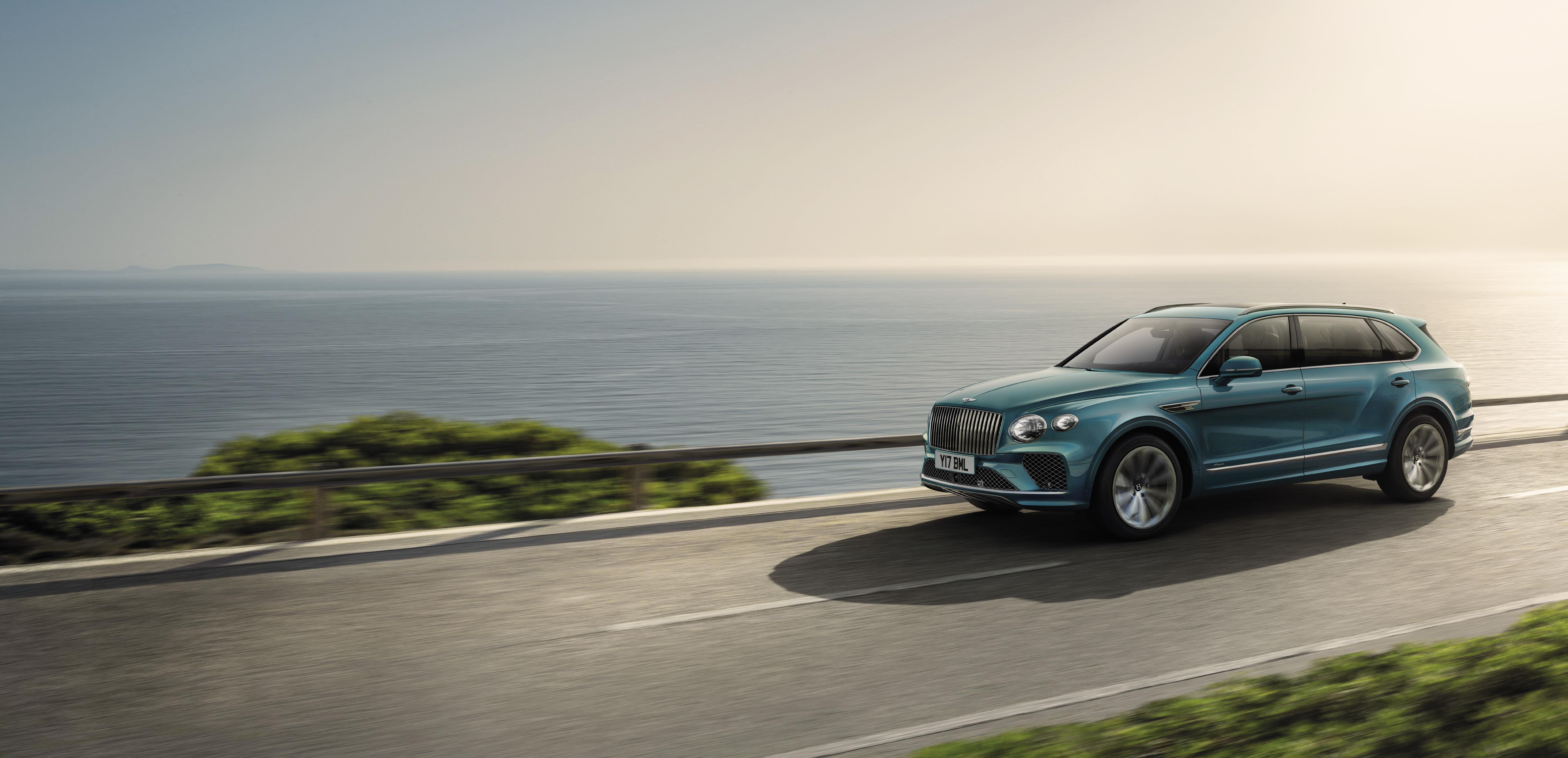
PROUD SPONSOR OF THE 2024 PEBBLE BEACH CONCOURS D’ELEGANCE®





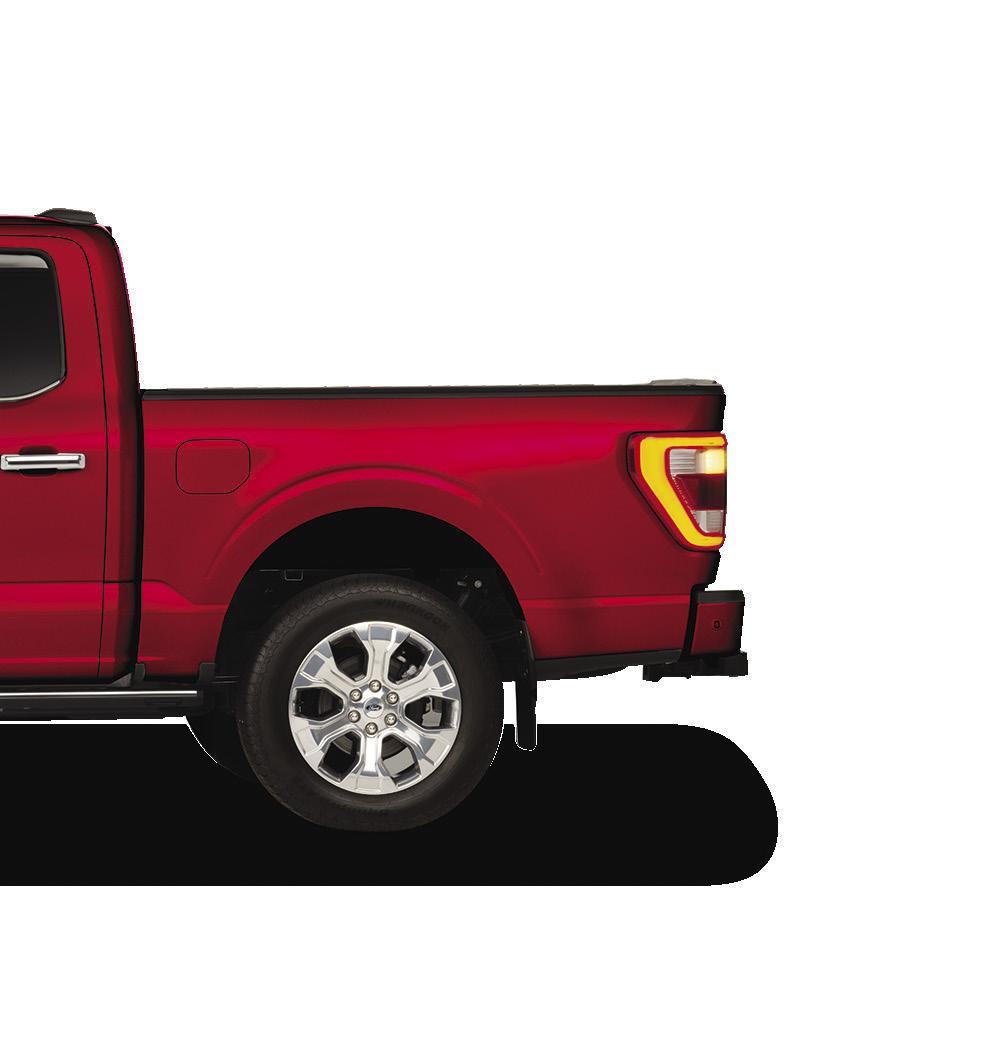
It’s true. We’re dedicated to preserving all kinds of vehicles — from your daily driver to your collector car. Our iconic FloorLiner is laser measured for a custom fit to your exact make and model, providing complete cutting-edge defense. At WeatherTech, we make protection personal.
© 2024 MacNeil IP LLC Pebble Beach Concours d’Elegance® is a trademark and service mark of Pebble Beach Company. Used by permission. Made in USA
WE DON’T PLAY FAVORITES
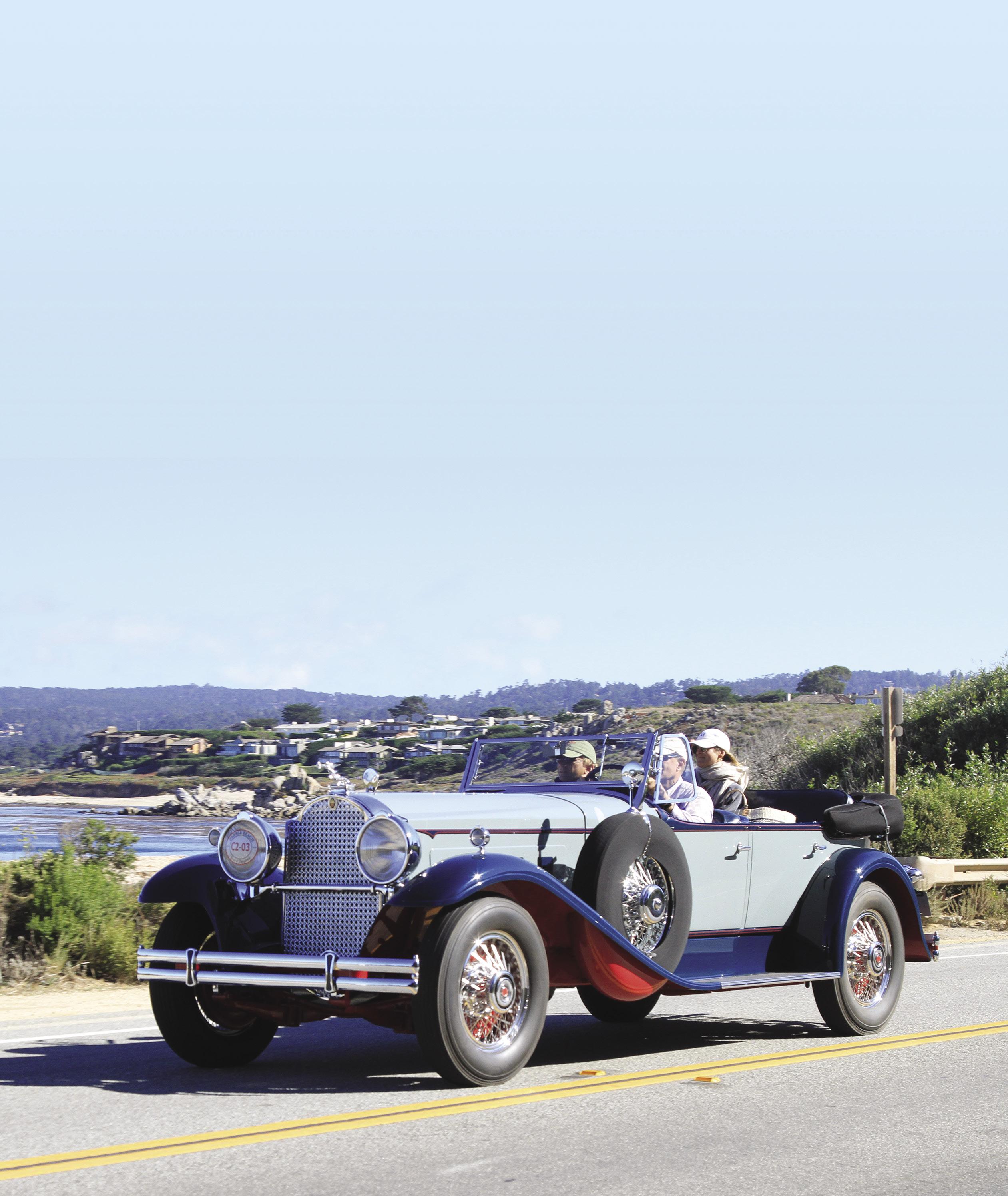
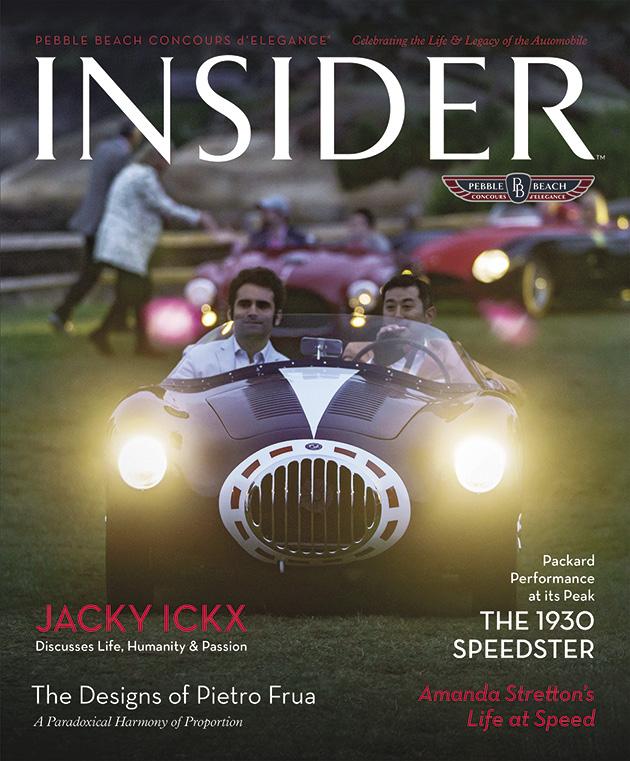
10 My Life in Cars Jacky Ickx: Monsieur Le Mans 20 The 1930 Speedster Packard Performance at its Peak 28 Behind the Wheel From Vision to Velocity Invitational 37 Pietro Frua Now You See Me, Now You Don’t 46 All in the Details BPR: Rescuing, Restoring & Racing the Supercars of the 1990s 54 Masters of the Wedge An Introduction to the People who Reshaped the Cars We Drive 64 Our Master of Ceremonies Amanda Stretton’s Life at Speed 73 The Next Generation of Enthusiasts Aloisa Ruf 78 The Oberoi Concours in India Celebrating Generations of Automotive Style 89 Gooding & Company Celebrating a 20-Year Partnership 20 The epitome of elegance and excitement, Paul Gould’s 1930 Packard 734 Speedster Eight Phaeton traces the coast on the 2015 Pebble Beach Tour d’Elegance. CONTENTS Summer 2024 pebblebeachconcours.net On the Cover Hidetoma
1953
2018 Pebble
Pebble Beach Concours d’Elegance INSIDER 3
Kimura’s Frua-bodied
OSCA MT4 Spyder pulls onto the
Beach Concours show field.


CONTENTS Summer 2024 pebblebeachconcours.net DEPARTMENTS 84 Four for the Road Cars in the Lives of Four Pebble Beach Insiders 94 Social Seen See & Be Seen at Pebble Beach Automotive Week 102 Time & Place The Event Calendar for 2024 Pebble Beach Automotive Week 104 Our Shared Legacy Changing Lives & Caring for Great Cars 64 Our new
the start of the 25th Pebble Beach Tour d’Elegance in 2023. 89
4 Pebble Beach Concours d’Elegance INSIDER
Master of Ceremonies, Amanda Stretton, eagerly awaits
In 2012, Gooding & Company famously sold the ex-Baroness von Krieger 1936 Mercedes-Benz 540 K Special Roadster at Pebble Beach.
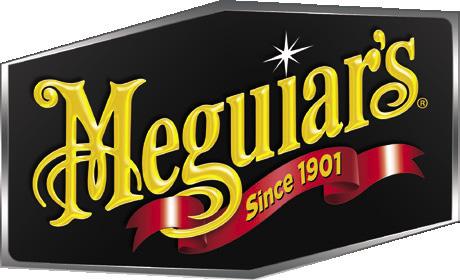


PASSION – This is ultimately the driving force behind who we are. We are more than a brand; we are a team of car enthusiasts with a desire to develop the best car care products possible while creating and fostering authentic connections with others who also share a love for cars. For free personal car care advice, visit Meguiars.com Fueling passion for the lifestyle, since 1901. O cial Car Care of Pebble Beach Concours d’Elegance® Pebble Beach,® Pebble Beach Concours d’Elegance,® Pebble Beach Concours d’Elegance® logo are trademarks and service marks of Pebble Beach Company. Used by permission. ©2024 Meguiar’s Inc.
Several weeks back, as I was preparing a presentation about the Pebble Beach Concours d’Elegance, past and present, one seemingly small historic detail captured my attention in a new way—something I had long known but hadn’t recognized as important.
It was this: One year into their tenure, in 1973, our thennew Co-Chairmen Lorin Tryon and Jules “J.” Heumann established an ongoing class for Ferrari, a relatively young marque then in its mid-twenties.
To put this in context, the British marques of Rolls-Royce and Bentley had ruled this Concours for most of the prior two decades, often comprising two or three—or even as many as five (!) classes. The only other marque with an ongoing class of its own was Duesenberg, an American Classic added by Lorin and J. in their inaugural year.
Even that had signaled a change. But I was struck by how brave and forward-thinking it was for those two men to add Ferrari next, over fifty years back.
Their decision heartens me.
Gauging the proper pace of change is never easy, and I find myself constantly pondering whether we are moving too slowly or too quickly toward the future.
The past few decades have witnessed more breadth in the types of cars we showcase—from hot rods to microcars, along with more competition cars and preservation gems—and the mix of cars has shifted gradually from a predominance of prewar creations to a nearly equal number of postwar designs. But until recently, with very few exceptions, most of the postwar cars in our competition predated the mid-1970s.
Last year, the classes for Porsche, Lamborghini and McLaren pushed well past this creation date. This year, all of the BPR & FIA GT Race Cars date from the mid-tolate-1990s, and our Wedge classes extend all the way from the 1950s to 2017. (The latter two features bubbled up from our Selection Committee, where about a third of the members are at or under age 50. Our newest member is Jonathan Sierakowski, who is featured in the “Four for the Road” piece in this Insider.)
When we say the Pebble Beach Concours celebrates the whole of automotive history, we do!
The same breadth is not yet represented in our Best of Show selections, but I trust that will come. I know we are making progress; our 2023 winner included a preserved rumble seat, and a fully-preserved 1932 Alfa Romeo 8C 2300 Corto

Figoni Cabriolet was a Best of Show Nominee. Nominees in recent years have also included more postwar cars.
Meanwhile, without diluting their expertise, our corps of Judges is gradually shifting to include a more youthful contingent and more women.
To help guide us through these changing times, we have strengthened our Advisory Board with the addition of Camilla Brauer, a civic and cultural leader and a devoted philanthropist from St. Louis, Missouri, and David Sydorick, a retired investment banker and significant car collector from Beverly Hills, California.
I can’t wait to see where our Advisors, our Selection Committee members, our Entrants and Judges, and our devoted enthusiasts and supporters lead us in the future.
We also look to the example of other events forging a new path in the collector car world—events such as the Velocity Invitational just north of us at the Sonoma Raceway, where family is much of the focus, and The Oberoi Concours d’Elegance in India, where they dared to host a class for cars of the masses. You can read about both in this Insider.
As an event steeped in tradition, we have perhaps moved just a bit too gingerly at times. Thinking of Lorin and J., I feel emboldened to accelerate the pace.
I hope you will join us on the journey.
Sincerely,
Sandra Button Chairman
LETTER FROM THE CHAIRMAN
6 Pebble Beach Concours d’Elegance INSIDER
A personal butler, Jordan Chettiar, looks on as Sandra Button exits her room at The Oberoi Udaivilãs.
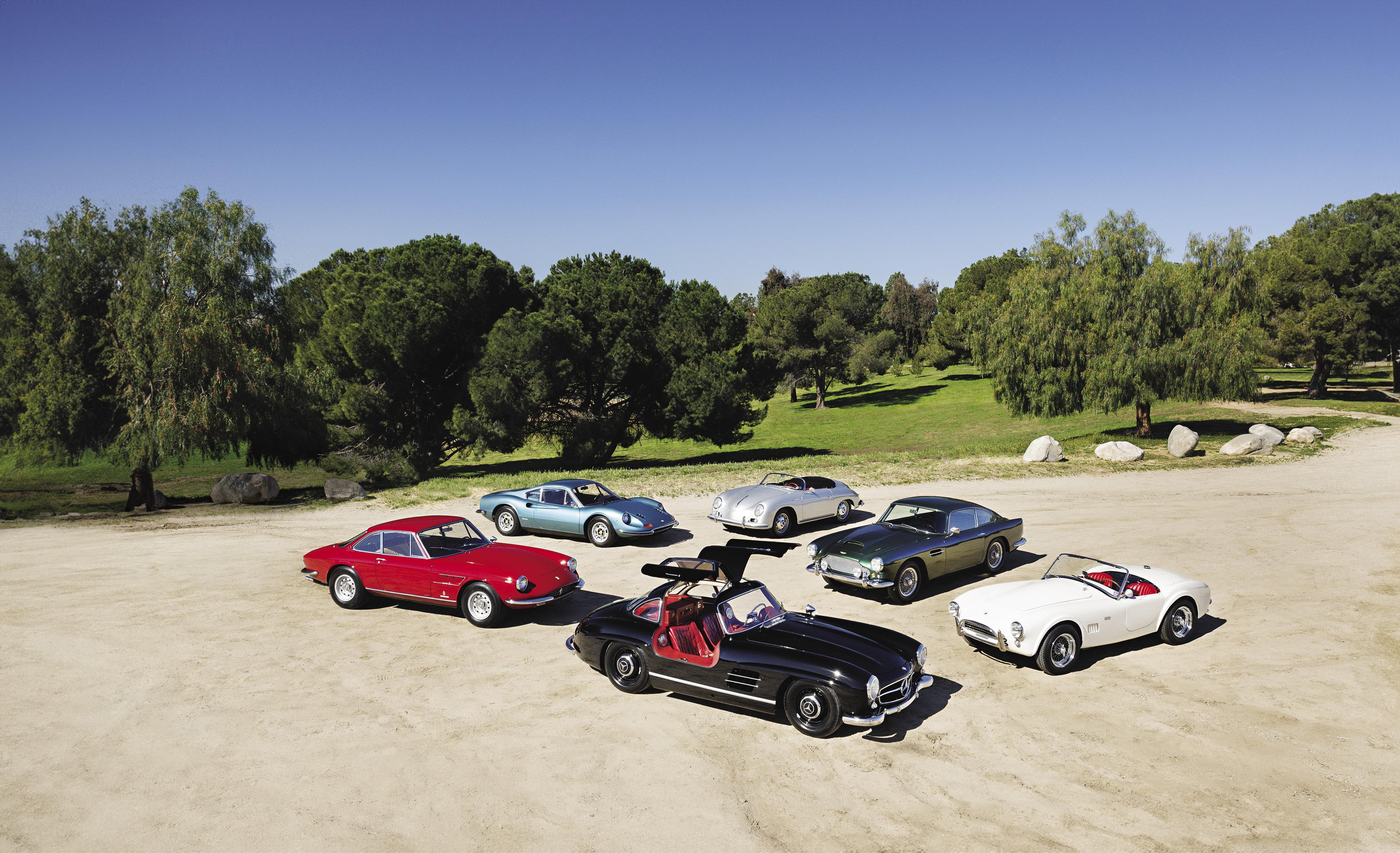
FRIDAY AUG 16
SATURDAY AUG 17 LIVE AUCTIONS
OFFICIAL AUCTION HOUSE OF THE PEBBLE BEACH CONCOURS D’ELEGANCE® Featuring Selections from THE TOM LARSEN COLLECTION Offered Without Reserve
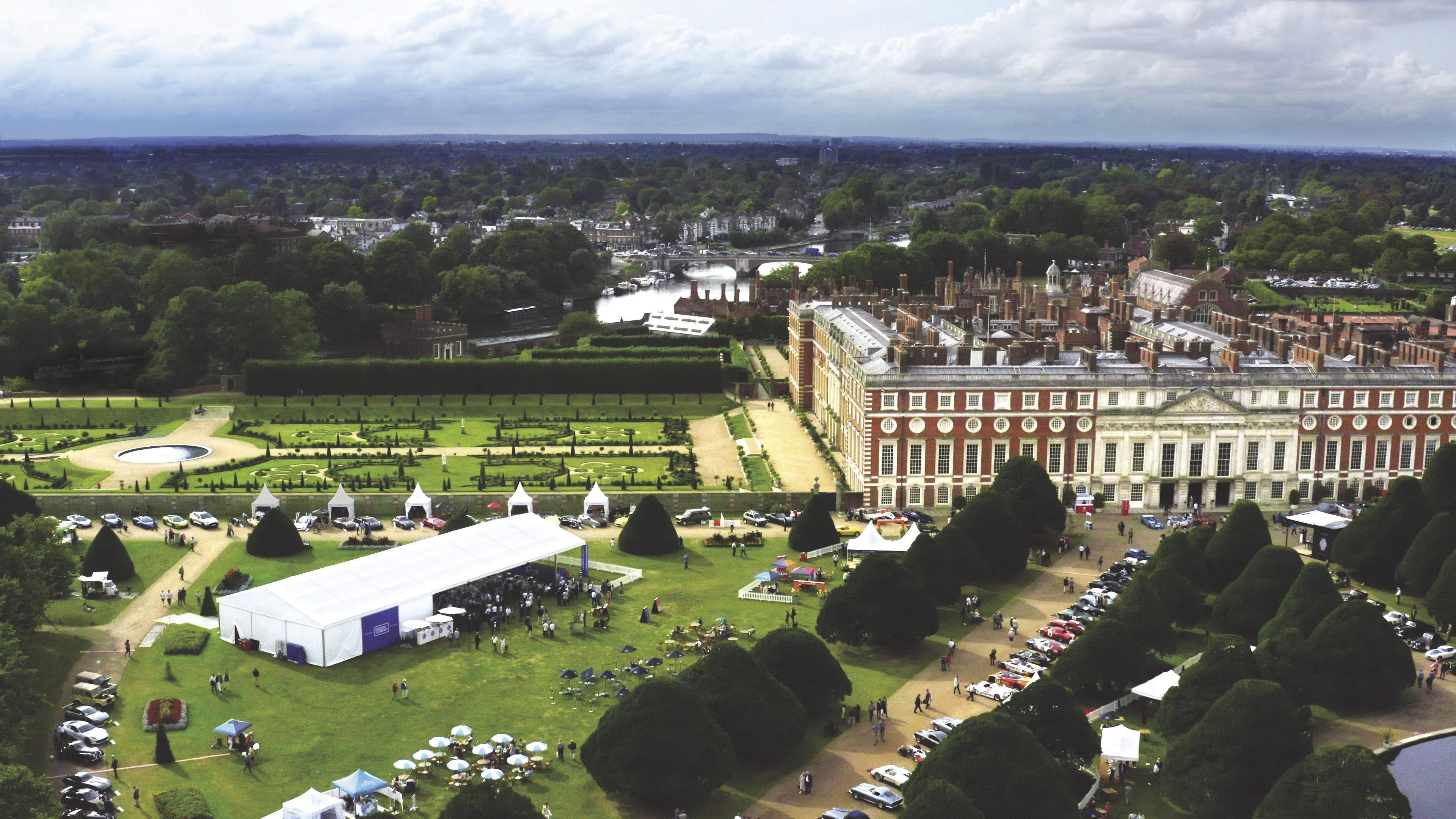
FRIDAY 30 AUGUST LIVE AUCTION
OFFICIAL AUCTION HOUSE OF THE CONCOURS OF ELEGANCE HAMPTON COURT PALACE
Now Inviting Consignments CONTACT OUR SPECIALISTS TO LEARN MORE: INQUIRY@GOODINGCO.COM Pebble Beach® and Pebble Beach Concours d’Elegance® are trademarks and service marks of Pebble Beach Company. Used by permission.
PUBLISHER
Pebble Beach Company
EDITOR-IN-CHIEF
Sandra Button
MANAGING EDITOR
Kandace Hawkinson
ART DIRECTOR & DESIGN
Nicole Doré
SENIOR EDITOR
Martin E. Button
PROOFREADERS
Tessa Avila & Robert Pruin
PRODUCTION
Chris Benzel

CONTRIBUTING WRITERS
Chris Bock has served as our Chief Judge since 2013 and is also a member of our Car Selection Committee. He attended his first Pebble Beach Concours d’Elegance back in 1963 at the young age of 18, he was first appointed a Class Judge a decade later, and he continued to serve among our Judges over the ensuing decades. He has also served as President and National Head Judge of the Classic Car Club of America and as editor of The Cormorant for The Packard Club.
Kate Constantin has edited Management Week and Business Age and has written for several other publications, including Financial Times and Computer Weekly. She loves and collects classic cars and makes Pebble Beach Concours d’Elegance the hub of her annual calendar.
Andrew Cotton has been reporting on endurance racing since 1995 and is the editor of the British publication Racecar Engineering. He is also an award-winning author, and regularly contributes to magazines in Germany, the US, and Japan.
Stefan Dierkes has been researching the life and work of Pietro Frua for three decades. He has written three monographs on the first Opel Kadett and Frua’s Glas GT and Glas V8, as well as more than 60 magazine articles and book chapters on Pietro Frua and his cars, and his website, www.pietro-frua.de, documents the more than 230 cars that Frua designed and built. He has served on the selection committee for six Frua exhibitions and won several concours trophies for his own Opel Kadett Frua Spider.
Peter Larsen has co-authored several books with Ben Erickson on French cars and coachbuilders, including works on Talbot-Lago, Jacques Saoutchik, and Jacques Kellner as well as an ongoing project about Joseph Figoni. The next installment in that series, which is about Bugattis that received bodies by Figoni, will be published in the fourth quarter of 2024. He judges at a number of international concours, including the Pebble Beach Concours d’Elegance, where he also serves on the Selection Committee.
Gautam Sen is the founder, editor, and author of several Indian auto magazines, as well as coconspirator on several vehicle projects with design greats such as Marcello Gandini, Tom Tjaarda and Gérard Godfroy, among others.
Ron Verschoor first attended the Pebble Beach Concours in 1989, he participated in the inaugural Motoring Classic in 2005, and he showed his 1935 Packard Twelve Brewster Limousine at Pebble Beach in 2017. He is a life member of the Classic Car Club of America and served as its editor for 12 years.
CONTRIBUTING PHOTOGRAPHERS & PHOTO ARCHIVES
Pebble Beach Company Lagorio Archives, with particular thanks for the work of photographer Julian P. Graham and William C. Brooks
Front Cover: Kimball Studios
Frontmatter: Bob Brown, Copyright and Courtesy of Gooding & Company, Sherman Chu, Kimball Studios
Sandra Button: The Oberoi Concours
Jacky Ickx: The Ickx Family (with thanks to Jon Saltinstall); Bernard Cahier/Getty Images; Motorsport Images: LAT Photographic; Motorsport Images: David Phipps/Sutton Images; Motorsport Images: William Murenbeeld/LAT Images; Motorsport Magazine; René Official Photographer (officialph.com, @ph.rene) courtesy of Octanium Experiences (octanium.ae, @ octanium); Kronos Events; Kimball Studios. Packard Speedster: Ron Verschoor Archives, Classic Car Club of America Museum, Brett Crannell, Kimball Studios
Velocity Invitational: Jeffrey O’Neill and Velocity Invitational: Genevieve Davis, Mike Noga (@Mikey Noga), Alex Penfold
Pietro Frua: All line drawings from Archive Roberto Rigoli; Photos (from front to end) from BMW Group Archive, Rudolfo Mailander, Archive Roberto Rigoli, Stefano
Bricarelli, Henry Manney III, Foto Torino, Archive Roberto Rigoli, Eberhard Seifert, Archive Stefan Dierkes, Gerd-Harald Laukat, Archive Peter Larsen, Archive OSCA
BPR Racing: John Brooks, Lanzante, Olivier Lyonnet/SRO Motorsports Group, Lee Maxted-Page, Cristiano Michelotto, Progressive Motorsport: Henry Wood & Veloqx
Masters of the Wedge: Archivio centrale dello Stato/Stile Bertone, Makarand Baokar, Serge Cordey, Jeffrey Dirkin, Italdesign, Pininfarina, Romana Rocca, Gautam Sen Archives
Amanda Stretton: Amanda Stretton Archives, Sherman Chu, Motorsport Images: Jeff Bloxham/LAT Images, Motorsport Images: Gareth Evans, Motorsport Images: Malcolm Griffiths
Aloisa Ruf: Aloisa Ruf & the Ruf Family, highsnobiety, Kimball Studios
Oberoi Concours: The Oberoi Concours, Makarand Baokar, Sanket Patel
Four for the Road: Sherman Chu, Cristina Cheever, Kimball Studios
Gooding & Company: Copyright and Courtesy of Gooding & Company, Kimball Studios
Social Seen: Deema Barsky, Sherman Chu, Kimball Studios
Legacy Giving: Kimball Studios, Rancho Cielo
Pebble Beach®, Pebble Beach Resorts®, Pebble Beach Concours d’Elegance®, Pebble Beach Concours™, Pebble Beach Tour d’Elegance®, Pebble Beach RetroAuto™, Pebble Beach Classic Car Forum™, Pebble Beach® Automotive Week, Pebble Beach Golf Links®, The Hay™ Golf Course, The Lodge at Pebble Beach™, The Inn at Spanish Bay , The Links at Spanish Bay , Spanish Bay®, Casa Palmero®, 17-Mile Drive®, The Lone Cypress™, Stillwater Cove™, and their respective underlying images, are trademarks, service marks and trade dress of Pebble Beach Company. Copyright © 2024 Pebble Beach Company. All rights reserved.
Printed in Canada by Hemlock Printers

2024 Mercedes-Maybach EQS680 SUV shown in Cirrus Silver and Nautical Blue paint. ©2024 Mercedes-Benz USA, LLC For more information, call 1-800-FOR-MERCEDES, or visit MBUSA.com. WELCOME TO BEYOND Beyond electric. Beyond luxury. Beyond anything you have ever experienced. The Mercedes-Maybach EQS SUV. Discover more at MBUSA.com/Maybach .

JACKY Monsieur
To protest the dangers of the traditional running start at the 24 Hours of Le Mans, Jacky Ickx (seen just above the marshal) walks calmly to his car in 1969, leaving last and eventually finishing first. The ensuing death on lap one of John Woolfe, who had not properly secured his safety equipment, proved the point.

ICKX Le Mans
by Kate Constantin
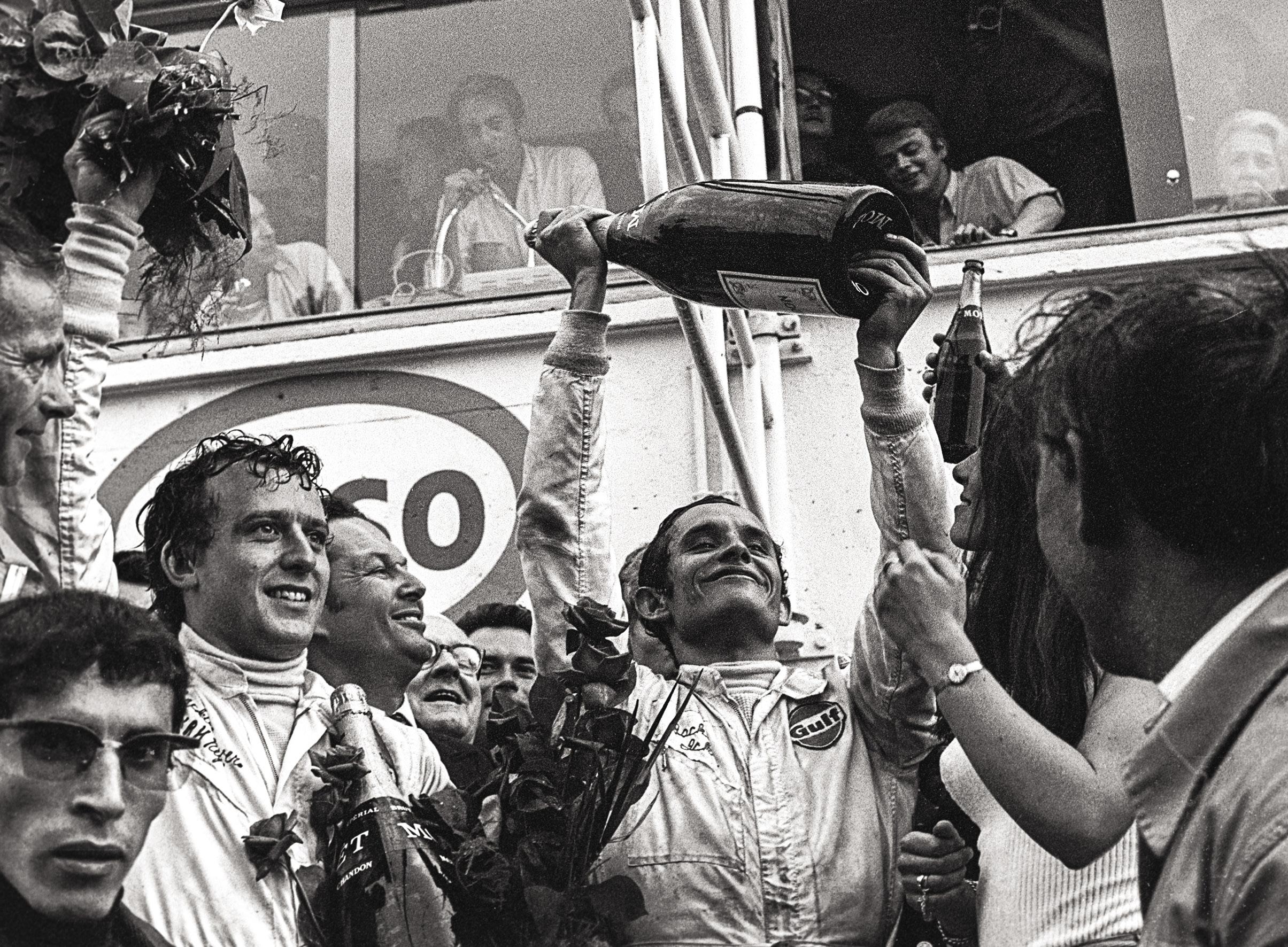
Belgium is famous for its waffles, beer, and chocolates, not to mention fictional detective Hercule Poirot. But to the automotive and sporting worlds, Jacky Ickx is among its greatest gifts.
Jacky won Le Mans six times. He took 25 podium positions in Formula One, with eight outright wins, and twice finished as runner-up in the World Drivers’ Championship. He was the Can-Am Champion in 1979 and drove to victory in the Paris-Dakar Rally of 1983.
When I sat down with Jacky at the Pebble Beach Concours in August 2023, where he was an Honorary Judge for the fourth time, he was reluctant to talk about his victories.
Instead, he regarded his racing career as the “starting grid” for a discussion of much bigger topics, such as life, humanity, and passion.
Kate Constantin: Jacky, you are notorious for not wanting to talk about the past, but we have to know, what’s your most important achievement? Le Mans, Formula One, Can-Am, Paris-Dakar?
Jacky Ickx: You are right, I don’t like to talk about the past. I am not concerned with history. I am not a nostalgic person; I do not have a single cup or trophy in my home. My greatest achievement is to still be here at 78 in good health. And it’s not because I was more skilled than anyone else—I was just lucky and had great people around me. But if you press me, probably the Paris-Dakar was the most important. That race gives you a whole different perspective.
You have run the Paris-Dakar Rally 13 times. You won in 1983 in a Mercedes-Benz 280 GE, with actor Claude Brasseur as your navigator, and you also ran the race with your daughter Vanina. Why is this race important to you?

12 Pebble Beach Concours d’Elegance INSIDER
JACKY ICKX
Never give up—that’s my mantra. And at the back of the pack, you have nothing to lose.
JACKY ICKX

The Paris-Dakar opens your eyes to the world, if you choose to look. Whereas Le Mans and the Formula One races give you a narrow, maybe 10-degree range of vision, the Paris-Dakar offers you a 180-degree perspective, both rhetorically and literally. You get to see people living around you in very different environments. We want the world to live like we do, with our values and morals, but different parts of the world run at their own speed, with their own culture and traditions. It’s important to recognize that. Travel is a great privilege and educator. We recently participated in the 1000 Miglia Experience through the United Arab Emirates, and again, it was a privilege to witness a different culture.
But running the Paris-Dakar with Vanina was wonderful. Driving with my daughter was a gift; we really got to know one another on a deeper level.
You continue to fill your life with new adventures. You are here at Pebble Beach as an Honorary Judge. Judging classics is a far cry from racing. How does it compare?
I love to be here with this amazing community. Sandra [Button, Chairman of the Concours] is a close friend of mine, and in the same way that Goodwood has its Duke of Richmond, this Concours has its Duchess of Pebble Beach. Sandra brings together thousands of people from different worlds and backgrounds, but with similar interests and passion. People are treated with grace, respect, and dignity, and everyone enjoys the day. And she is surrounded by a magnificent team.
You talk often about “the team.” Why so?
The team is paramount to one’s success. A race car driver is like the tip of the iceberg: all the light, and sometimes the rain, falls upon them. But beneath the surface is an army of people with equal if not more skill and passion. There is no “I” in success. There is only “we.” No one does it alone. You never heard Michael Schumacher say “I won the race,” it was always “we.” Listen to Lewis Hamilton: he knows it, too.
Opposite page: Jackie Oliver and Jacky Ickx celebrate their 1969 win at the Circuit de la Sarthe.
Pebble Beach Concours d’Elegance INSIDER 13
On the way to Jacky’s first World Championship Grand Prix victory, amidst the 1968 French Grand Prix, it poured. He soon earned the nickname “Rain Master.”
There is no ‘but’ for me about Enzo. He was a legend and my inspiration.
JACKY ICKX
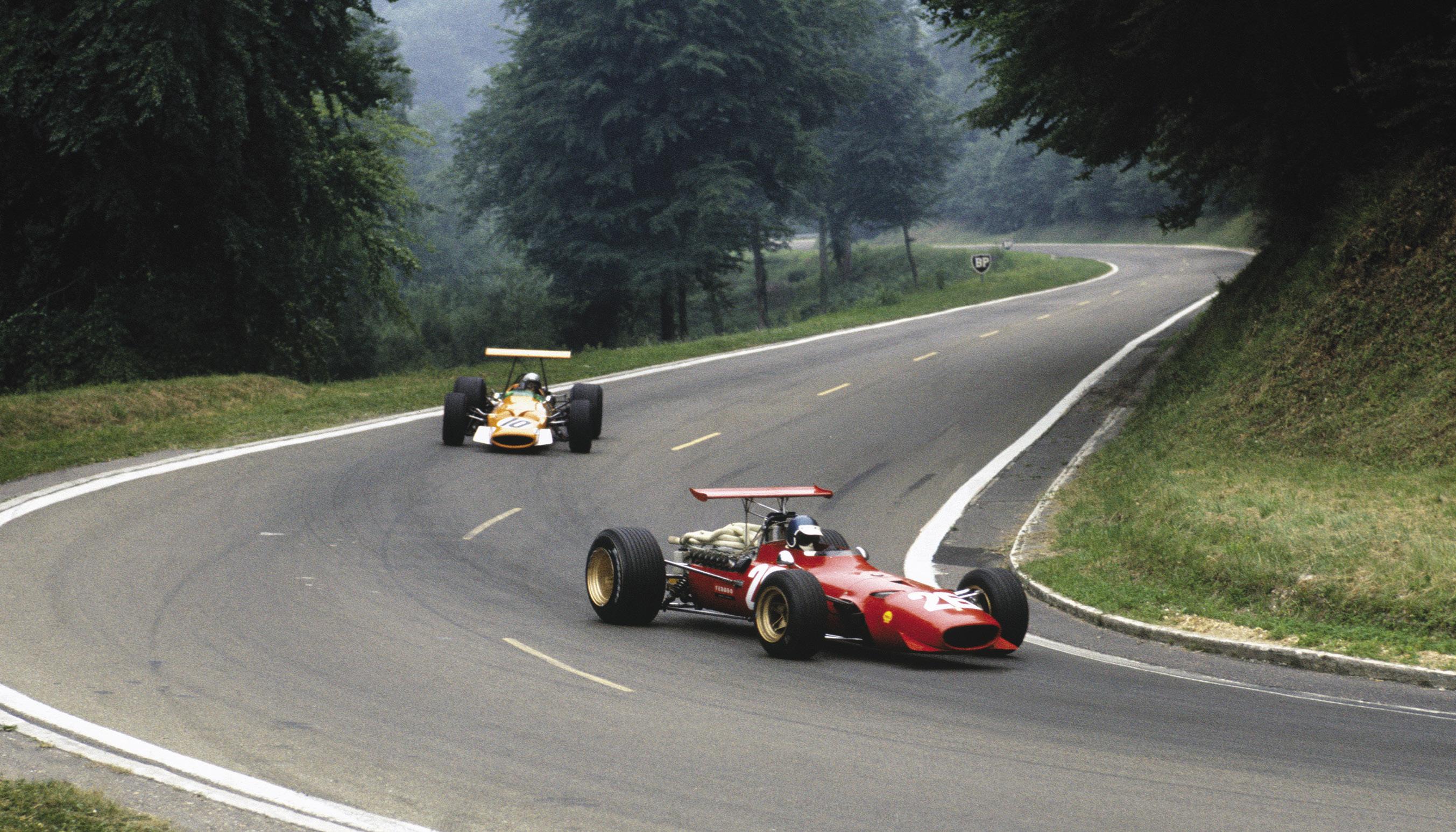
You have been the “tip of the iceberg” for a lot of teams over the years. One of your greatest teammates, Derek Bell, is here at Pebble. What’s it like to be reunited?
I have raced with them all: Jackie Stewart, Brian Redman, Jim Clark, Mario Andretti—all great guys. But Derek! He is one of my closest friends. He used to call me Young Brussel Sprout! We raced Le Mans together four times with three victories. He isn’t just a lovely man, he is a great driver. He and I were at Le Mans in 1975 driving the Gulf Mirage GR8, a very fragile car, and unbeknownst to us the chassis broke with six hours still to go. But with finesse and care we brought it in to win. Together as a team we never crashed a car; we may have grazed a wall, but we never lost a position or crashed out. That said, it was always a challenge to drive the same car as Derek, because he is very tall and has long arms and legs and I am shorter, so the crew would have to set up the car to fit us both. I could never brake as hard as Derek, because my legs were shorter. In those days you really worked the car: one hand on the shifter to change gears, one on the steering wheel, dancing with the pedals, no air-conditioned helmets. We got out of the cars wet and exhausted. Derek said I looked like a drowned rat! We were great teammates and we remain great friends.
For the Le Mans week in the 70s and 80s, you stayed in the nearby village of Le Chateau, together with other drivers and teams. What was that like?
The “fraternité” was amazing. The village was 43 km from the track, and the cars, which were registered with plates for the road, were in garages behind the hotel, so we would drive the cars back and forth to the track for practice. When practice was over at midnight, we would be in a hurry to get back to the hotel so we would drive home at top speed. People would come out onto the street at midnight and wait for us. That will never happen again—a bunch of race cars, including the GT40s, driving at 240 km/h (150 mph) on open public roads. We are, in a sense, dinosaurs of a bygone era.
Speaking of Le Mans, you were instrumental in getting the traditional Le Mans Start banned. [For that start, drivers would run across the track, start their cars, put on their helmets and safety belts, and then drive away—but invariably safety equipment was not fully secured when they set off.] In protest, in 1969, you walked across the track, got in your car, and fully secured your helmet and seat belts, entering the race at the back of the pack. You went on to win that race. Tell us why you were so adamant to change that rule.
JACKY ICKX
Jacky leads Bruce McLaren into a turn on his way to a win in the 1968 French Grand Prix at Rouen-Les-Essarts.
14 Pebble Beach Concours d’Elegance INSIDER
Opposite page (clockwise from top left): Young Jacky Ickx earns the 1965 Coupes de Belgique, besting all other Belgians; Jacky partnered with Derek Bell in a Gulf Research Racing Ford GR8 to win at Le Mans in 1975; Derek and Jacky celebrate their victory; Drivers switch amidst a pit stop in the 24 Hours of Le Mans in 1977.


The Le Mans Start was a beautiful thing. You had to be a good runner and a good driver to do well. But it was dangerous, and until that race in 1969, some people actually believed it was safer to be ejected from the car in a crash, than to stay in the cockpit. But for the record, I didn’t get the rule changed, John Woolfe did. He started the race in his Porsche 917, without his safety equipment secured. He crashed at La Maison Blanche on the first lap and was thrown from his car and died. If he had not crashed or I had come in second, not first, nothing would have changed, and I would probably have been fined or banned. His death resulted in the rule change; I do not own that privilege. In actual fact, what I did was quite dangerous because I nearly got run over by the oncoming cars as I walked across the track. I actually had to run the last few steps!
You have orchestrated several wins from the back of the pack. How do you do that?
Never give up—that’s my mantra. And at the back of the pack, you have nothing to lose. At that age you feel immortal and all nerves dissipate the minute you get in the car. In the 1977 Le Mans, Henri Pescarolo and I were driving the #3 Porsche 936, but the engine failed and
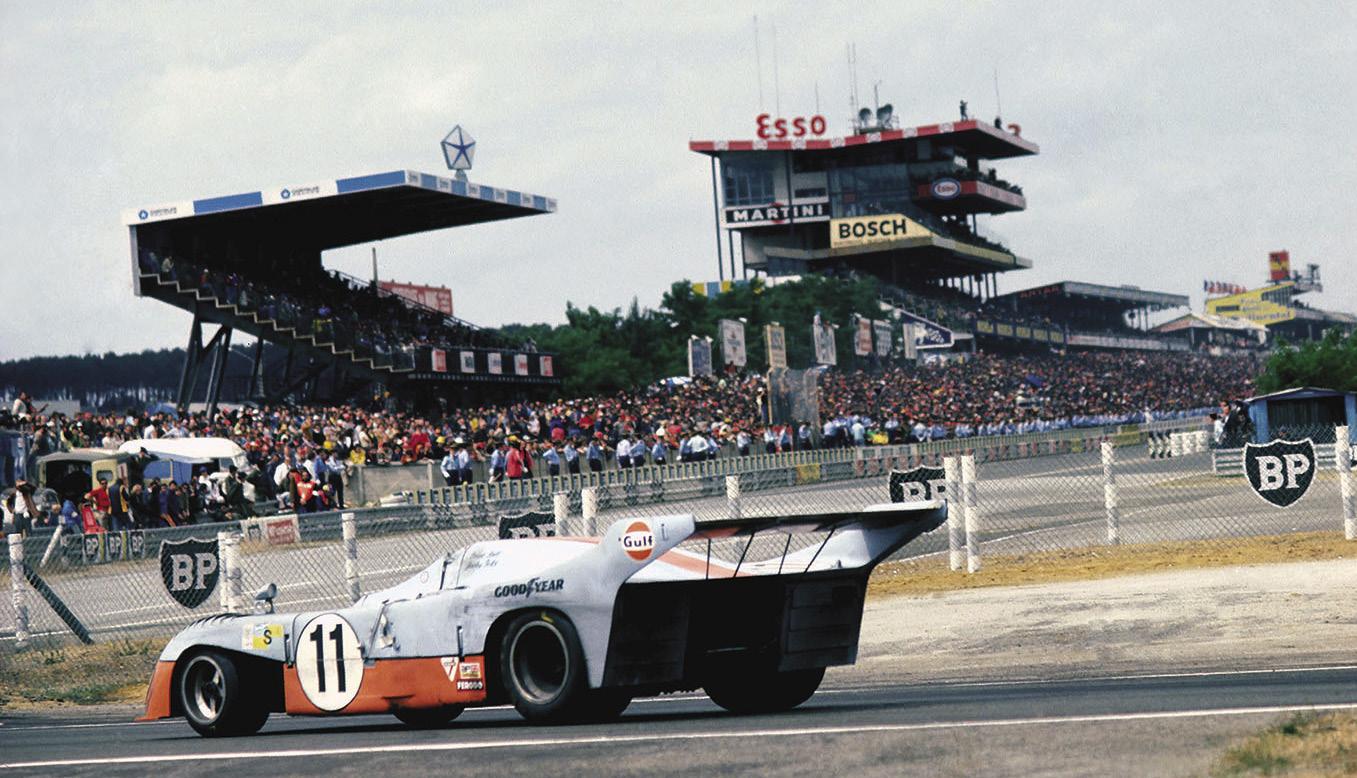

the car was retired after three hours. I was transferred to the sister car, #4 piloted by Jürgen Barth and Hurley Haywood, which was down in 41st place and 15 laps behind the frontrunners. It was essentially a lost cause. But, instead of being chased, you are now the hunter, and with nothing to lose, you can improve your position, lap by lap, one car at a time. You feel indestructible and every one on your team feels it too. The team was changing tires in half the usual time—we were flying. We went from 41st, to 20th, to 5th, to 2nd and then 1st. [Jacky beat the lap record at an average of 226.5 km/h (140.7 mph).] It was absolutely marvelous. There’s a point when you can see the podium as a possibility. Then there’s no stopping you.
What qualities did you need to be a race car driver in that era?
Skill, tenacity (the “never give up” syndrome), and you have to be a great team player. People ask about bravery, but it wasn’t a question of bravery. It was passion. All nerves disappeared when the race started, and we loved it. Was it risky? Yes! But the minute you focus on the risk you are beaten. Also, you had to be lucky. Many great, highly skilled drivers died because they weren’t lucky. Success in motor racing is an alchemy of skill, luck, timing, tenacity and teamwork.
Pebble Beach Concours d’Elegance INSIDER 15
Jacky, with Claude Brasseur in a Mercedes-Benz 180 GE, on his way to victory in the 1983 Paris-Dakar Rally. He loves the way the rally has stretched his perspective.

And let’s not pretend we did it for the money. In 1966, I was paid £50 for a Formula 3 race, and £100 for a Formula 2 race. We just loved the sport.
You have said you weren’t interested in racing cars as a kid, but you went on to race for 32 seasons. How did you become so dedicated to the sport?
It’s true. In 1953, my parents took me to see Juan Manuel Fangio race. I was 8 years old, and I thought it was boring. I would rather have stayed home. I thought I would become a gardener or a gamekeeper because I wanted to be alone and listen to the birds. I was a terrible student at school and would sit at the back of the class next to the radiator, looking out the window. My teachers told my parents, “He is intelligent, but lazy.” That was the polite way of saying “He’s a total disaster.”
So, my parents tried to motivate me, and when I was 16 they gave me a 50 cc motorcycle. For the first time in my life, I found I was good at something. I started with speed trials and enduro, and the rest is history. But I think my parents paid a very high price for that decision. I raced for 30 years and they suffered a lot, because as much as they wanted me to experience success, they often had
Everyone needs to dream, no matter how old you are and no matter how small your dreams are.
JACKY ICKX
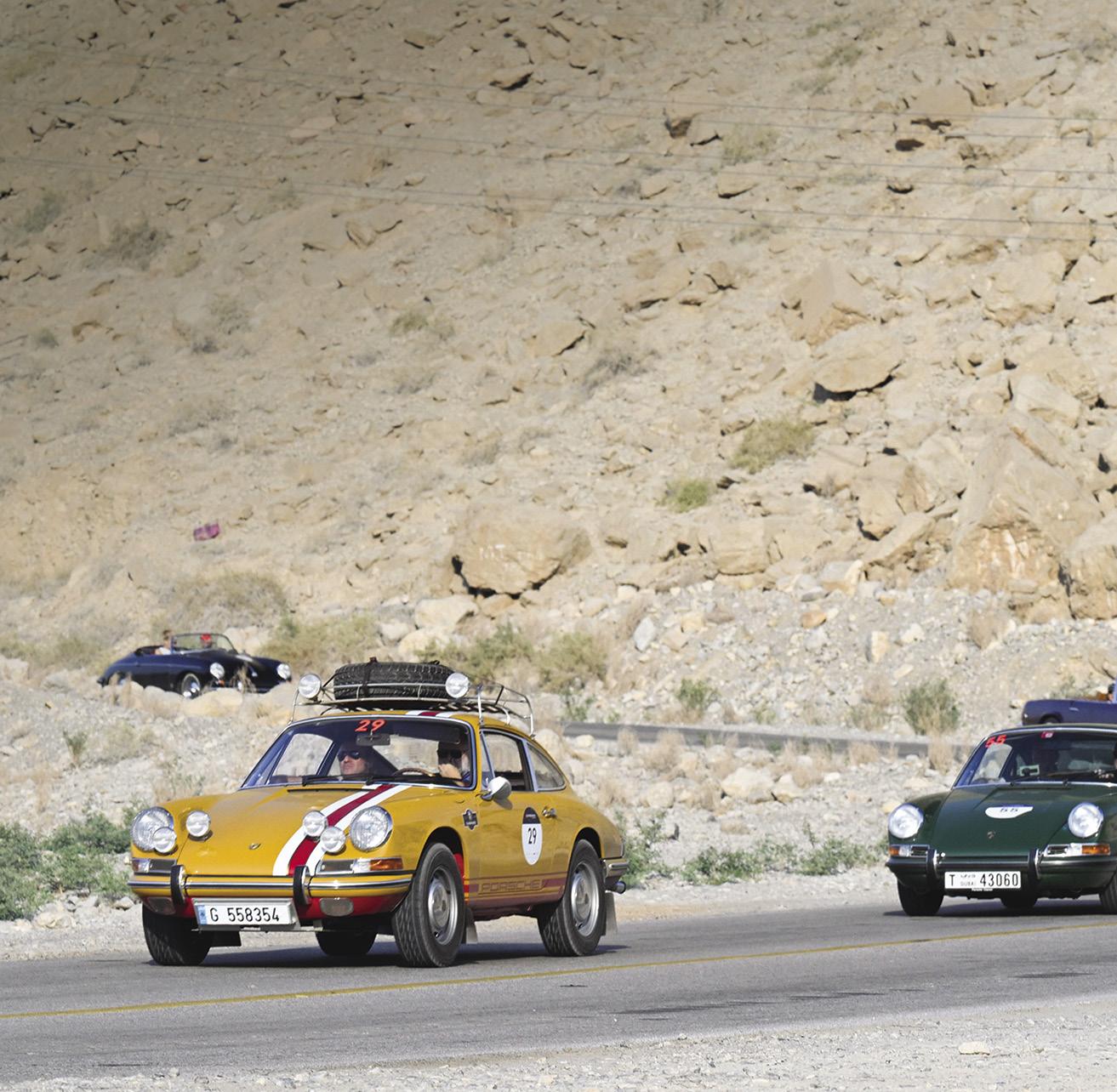
to wait until Monday for a telephone call to find out if I had survived the weekend. At that time the TV and radio coverage wasn’t what it is today. The families of racers make huge sacrifices.
You drove for Ferrari at the age of 25 and knew Enzo Ferrari quite well. What were your impressions of the man?
When people talk about Enzo they always say something like, “Enzo was a legend, but…” Well, I have no “but” for Enzo. Enzo Ferrari was considered by many to be distant and cold. He built up a reserve around people, because in the early years, the ’50s and ’60s, he was very close to his drivers and several of them died. By the time I arrived in 1968, he was more reserved and had put up walls to protect himself. He was a very tender person, and people do not see that. There is no “but” for me about Enzo. He was a legend and my inspiration.
Enzo Ferrari and Ken Tyrrell (founder of the Tyrrell Racing Organization and Formula One constructor) were the two most inspirational and pivotal people in my career. Ken signed me up to drive Formula 3 Mantras in 1966 when I was just 22 years old. He was my mentor and he had faith in me. He changed my life, much like Enzo did a few years later. Like I said, no one does this alone.
JACKY ICKX
16 Pebble Beach Concours d’Elegance INSIDER
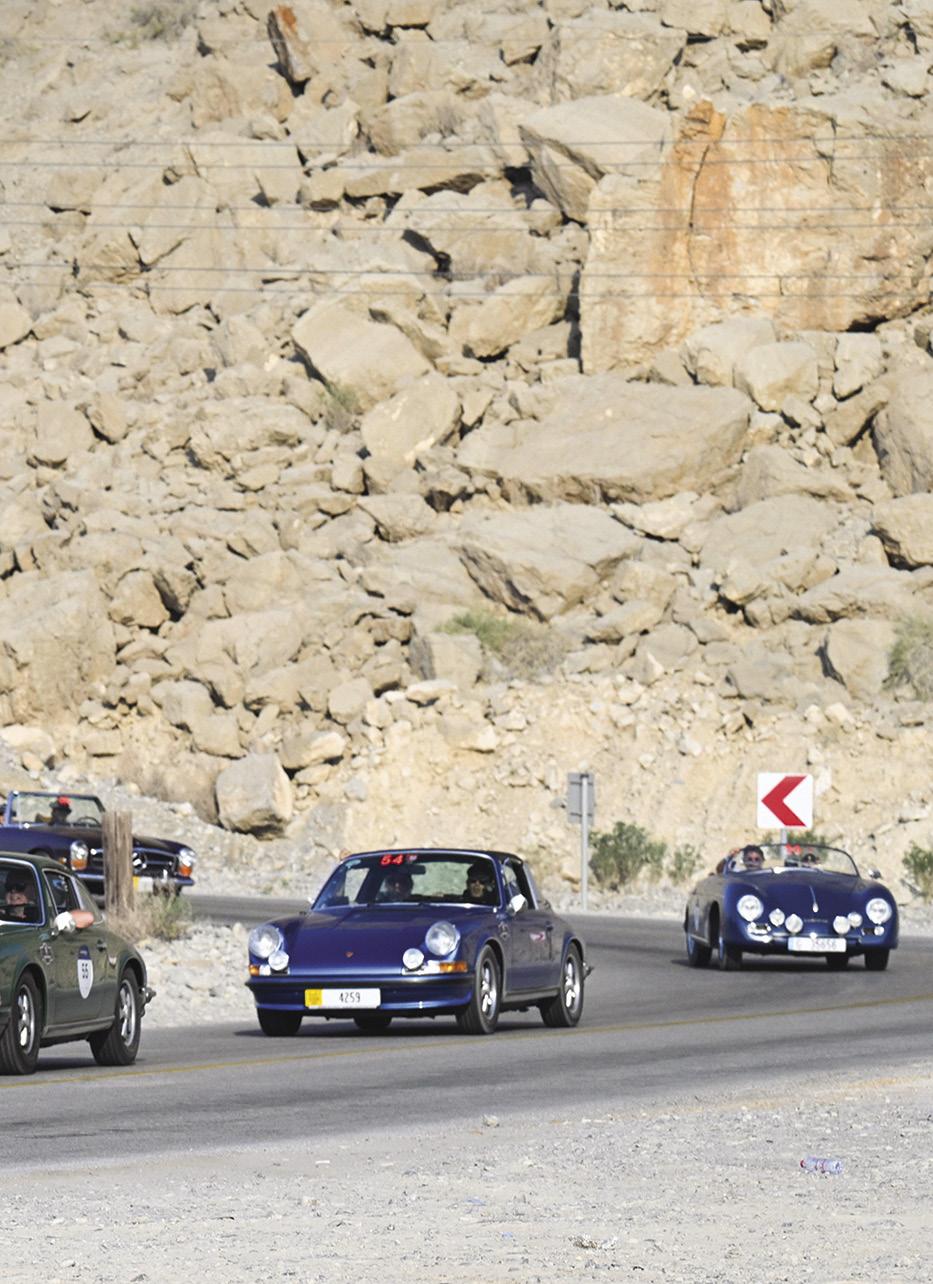

You drove almost every weekend at the height of your career—for Ferrari, Brabham, Lotus—and you participated in all kinds of racing, often simultaneously. How did you juggle the commitments?
It was a different time then and we could do pretty much whatever we wanted. There were 52 weekends in a year, so you would sign up for 10 races with your team, then on other weekends you could go saloon car racing, Formula 2, endurance, whatever you wanted to do. We all did it—Derek Bell, Jackie Stewart, Jim Clark, all of us. We drove for whomever would have us, because we just loved to race. Today, racers can’t do that, they are tied into a dedicated contract. We weren’t professionals, we were freelance mercenaries!
You have been named as an Honorary Citizen of Le Mans, inducted into the International Motorsports Hall of Fame and the Motorsports Hall of Fame of America, and you have a special edition Porsche 911, the Carrera 4S Belgian Legend, named for you. What’s next?
Who knows? More adventures, I hope. Everyone needs to dream, no matter how old you are and no matter how small your dreams are. I believe a man of my age has two choices . . . get bitter or get better. I choose the latter.
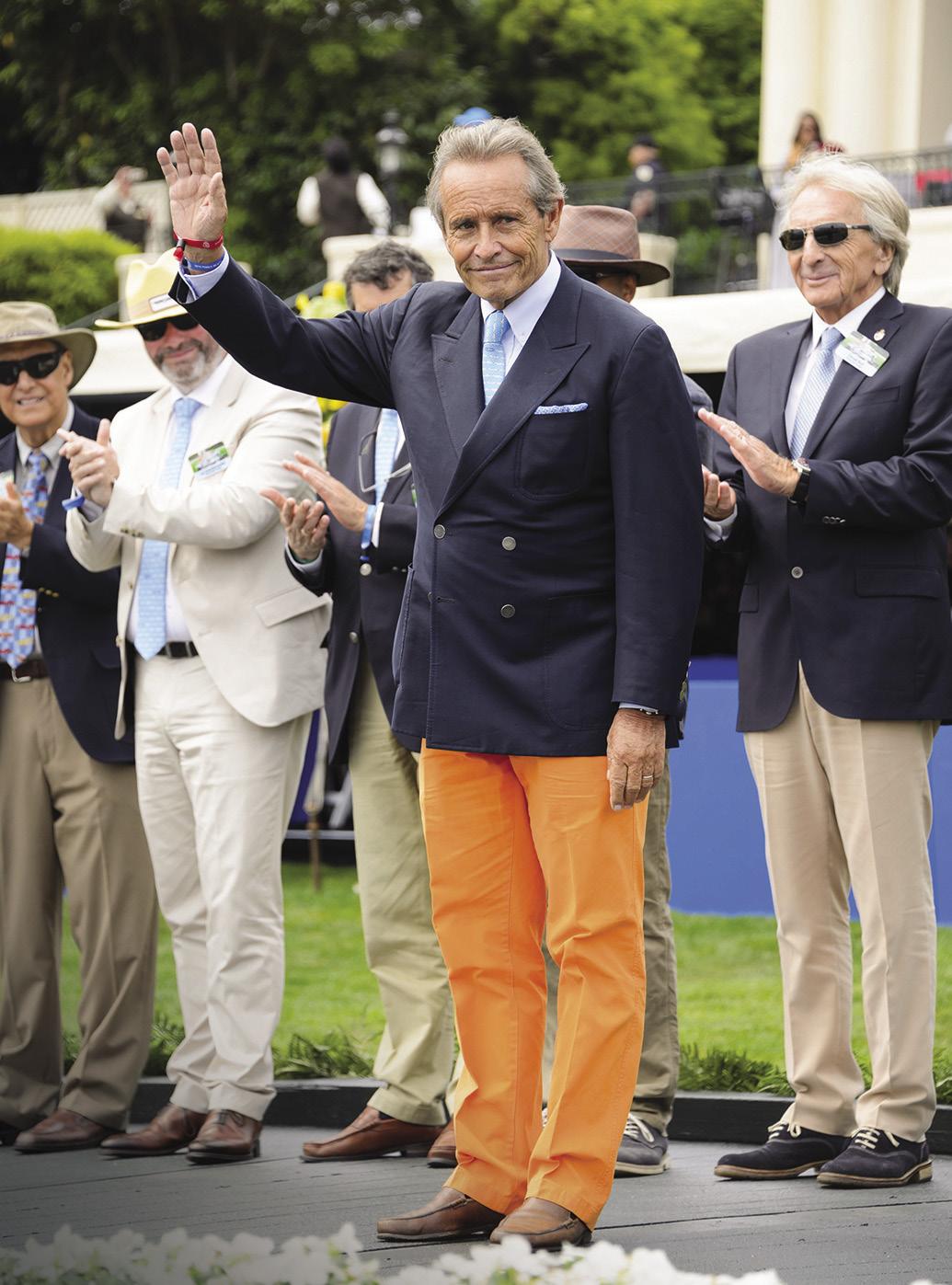 At the inaugural 1000 Miglia Experience in the UAE, Jacky often led the way in a 1968 Porsche 911.
Jacky (right) participates in the 2017 Kronos VW Fun Cup with his children (from left): Larissa, Vanina, Joy, Romain, and Clément.
At the inaugural 1000 Miglia Experience in the UAE, Jacky often led the way in a 1968 Porsche 911.
Jacky (right) participates in the 2017 Kronos VW Fun Cup with his children (from left): Larissa, Vanina, Joy, Romain, and Clément.
Pebble Beach Concours d’Elegance INSIDER 17
Jacky often serves among the Honorary Judges at the Pebble Beach Concours d’Elegance.
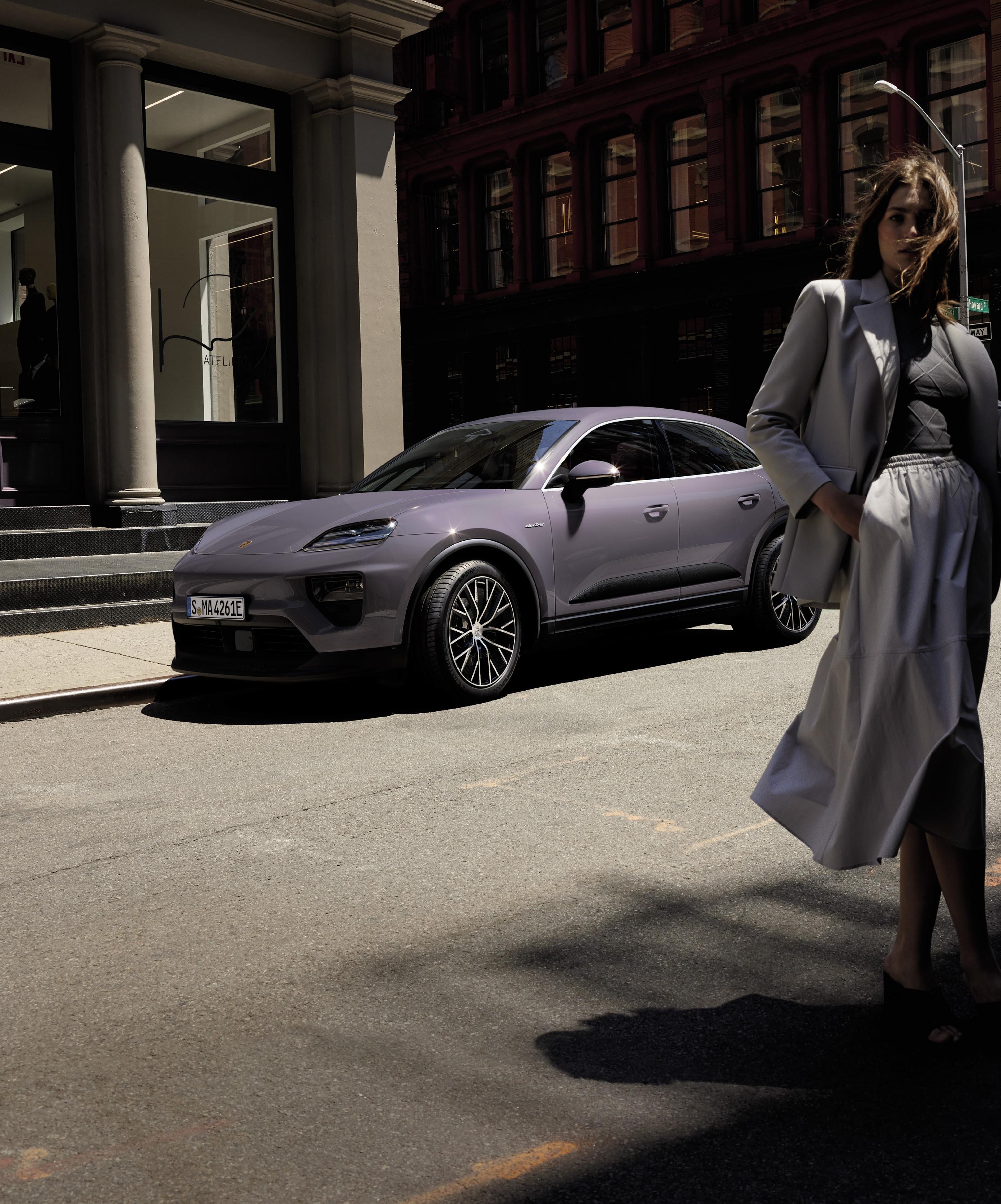
essence. The new all-electric Macan. © 2024 Porsche Cars North America, Inc. Porsche recommends seat belt usage and observance of traffic laws at all times.
CHANGE YOUR SPARK, NOT YOUR FIRE. Keep your

Never
the Same masterdynamic.com
Sound
It’s the best overall sound quality I’ve heard from a set of wireless headphones – DigitalTrends These are the most stunning earbuds we’ve ever tested – Gear Patrol
BY RON VERSCHOOR
THE 1930 SPEEDSTER
Packard’s legendary 734 Speedster was a one-year-only offering—a highpowered, low profile performance machine, available in five body styles. The torpedo-shaped two-seat open “Runabout” was the most sporting. Opposite: Ray Scherr’s Runabout placed First in Class at the 2006 Pebble Beach Concours. Opposite below: The PR brochure for the Speedster series featured a cover shot of the Packard Proving Grounds.
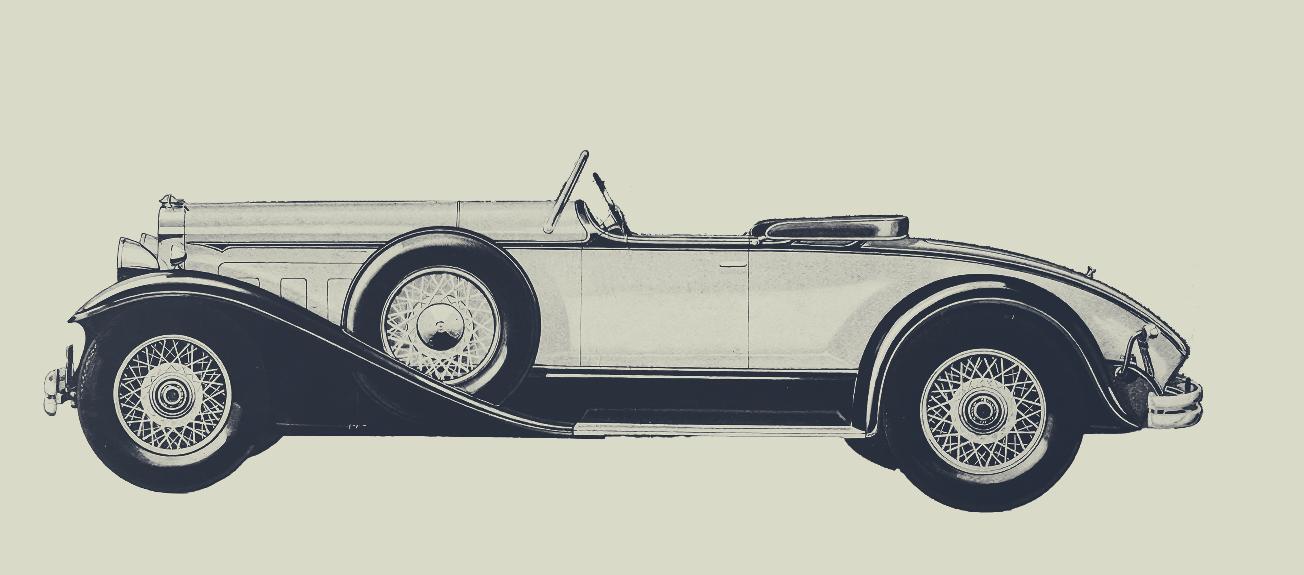
THE SPEEDSTER Runabout
Packard Performance AT ITS PEAK
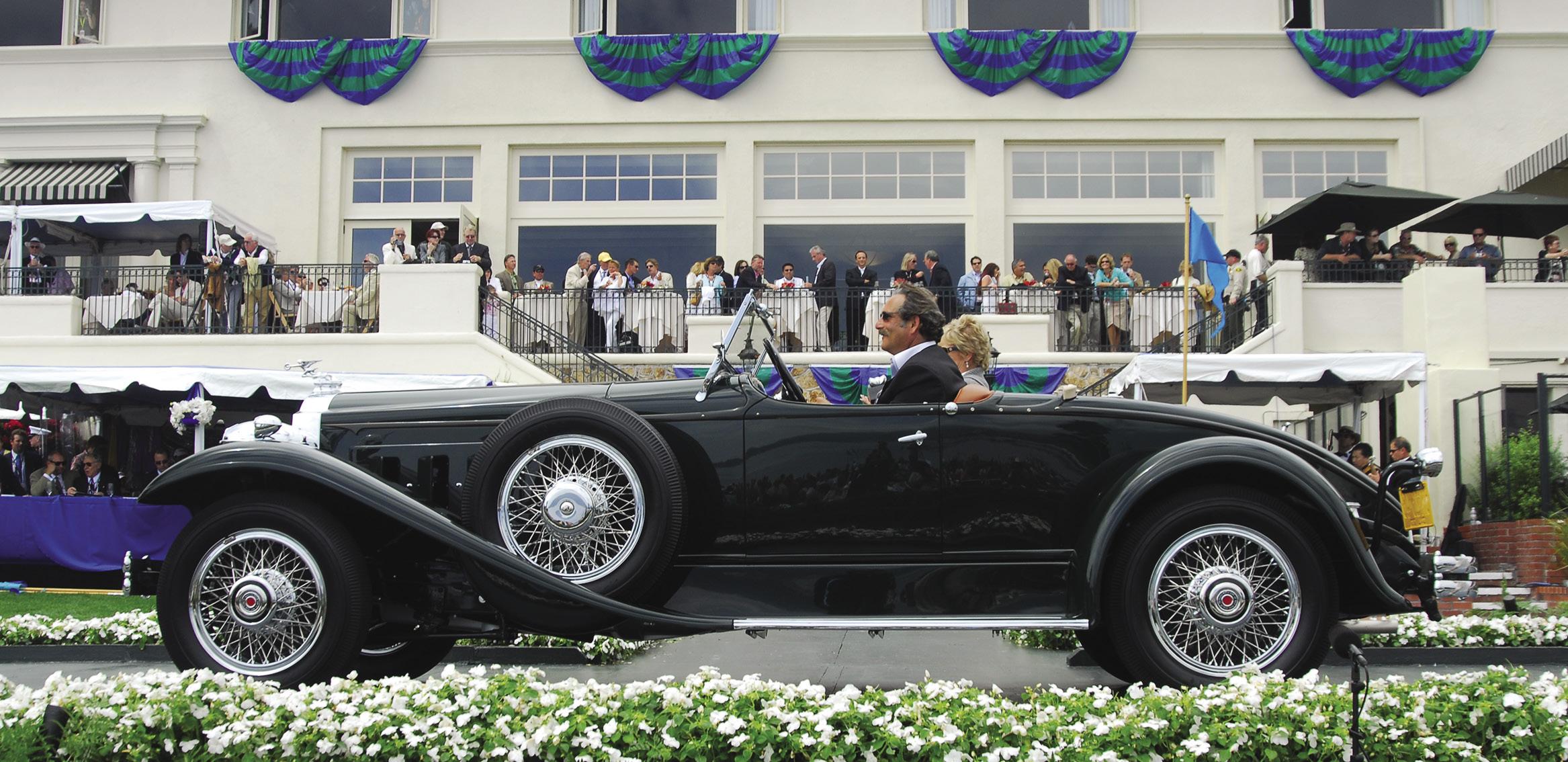
Packard is no stranger to the Pebble Beach Concours d’Elegance. It leads American marques in show field representation, has earned Best of Show honors on four occasions, and has garnered a wide range of special awards, including the Ansel Adams, Briggs Cunningham, Charles A. Chayne, CCCA and Elegance in Motion trophies, plus several Most Elegant awards—all of which testify to the many virtues the Packard name embodies.
Engineering excellence, quality craftsmanship, ease of operation and subtle style are commonly associated with the marque. Packard defines quiet luxury. But at times throughout its history, particularly amidst the Roaring Twenties, Packard sought to be something different. It sought performance. It sought speed.
In January 1930, three short months after Black Tuesday heralded the start of the Great Depression, Packard unveiled its limited-production 734 Speedster. Essentially a factory hot rod, the Speedster targeted the driving enthusiast—and it was offered in no less than five distinct body styles, addressing the need for speed in a variety of guises. Today, the legendary Speedster is recognized as the most sporting model in Packard’s 59-year history.
But the Speedster is not the outlier that it might seem to be. It draws on Packard’s achievements on racetracks and in grueling reliability trials in the company’s early days. And it was directly presaged by the construction of Packard’s Proving Grounds—a high banked oval that was the world’s fastest 2.5-mile track in its day.
Packard itself came about through what could be considered a dare. Having purchased a Winton automobile in 1898, James Packard suggested improvements to Alexander Winton, who promptly told Packard he should build his own automobile. In November 1899, the first Packard was built and the Packard-Winton rivalry was on.
During the summer of 1903, Tom Fetch drove a singlecylinder Packard Model F known as “Old Pacific” across

Pebble Beach Concours d’Elegance INSIDER 21
THE SPEEDSTER Phaeton

the country at a record-setting pace, traveling 5,600 miles from San Francisco to New York in 61 days, a two-day improvement over the previous record set by a Winton. Then on Labor Day, Harry Cunningham piloted a four-cylinder, 25-horsepower Packard Model K racer named the “Gray Wolf” to second place at the Grosse Point Manufacturer’s Cup ahead of a Winton with Barney Oldfield at the wheel. Four months later, the sheer speed of the Gray Wolf was validated on New Year’s Day 1904 when it established a five-mile record at Ormand Beach, Florida, besting the previous Winton record by 2.2 seconds.
The Gray Wolf further distinguished itself at the inaugural Vanderbilt Race of 1904 by placing fourth in competition with much larger and more powerful rivals from Panhard, Clément-Bayard, Fiat, and Mercedes. Seventy years later, a Road & Track article lauding the Gray Wolf succinctly described it as “the archetypal lightweight racer, defeating cars of treble its power and quadruple its displacement.”
In 1912, two years after assuming the role of Packard’s general manager, James Alvan Macauley recruited Jesse Gurney Vincent to serve as chief engineer, a title he would hold for 30-plus years. Vincent was responsible for Packard’s Twin Six, which debuted in May 1915 as the first production V-12 automobile. Revered for its smoothness and silent operation, the V-12 also had enormous performance potential that Vincent was eager to explore. He was responsible for the development of a V-12 engine for aero applications, which was also evaluated in two racing car chassis. Dubbed the 299 for its cubic-
The 734 Speedster Phaeton was intended for pleasant open-air motoring. Below: Paul Gould’s Phaeton passes in front of The Lodge at Pebble Beach during the 2015 Tour d’Elegance.
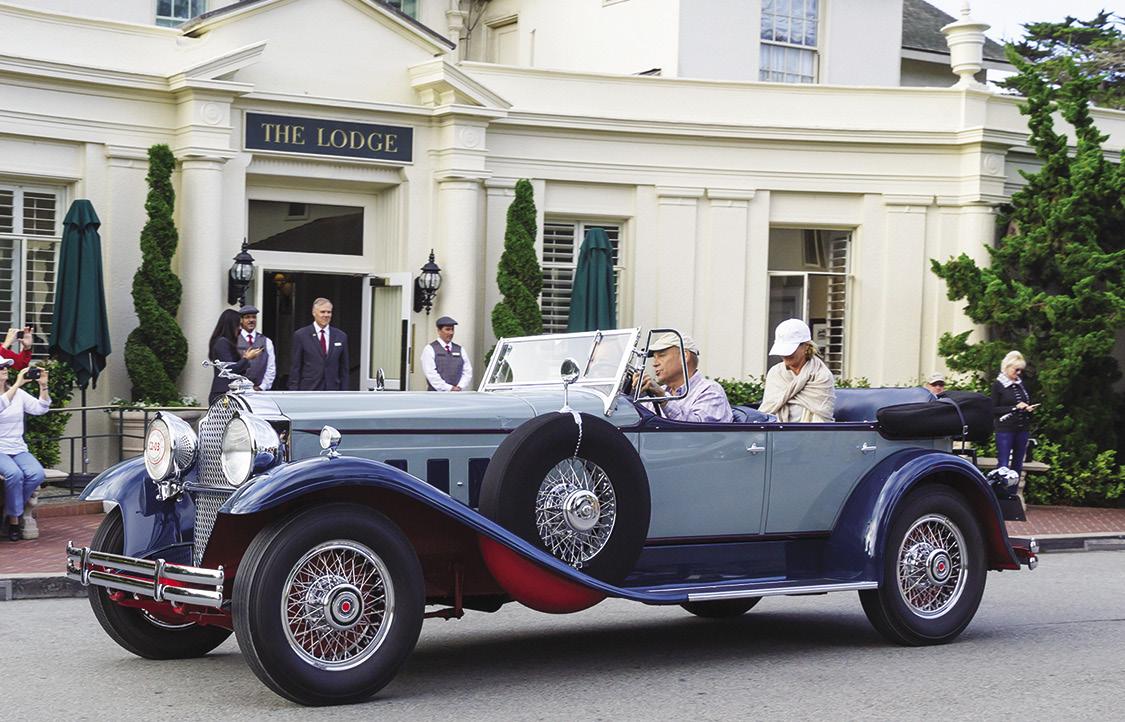
inch displacement (just below the 300-cubic-inch limit), it produced 130 horsepower and was placed in a short, 112-inch-wheelbase chassis fitted with an aluminum body.
On August 4, 1916, Bill Rader set a one-lap record at the Indianapolis Motor Speedway in a 299, breaking the 100-mph barrier. One year later at Sheepshead Bay in New York, Ralph DePalma and a 299 emerged victorious in 20-, 30- and 50-mile events against both Barney Oldfield in a Miller and Louis Chevrolet in a Frontenac. Those victories were repeated in 1918, and DePalma’s 299 went on to place sixth at the 1919 Indy 500, the only 12-cylinder entry to finish the race.
The next aero-auto hybrid was the 905 racer, equipped with, as the name implies, a V-12 engine with three times the cubic-inch displacement of the 299. Three prototypes were produced, with horsepower peaking at 285 bhp. In 1917, Bill Rader set a Sheepshead Bay record in a 905,
22 Pebble Beach Concours d’Elegance INSIDER
The enclosed close-coupled design of the 734 Speedster Victoria provided a quick pace and private comfort.
Below: J. B. Nethercutt’s Victoria crosses the awards ramp to collect a second-place trophy at the 1991 Pebble Beach Concours.

reaching 130 mph. In February 1919, the final iteration of the 905 recorded 149.88 mph during a flying mile time check at Daytona Beach, making it the fastest car in the world. Its standing-start mile average of 92.71 mph in the unlimited class was a record still standing 33 years later.
Vincent’s performance focus was applied to production offerings resulting in the introduction of the Sport model for the 1922–23 model year. Initially offered on the Single Six series, the Sport model expanded to the new Single Eight of 1924. Sport models featured a four-passenger, open phaeton body produced by the Pullman Company of Chicago that was two inches lower and four inches narrower than the standard touring body. Front-hinged doors and disc wheels gave it a dashing appearance. Fewer than 100 are believed to have been built through the 1926 model year.
Vincent then employed a two-pronged approach to address his fondness for speed. First, he championed the construction of the Packard Proving Grounds, allowing for thorough testing of both prototype and production models. Albert Kahn designed the compound, built on 400 acres in Utica, 20 miles due north of the Detroit factory on East Grand Boulevard. Construction was completed in 1927 and the grand opening ceremony took place in June 1928 with Vincent’s brother Charles selected to oversee Proving Ground operations. Packard lore suggests “Jesse designed and built the automobiles and Charlie would do his best to break them at the Proving Grounds.”
THE SPEEDSTER Victoria
With a proper testing facility in place, Vincent turned to the development of performance prototypes. His formula was an early version of the muscle car recipe: place the largest engine in the smallest chassis. His personal prototypes were built in 1927 and 1928, evolving into a limited run of production Speedsters for the 1929 model year. Powered by the Custom Eight 384-cubic-inch engine, high compression heads and a high lift camshaft raised horsepower from 106 to 130. The powerful engine was shoehorned into the 126½-inch-wheelbase chassis of the Standard Eight fitted with shortened bodies. Priced at $5,000, an estimated 70 Speedsters were produced without the benefit of corporate promotion as management was still unconvinced the performance perspective had any

Pebble Beach Concours d’Elegance INSIDER 23
THE SPEEDSTER Sedan
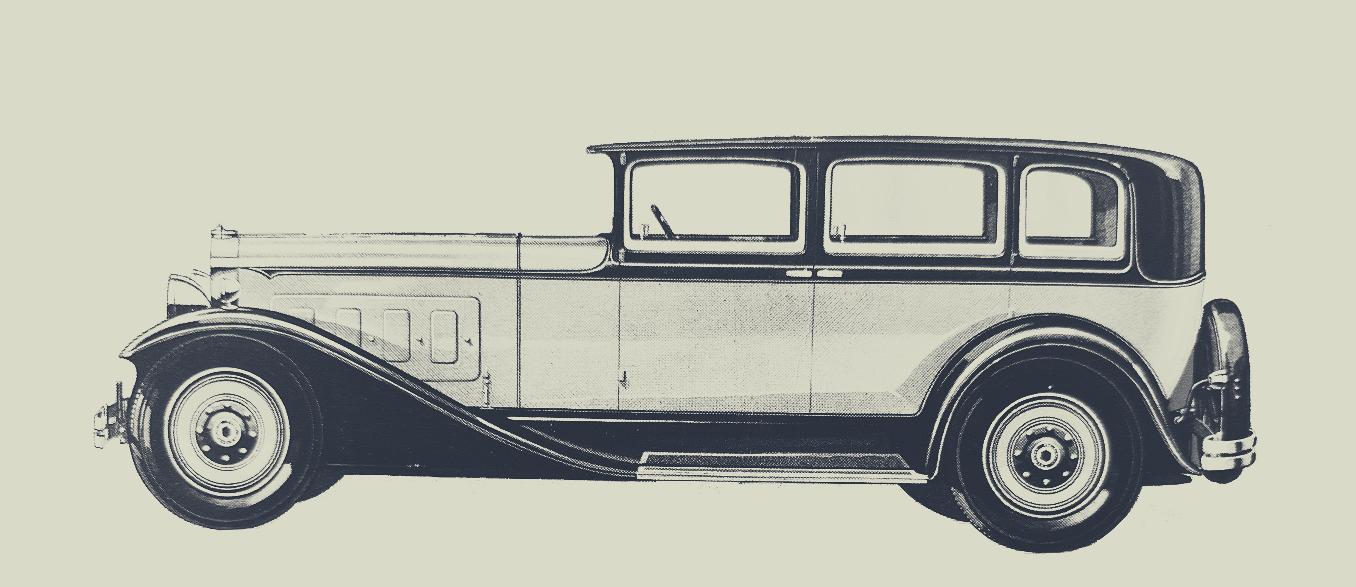
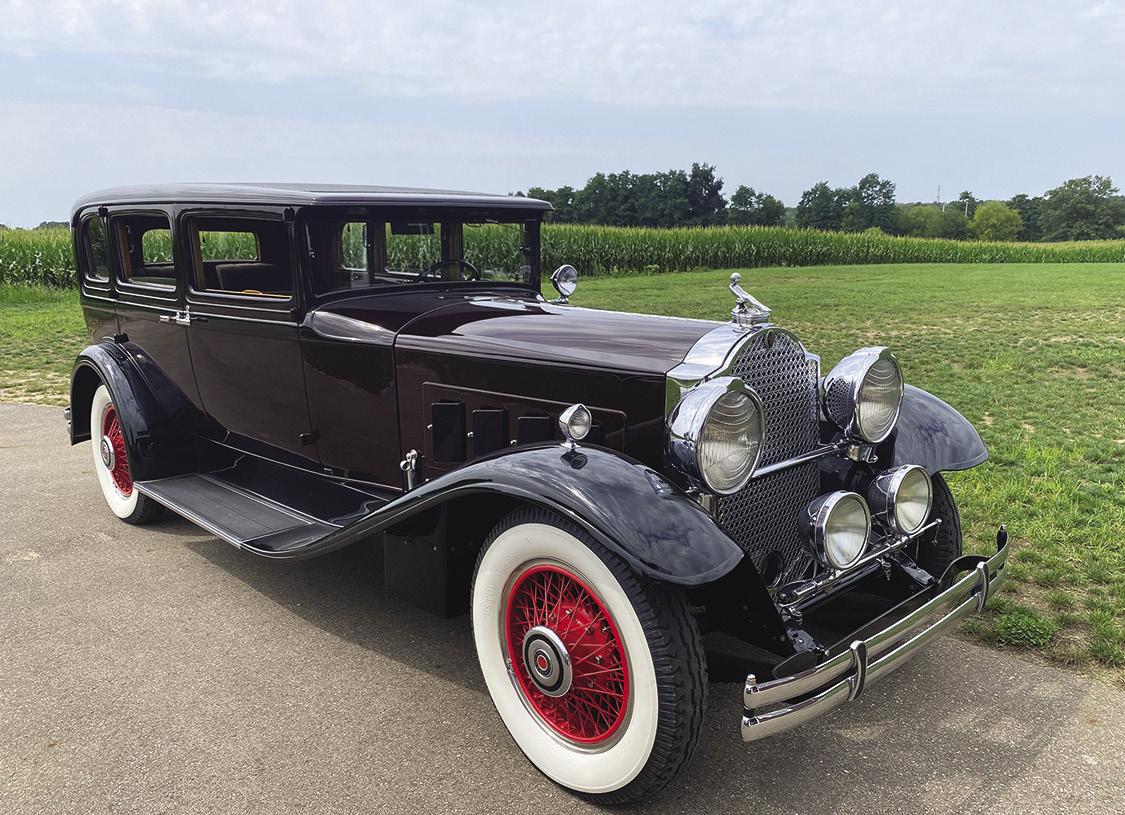
appeal to Packard’s conservative clientele. Notable among 1929 Speedster survivors is a runabout that is part of The Henry Ford museum.
For the 1930 model year, Packard management soundly embraced the Speedster offering, describing it as “enlarged and refined over the first Speedster.” At its core was the big Packard Eight engine, equipped with high compression heads, a dual updraft Detroit Lubricator carburetor, a finned exhaust manifold, valve revisions, and a vacuum gasoline booster pump. The tuned engine produced 125 horsepower with the 4.85:1 compression ratio and 145 horsepower with the 6:1 compression ratio. A 4.6:1 axle ratio provided quick, off-the-line acceleration, but for owners preferring high-speed cruising, a 3.3:1 ratio could be specified making speeds in excess of 100 mph possible.
Above: The 734 Speedster Sedan was said to offer both high speed and all-around performance.
Left: This Sedan, now in the care of the Classic Car Club of America Museum, is one of just two known cars with this body style, and it was special ordered to have dual rear spares and extensive interior wood trim.
This powerful engine was placed in Packard’s 134½-inch chassis, addressing the somewhat stubby appearance of the 1929 Speedster. While the Speedster moniker conjures up images of two-seat, minimalist roadsters, in Packard parlance, Speedster referred to a unique model series, offered in five distinct body styles:
• The Runabout was the most sporting offering, a two-seater incorporating boattail styling described by Packard as a “graceful streamlined torpedo design.”
• The Phaeton provided open-air motoring for four “with the usual interior conveniences found in any standard Packard open model.”
• The Victoria was built “for those who prefer a fast car in a practical close-coupled enclosed design.”
• The Sedan promised “High speeds at will plus the features of an all-around motor car,” making it the ultimate stealth performance car of its time.
• The Roadster was a late addition and did not appear in the Speedster brochure. Equipped with a rumble seat to accommodate additional passengers, it retained a decidedly sporting appearance. Just six were built, making it the scarcest of the Speedster offerings.
24 Pebble Beach Concours d’Elegance INSIDER
The 734 Speedster Roadster came with a bonus—a rumble seat to carry extra passengers.
Below: The Roadster of Rob & Jeannie Hilarides placed Third in Class at the 2022 Pebble Beach Concours.

Bodies were built in-house and were three inches narrower and four inches lower than their Custom Eight siblings, all carrying the “Custom Made by Packard” body tag. Cut-down windshields and rear-mounted spares on all but the Runabout contributed to the sleek, purpose-built stance. All were four-passenger vehicles with the exception of the two-passenger runabout, equipped “with the driver’s seat stationary and forward of the passenger to ensure easy handling at high speeds.” There was no doubt this was a driver’s car.
The increase in power coupled with lighter bodies made for a genuine performance Packard, but there was nothing spartan about these Speedsters. Packard was willing to cater to individual preferences, stating that the Speedster was “strictly custom built and may be developed in any upholstery or color harmonies that please the owner’s expression of good taste.” Exclusivity was ensured with open models priced at $5,200 and closed models at $6,000. By comparison, Packard’s 745 Deluxe Eight roadster was priced at $4,585. The standard Packard lineup was introduced in August 1929, with the Speedster reveal coming five months later in January 1930. A mere 113 Speedsters were produced across all five body styles, representing less than one-third of one percent of total Packard production for the year.
Marketing promotion was unique to the Speedster, with the brochure introducing this model using an interesting choice of words. “The Speedster by Packard” clearly defined this offering as something separate and distinct
THE SPEEDSTER Roadster
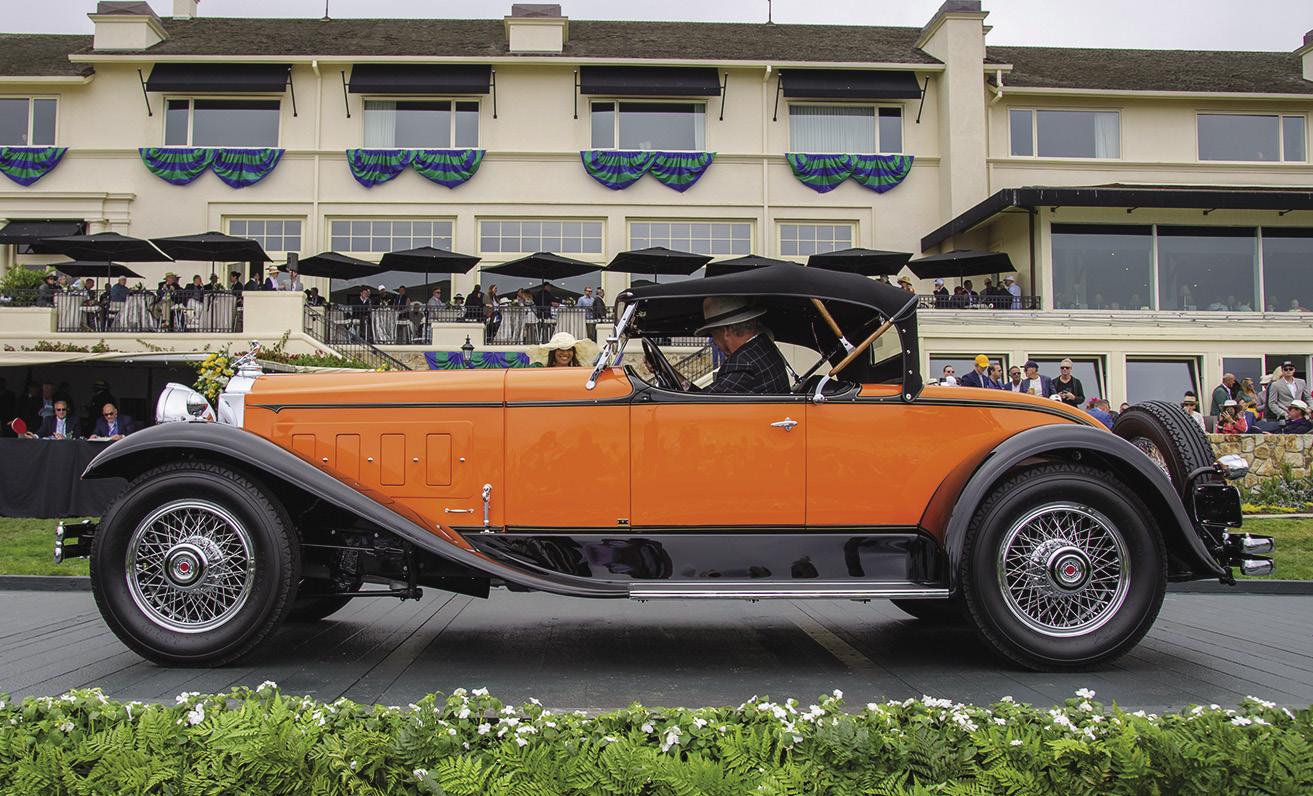
from the traditional lineup. The cover illustration depicts a Speedster Runabout at-speed on the banked curves of the Packard Proving Grounds, and the promotional copy was crafted to appeal to a discriminating clientele: “Thus the commuter—the one who loves a swift car for the open road—or the admirer of keenly responsive mechanics, will find the Packard Speedster all that can be asked of an all-around motor car richly endowed with that great motoring attribute: PERFORMANCE!”
Today, this rare, one-year offering is among the most revered Packards, a perfectly proportioned sports model imbued with traditional craftsmanship that only Packard could provide. As the Concours celebrates the 125th anniversary of the Packard automobile this year, a class of carefully curated Speedsters, with one car representing each body type, will honor Packard’s focus on performance.
Pebble Beach Concours d’Elegance INSIDER 25
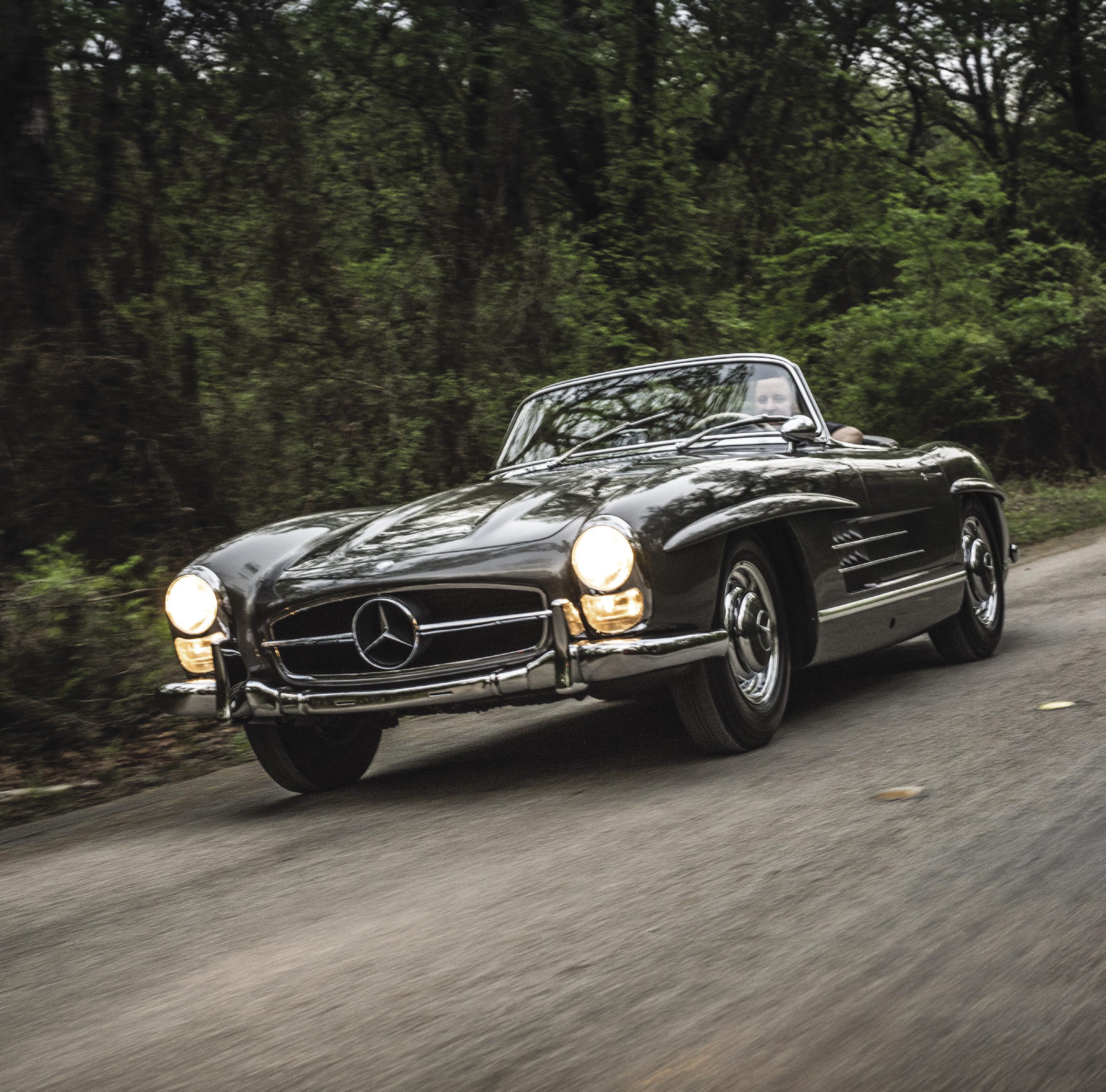
Policies underwritten by Essentia Insurance Company. Membership by Hagerty Drivers Club (HDC), a non-insurance subsidiary of The Hagerty Group, LLC. Only the HDC Program Guide contains a complete description of benefits. Purchase of insurance not required for membership in HDC. All third party makes, models, and vehicle names are property of their respective owners. Their use is meant to reflect the authenticity of the vehicle and do not imply sponsorship nor endorsement of Hagerty nor any of these products or services. Hagerty is a registered trademark of the Hagerty Group LLC, ©2024 The Hagerty Group, LLC. All Rights Reserved. +1-800-922-4050 | Local Agent | hagerty.com INSURANCE DRIVERS CLUB CAR CULTURE MARKETPLACE Cruising, not streaming

Valuations Valuations HEADQUARTERS +1 519 352 4575 appraisals@rmsothebys.com APPRAISALS & ESTATE PLANNING WITH UNPARALLELED CAR KNOWLEDGE AND VALUATION EXPERTISE Charitable Contribution Estate Planning and Administration Family Division and Equitable Distribution Collection Management Inheritance, Gift, and Capital Gains Tax Loan Collateral Insurance Valuation
When life throws a gauntlet at Jeff O’Neill’s feet, you can be sure he will pick it up—and run with it.
This has happened more than once, and his resultant efforts have materialized into O’Neill Vintners and Distillers—the tenthlargest wine business in California—and the Velocity Invitational, a unique motorsports and lifestyle event that draws tens of thousands of attendees every year.
Ask Jeff how you turn a vision into reality, and he is both determined and humble: “You have to believe you can do it, and then you gather people around you who have expert knowledge in that space.”
While the wine business and motorsports might not appear to be connected, in Jeff’s case they are inextricably interwoven, as his relationships in one business led him to fulfill a lifelong dream in the other.
Growing up in Marin County, California, Jeff loved everything car-related and attended all the big West Coast race events at Laguna Seca, Sears Point, and Cotati with his father, who ran a small manufacturing business that created automotive accessories. Jeff’s first ride was a 1968 Firebird, which he drove enthusiastically around the country roads of Marin. “I thought I could drive that car,” he says with a nostalgic grin, “but it’s not until you are taught how to really drive that you get the best out of a car.”
With a business degree, Jeff joined the family wine business, founded by his Armenian grandfather and based in Visalia, California. But after numerous missteps by management, it was bankrupt by 1981. “Wells Fargo’s trustee came in and asked me to stick around to supervise the assets,” Jeff says. “Then in 1984 he introduced me to a small equity group with one of the principal investors being Peter Mullin, and everything changed.”
Jeff was 26 at the time and by his own admission didn’t know the first thing about equity investors, but he managed to persuade renowned classic car collector Mullin and a small group of private investors to buy the distressed assets of the bankrupt company. Together they launched a new wine venture, Golden State Vintners, with Jeff at the helm. Long story short: Jeff took the company public in 1998 and sold it in 2004. With the proceeds, he started a new

28 Pebble Beach Concours d’Elegance INSIDER
Nick Colonna’s monster 1967 Chevrolet Corvette, with a 427 capable of delivering 650 hp, at speed on Sonoma Raceway amidst the 2023 Velocity Invitational.
From Vision to Velocity Invitational
BY KATE CONSTANTIN

How Jeff O’Neill turned a passion into an international race event
INSIDER 29
Pebble Beach Concours d’Elegance


enterprise, O’Neill Vintners and Distillers, with interests in Sonoma, Paso Robles, Lodi, and the Central Valley. “That move gave me the time and opportunity to do other things—like racing!”
Fueled by a lifelong passion for racing cars, Jeff made a wish list of six automobiles: Maserati 250F, Jaguar C-Type and D-Type, Aston Martin DB4 Zagato, Ford GT and Maserati Birdcage. “I promised myself I would own at least one of the six by the time I was 50. And if I didn’t, well . . .” he says with a shrug and a chuckle, “I’d have to go back to the drawing board.” In 2008, before Jeff turned 50, Peter Mullin showed Jeff a photograph of a Maserati 250F for sale in Europe. “It was the car that Fangio drove in 1957. I looked at the car and went, ‘Holy Cow!’” says Jeff,
who took his family on vacation to England specifically to pick up the car after purchase. “My 15-year-old daughter took one look at it and said, ‘Why would you buy a single seater? Where’s my seat!’”
Despite his daughter’s disapprobation, Jeff bought the car. With no idea how to drive it, he initiated the help of British premier race driver Willie Green, whose career spanned four decades and included 21 national race wins and several trips to Le Mans, to show him the ropes. “I call these cars ‘finesse’ cars,” explains Jeff. “There is a lot of skill involved in driving them really fast. The first time I got behind the wheel on a straightaway, knowing that Fangio had driven that car himself—that was just a breathtaking experience.” Willie brought his own tricked-out Ford
VELOCITY INVITATIONAL
30 Pebble Beach Concours d’Elegance INSIDER
Jeff O’Neill with his Maserati 250F—a machine driven by Juan Manuel Fangio in 1957 on his way to becoming F1 World Champion.
“These amazing vehicles don’t do any good sitting in a garage and, as owners, I think we have an obligation to share these incredible pieces of history.”
– JEFF O’NEILL

Capri to the track to demonstrate the finer points of finesse driving, including, most importantly, how to downshift and brake before the corner and then employ the right foot on the exit. “We spent three days together, driving, eating, and drinking. It was very special.”
Jeff brought his beloved 250F Stateside and met Tom Price, a celebrated classic car collector in Marin County, who offered to store the car for him alongside his own 250F. Together with Peter Giddings, another 250F owner and one of vintage racing’s greatest ambassadors, the three enthusiasts showcased their 250Fs up and down the West Coast and at the Melbourne Formula 1 a few years later. Jeff then fulfilled a lifelong ambition: “When I was a kid, I would have been over the moon just to be in the stands
at Monaco. But the 250F gave me access to the Monaco Historic race. There I was, actually sitting on the Monaco grid and driving the iconic Monaco tunnel. What an extraordinary experience!”
In 2017 Jeff purchased a 1960 Maserati Tipo 61 Birdcage that ran at Le Mans in 1960. “It is known as the ‘birdcage’ because of its revolutionary lightweight tubular frame,” he explains. In honor of its racing history, he took the car to the Le Mans Classic in 2023, but when they started it up, a cylinder sleeve dropped and the car never made it out of the parking lot. “I was devastated!” says Jeff. “But Ian Nuthall introduced me to a lovely Belgian gentleman who offered me a ride in a 1952 Jaguar C-Type—and more importantly, the opportunity to codrive with his own son!
Pebble Beach Concours d’Elegance INSIDER 31
O’Neill’s 1963 Ferrari 250 GTO, Robert Stoker’s 1956 Alfa Romeo Giulietta Spider, and Ranson Webster’s 1961 Porsche Abarth Carrera barrel through a turn at the head of their class.
That night I was speeding down the Mulsanne Straight at 1 a.m. in the pouring rain in a C-Type, just like they did in the day. Recreating that historic moment, experiencing what those racers experienced . . . that was a major highlight of my racing career. Totally crazy.”
By this time, the wine business was well-established, so whenever time allowed, Jeff was at the track, be it Monaco, Goodwood, or West Coast circuits such as Laguna Seca and Sonoma. “The difference between European events and events back home became very evident to me,” says Jeff, who had first experienced the Goodwood Revival in the late 90s. “When I saw how Charles March (Duke of Richmond, owner of the Goodwood Estate) orchestrated the Goodwood Revival, I was amazed. It had a huge influence on me and I could see: he gets this! He took care of his drivers, his spectators, the kids, and the families. We weren’t doing that on the West Coast. We had lousy food, dirty bathrooms, and nothing for kids, not even a place to sit. I thought a lot could be improved.”
When Jeff approached the management of West Coast racetracks with ideas for improving the race-day experience, their enthusiasm for change was less than lukewarm. “They didn’t get that this is the entertainment business,” says Jeff with some irritation. “We have a responsibility to showcase these extraordinary cars and open the experience to everyone, not just the hardened race driver and the fans.”
Finally, the manager at Sonoma Raceway told him, “If you think you can do it better, go ahead.”
And so he did.
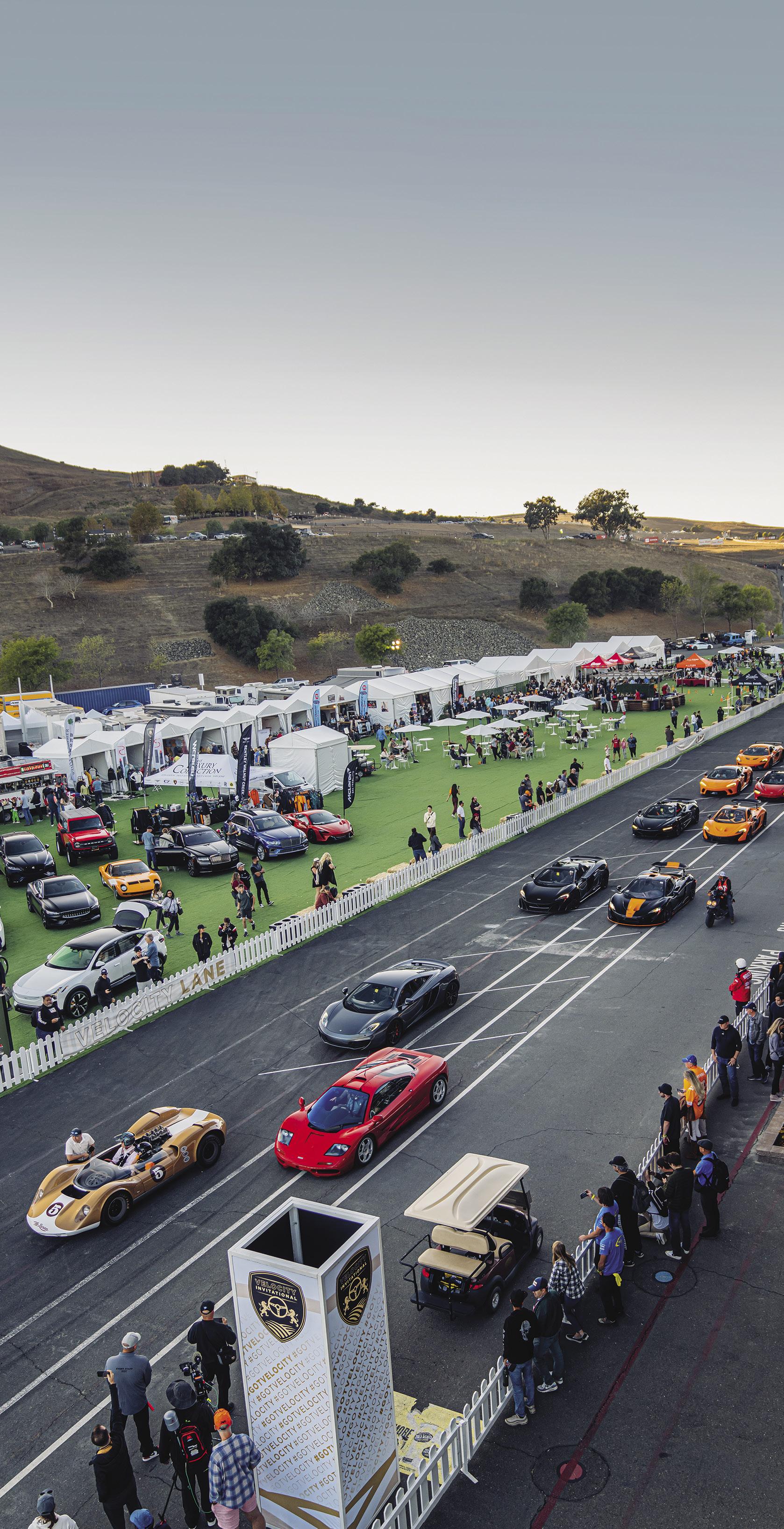
“It’s the only place on Earth where you can do a lap on a racetrack, see a $60 million Ferrari, appreciate the newest prototypes and supercars, take a fourmile off-road adventure, and drink a glass of excellent wine.”
– JEFF O’NEILL
VELOCITY INVITATIONAL
32 Pebble Beach Concours d’Elegance INSIDER
Fresh from its appearance at the Pebble Beach Concours, Egon Zweimüller’s 1965 M1A—the first car to be badged a McLaren—leads a parade of the marque’s racing greats in celebration of its 60th anniversary. Marque ambassador and Bruce McLaren’s daughter Amanda enjoys the ride.


a part of the
In early 2018, Jeff met with Ulf Henriksson, the mastermind behind the interior design at the Petersen Automotive Museum in Los Angeles. They walked the paddock at Sonoma Raceway together and Jeff explained his vision: an elegant motorsport and lifestyle event with carefully curated grids and entertainment for the whole family, paired with outstanding food and wine. “Ulf said, ‘Sure we can do that. But not for the amount money you think we can!’ He was right,” chuckles Jeff, “I should have listened to him.”
A self-professed preservationist and historian at heart, Jeff envisaged a charitable event to support all the skills surrounding the motor-racing experience—the repairing, driving, selling and preservation of historic cars—while simultaneously entertaining and educating people about new and futuristic technologies. “We are not there yet but every year we get a little closer, and if the 2023 Velocity is any indication, there’s more than a few other folks that share my goal to keep these amazing cars on the track.”
Undaunted by the enormity of the expense and the effort involved, and without any idea how he would attract the class of cars required but buoyed by the experience of building a wine business in his twenties, Jeff began to gather a congress of experts. “The largest hurdle was to get people to believe in my vision. I was adamant that the grids be strictly curated so that the cars accurately represent their era—authentic and unmodified. It doesn’t matter if your car is worth millions, it does matter that it raced at the
Pebble Beach Road Race in 1950. So, I surrounded myself with people who know the cars and grids better than I ever would,” says Jeff. Included in his entourage of experts were Steve Earle (“the Grand-Daddy of vintage racing”), Ryan Turri (racing Porsche doyen) and brothers David and Howard Swig (organizers of the California Mille), to name a few. “We got on the phone and asked owners and drivers to bring their cars. Once Peter Mullin, Tom Price, Chris MacAllister, and Rob Walton were on board, others followed suit.”
Meanwhile, Henriksson mapped out a CAD blueprint of the venue. “I wanted everything specifically curated, even the garbage cans,” says Jeff. “Every bay was plotted down to the last inch. I wanted the owner of a multi-milliondollar historic car to feel confident about bringing it to the event. It had to be precise and perfect.”
On May 30, 2019, Jeff’s vision became a reality, entitled the Sonoma Speed Festival, which attracted around 5,500 attendees. “It was the culmination of six decades of loving cars, and less than one year of manic organizing,” he says.
Postponed in 2020 due to COVID, the second and third events in 2021 and 2022 were held at Laguna Seca and renamed the Velocity Invitational, a portable brand that underlined the exclusivity of the participants and highlighted the inclusion of prototypes, hypercars, and new technology.
Under the clear blue skies of California in early November 2023, the track at Sonoma Raceway roared as the fourth
As
McLaren celebration, current F1 racing great Lando Norris drove Alain Prost’s 1984 MP4/2.
Pebble Beach Concours d’Elegance INSIDER 33
Crew at work on Chris MacAllister’s 1964 Shelby Cobra FIA 289.
VELOCITY INVITATIONAL
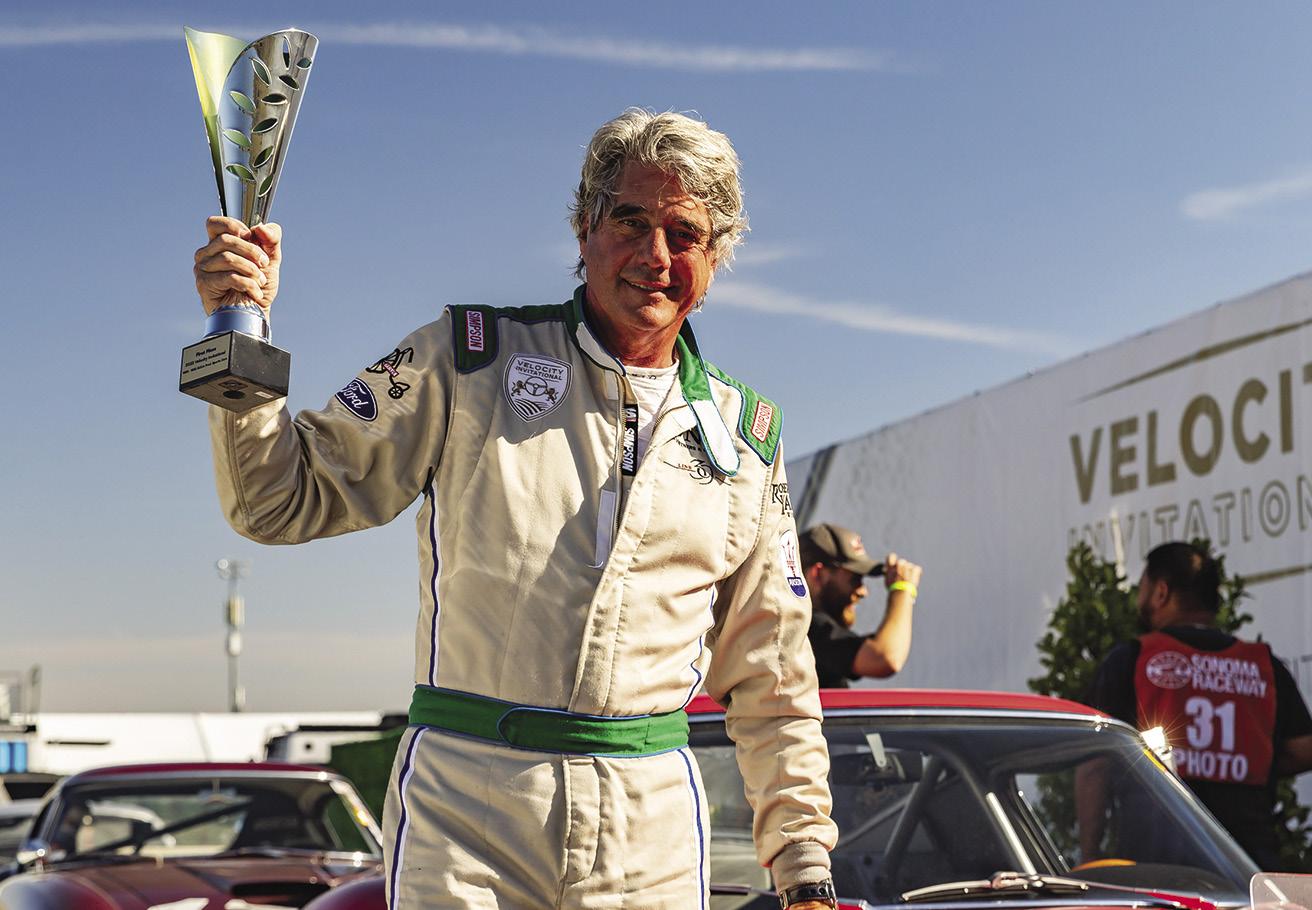
O’Neill hoists a Velocity Invitational trophy high overhead.
Velocity Invitational got underway. Against the soundtrack of high-revving engines and cheering crowds, more than 20,000 spectators strolled past the helicopter pad and the VIP drivers’ enclosure, through the paddock bays, amidst the addictive aroma of burnt rubber, hot tarmac, and highoctane fuel. “Velocity has proven that customers have an appetite for more than just NASCAR,” says Jeff. “I think the event will continue at this venue for the foreseeable future.”
In addition to gourmet picnic and BBQ offerings, the fourth Velocity Invitational hosted the Sip and Savor Pavilion where spectators could enjoy specialist foods and wine from a dozen wineries, whilst watching the races. There was also a four-acre lawn complete with sound system and DJ, where kids tossed beanbags and raced mini-cars on a track. For the more adventurous, DirtFish Rally School offered a spin around a specially designed dirt track adjacent to the race circuit, with a professional celebrity driver. However, the heart and soul of the event remained the paddock, where multiple superbly curated displays included Ragtime Racers, Can Am Historics, and Pebble Beach Road Veterans.
The year 2023 also celebrated the 60th anniversary of McLaren, and featured the attendance of Lando Norris, McLaren’s star Formula 1 driver, and Zak Brown, CEO of McLaren Racing. The two unveiled the newest McLaren supercar, and Lando drove demonstration laps in many of the featured vintage racers, including Niki Lauda’s 1984 World Championship–winning MP4/2A-1, Lewis Hamilton’s MP4/23A-05—the 2008 World Championship winner—and Ayrton Senna’s MP4/6-10, which he drove to
his third and final World Championship in 1991. Also on display, on the heels of its appearance at the Pebble Beach Concours d’Elegance, was Bruce McLaren’s first road racing car, the 1964 M1A Prototype Elva, known as “The Golden Arrow” and driven by Elvis Presley in the movie “Spinout.”
“My mantra is to appeal to the senses—to hear, to see, to taste, to feel, and to smell the experience,” says Jeff. “I like to think there is something for everyone: the spouses of the racers, their kids and families, and those who are just curious about historic cars, new technology, and future developments. It’s the only place on Earth where you can do a lap on a racetrack, see a $60 million Ferrari, appreciate the newest prototypes and supercars, take a four-mile off-road adventure, and drink a glass of excellent wine. It’s all here in a three-day event in one place.”
Jeff admits that his original vision for the event was “somewhat smaller,” but has evolved with every passing year to ensure the guest experience is fresh and engaging. Currently it is a labor of love, having yet to produce significant returns. Nevertheless, Jeff remains steadfast in his commitment to the longevity of the Velocity Invitational. “As the name suggests, the future of the event is to showcase the evolution of speed,” he says. “I think it is important to attract young enthusiasts into the arena, so we will expand to include more super- and hyper-car manufacturers, introduce electric cars, autonomous cars, and who knows, maybe next year a driverless car will race against a man-driven car on the track, or two autonomous cars against each other!” Meanwhile, Jeff insists that the vintage grids will not increase in size but will feature evermore historic and rare automobiles.
“I spend a lot of my time shaming rich guys to get off their asses and bring their cars. These amazing vehicles don’t do any good sitting in a garage and, as owners, I think we have an obligation to share these incredible pieces of history. I have to keep this going; it enables me to race too!” he says.
In 2023, Jeff participated in multiple races, driving a Ferrari GTO, Boss Mustang, 2016 Le Mans Ford GTLM and a Mini-Cooper. “I love racing. It is the only thing in life I would do every day if I could. When you are on the track you are all alone. You’re not thinking about the business challenges, those will all be waiting. You’re in the moment, totally focused. It is a very personal experience. Honestly, I can’t believe how incredibly fortunate I am that I’ve gotten to bring my dream to life—and share it with the world.”
34 Pebble Beach Concours d’Elegance INSIDER

this October 4–6.
With a great blend of history, luxury, and entertainment—not to mention a stellar lineup of cars—the Velocity Invitational returns to
Sonoma Raceway
INSIDER 35
Pebble Beach Concours d’Elegance
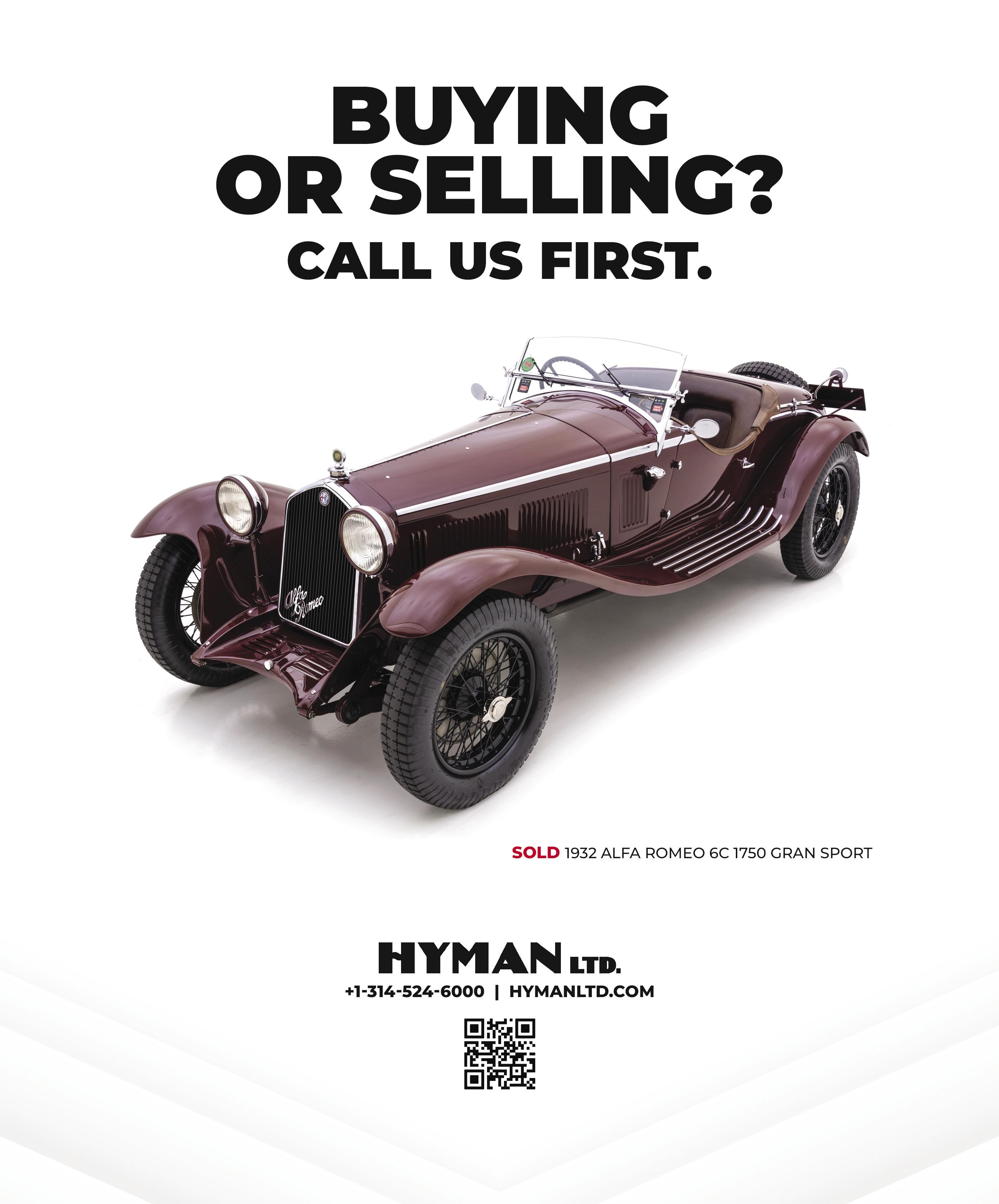

Pietro Frua:
“It is the business of times to change. . . . And it is the business of gentlemen to change with them.”
—AMOR TOWLES, A GENTLEMAN IN MOSCOW
By Peter Larsen & Stefan Dierkes
INSIDER 37
Pebble Beach Concours d’Elegance

Elegant? Enticing? Exciting? For many, the designs of Pietro Frua will evoke such declarations. His body of work is large, but it is not uniform. Nor is it predictable. Unlike many designers who tend to settle on a line and a style and then content themselves with honing and refining what is already there, from Frua one could always expect the unexpected. Like the upside-down images projected by a camera obscura, Frua designs question the obvious and go against the grain of accepted stylistic thinking. Still, Pietro Frua consistently achieves a paradoxical harmony of proportion that is always more than the sum of its parts.
And yet, Pietro Frua the man, and the wellsprings of his abundant creativity, remain an enigma. He lived a quiet life. He was never the founder of a great coachbuilding enterprise. And he never appeared in public to promote his designs. But car makers large and small nevertheless came to him because they knew that what they got would be exceptional, never ordinary. The moment journalists and critics thought they had Frua in their sights, he would be firing from somewhere else—and in another direction.
The diverse prototypes and production designs Frua created for Maserati in the 1950s and 1960s, not least the
innovative Mistral and Quattroporte models, are lodged in our collective consciousness. For many, Pietro Frua is inextricably linked with the little jewels of high Italian style he penned in the early and mid-’50s for O.S.C.A, Nardi, and Ermini, as well as for FIAT on 1100 and 1900 chassis. These were followed in the 1960s and 1970s by fascinating one-offs for large manufacturers such as BMW and Opel, as well as low volume exclusivity on Monteverdi, AC, and Ligier chassis. During their last doomed struggles for survival, even Borgward and Studebaker had pretty prototypes constructed in 1960 and 1961 to replace their aging production cars, although neither had the cash or capacity to put them into production.
Most will be familiar with the chic and dressy massproduced production models that sprang from Pietro Frua’s fertile imagination. They were often mounted on humble underpinnings, such as the Glas 1700 sedan and coupe, which became the BMW 2000 sedan and 1700 coupe when Glas was absorbed by the Bayerische Motoren Werke in 1966. The luxurious Glas 2600 V8 Coupe was given a short afterlife as the BMW 3000 V8.
Best known, however, is the rear-engined Renault Floride convertible, Pietro Frua’s most successful design, of which 117,000 were built. Pretty and fun, the Floride
PIETRO FRUA
1954 Maserati A6G/54 Coupé
38 Pebble Beach Concours d’Elegance INSIDER
2nd series chassis 2063 at the Turin Motor Show in April 1954.




Title Page: Pietro Frua in 1959 with a 1:10 plaster model of his Lloyd Arabella Coupé.
Top Left: Pietro Frua during his time at Stabilimenti Farina circa 1930.
Top Right: 1947 FIAT 1100 C Barchetta chassis 279906 at the Concorso Coppa d’Oro Villa d’Este in September 1947.
Middle: Frua’s 1:10 design drawing for the 1962 Maserati 5000 GT.
Left: 1962 Maserati 5000 GT Coupé chassis AM.103.048 at the Geneva Motor Show in March 1962.


was a carefree little thing that epitomized the swinging ’60s France of Brigitte Bardot, never mind its tricky road manners and lack of punch in the engine compartment. Perhaps even more recognizable today is the Volvo P1800 whose sleek Frua-influenced lines, drawn by Pelle Petterson in Frua’s studio, were immortalized by Roger Moore playing Simon Templar in the British TV series The Saint. The model remained in production for an astonishing twelve years from 1961 to 1973, with 47,491 units made.
But while these achievements were spectacular, most of them were accomplished when Pietro Frua was already in
his forties, fast approaching middle age. Before that time, molded as he was in the industrial cauldron of Torino— the crucible of the Italian automobile and coachbuilding industry in the 1920s and 1930s—he had already accumulated a CV that would put most to shame.
Frua was born in humble circumstances on May 2, 1913, as the fourth and last son of Carlo and Angela Frua, preceded by Augusto, Ernesto, and Giovanni. Carlo worked as a laborer in the great FIAT works, while Angela was a seamstress.
Legend has it that Pietro was a serious, determined, and responsible young man who took an interest in cars at an early age, constructing models of cars out of shoe boxes— which is not far-fetched given the rectilinear shapes that prevailed at the time. He cut a tall and commanding figure and won medals as a young man in sports activities at the Torinese canoeing club at Avigliana. On September 1, 1928, Frua enrolled in the Scuola Centrale Allievi FIAT, a vocational school created in 1922 by Ugo Gobbato, at the behest of FIAT founder and Senator Giovanni Agnelli, to teach specific skills to middle school graduates who could then expect to be hired by FIAT once their two-year training was completed.
PIETRO FRUA
40 Pebble Beach Concours d’Elegance INSIDER
1935 Lancia Astura Stabilimenti Farina Berlina, which won the “Gran premio della moda” at the 1935 Concorso d’Eleganza in Turin. Left: Pietro Frua advising his model carpenter on a wooden buck circa 1977.
Frua’s 1:10 design drawing for the 1964 Opel Kadett Italsuisse Spyder was based on a previous design for a 1962 Ford Anglia Spyder. Below: 1964 Opel Kadett Italsuisse Spyder chassis 380231630 at the Geneva Motor Show in March 1965.

Theoretical knowledge was taught at the school, while training in practical skills took place at a company of the student’s choice. On December 17, 1928, Pietro was therefore apprenticed at the Stabilimenti Farina coachworks in the Corso Tortona in Turin. This was a decision that would define Frua’s professional life for more than ten years. He graduated at the age of seventeen on July 31, 1930, with a degree as designatore, or technical draftsman. He did not take a job with FIAT, however, but remained with Stabilimenti Farina, now as a draftsman, a propitious outcome for a young and talented designer.
The Stabilimenti Industriali Giovanni Farina S.A. had been established in Turin in 1906. By 1919 the enterprise had grown to where the company had the capacity to massproduce car bodies. Battista “Pinin” Farina, Giovanni’s younger brother, had been apprenticed with the company soon after its founding, and over the years he became essential for its growth as an industrial enterprise, having studied assembly line production methods in Detroit. But in 1930, Battista left Stabilimenti Farina and established the Carrozzeria Pininfarina, soon eclipsing the old Stabilimenti company.
Battista’s fortuitous exit from the design department at Stabilimenti Farina enabled Pietro Frua to move seamlessly from apprentice to draftsman. Pietro advanced quickly. In the early 1930s he was made responsible for apprentice training, although it soon became evident that his talent was too great to lock him forever in a purely administrative position. On September 1, 1935, at the age of 22, Pietro was made Capo Ufficio Tecnico della sezione carrozzeria, or director of the technical offices of the coachbuilding department. In short: chief stylist of Stabilimenti Farina!

American influence pervaded the production side of the firm at this time, and it also had an impact on the styling office. It was a dynamic set-up: in the 1930s, Stabilimenti Farina created productionized bodies for bread-andbutter cars as well as high-quality luxury coachwork with great style on high-end chassis from Lancia, Alfa Romeo, Mercedes-Benz, Hispano-Suiza and Isotta Fraschini. It is safe to say that Pietro Frua had a hand in the design of most of these creations.
Over the years, Stabilimenti Farina hatched a who’s who of the Italian carrozzeria; in addition to Batista “Pinin” Farina, at one time or another, Alfredo Vignale, Mario Boano, and Giovanni Michelotti all worked alongside Pietro Frua. In 1936, 16-year-old Michelotti became a design apprentice at the coachworks, and Frua was his mentor. Some say
Pebble Beach Concours d’Elegance INSIDER 41
One of Frua’s 1:10 design proposals for the 1963 Glas 1300 GT Coupe based on the floor pan of the Glas 1004. In March 1963, the wheelbase was stretched by 8.7 inches for the 1:1 construction drawing.
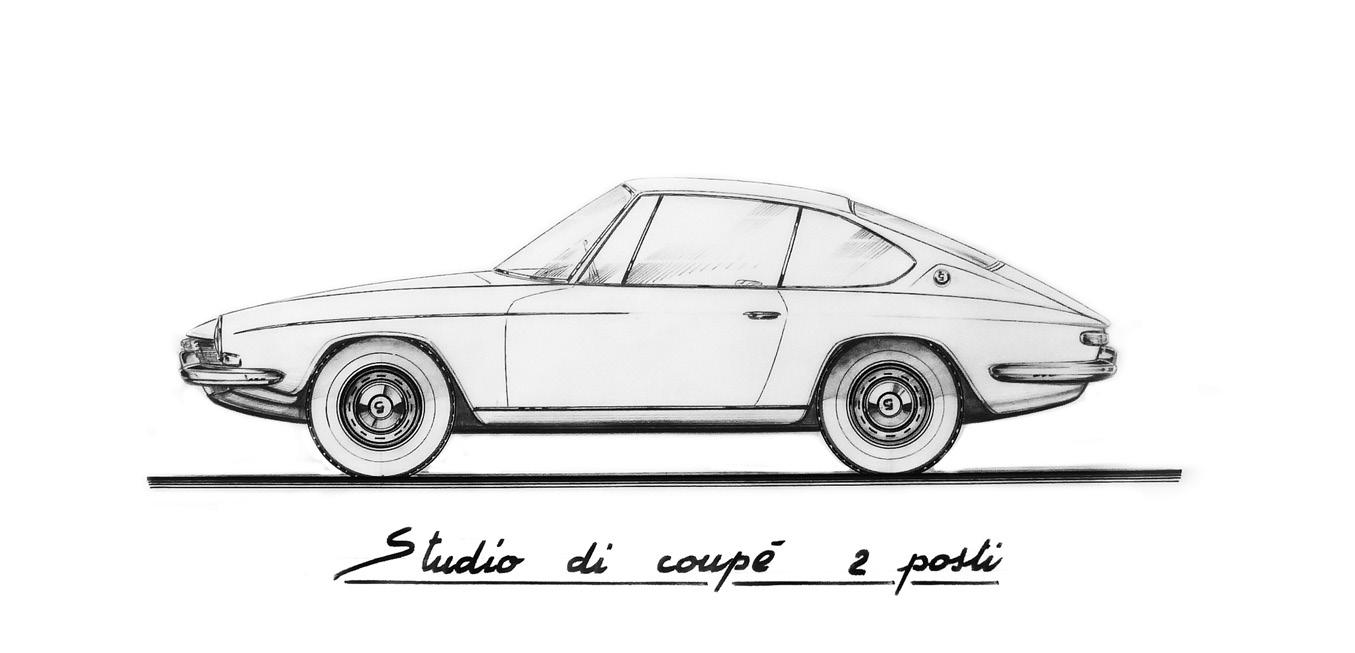
they became lifelong friends, but according to Edgardo Michelotti, while they each recognized the other’s great talent, the two remained good acquaintances rather than comrades in arms. Nevertheless, the synergies generated in the 1930s between all these seminal designers became the fertile soil from which sprang the ravishing linea italiana that flowered so abundantly in the 1950s and remains universally worshipped today.
But nothing is forever. Like many great talents, Frua found it onerous when his decisions were questioned, especially given his position as head of styling. Friction increased between Pietro and two of the many Farina brothers: Attilio Farina, the eldest son of Carlo Farina, chief administrator of various departments, and brother of “Pinin,” and also Giuseppe “Nino” Farina. Perhaps the feeling in the corridors of power was that Frua had lost sight of who the real bosses were. Pietro Frua resigned on April 30, 1939. Ironically, he was succeeded by Giovanni Michelotti who became Stabilimenti Farina’s new chief stylist.
War came. On January 1, 1940, Pietro became Disegnatore progettista, or technical draftsman, with the Officine Viberti, a manufacturer that bodied weaponized off-road vehicles as well as FIAT and Lancia trucks for the Italian army. The job lasted until sometime in October 1941, after which Frua worked as a freelance design consultant until Italy surrendered on September 8, 1943. He was never conscripted into the army, so it can be assumed that his work was considered sufficiently important for the war effort to keep him away from the fighting. During this time,
he designed a so-called Belmondo (the Italian name for a scooter) that inspired the 1945 Piaggio MP5 Paperino scooter, the precursor of the first Vespa, the 1946 V98. Never idle and in the face of universal postwar shortages of virtually everything, Pietro also devised simple electric kitchens and ovens with terracotta-based heating elements fitted with a metal net.
In 1944, Frua finally took the big step and formed the Carrozzeria Pietro Frua. This was the beginning of a sublimely creative period in his life: the time when Pietro Frua rose from obscurity to become one of the most influential Italian designers of the 1950s. He created one timeless jewel after another on the various sporting etceterini and mass-produced chassis of the day, where the earliest known creation is a dramatic barchetta based on a 1946 FIAT 1100 C platform. Best remembered are the lovely spyders and berlinettas on Maserati A6G chassis, as delicate as Fabergé eggs in their expression, yet always purposeful sports cars, demonstrating both power and elegance.
In September 1948, Carrozzeria Frua participated in the first postwar Salone dell'automobile di Torino. The company grew, and at one time employed as many as fifteen artisans, including another great talent, Sergio Coggiola. It was a patriarchal enterprise. Pietro Frua was the undisputed boss, the one who knew everything and kept it all in his head, while the skilled craftsmen were given detailed instructions on what to do and how to do it. Administrative duties were handled by Teresa “Gina” Bussolino. She met
PIETRO FRUA
42 Pebble Beach Concours d’Elegance INSIDER
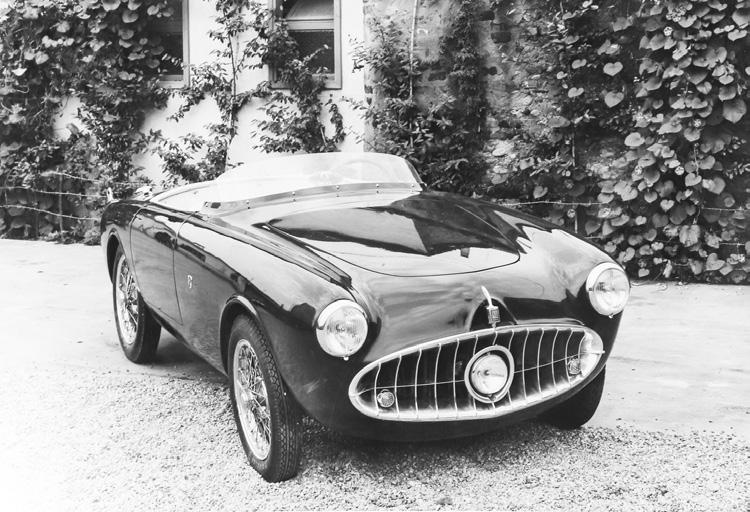
Pietro during the war and had worked as director of a company that imported French fashion. Although they did not marry at the time, she became Pietro’s soulmate and remained with him until his death.
Around 1955, Carrozzeria Frua began to work with Carrozzeria Ghia. Ghia’s client FIAT would not allow the carrozzeria to work freely with its competitors, so Ghia’s then-owner Luigi Segre mainly wanted the Frua brand to increase his elbow room. When Segre finally took over Carrozzeria Frua, Giovanni Savonuzzi had already resigned as technical director of Ghia, so Pietro Frua was appointed head of design there. Segre’s right-hand man, Federico Villani, was appointed director of the Carrozzeria Pietro Frua, and on May 22, 1956, the company moved to larger premises at no. 7 Via Padre Agostino da Montefeltro, which would soon also house Ghia. That year, no less than 80 special bodies and 200 elaborazioni, or modifications to other bodies, were manufactured by Carrozzeria Frua. In the end, it was not a happy takeover. Soon a dispute arose over who was the father of the Renault Floride design. Pietro left and took his Floride prototype with him.
The chain of events is not all that surprising. When designing Ghia “productions” in the mid-1950s, Savonuzzi had let himself become overly inspired by the extravagant Virgil Exner-designed show cars the carrozzeria had manufactured under contract to Chrysler—a case in point being the Volkswagen Karmann Ghia, which was not much more than a rear-engined Exner-designed Chrysler d’Elegance that had shrunk in the wash. While Exner was


thousands of miles away in Detroit and too formidable to care, Frua was stuck in the middle of things. As a result of Frua’s exit from Ghia, the Carrozzeria Pietro Frua was put into liquidation on April 15, 1958, a process that ended up bumping around in the Italian courts until the company was finally wound up in January 1962.
Once again Frua set out on his own. On June 11, 1959, the Studio Tecnico Pietro Frua was incorporated as a design studio that would operate from various locations and cooperate with a number of coachbuilders in the 1960s and 1970s, including the Carrozzeria Viotti, the Carrozzeria Savio, and the Carrozzeria Lombardi, as well as the thenindependent Swiss Ghia in Aigle, and the Carrosserie Italsuisse in Geneva. It was in this period that Frua created his most outstanding and influential designs—and certainly those for which he is best remembered: clean, handsome, and lithe shapes with modernistic proportions for Maserati, Glas, BMW, Opel, Monteverdi, and Lamborghini. And
Pietro Frua in his studio in 1975 with the 1:1 rendering of Rolls-Royce Phantom VI Sedanca de Ville chassis PRH 4643, which was finished in England as a parade convertible in 1993 by Royle Cars Ltd. 10 years after Frua’s death.
Pebble Beach Concours d’Elegance INSIDER 43
1953 Nardi Crosley 750 Barchetta
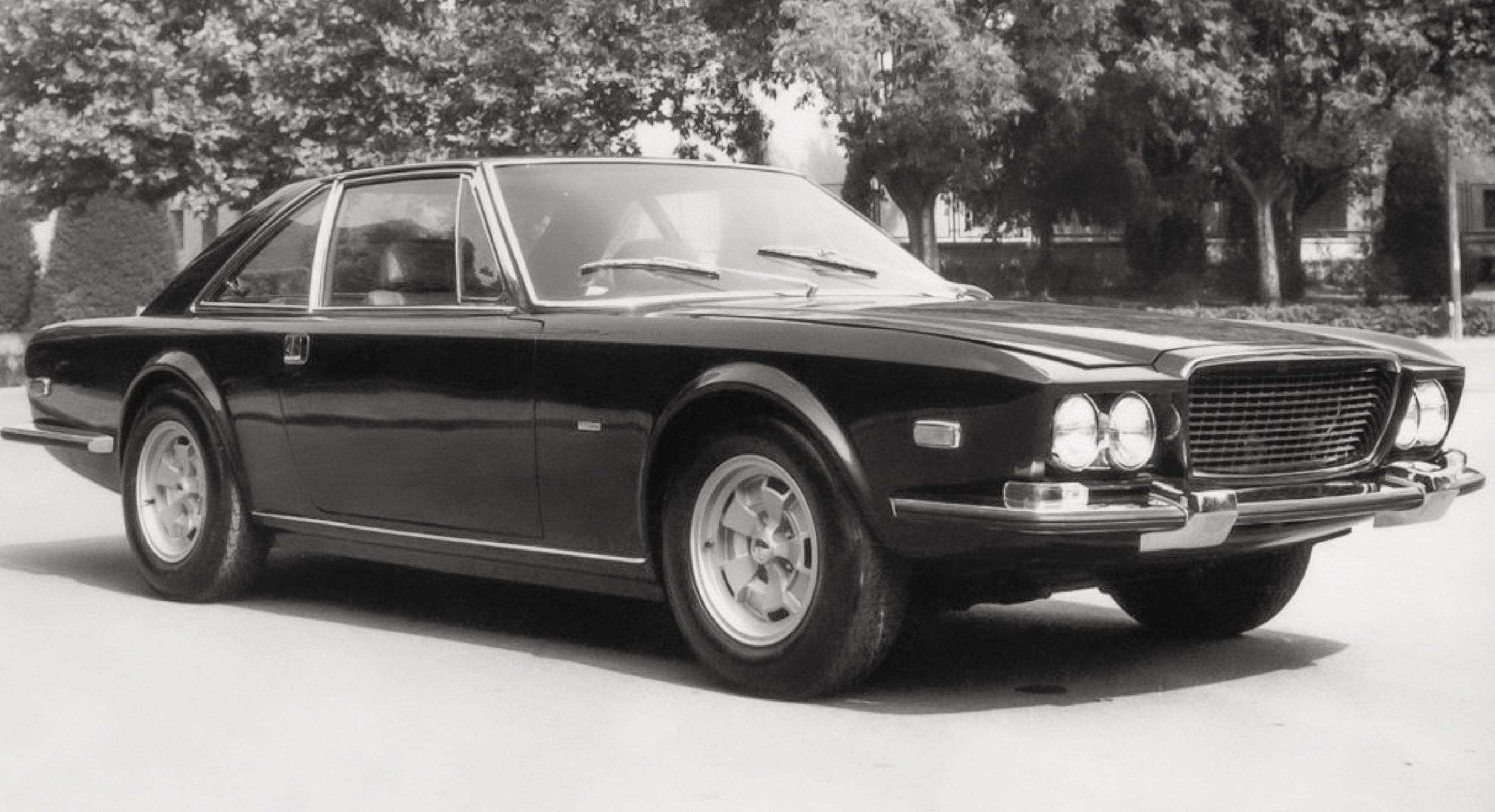
while even a Dodge Challenger and a couple Chevrolet Camaros received a Frua body, paradoxically, this great Italian master never clothed a Ferrari chassis.
The first warning bell for the studio tolled in March 1967. Following an unpleasant dispute with BMW management regarding the continuation of the series production vehicles he had worked on for Glas prior to BMW’s takeover of that firm, Pietro suffered a mild heart attack and fainted at the 37th Geneva Motor Show. He was a big man. It was no secret that he enjoyed the pleasures of the table, and his weight was proportionate. As Derek Hurlock of AC Cars said, “I think he had a weak heart, because I remember he was subject to passing out, and fainted at the Geneva Motor Show one year.” Frua’s health deteriorated slowly in the ensuing years, and by 1979, he was worried that he would not be able to complete the enormous Rolls-Royce Phantom VI parade convertible that was to be his last design—and indeed the car was not finished until after his passing.
On February 24, 1982, Frua made out his last will and testament, leaving all to his convivente Teresa “Gina” Bussolino. The next day he underwent a surgical procedure for prostate cancer. He had a little less than a year and a half to live. Knowing the end was near, Pietro finally married Gina in Turin on June 23, 1983. Five days later, he passed away on June 28, at the age of 70.
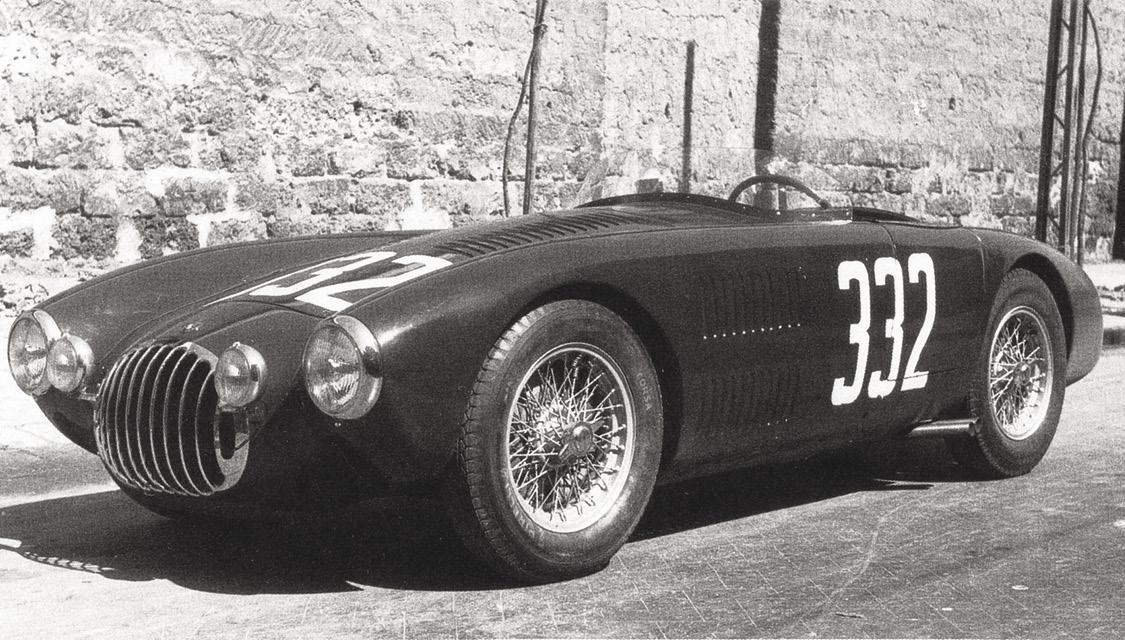
Pietro Frua left a legacy that few automotive designers and coachbuilders can equal. His work epitomized decades of Italian style. A word that finally comes to mind to describe his creations is: elusive. Frua was never in just one place; he was always difficult to pin down. David Bowie, the ever-changing chameleon of popular music, once said that if something works, it is out of date. Pietro Frua had just that focus. Always he was pushing the boundaries of design, always moving with the times and changing with them. This is why his shapes continue to look so fresh and exhilarating today. Perhaps that is then the right word to describe Pietro Frua and his life’s work: exhilarating!
PIETRO FRUA
1971 Momo Mirage chassis 001 was designed and built by Frua for Peter Kalikow on a chassis by Stanguellini and powered by a 5735 cc Chevrolet V8 engine.
44 Pebble Beach Concours d’Elegance INSIDER
Right: 1954 O.S.C.A. 2000 S Barchetta chassis 2004 raced by Luigi Piotti and Bruno Cavallari at the 14th Giro di Sicilia.
ALL ABOUT FERRARI, SINCE 1978
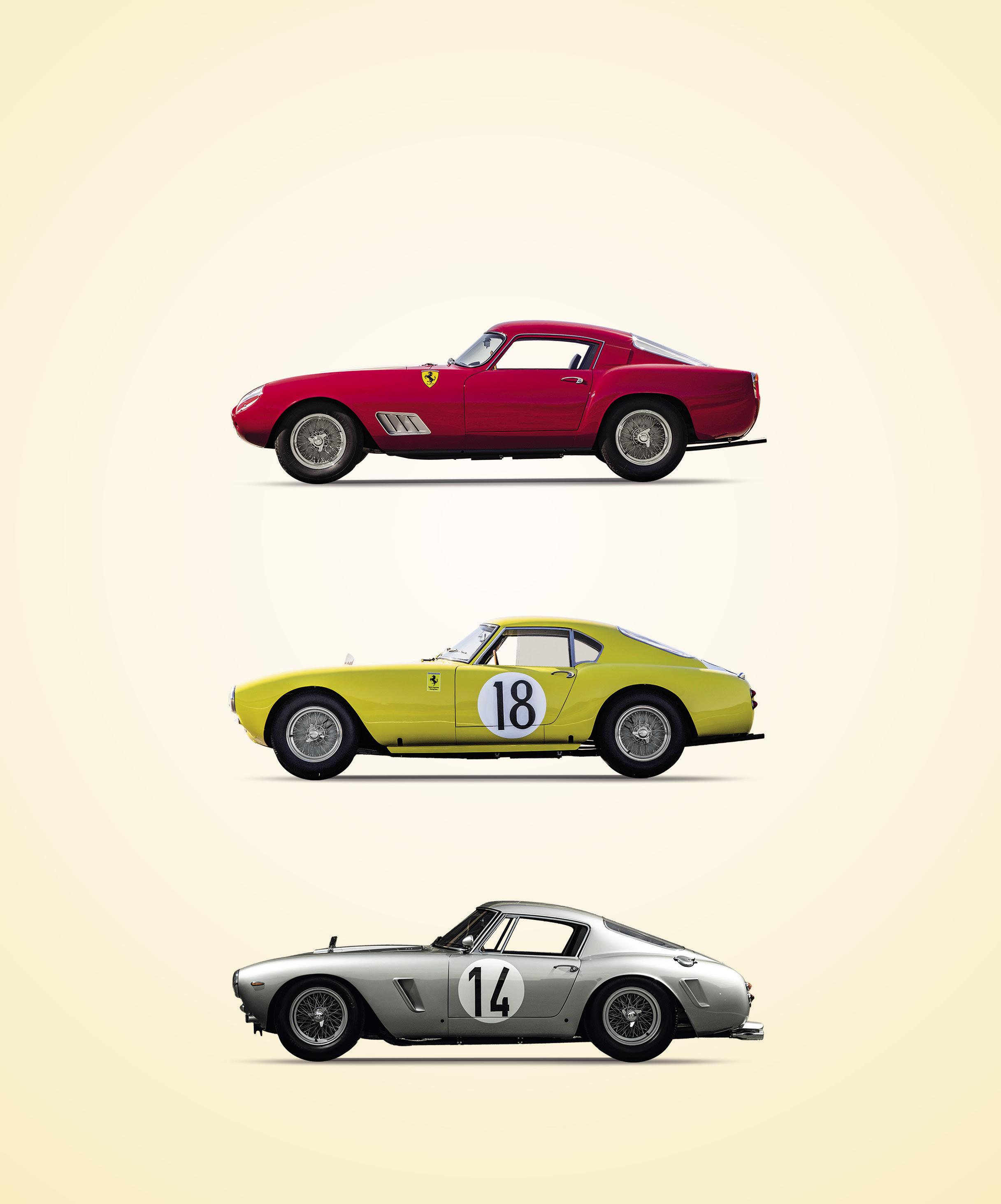

S U BS CRIBE T O TH E M A G A ZI N E
JOI N U S AT C AVA LLI N O C L A S S I C

RESCUING, RESTORING & RACING
By Andrew Cotton
A total of 51 cars took to the starting grid at Circuit Paul Ricard in 1996, when the BPR series was at its peak.
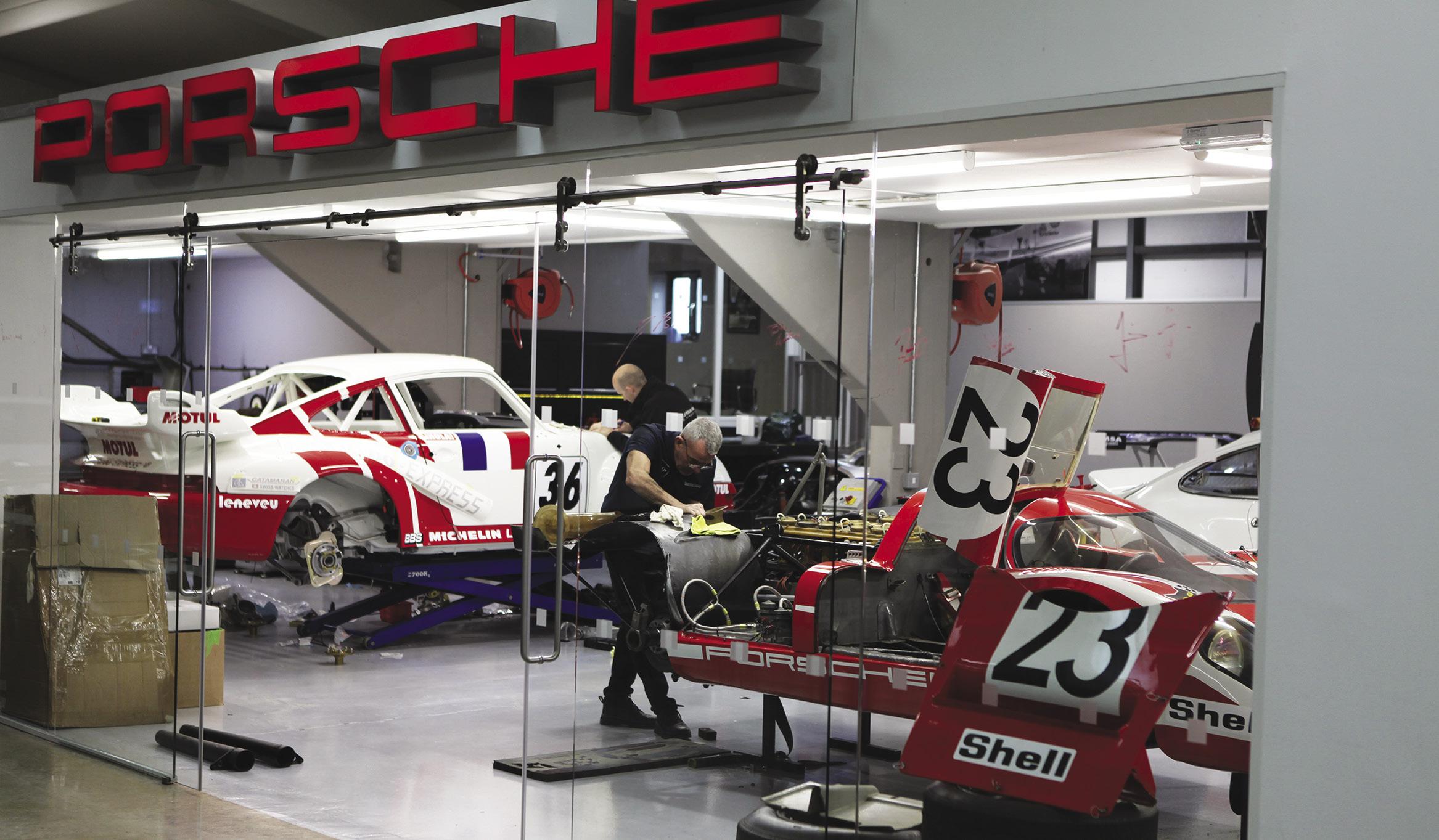
THE SUPERCARS OF THE 1990s
The curtain came down on the BPR Global Endurance GT Series with a race at the Zhuhai International Circuit in November 1996. The circuit was new and unfinished, but the ownership was preparing to bid for the Chinese Grand Prix and this would be the first international race held there. It was no surprise that the BPR organization, teams, and drivers would take on the challenge of this new circuit. This was a series built on passion and ultimately, arguably, killed by professionalism.
The four-hour competition was won by the Porsche 911 GT1 of Ralf Kelleners and Emmanuel Collard, providing a fitting end to a series that had started just two seasons prior, in 1994, to bring together so-called “gentlemen drivers” who wanted to race their exotic cars but had very few options to do so.
The series was founded and run by three people: Jürgen Barth, customer racing manager at Porsche; Patrick Peter,
who wanted to rekindle the classic endurance races; and Stéphane Ratel who had started the Venturi Gentleman Drivers’ Trophy and had a ready-made grid of cars and drivers. They were, in fact, the “BPR” that the series was named for. Races were held mainly in Europe, but there were fly-away events in Japan and China—considered “exotic” locales at the time.
As the series grew in stature, more cars came and the level of competition rose. Even manufacturers wanted to participate—and soon drew the eye of FIA. When Porsche brought its GT1 to the series in 1996, it spelled the beginning of the end of the BPR—and the start of what became the FIA GT Championship in 1997.
Fast forward to today, and the cars are still running. They are also now collector’s items due in part to the qualities that so attracted the amateur driver in their day, but are now amplified by their association with the rebirth of modern GT racing. Their power and speed, yet relative simplicity compared to modern racecars makes them desirable for those wanting to race a supercar. Greatly appreciating in value, cars such as the McLaren F1 GTR and the Ferrari F40 are increasingly mentioned in the same vein as the Ferrari 250 GTO. Other cars that contested the BPR series, including Venturi, Lotus, and Morgan, are also much sought after.
Pebble Beach Concours d’Elegance INSIDER 47
The focus is clearly Porsche for the team at Maxted-Page in Essex, England.
A good part of the BPR legend arose from the participation and success of the Ferrari F40, several examples of which are now in the care of
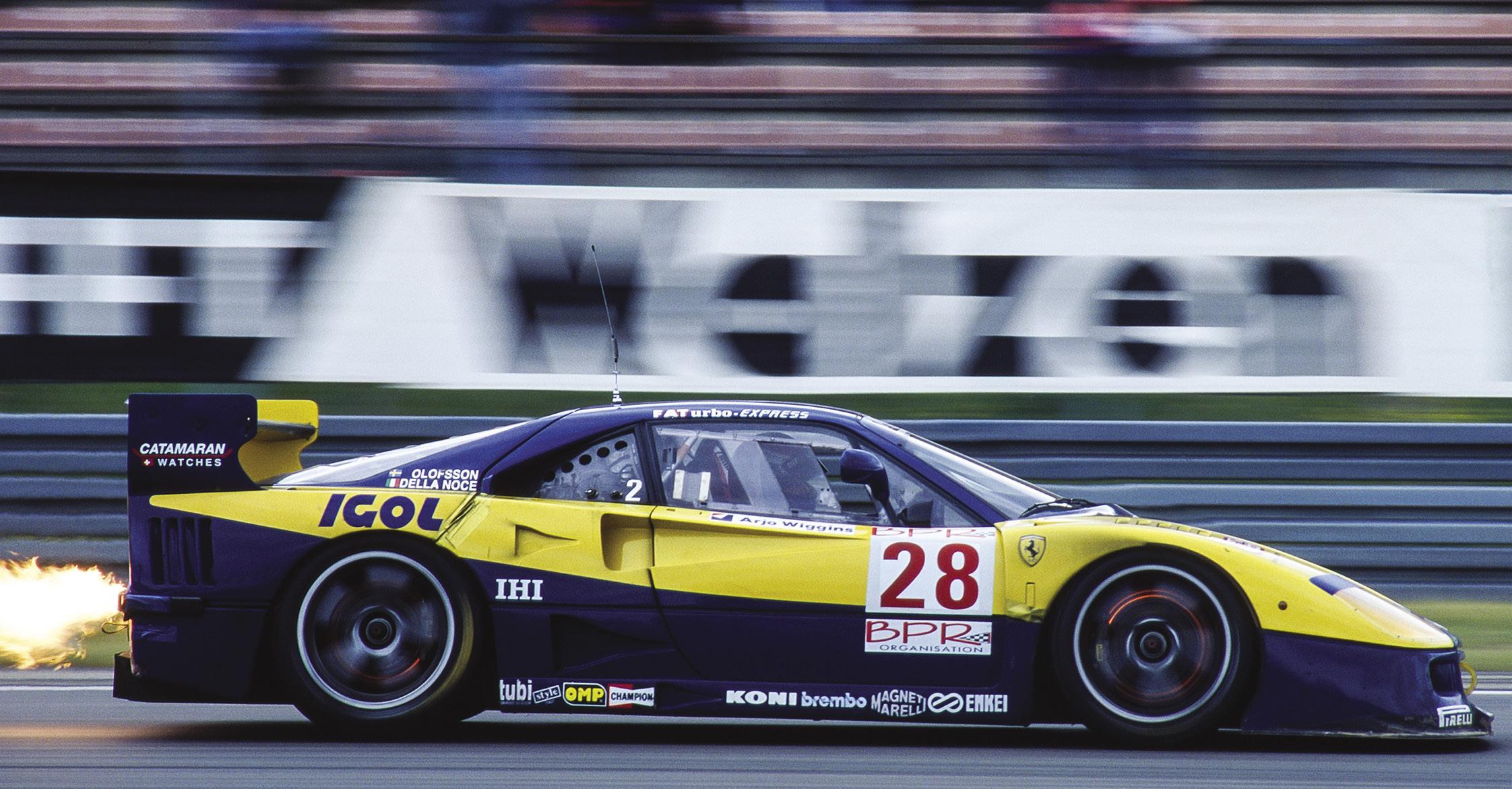
Looking after these cars is now a business for race shops around Europe, which have employed mechanics and engineers who know the cars from this period intimately— their many strengths and their every foible.
PROGRESSIVE MOTORSPORT
Progressive Motorsport has firmly established itself in the field of restoration and houses a wealth of GT and prototype cars restored to full running order. Indeed, they are tested at a nearby airfield before being sent out for competition in the various classic series around the world.
The company was founded by Dave Ward, who was on Rocky Agusta’s team running Callaway Corvettes in the 1990s, and Howden Haynes, who forged his career in the UK but made his name as an engineer in the Audi and Bentley Le Mans programs. With the backing of Reinhold Joest of Joest Racing, they set up a base in Brackley, England, to provide the Audi Le Mans engineering team, then began offering their services to others, starting with managing businessman Sam Li’s Veloqx car collection.
Driving around the estate in search of Progressive, it’s relatively easy to spot the unit that houses the team; there’s an unusual Bentley Continental W12 and a classic Rolls-Royce parked outside. Inside, the team has stored the Bentley Speed 8, Audi’s R8 Le Mans prototype, the Harrods-liveried McLaren F1 GTR from 1995 and an F1 GTR Longtail that raced in the FIA GT Championship in 1997. The company has also worked on some privately owned GT cars, including the Ferrari F40 and the Porsche

993 GT2 Evo, the cornerstone of the early BPR days and the last of the air-cooled 911s.
“The mid-2000s saw very small safety factors, with the advance of Computer Aided Design and Finite Element Analysis, but the BPR cars didn’t have that, so you find that they were over-engineered to do the job,” says Haynes, who has looked after many GT cars during his career as a race engineer and now restores them through Progressive. “The electronics are much simpler, there is no big data system on the car, so in that respect they are still pretty basic cars to work on.”
But he notes that there are a few areas to watch out for with BPR cars: safety features, such as fuel tanks, brake lines, and belts, need to meet modern standards; and original fluids, such as the gearbox oil, were designed to work with materials that are now banned, so modern fluids may not work properly in these cars. These are some of the challenges his team faces as they bring BPR cars to race-ready status.
“The Porsche was a road-going car with a roll cage, so it had big power, big tires, and was what a GT car should be,” says Haynes. “They were brutish cars. There was not much finesse or refinement about them.”
The biggest challenge for Progressive, as for every workshop that prepares these cars, is ensuring that the parts that are fitted remain faithful to the original while also making the cars as safe as possible. The types of bearings that are used can differ from the original, so they need to be prepared and tested as the originals were. “You have
SUPERCARS OF THE 1990s
48 Pebble Beach Concours d’Elegance INSIDER
Michelotto in Padova, Italy.
The McLaren F1 GTR made its mark at Le Mans in the hands of then-Porsche-specialist Lanzante, which now maintains all manner of supercars.
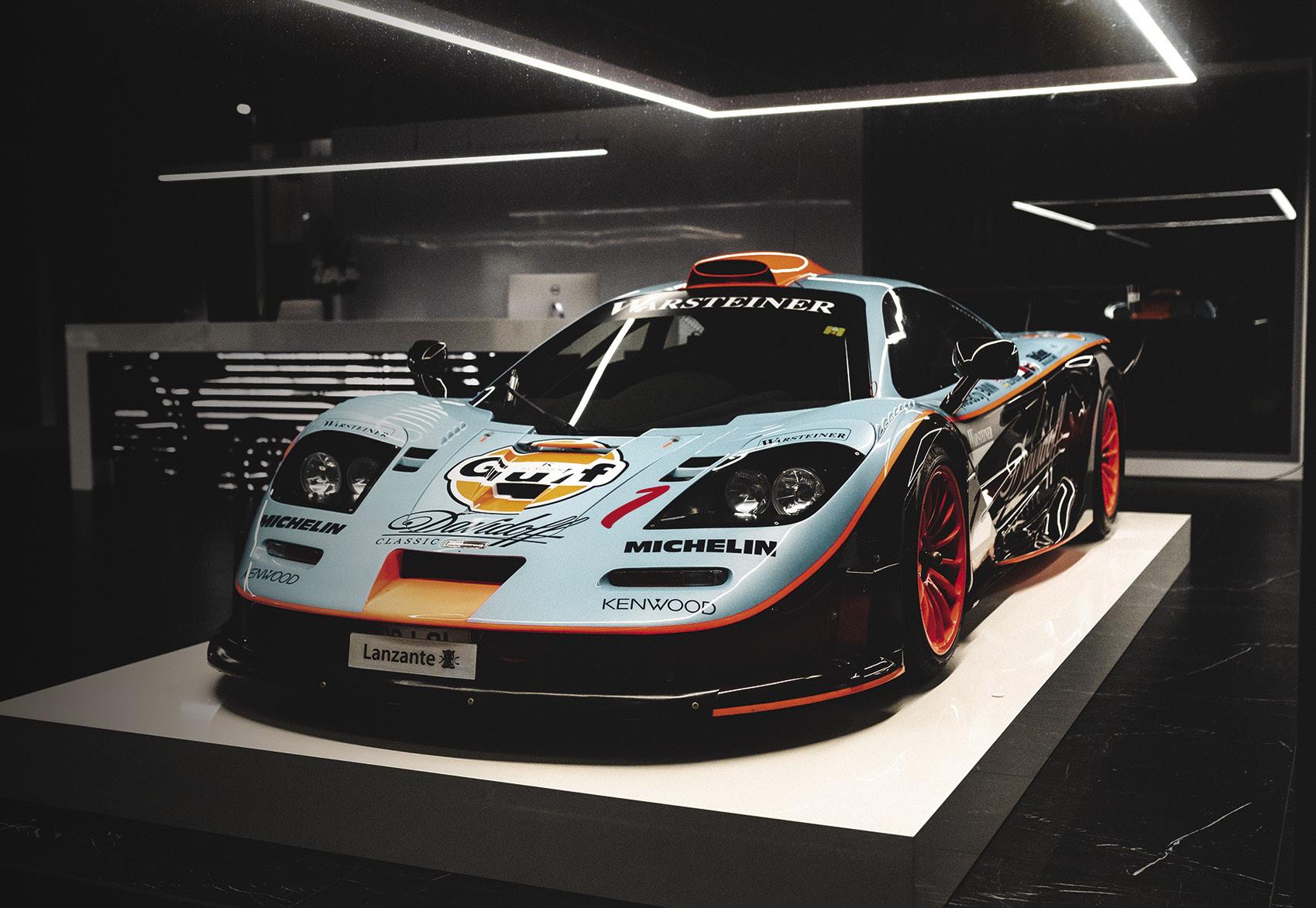
The Maxted-Page team recently restored the ex-Larbre Competition FATurbo 993 GT2 (chassis #393103).
to find the story of the car, see what is still on the car, and then start scouring the Internet to find the right parts to go with your car,” says Haynes. “So few Ferrari F40s or McLaren F1s were made that there are not that many spare parts around.”
Finding original parts takes time, but even broken or worn parts can be used to recreate the necessary components. Although the cars were largely production-based, there are still a few modifications to areas such as the suspension that need careful attention. “There may be a bespoke upright for the car, and you have to work out how to replicate it if it cannot be bought anymore,” says Haynes. “You also have to stay faithful to the design from 30 years ago even if today’s technology is different.”
MAXTED-PAGE
Lee Maxted-Page specializes in Porsches, preparing them for competition. The Briton has a workshop nestled in the British countryside, in Essex, England, where he undertakes everything from rebuilding the engine and gearbox to restoring the overall body. He also races, in the Endurance Racing Legends series that was founded and is run by one of the BPR founders, Patrick Peter.
At the workshop in the spring of 2024 are three 993 GT2s, including one that raced in 1995 but is now road registered. “These Porsches run a Tagtronic ECU and later generations run on Motec systems, so everything can be measured from a laptop,” says Maxted-Page, echoing the sentiment of Haynes, who keeps an old computer

on the premises that will still be able to read the code from the 1990s-spec car. “It is a GT car, so parts have to have motorsport tags and are expensive, but the cars are comparatively easy to race.”
He focuses much of his attention on the engines, which are lifed to between 25 and 30 hours. Today that is around two seasons of racing, but in period it was good for the practice and race at Le Mans. Many early BPRera cars featured pre-sequential gearboxes, so the key to maintaining their engines involves properly changing gears. Mis-shifting and over-revving the engines was, and still is, a danger to any driver or owner looking to run the cars in competition.
SRO RACE CENTRE BY MMC
Housed at the Circuit Paul Ricard, just east of Marseille in France, is the SRO Race Centre by MMC, a facility owned by another of the BPR founders, Stéphane Ratel. The circuit sits atop a mountain and has an airfield next to it and a large manufacturing facility behind it in the town of Signes. One of the most famous names in modern motor racing, ORECA, has its base here. For many years the circuit hosted the French Grand Prix and, after a long hiatus, now does so again. It’s not your usual racing circuit, though. Its remote location, between Marseille and Nice, made it the perfect private test facility for many years before it re-opened its doors to international competition.
Within the confines of the circuit and sitting alongside the famous Mistral Straight is a building that features a large,
Right:
Pebble Beach Concours d’Elegance INSIDER 49
SUPERCARS OF THE 1990s
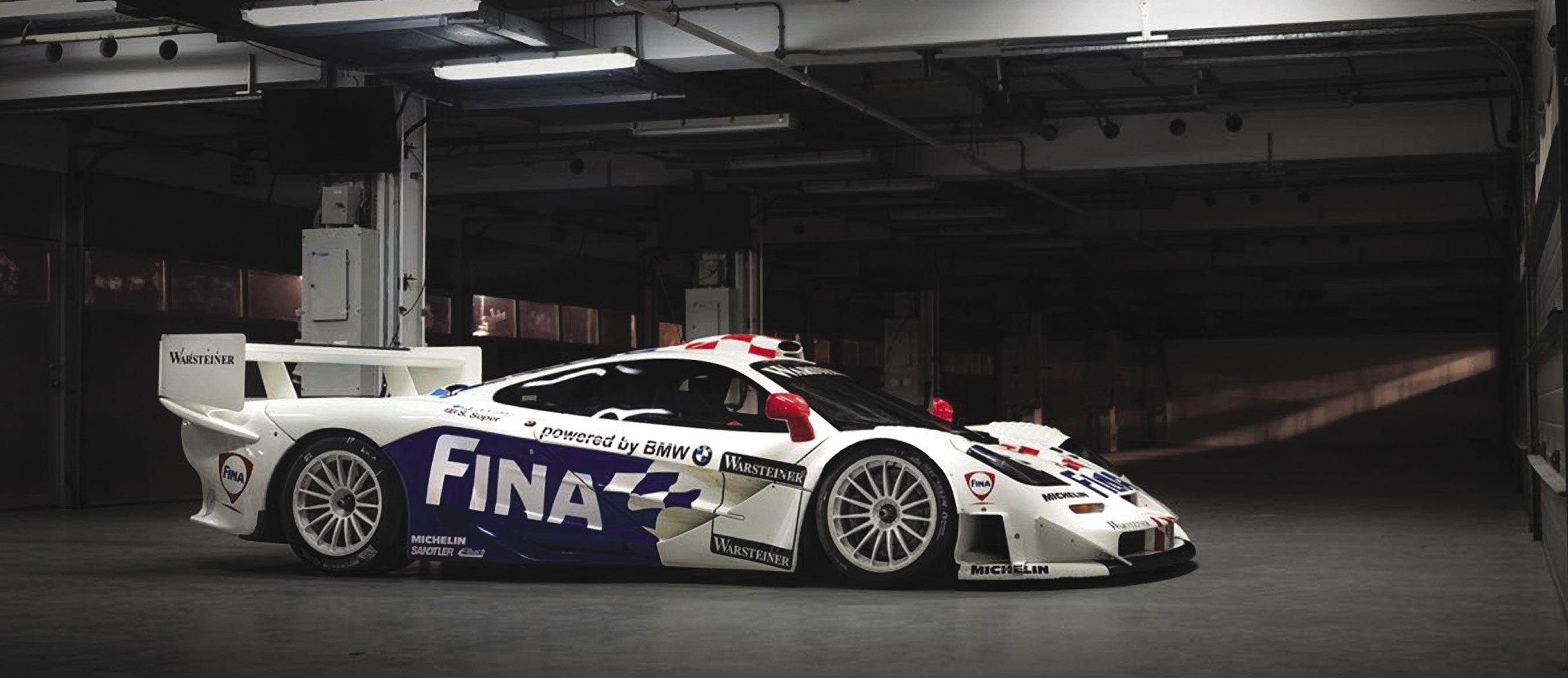
open floorspace with extraordinary GT cars on display for any visitor to see. From early Venturis that were the cornerstone of the first years of the BPR series, to modernday GT cars such as the Bentley Continental GT3, it’s a true journey through GT racing history.
The facility has a workshop that can house up to eight cars at a time, and mechanics that are specialists in Ferrari, Maserati, and Porsche models are in charge of maintaining them.
Other cars in the collection include Corvettes, a Maserati MC12 from the mid-2000s, and a Lamborghini Murciélago—all of which have competed in various racing series organized by Ratel in the last 30 years.
“They are now selling for big money,” says manager Olivier Lyonnet, who has worked with Ratel since before the start of the BPR and who is now charged with keeping the cars ready to run. “They are unique cars, and people are nostalgic about that era. It was the beginning of GT racing as we know it today, and they are legendary cars that are appreciating in value.”
The centre was established in 2014 by Ratel, along with his business partner Michel Mhitarian, to house Ratel’s collection, as well as those of his friends and other enthusiasts who want to have the chance to drive their cars. Mhitarian is a specialist working with exceptional classic and modern cars, and so was the ideal partner for Ratel in this venture.
This McLaren F1-GTR Longtail was restored by Progressive Motorsport, which still looks after it along with other rare supercars including a rare F50 GT and a Porsche 993 GT2 EVO. Right: The SRO Race Centre by MMC is conveniently located right at the Circuit Paul Ricard near Marseille, France.
LANZANTE
Perhaps the most famous of the cars that raced in the BPR era is the McLaren F1 GTR. Campaigned for the first time at Le Mans in 1995, it achieved overall victory, giving McLaren a win on its debut at Le Mans—a rare feat that had not been accomplished since Ferrari won on its debut in 1949. The McLaren win was all the more unlikely because the winning car was never designed to race in the first place, and it was run by Lanzante, a Porsche specialist at that point.
The Lanzante team was started by Paul Lanzante in the 1970s, and after racing in historic motorsport, it moved into modern racing by entering the BPR series in 1995— with a Porsche 911 Turbo driven by Soames Langton, Wido Rössler, and Paul Burdell. The drivers could hold their own against the likes of Stadler Motorsport and Konrad Motorsport in similar machinery, and perfectly epitomized the core clientele of the BPR.
The British team went to Le Mans in 1995 with the #59 McLaren F1 GTR, having been asked by the factory to run it with Japanese sponsor Kokusai Kaihatsu Racing. While the factory also put together the driving team of JJ Lehto, Yannick Dalmas, and Masanori Sekiya, it was very much a privateer entry as McLaren knew that racing its customer cars could jeopardize their entire program. Lanzante’s brief was to support and run #59, but when it became clear the car could win the race outright, the two-tone grey F1 GTR was given the full support of all of the McLaren teams. That car is now housed at McLaren’s
50 Pebble Beach Concours d’Elegance INSIDER
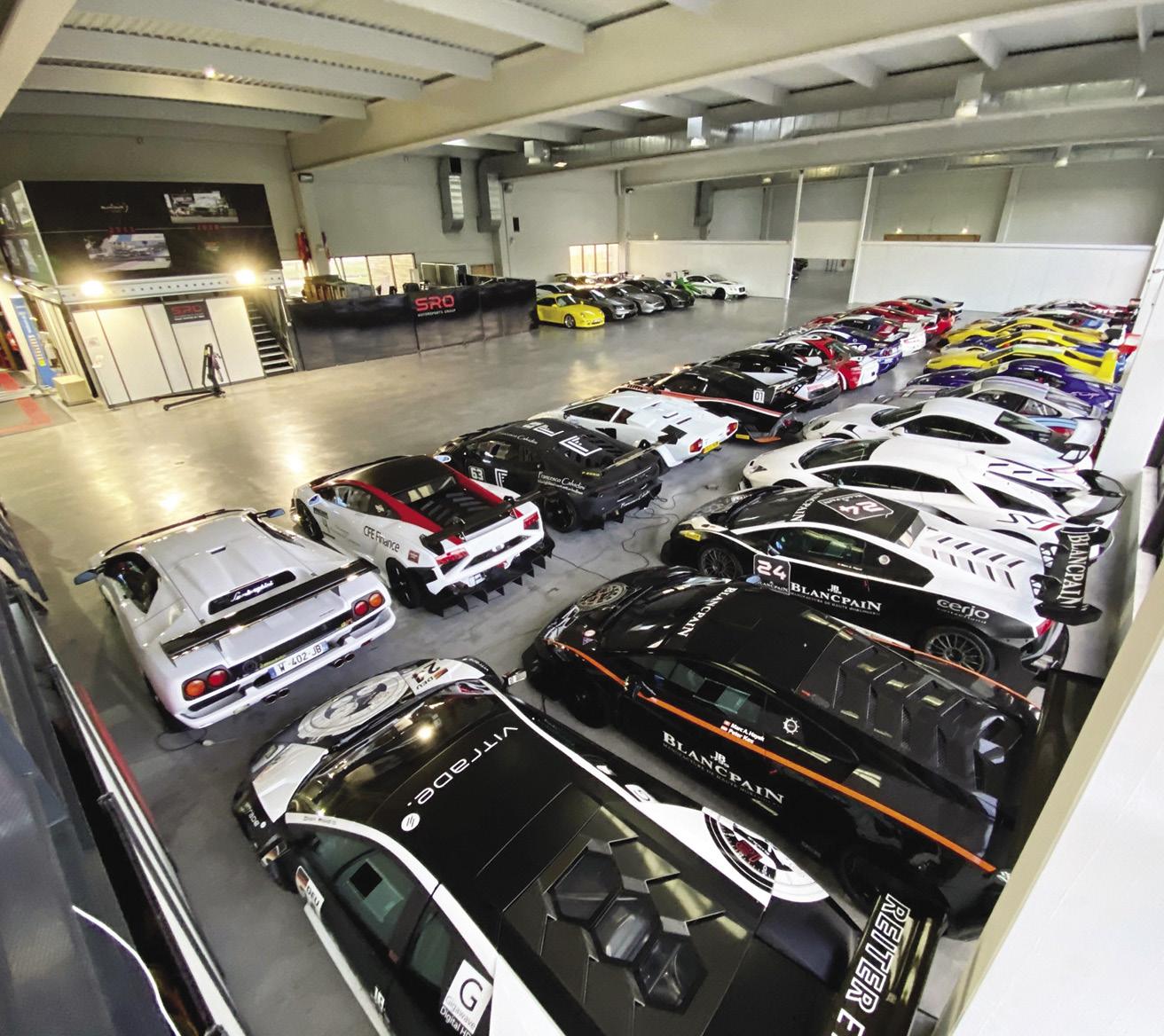
headquarters in Woking, England—just 30 miles from Lanzante—while others, both shorttail and the later longtail versions that raced in 1997, are held in private collections around the world.
Lanzante later bought a McLaren for its own use in the 1996 British GT Championship and continued to race in the BPR series in 1996 with a Porsche 911 GT2. Alongside these racing activities, an owner requested that their F1 GTR be made road legal, and Lanzante completed this conversion in 1997. Thereafter, the company converted several of the track-only racers to road specification, and followed with the first conversions of the McLaren P1 GTR. Since then, the automotive engineering specialists have converted over half of the 58 cars built, giving a new lease on life to a new breed of track car.
Today, Lanzante Limited is run by Paul’s son, Dean Lanzante, with a state-of-the-art workshop and showroom, opened in 2019, based in the English countryside. The modern architectural facility in Petersfield, Hampshire, houses a glittering array of cars, such as the Davidoffsponsored longtail McLaren F1 GTR that competed in the FIA GT Championship in 1997. And it is now renowned for the work done to restore and maintain all manner of high performance and exclusive supercars, including McLarens from all eras, with road conversions and historic racing going hand in hand with bespoke engineering projects.
MICHELOTTO
Ferrari’s F40 was one of the first cars to race in the BPR series, entered by teams such as Strandell and Rocky
Agusta. Against the Porsche 968s and 911 RSRs, as well as the Venturi 600LMs, the F40s were essentially a hammer used to crack a nut. However, they represented the most desirable brand in the 1990s and are revered today—pure racing cars that could also run on the road, powered by a 3-liter V8 turbocharged engine.
Many of these cars were built, and today are maintained, by Michelotto in Italy. The company has a long association with Ferrari, and more recently developed the GT2 and GT3 cars for the carmaker. The company was founded by Giuliano Michelotto in 1969 and was commissioned to run the F40 GTE cars in 1994.
Famously secretive, Giuliano’s son, Cristiano, once said that they “prefer to work in the shadows” rather than in the limelight. That does not detract from the company’s expertise. Based in Padova, on the outskirts of Padua, Italy, the company combines the design and build of modern race cars, such as the Isotta Fraschini, with the maintenance of the F40s.
FIRST OF THE MODERN GT ERA
BPR cars are not complicated by today’s standard. They were built as some of the most desirable supercar models of the time and then were adapted for racing. Many were given a place to race by the BPR series—and many wealthy amateur drivers took the opportunity to do so.
Unlike today’s race cars, which require skills that are more focused on the track, BPR cars were the first of the modern GT era—and perhaps the last of the traditional GT cars that could be raced.

Pebble Beach Concours d’Elegance INSIDER 51
This Porsche 911 GT1 Evo at SRO raced in the 24 Hours of Le Mans in 1997, driven by Emmanuel Collard, Ralf Kelleners and Yannick Dalmas.
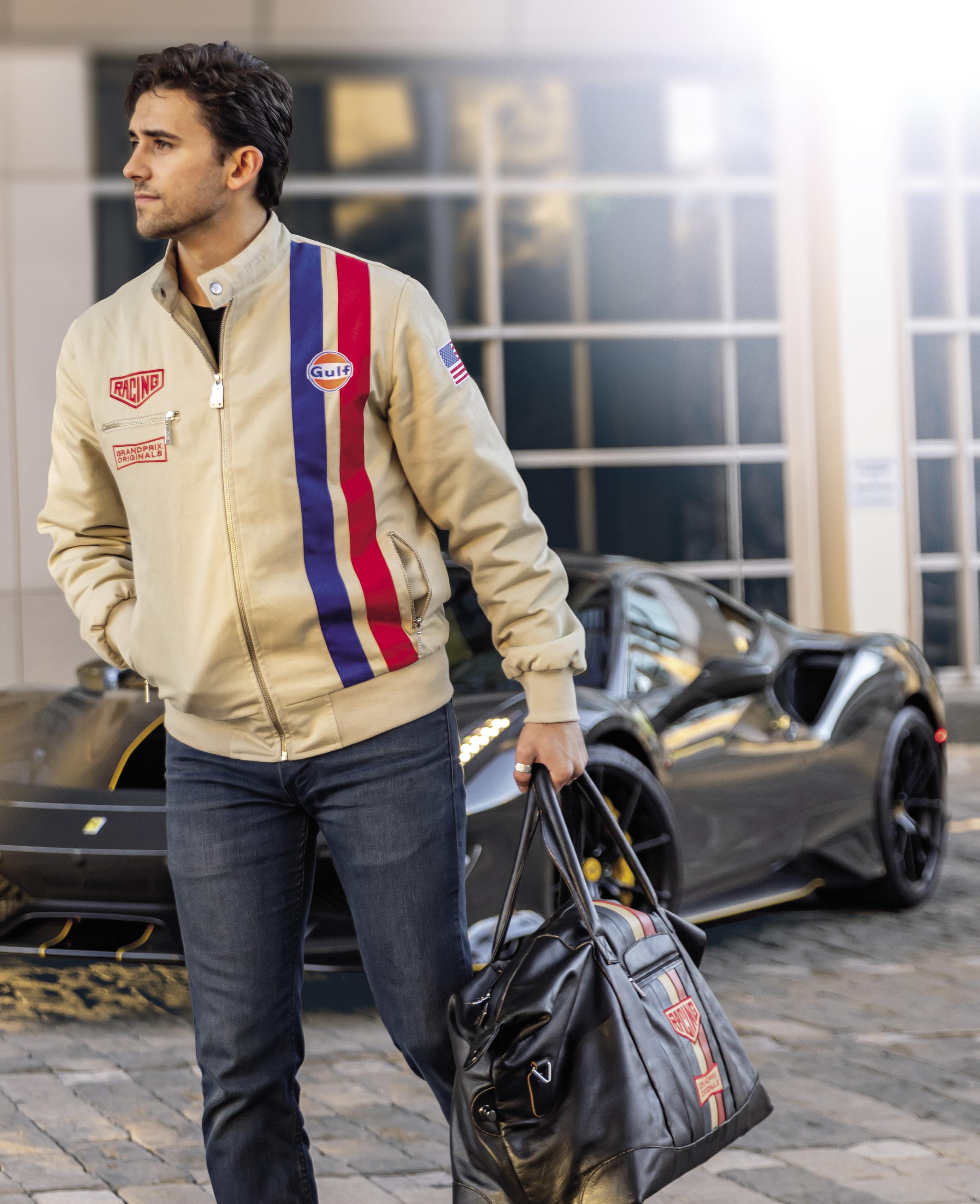

Wear what drives you! @gporiginalsusa www.grandprixoriginalsusa.com
Since its inception in 1975, Pebble Beach Company Foundation has been the charitable partner of the Pebble Beach Concours d’Elegance. With the help of Concours entrants, donors, judges, volunteers and sponsors we are proud to support local youth-focused nonprofits who are addressing the critical needs in our community.
Our Mission
To provide quality educational opportunities for Monterey County youth.
Our Vision
Education changes lives. For nearly five decades we have been committed to funding quality educational programs and awarding scholarships and financial aid to benefit Monterey County students from prekindergarten to postgraduate levels. These awards create a brighter future for our youth and our community
Who We Serve
We seek to provide every child in Monterey County with the tools, opportunities and experiences to grow and thrive on their journey to adulthood. We’ve learned that fostering the energy and determination of these young people requires tools, guidance and experiences. In 2023, Pebble Beach Company Foundation made grants to nearly 100 organizations, totaling over $3 million in support and reaching more than 10,000 youth. These grants provide opportunities that expand their world. Together with Pebble Beach Concours d’Elegance and our innovative nonprofits, we are working to provide a brighter, happier future for our youth.

Signature Events
Pebble Beach Concours d’Elegance ■ Hickory Sticks Open ■ Pebble Beach Food & Wine
COMP ANY FOUN DA TION
pebblebeach.com/pbc-foundation

1970 LANCIA STRATOS ZERO
By Gautam Sen
Paolo Martin’s 1967 Dino 206 Competizione was a direct response to Marcello Gandini's 1967 Lamborghini Marzal. Both were early almost-there wedge designs. Opposite: Arguably the ultimate wedge machine, at just .846 meters (33.3 inches) tall, the 1970 Lancia Stratos Zero was designed by Marcello Gandini at Stile Bertone.
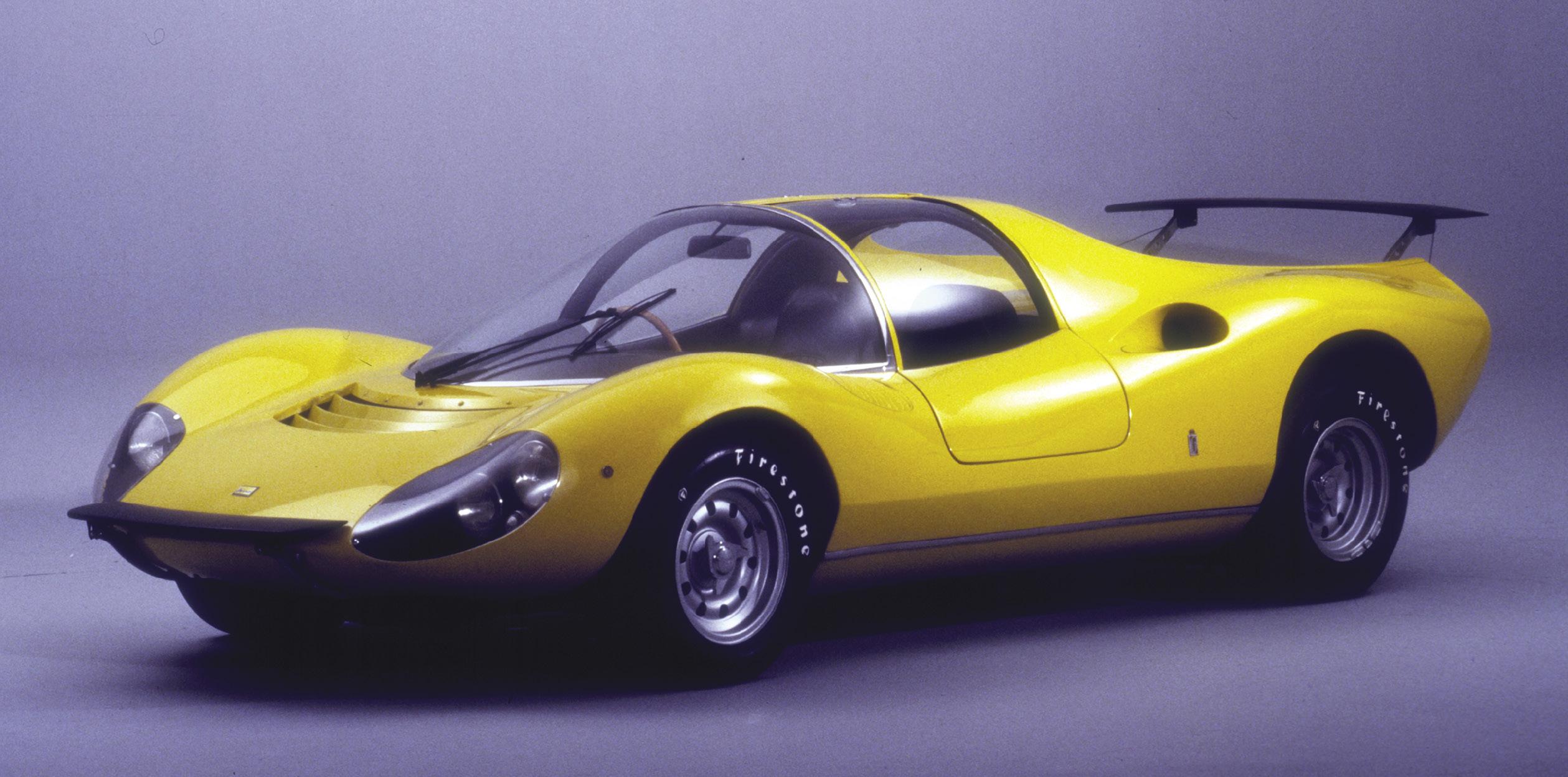
It was in July of 1968 that the Turin-based Italian carrozzeria of Nuccio Bertone received the ninth chassis made by Alfa Romeo of its 33 Stradale super sportscar, a voluptuous Franco Scaglione–designed bolide, which had been launched barely nine months earlier at the Paris Auto Salon of 1967.
Offered at an ex-factory price of 9.75 million lire (then around US $17,000), when a Lamborghini Miura retailed for 7.7 million lire, the 33 Stradale was the most expensive car in the world. Unsurprisingly, sales were slow, so Alfa Romeo decided to get a couple of Italy’s leading coachbuilders to design bodies for it. Italy’s numero uno coachbuilder, Pininfarina, was the first to receive a chassis (# 750.33.108), in June of 1968, the month before Bertone received one.
Apparently well aware that his archrival had already received a chassis—Turin was and is a “small world,” and word gets around quickly—Bertone made clear to his 29-years-old chief designer, Marcello Gandini, that a concept on their chassis (# 750.33.109) was a priority; he wanted the prototype to be unveiled at the Paris Auto Salon that fall.
Ten weeks later, just in time for the salon, the Alfa Romeo Carabo concept was ready to go “live.”
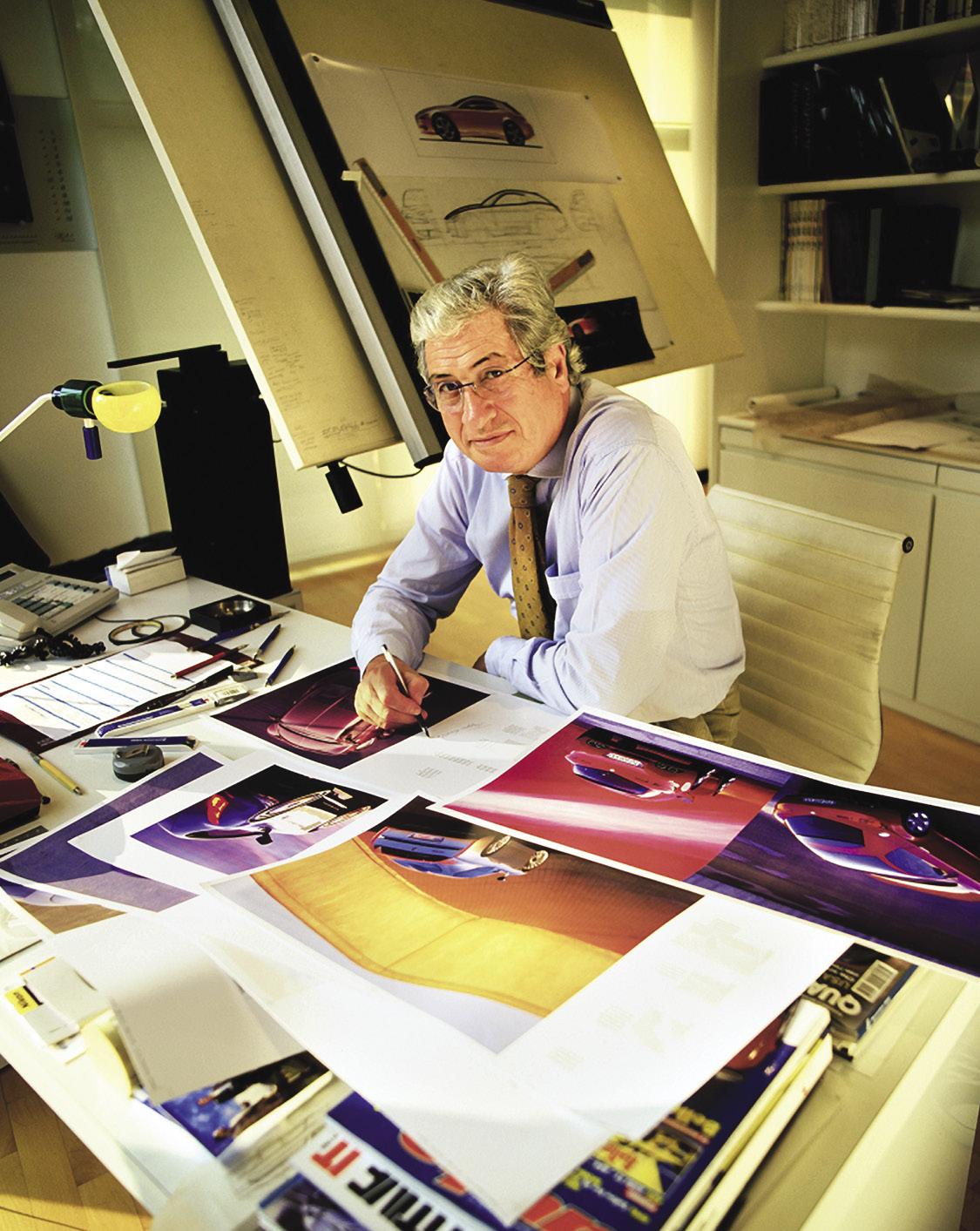 Giorgetto Giugiaro in his studio.
Giorgetto Giugiaro in his studio.
Pebble Beach Concours d’Elegance INSIDER 55
1967 DINO 206 COMPETIZIONE
through the industry.

1968 ALFA ROMEO CARABO
At the opening of the 55th edition of the Salon de l’Auto, in Paris, on October 13, 1968, a surreal wedgeshaped sculpture of steel, glass, and layers of scaly metal astounded showgoers with its daring shape and extraordinary form.
The Carabo was an exercise in lateral thinking at just about every level. With headlamps covered by retractable slats and doors that opened, for the first time ever, with a scissor action, the Carabo rewrote the rules of automobile design, kickstarting an avalanche of extreme wedge forms—a trend that remained in vogue for the best part of the next two decades.
It wasn’t the first time that a prototype designed by Marcello Gandini had made waves on its debut. His Lamborghini Miura, offered just three years prior, is often said to have been the first supercar.
The son of a musician and orchestra conductor, Gandini opted for a

Arguably one of Tom Tjaarda’s finest designs, the 1969 Lancia Fulvia 1600 HF Competizione looked light, purposeful, and very pretty.
career designing cars after he chanced upon a Cord 810. He landed the job as the head of design at Carrozzeria Bertone in November 1965, when former design chief Giorgetto Giugiaro left the firm to join Ghia. Gandini worked on just two projects, a Porsche 911 and a Jaguar S Type, before being assigned the chassis that Lamborghini had exhibited for the first time on November 3, 1965, at the Turin Motor Show. The Lamborghini Miura was launched at the 1966 Geneva Motor Show, on March 10, barely four months later.
“The Lamborghini Miura, you know, was influenced by cars and designs from before,” Gandini said in a January 2024 interview for this article, two short months before his death. “As far as I see it, it wasn’t a revolution. It was at the beginning of my career, and I didn't have enough autonomy to be able to
MASTERS OF THE WEDGE
The 1968 Alfa Romeo Carabo penned by Marcello Gandini brought fully formed wedge shapes to the fore, sending shock waves
56 Pebble Beach Concours d’Elegance INSIDER
By 1970, even more conservative manufacturers were proposing wedge-shaped cars, such as this Mercedes-Benz C111.
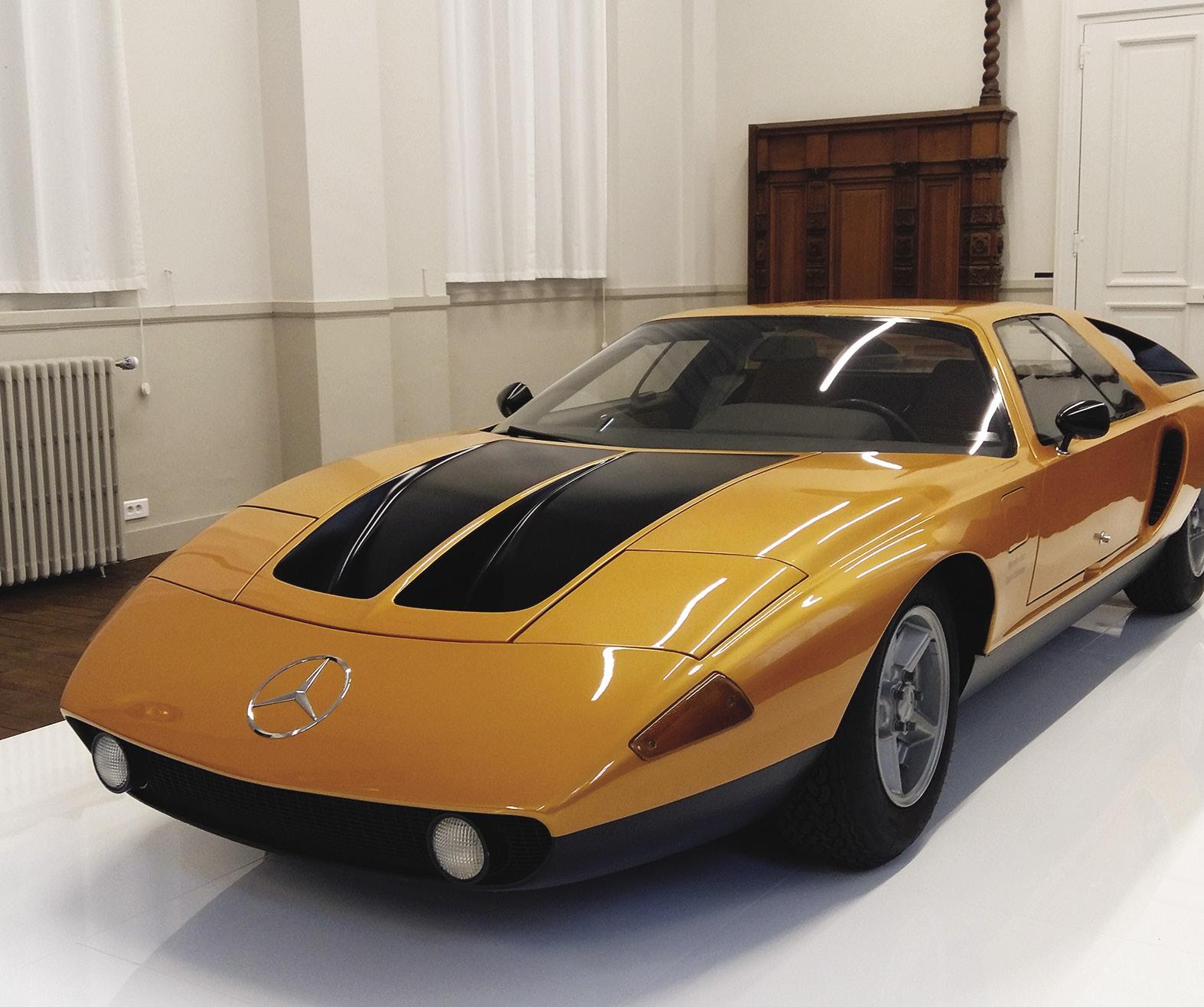
1970 MERCEDES-BENZ C111
do exactly what I wanted to, so I used some of the form language of the great sports cars from the late 1950s and early 1960s. I tried to do something a bit different, but which, at the same time, was something that people were familiar with. I tried to mix aggressivity with some sweetness. The design of the Miura was a compromise between the desire to do something new, and something different, but not to displease the public.”
Gandini’s design for the Lamborghini Miura was influenced, no doubt, by the Alfa Romeo Giulietta SZ Coda Tronca via the Ford GT40 racing machine, which had a slim front end complimented by a thicker rear. So was the Miura an early Wedge design? “No, not really,” said Gandini. “In the Miura, what little audacity there was was made acceptable by the classical flow of the design. Nobody rejected the Miura; there was immediate consensus—even more than the car deserved.”
It was the astounding Lamborghini Marzal, unveiled at the next Geneva Motor Show in 1967, that allowed Marcello Gandini to showcase completely fresh thinking, and it was a sensation. It was a gorgeous rendition of the low nose, thick rear trend for sports coupes that had come into vogue since the rediscovery of the Kamm-back look.

The evolution of the Wedge drew on the work of the Hungarian aerodynamicist Paul Jaray, and the experiments of the German aerodynamicist Wunibald Kamm, including his Kamm-Wagens, which contributed to the design thinking that went into streamlining cars. Into the 1950s, cars such as the Porsche 356, the Citroen DS, the Alfa Romeo B.A.T. series, as well as the seminal Ghia Gilda, followed the aerodynamic principles set forth by Jaray.
The pivotal moment, though, came with the introduction of the Alfa Romeo Giulietta SZ Coda Tronca in 1961, redesigned by Ercole Spada. This car featured a truncated rear design, resulting in improved speed due to positive turbulence effects. Subsequent models like the Giulia TZ and TZ2 continued this trend, solidifying the concept of a tapering front and a thicker rear with a sudden cut-off. Overall, these developments marked a significant shift in mainstream automobile design, paving the way for wedgeshaped cars like the Lamborghini Marzal.
“By putting the engine at the rear, it was possible to opt for a low nose and relatively higher rear, yet leave some space for luggage at the front,” noted Gandini. “The Marzal must also be seen live because it changes a lot compared to
The Carabo rewrote the rules of automobile design, kickstarting an avalanche of extreme wedge forms — a trend that remained in vogue for the best part of the next two decades.
Tom Tjaarda, shown here in the early 1980s, penned many wedge shapes while at Ghia.
Pebble Beach Concours d’Elegance INSIDER 57

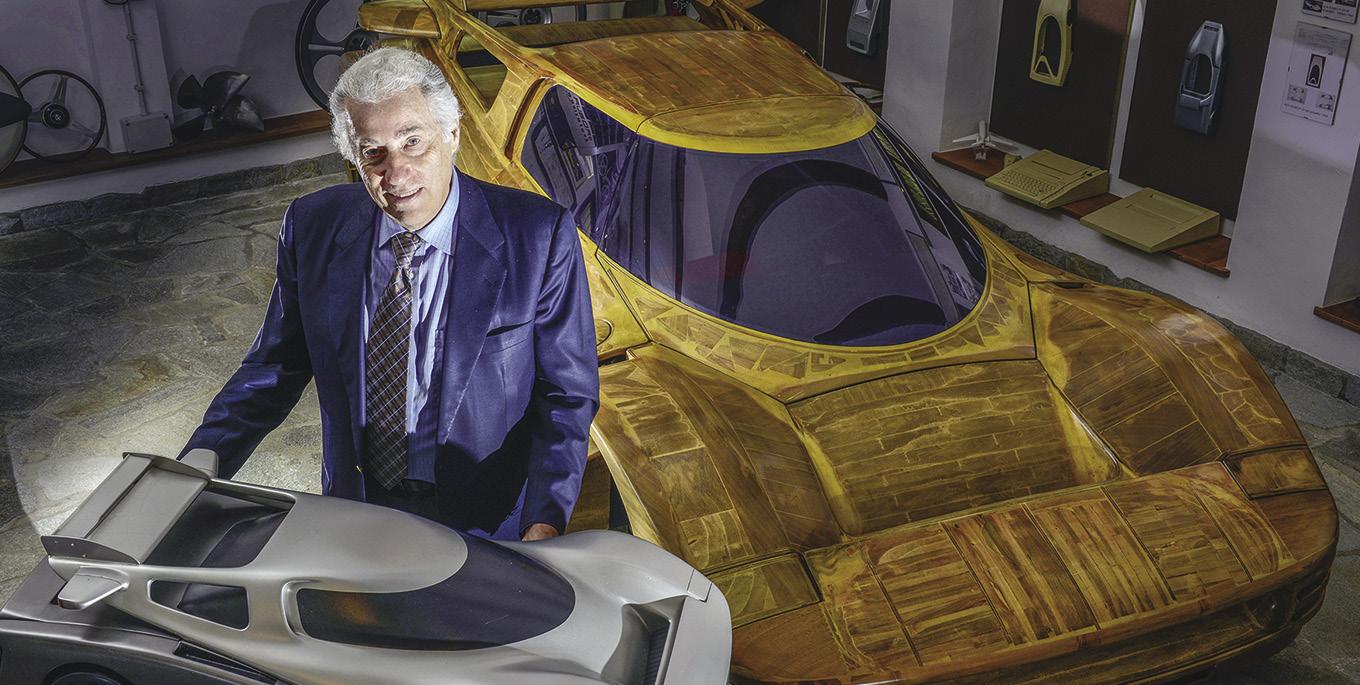
photographs. It is much better when on the move; it’s eyecatching to see it speeding along the road. . . . Giampaolo Dallara at the time thought it should go into production. Even today when I meet him, he always says ‘The mistake of Lamborghini’s life was not producing the Marzal.’”
The Lamborghini Marzal was an almost-but-not-quitethere wedge design of exquisite proportions; it had enthusiasts and journalists suggesting that Bertone was more progressive than its Torinese rival, Pininfarina.
Pininfarina retaliated with the gull-winged Dino 206 Competizione Prototipo at the 1967 Frankfurt Motor Show, executed by the young and talented Paolo Martin, and followed that with the Ferrari 250 P5 Speciale, an evolution of that Dino. Both of these creations were done in accord with the Pininfarina house style of voluptuous forms and undulating surfaces, which was beautiful but not as revolutionary.
Nonetheless, the gloves were off—and soon others joined the contest. Along with Gandini at Bertone and Martin at Pininfarina, Giorgetto Giugiaro at Italdesign and Tom Tjaarda at Ghia, as well as a few other leading and ensuing designers, set forth the striking lines—the wedge shapes— that would body cars for many years to come.

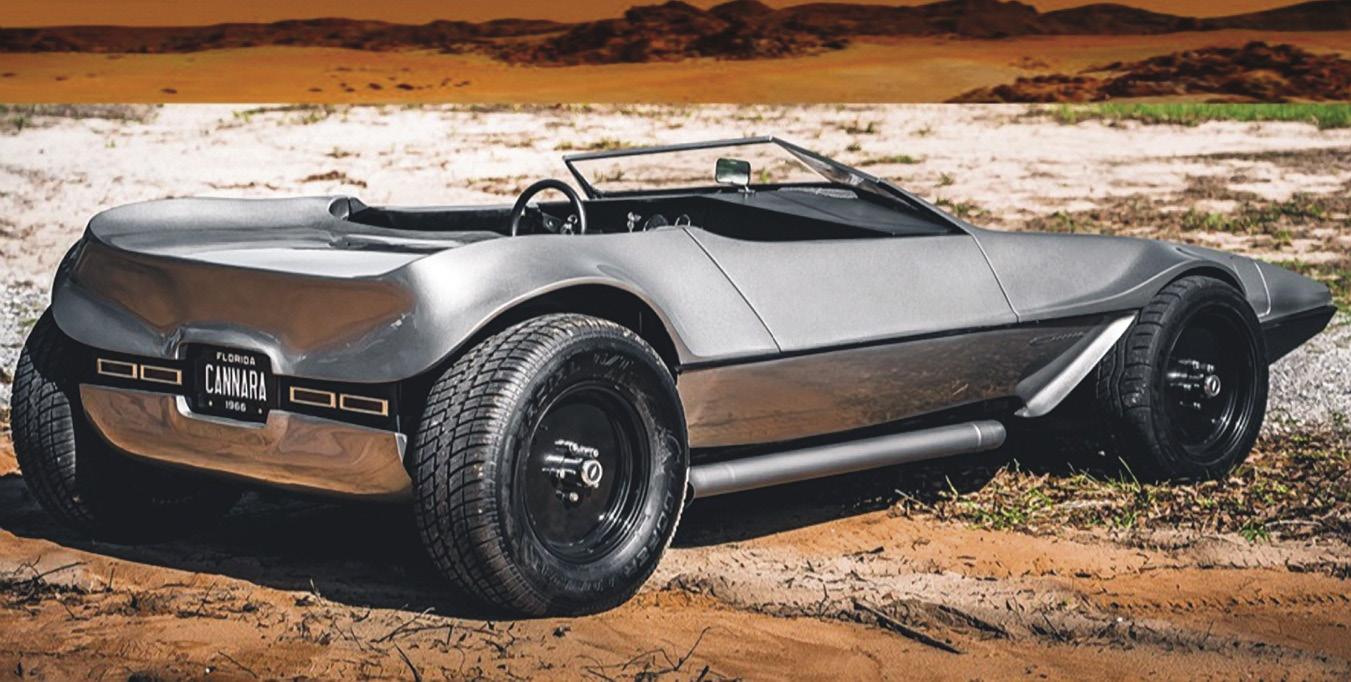
“I think we were all heading in that direction,” said Gandini, in all modesty. “Tom Tjaarda, Italdesign, and others were also working towards this kind of design— dessin en coin—as the fronts were getting slimmer and at the rear, we were looking at Kamm tails.”
As early as 1966, the Cannara 1, a Corvette-based roadster drawn by ArtCenter College of Design student Ray Cannara, exhibited a striking Wedge shape. But the majority of the early Wedges were penned in Italy.
Born in 1943, Paolo Martin honed his skills with design legend Giovanni Michelotti, before working a short stint under Gandini at Bertone, and then moving to Pininfarina, where a series of innovative concepts astounded showgoers. Giugiaro, born a few days before Gandini on August 7, 1938, began his career at a very young age at Bertone, before joining Ghia in October 1965, and then establishing his own firm, Italdesign, in 1968, where his brilliance would be on full display.
Tom Tjaarda, born in 1934, was the odd man out, the only non-Italian amongst the leaders of the Wedge brigade. Yet, he was as Italian as an American could ever be, having moved to Turin in 1958 when he was just 24 years old, immediately after graduating as an architect. He started at
“The mistake of Lamborghini's life was not producing the Marzal.” — Giampaolo Dallara
MASTERS OF THE WEDGE 58 Pebble Beach Concours d’Elegance INSIDER

1967 LAMBORGHINI MARZAL
Carrozzeria Ghia, was with Pininfarina from 1961 to 1965, then eventually returned to Ghia, where a series of wedgeshaped cars emerged from his sharpened pencil.
The wedge car, though, drawn by the pencil sharpened the most was the one unveiled at the Paris Auto Show of October 1968—the Alfa Romeo Carabo.
“With the Lamborghini Marzal I could experiment with form language, and I had the freedom to develop a new chassis too,” explained Gandini. “With the Carabo we had very little time as the car needed to be ready in ten weeks.”
“The Miura still had problems regarding front end lift,” he explained. “With the sharper, lower front of the Carabo, I was hoping to address that problem.”
A month after the Carabo grabbed headlines at the Turin Motor Show, Pininfarina showcased two more concept cars, the Alfa Romeo Stradale P33 Roadster (also by Paolo Martin) and the Ferrari P6 Berlinetta Speciale, both of which, alas, were a bit underwhelming.
A more interesting concept, the Bizzarrini Manta, was unveiled by Giugiaro’s new Italdesign studio. A true Wedge, it was striking at some angles, but a little fat and flat at the rear.
In 1969, Italdesign came up with their take on the Alfa 33 chassis, the Iguana. And Bertone’s riposte was the
Gandini’s 1967 Lamborghini Marzal was an early almost-there wedge design. Opposite: clockwise from top left: The Tom Tjaarda-designed 1970 De Tomaso Pantera was the first of many series-production wedge designs; Marcello Gandini’s studio was his haven; ArtCenter student Ray Cannara designed the Cannara 1; and Paolo Martin designed some of Ferrari’s most notable wedges.
Autobianchi Runabout—a sweet and cute little wedge-like roadster that looked a lot like the Cannara 1.
Pininfarina’s concept car, the Ferrari 512 S Berlinetta, was a real stunner, though: a sharp-edged wedgester that retained the Pininfarina’s flowing undulating lines—and yet the Filippo Sapino-designed space car was incredibly low, under a meter high, at 0.98 (38.6 inches), beating the Carabo’s 0.99 (39 inches)!
By 1969, most concepts—the Richard Teague-designed AMC AMX2, the Mercedes-Benz C111, even the Toyota EX-III, amongst others—were wedge-edged flights of fancy. By 1970 almost all were.
Pininfarina’s Ferrari 512 S Modulo, displayed at the Geneva Show during March 1970, was a startling flying saucer—arguably Paolo Martin’s finest concept car design and one of Pininfarina’s most distinctive ever.
When asked what led him to design this on-the-road UFO, the 81-year-old designer explained: “With reference to this Wedge ‘fashion’ of the ’60s/’70s, and partly thanks to the availability of sports chassis and engines, it was possible to broaden the search for style. The aerodynamics were very intuitive; what was important for a good CX was the reduction of the transverse section. The Ferrari Modulo was a dream car, an exercise in imagination that did not need to comply with any current legislation.”
Pebble Beach Concours d’Elegance INSIDER 59
MASTERS OF THE WEDGE

1970 FERRARI 512 S MODULO
Barely 0.935 meters (36.8 inches) high, the Ferrari 512 S Modulo was sleek, sweeping, and innovative in its details, such as the sliding canopy and enclosed wheels.
And then Marcello Gandini came up with something even more amazing.
“Nuccio Bertone came back from Geneva and asked me to design something that would catch the attention of Lancia,” explained Gandini. “And he wanted it to be a pure concept, something that worked but didn’t need to be constrained by production realities.”
Unveiled on October 28, 1970, to an unsuspecting public, the projectile at the Bertone stand was officially christened the Stratos HF, although Nuccio Bertone had initially wanted to call it Stratolimite, clearly referring to the conquest of space after the moon landing. Over the years, though, the car would become known by the moniker given by Carrozzeria Bertone: the Lancia Stratos Zero.
To say that the showgoers to the Salone di Torino that year were
“The Ferrari Modulo was a Dream Car, an exercise in imagination that did not need to comply with any current legislation.”
— Paolo Martin

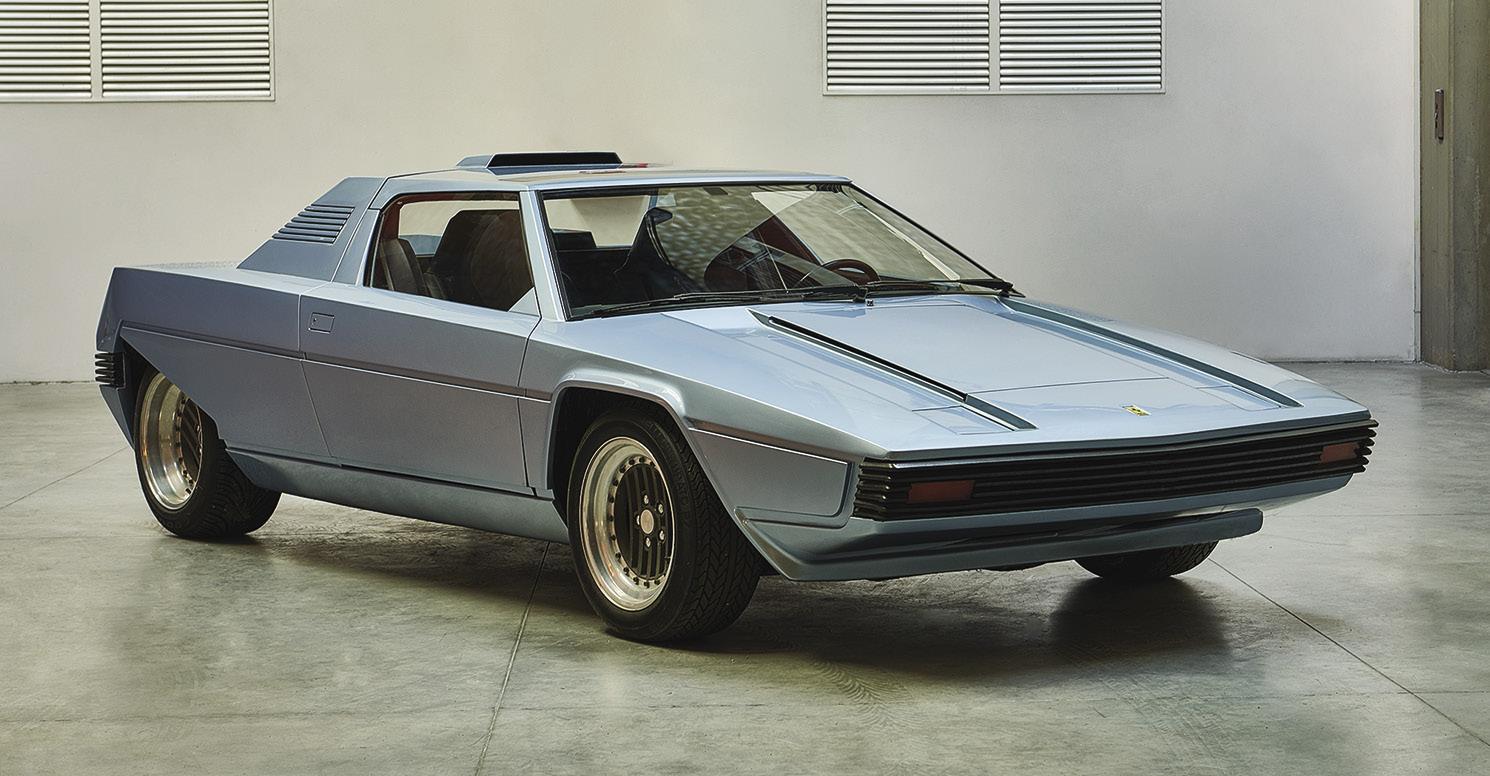
stunned would be an understatement. The metallic bronze Stratos Zero created a form that seemed carved from a block of solid metal, yet evoked movement and speed. Incredibly, the Zero was not a mere exercise in style, but a fully functional prototype.
The Lancia Stratos Zero not only represented a continuity of form between the Carabo from 1968 and the first Countach prototype that followed in 1971, but also marked the very important intermediate stage of formal research in line and profile that made the Zero, arguably, one of the most extraordinary concept cars of all time.
Several more wedge-style concept cars followed—the beautiful VW-Porsche Tapiro, the Mazda RX-500, the Vauxhall SRV, and then later cars like the Maserati Boomerang (of Giugiaro), the Paul Bracq-designed BMW Turbo, the Lamborghini Bravo and the angular Ferrari Rainbow (both from Gandini),
60 Pebble Beach Concours d’Elegance INSIDER
Gandini designed the 1976 Ferrari Rainbow.
The Countach set forth the wedge-design language that would define Lamborghini for several generations.
Opposite: The saucer-like Paolo Martin-designed 1970 Ferrari 512 S Modulo is .935 meters (36.8 inches) high and features a sliding canopy and enclosed wheels.

1974 LAMBORGHINI COUNTACH
the Japanese Dome Zero, the astounding William Townsdesigned Aston Martin Bulldog, and the sublime Honda Studio HPX by Pininfarina in 1984, amongst others—but none managed to outdo the Stratos Zero for sheer audacity.
It didn’t take long for series production cars to start wearing the wedge look too: De Tomaso unveiled the Tom Tjaarda-designed Pantera in March 1970, and Lamborghini launched the Marcello Gandini-designed Urraco in October of the same year, followed by the Countach LP500 in March 1971, which went on to spawn several generations of Lamborghini wedge-mobiles.
Tom Tjaarda once admitted to this author, that “the Pantera was an exercise in trends then for high performance sports cars, which had a narrow chiseled front end, counterbalanced by a heavy rear section, as the big and powerful engine was located behind the seats.”
In fact, if Gandini’s first proposal for the Urraco—which was essentially a toned-down, more practical version of the Alfa Carabo—had been accepted by Lamborghini’s engineering chief Paolo Stanzani, the junior league supercar from Lamborghini would have been out before the Pantera. Instead, it was the American supercar, the Vector W2/8, that was the “tribute” to the Carabo but launched several years later.
Even as a generation of wind tunnel-dictated aerodynamics took over during the 1980s, cars like the Honda City (AA), Alfa Romeo 75, and the Maserati Quattroporte IV soldiered on with the wedge look well into the 1990s,
with the Gandini-designed Cizeta-Moroder V16T as the swansong of mid-engined super wedges, not counting attempts like the Lotec C1000 from 1995 and all the Lamborghinis since the Diablo.
In the age of the Bauhaus and aerodynamic EVs, can Wedge design make a comeback?
“Well, look at the Tesla Cybertruck,” pointed out the master of the wedge, Marcello Gandini. And what did he think of it? “Automobile design needs regular disruption, and there hasn’t been one in a long time. The Cybertruck is a long-awaited disruption, and I like that.”
When receiving his honorary degree in mechanical engineering from the Politecnico di Torino, on January 12, 2024, Gandini told the students there: “Fight to never do what someone has already done, do not even repeat yourselves. Find solutions, perhaps difficult, but new. I know it's not easy. I see today's automotive companies, especially those dealing with luxury products, indulging in the temptation to make products that are always the same, infinite replicas of their own past, while the right path should be, to respect that past, never to copy it, to avoid ruining it and at the same time to show entrepreneurial and creative courage to look ahead, to support true genius, innovation, and avant-garde. I wish for an era as close as possible where change and courage are mandatory voices in the business plans of companies and in the strategy of every CEO. I am on your side.”
Pebble Beach Concours d’Elegance INSIDER 61


The Outlierman has proudly been a style partner of Pebble Beach Concours d’Elegance ® since 2016, translating the heritage of signature cars featured in each edition into timeless style.
Discover all the collections at www.theoutlierman.com Follow Us
Pebble Beach Concours d’Elegance® is a trademark and service mark of Pebble Beach Company. Used by permission.

All rights reserved. ©2024
Pebble Beach®, Pebble Beach Concours d’Elegance®, The Lodge at Pebble Beach™, Pebble Beach RetroAuto™ and their distinctive images are trademarks and service marks of Pebble Beach Company.
Pebble Beach Company.
by kate constantin
amanda stretton’s
life at speed

Introducing the Pebble Beach Concours Master of Ceremonies

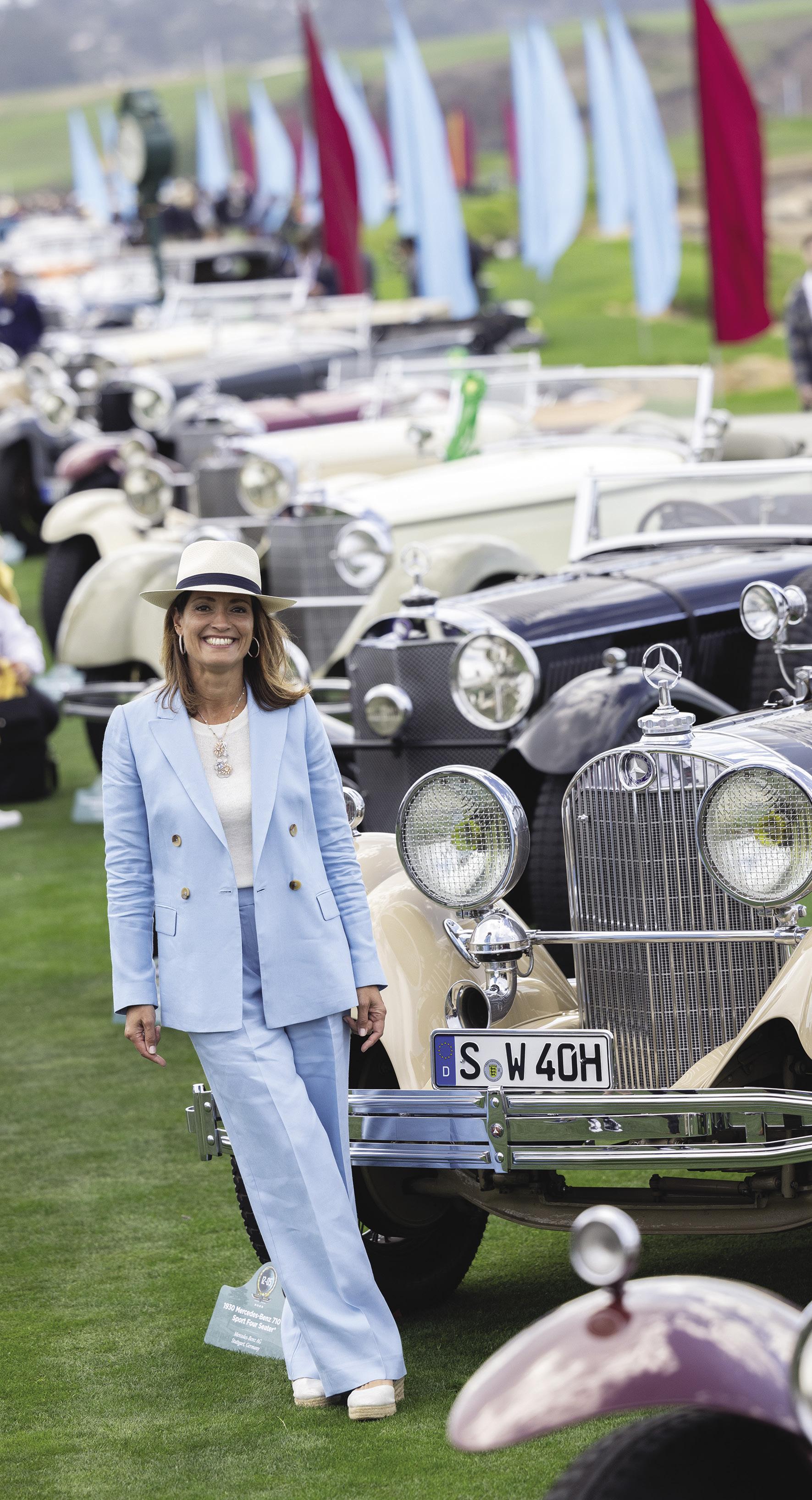
Amanda enjoys the Concours show field before going live: “I like to get a feel for the chatter and atmosphere before a live event.”
Left: Amanda at speed on a Wednesday qualifying run before the 24 Hours of Le Mans in 2008.

The date was June 4, 2008, and Amanda Stretton was sitting on the grid at Le Mans, awaiting the start of the 24-hour race, when she experienced sheer terror for the first time in her life. “I wasn’t terrified of the physical danger of crashing on track,” she says. “I was terrified of not performing at my best. Le Mans was the fulfillment of a lifelong dream for me.”
Insufficiently prepared due to technical difficulties with the car, abominable pre-race weather, and minimal practice laps, Amanda’s worst nightmare became a reality: she completed just 40 laps before the car was retired. “I was devastated,” she recalls with some nostalgia. “Le Mans was my Everest. I got there, but I have to admit it wasn’t the most illustrious of climbs.”
Amanda’s life has been a series of challenges and setbacks countered by her strong determination, grit, and a healthy dose of luck. “According to Seneca, luck is what happens when preparation meets opportunity,” says Amanda. “I’ve always tried to be ultra-prepared for whatever life throws at me, and that has led to amazing opportunity!”
Known best for her motorsports broadcasting, Amanda has interviewed many racing icons and narrated from the pit at many prestigious race events over a career that spans almost 30 years. What many people don’t know is that she is also a successful race car driver: not only did she participate in the 2008 Le Mans, but she won her class at the 1000 Kilometres of Spa-Francorchamps in 2003 and finished eighth in class at Sebring in 2004. She isn’t just a voice and face in motorsports media; she is at the heart and soul of the automotive community.
Amanda was born in London and educated at a school that placed an emphasis on sports. She first focused on tennis but “problematic knees” forced her to choose an alternative. “I didn’t know what MotoX was,” she recalls, “but when I found out it was muddy and few girls chose it, I decided that was the sport for me.” Amanda forged her parents’ signatures on the necessary forms, bought a motorbike with her term allowance, and headed for the track. “I have always been pig-headed and stubborn,” she admits with a wry smile. “The idea that I can’t do something just doesn’t make sense to me. When life throws
amanda stretton
66 Pebble Beach Concours d’Elegance INSIDER
Racing a Frazier Nash Le Mans replica in the Freddie March Memorial Trophy Race at the Goodwood Revival in 1999.
“the idea that i can’t do something just doesn’t make sense to me. when life throws an obstacle in your path, you have to find a way to go around or over it.” – Amanda Stretton
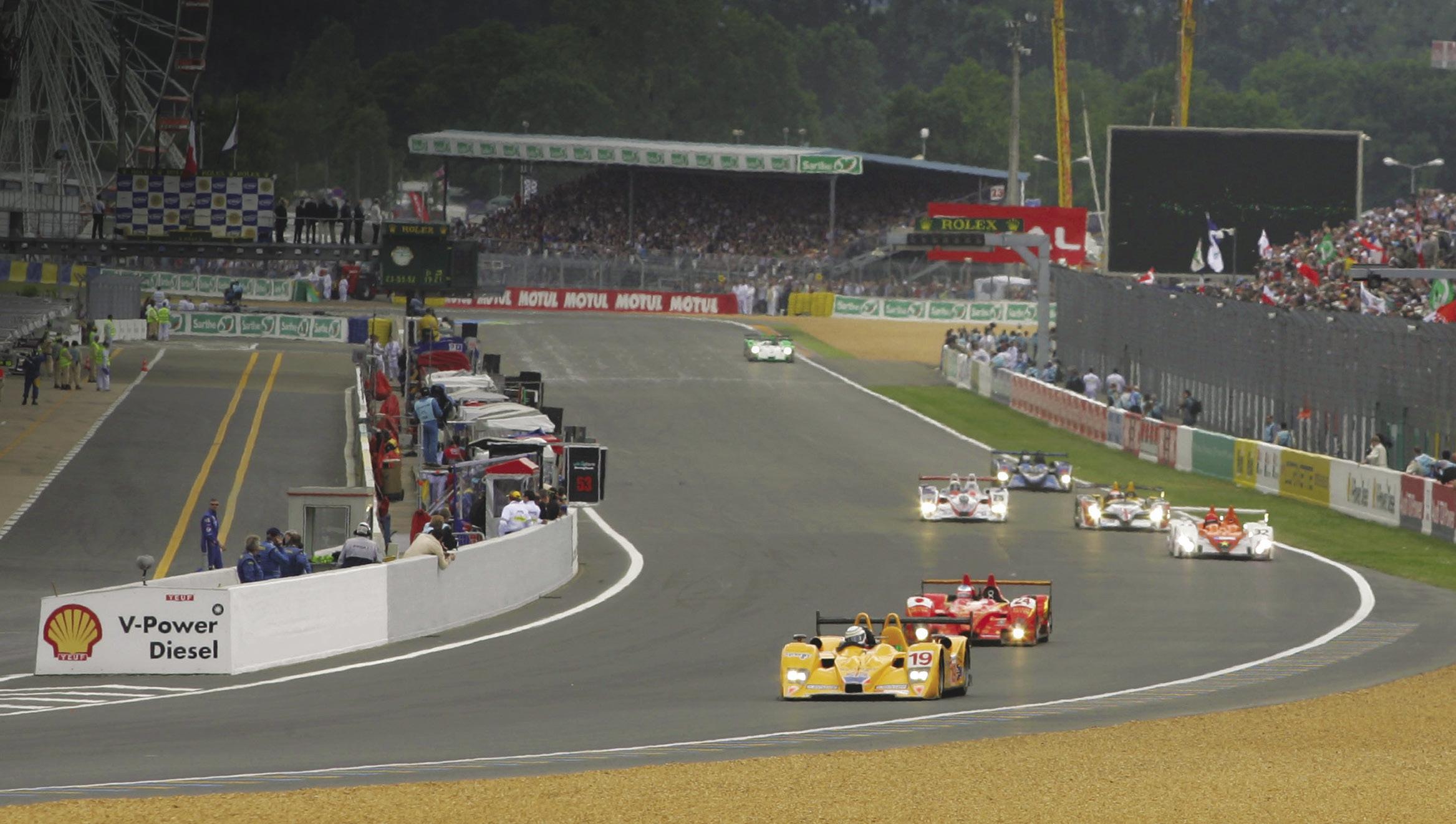

“Me
an obstacle in your path, you have to find a way to go around or over it.”
When she was caught smoking and her mother was summoned to the Headmaster’s office, Amanda’s newfound sport was discovered—and strictly forbidden: “Mum didn’t want her daughter to be a ‘grease monkey’ like my dad, so my bike was sold and that was that.”
Amanda’s father, Terry Cohn, was a fur trader who loved cars and eventually became a partner in a significant London dealership that dealt largely in Rolls-Royce Silver Ghosts. He was also deeply ensconced in the historic motor racing community, often attending events accompanied by his renegade daughter, who knew by then that auto racing
“Daddy
 The Lola driven by Amanda, Bob Berridge, and Gareth Evans heads into a turn amidst the 24 Hours of Le Mans in 2008.
liked the fact that I had small hands—and was willing to get them dirty!”
with Daddy. I would love for him to see me now—hosting the Pebble Beach Concours.”
The Lola driven by Amanda, Bob Berridge, and Gareth Evans heads into a turn amidst the 24 Hours of Le Mans in 2008.
liked the fact that I had small hands—and was willing to get them dirty!”
with Daddy. I would love for him to see me now—hosting the Pebble Beach Concours.”
INSIDER 67
Pebble Beach Concours d’Elegance
amanda stretton

was in her future. “I loved racing the bike, but it hurt to fall,” she says. “Car racing was the obvious next step. My interest in road cars came from racing, not the other way around.”
Amanda’s formative driving experience was in her dad’s Alfa 8C Spider on the hilly streets of Guildford, in southern England. “He took me out in traffic jams and taught me those tricky hill-starts in his Alfa,” she recalls with a smile, “I will always be eternally grateful for his support.”
It was Cohn who first mentioned the Pebble Beach Concours to Amanda. Although she didn’t attend the event with him, he entered five cars here in the 1990s, placing second in class with a 1930 Bentley Speed Six H. J. Mulliner Drophead Coupé and third with a 1907 Rolls-Royce Silver Ghost Rothschild Roi des Belges.
At the tender age of 17, while at a car auction, Amanda met Martin Stretton, an accomplished racer on the historic circuit, who offered to teach her how to race. “We met at the Nürburgring for an Oldtimer race soon afterward,” she explains, “Martin opened the doors to racing for me. Long story short: we got married when I was 20, divorced when I was 22, and remain good friends to this day.”
Racing her Widi at the Boys Silverstone Classic: “I was in the smallest, cheapest car on the grid, surrounded by Ferraris, Maseratis, and Jaguars, but I loved every minute of it.”
Right: “My first podium! I had been racing Daddy’s 1936 Lagonda LG45 and could barely see over the wheel.”
While studying Architecture and Art History at Manchester University, and working at Christie’s Auction House, Amanda took to the track every chance she got. In the early days she raced an eclectic array of classics, including an Alfa Romeo 8C Monza, a Jaguar XK120 and a 1929 Fraser Nash Supersport, at venues such as Silverstone, the Goodwood Revival, Festival of Speed and VSCC events. “I was dashing about and having the time of my life,” Amanda enthuses, “and I was doing all right. I received some Newcomer awards and people started to notice me.”
An unexpected inheritance from her grandmother enabled Amanda to acquire her own race car in 1993—a Widi sports-racer, based on a Lotus 11 with a Climax engine and a simple tubular chassis, purchased from Stirling Moss. “By then Stirling was moving onto other pursuits,” says Amanda, “but he loved that I bought his car.”
Racing is, of course, an expensive sport, and Amanda was “feeling the pinch” when TV producer and commentator Richard Hay asked her to screentest for a female presenter’s role on a show about Formula 3 racing to air on the UK’s Channel 4. “There was a significant dearth of female racers at the time, so I was an obvious choice,” says Amanda.
68 Pebble Beach Concours d’Elegance INSIDER

Her first interview was Jenson Button, the fast-tracked new F3 driver: “The pair of us stood on the pit wall, each as petrified as the other. Total deer in the headlights!” Despite her trepidation, Amanda was a natural at broadcasting.
“I’m your typical Myers-Briggs ‘Consul’ personality type,” she chuckles. “Eager to please, chatty, and empathetic. Throw some solid ‘imposter syndrome’ in there and you have a clear idea of who I am!”
Amanda went on to present the GT Championships and was hired by Eurosport, ITV, Channel 5, Sky, and the BBC in Europe, and Fox and Speed in the United States. Consequently, her presence on screen boosted her racing career, as the TV producers often found seats for their star.
Amanda soon met husband number two—Bob Berridge, who was racing a stable of vintage F1 cars. With his support and her media success, she was soon back on track, running in an all-female lineup for the Fiesta Championship at Silverstone. Then, just as she was about to enter her first season of ASCAR, in 2002, she fell pregnant with her daughter Mia, and her racing career made a pitstop. “I came to realize quite quickly, that you can’t do everything at once,” she laments.

I’m
Keen to get back into the hot seat as soon as possible, Amanda signed up for the British GT Championship in 2003, driving a Viper as part of another all-female team dubbed “Girlpower Racing.” She acquitted herself well, recording the fastest lap in her class several times, but funding for the team eventually ran out. “We did okay, but we were too early,” reflects Amanda. “Now everyone thinks it’s cute to have the Iron Dames all-girl race team, and I am ultra-supportive. I love it too! But back then, promotors said, ‘Women don’t want to watch women race, and men think it’s a waste of time. So, what’s the point?’”
Amidst broadcasting stints at Le Mans and elsewhere, Amanda introduced her husband to the world of contemporary racing—and he became a convert. As a result, the racing couple often found themselves competing against one another, as was the case at the 1000 kms Spa-Francorchamps in September 2003. Amanda drove a Porsche 996 GT3, and Bob was in a similar car. Bob had pulled ahead and was beating Amanda’s lap times when his car suffered a mechanical issue that slowed him significantly. As Amanda gained on her husband, her team relayed a message from him saying, “Do not overtake!” “I responded with something you can’t print!” says Amanda. “I was furious! I told the team to tell Bob, ‘It’s a race!
Pebble Beach Concours d’Elegance INSIDER 69
“Here
giving fellow British racer and TV presenter Tiff Needell some advice!”

Interviewing Canadian driver
Stefan Rzadzinski at the Circuit des Invalides in Paris in 2019: “Making history! I was the lead presenter for the Jaguar I-Pace eTrophy series, the first official series for the Formula E Championship.”
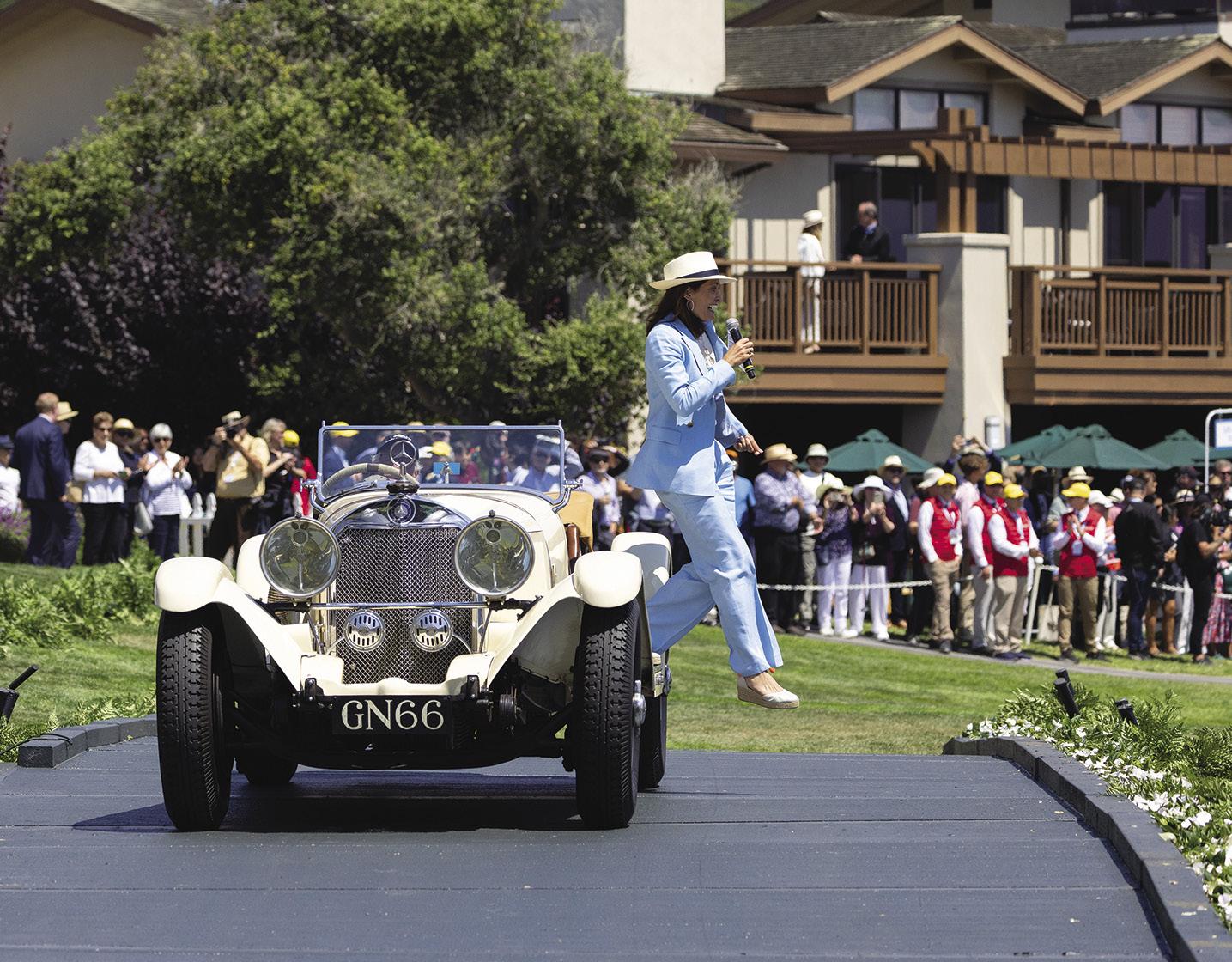
Of course I am going to overtake.’ And so I did. It was a bit awkward afterward in the pits.” Awkwardness aside, Amanda came in 15th overall and won the class—and to this day, she remains the only British female racing driver to have won an international long-distance GT race.
When the opportunity arose to buy a series of TVR Tuscan GT cars from the factory, the racing couple were finally equipped to run their own team of two cars and six drivers—and they were pitted against one another again in March 2004, at the 12 Hours of Sebring. “It was brutal!”
Amanda recalls, “Hot as hell and horrendously bumpy!”
Bob’s TVR Tuscan T400R failed midrace. Meanwhile, Amanda suffered an unexpected hurdle: “I was going round nicely when the steering wheel came off in my hands! It must have bumped off on the quick release. They came on the radio and asked, ‘Have you spun?’ and I said, ‘No. Just trying to put the [*#@!] steering wheel back on!’”
Despite this, Amanda finished 8th in her class of 30.
Her racing career was back on track, but the birth of a second child soon forced her to the sidelines again. “You can’t be a fulltime parent and a fulltime racer/presenter simultaneously,” she says. “I tried. I would get out of the car on track and the team would want a debrief, but I would say, ‘Sorry chaps, I have to call and make sure the kids were picked up and have their swim bags.’”
It was almost four years before Amanda was able to step back into the fray, which she did in 2008 by entering the 24 Hours of Le Mans. “I never thought in a million years I would ever get a shot at Le Mans,” she says, “but serendipity stepped in, and I was up for it!”
During Amanda’s hiatus from racing, husband Bob Berridge had progressed through GT with an LMP2 (Le Mans Prototype 2) car. Then, suddenly, he had the opportunity to buy an LMP1, more specifically Lola-AER B06-10. Bob and Gareth Evans registered the Le Mans entry, but when a third teammate failed to join them, Amanda stepped in as the third driver for the team. “This wasn’t a willy-nilly decision, and I didn’t just get the entry automatically,” she notes. “I had to prove myself capable and qualify.” While juggling school schedules and TV commitments, Amanda went to the Snetterton Circuit and completed several three-hour stints in the Lola, during which she had to lap, time after time, within a half-second of the stipulated lap window, as calculated by the team to be the most efficient time for the longevity of the car. “Le Mans isn’t just about going hard and fast; you have to be consistent,” Amanda explains. “You have to look after your car and save its components. That is key in an endurance race like Le Mans.”
Two weeks prior to the race, Amanda went to Le Mans for her pre-qualifying tests. “It rained biblically,” she says. “At the Porsche Curves they had mown the grass trackside, and with the rain, the cuttings flooded across the tarmac. You couldn’t see where the grass ended and the track started. I just tootled around following the lights of the car ahead of me for the required 10 laps. I didn’t learn the track or get in a fast lap.” Further practice was precluded when the Lola was relegated to the pits with faulty piston liners necessitating an engine change.
Race Day arrive. “It was absolutely dreadful! A complete and utter pit show!” Amanda recalls, referring to the fact
amanda stretton
“Walking on air! Making my entrance at the Pebble Beach Concours.”
70 Pebble Beach Concours d’Elegance INSIDER
that the Lola spent more time in the pits than on track. Amanda had completed zero fast laps and just three nighttime laps when she got in the car on race day. Then, when she stopped to refuel as dusk turned to dark, the crew forgot to remove the dark reflector on her visor. “I couldn’t see a thing! I had to do my stint with my visor open, and my eyes were streaming.” At 2 am on the Sunday morning, when the second engine suffered the same failure as the first, the team retired the car. Amanda had completed just 40 laps. “It was crushing!” says Amanda. “Le Mans was my dream, and it was over so fast. All my expectations and hopes were dashed—and on top of that, I did not drive well. That was the hardest thing to accept. It was the lowest point of my racing career, and I decided I was going to retire from modern racing. . . . I thought I had hung up my racing gloves for good, but then my friend Peter James [a celebrated British crime writer] offered me a drive. And of course, I said ‘Hell yes!’”
Amanda has since participated in several classic sportscar racing events. “I’m 50 years old and in it for the joy of it now,” she says. “I love to race nice venues with nice people in nice cars. Then I want to go for dinner with good friends, share a bottle of wine, and go home. I still love presenting events that are associated with motor racing—it keeps me in the slipstream. Media plus amateur racing is the perfect marriage. Believe me, I should know!”
When Amanda met Sandra Button, Chairman of the Pebble Beach Concours, at the Historic Motoring Awards in 2022, the two hit it off. After meeting again at Retromobile in 2023, in the wake of Derek Hill’s decision to step away from the role, Sandra offered Amanda the position of Pebble Beach Master of Ceremonies.
Amanda first attended the event in 2014: “I was blown away then and I am blown away now! To be offered the position of emcee at the Pebble Beach Concours d’Elegance is the opportunity of a lifetime! The Pebble Beach Concours is the most prestigious classic car event on the globe, and it is not to be trifled with.”
Although it is impossible to prepare for everything that might happen at a live event, Amanda did all that she could. She studied the list of car entrants and entries, practicing the pronunciation of names, marques, and models. She reviewed the script, with its cues for everyone involved in the awards presentation. She attended the Tour d’Elegance on Thursday morning to better familiarize herself with the cars, greeted them at the Dawn Patrol on Concours Sunday, and walked the field several times before the awards ceremony began.

“Celebrating the end of the show.”
“A live event will always throw up challenges,” she says. “The order of events may change, cars fail to appear when they should, and timing may be off due to late ballots. It is important you don’t just blissfully waffle on about a car that isn’t on the ramp. You observe as much as possible and read the event with your acquired knowledge. Then you run on sheer adrenaline!”
Shortly after 1:30 pm on August 20, 2023, Amanda stepped to the microphone for the Awards Ceremony of the 72nd Pebble Beach Concours—and all went well.
“I hope that I can offer a unique narrative and demonstrate that, for all the tradition and prestige, this world of classic automobiles is not intimidating. It is absolutely fascinating. This is a labor of love, another Everest for me— and, like my racing, would not be possible without a brilliant support team.”
Pebble Beach Concours d’Elegance INSIDER 71


1952 Ferrari 340 Mexico Vignale coupe One of three built | Motion Products restored Copley Motorcars 37 Chestnut Street Needham, Massachusetts 02492 USA Tel. 781.444.4646 e-mail copleycars@gmail.com www.copleymotorcars.com

DIAMOND IN THE RUF
BY KATE CONSTANTIN
INSIDER 73
Pebble Beach Concours d’Elegance
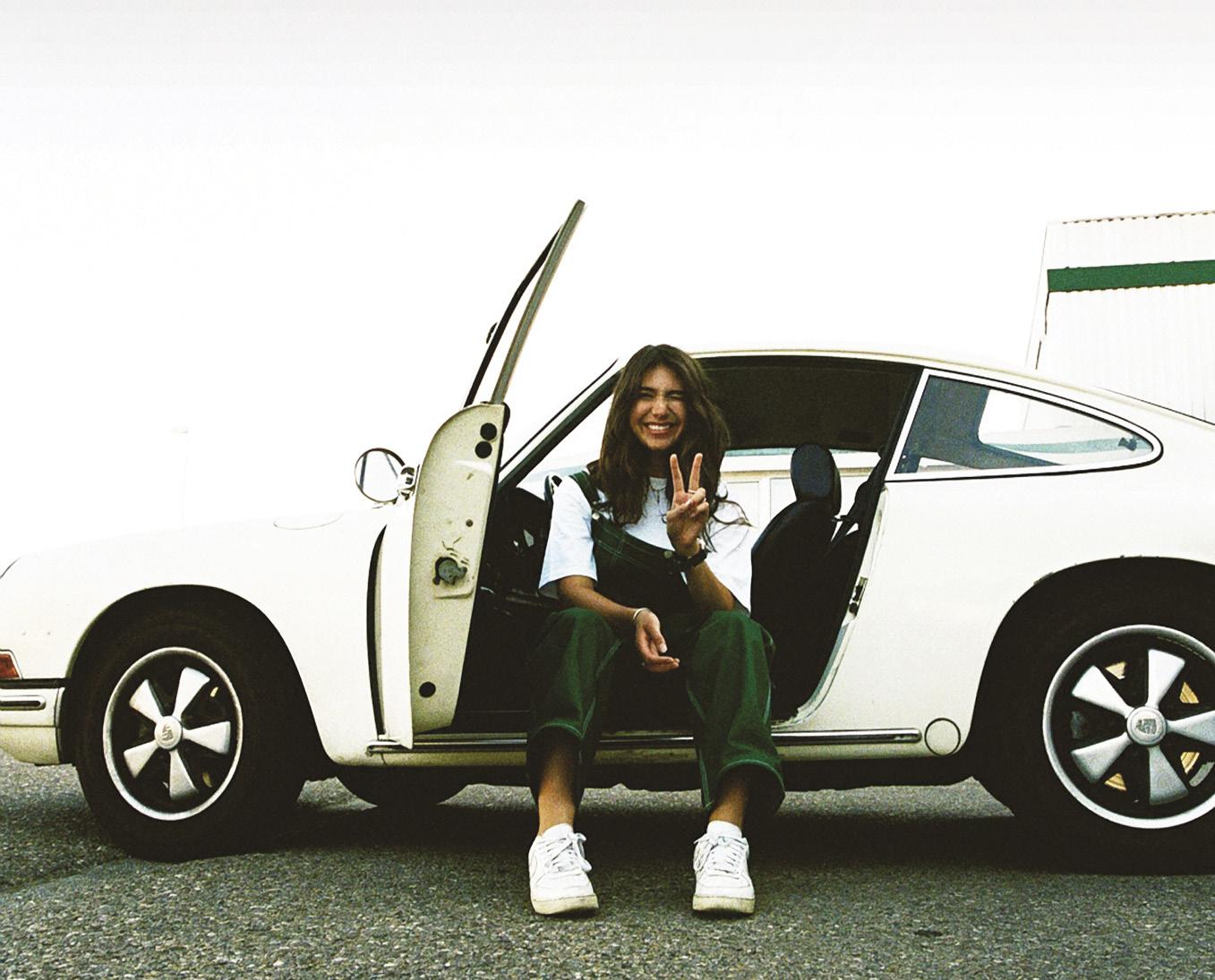
Aloisa Ruf is 22 years old, but she already knows more about Porsches than most Porsche aficionados three times her age. As the daughter of Estonia and Alois Ruf, she was raised in the domain of RUF Automobile, a Bavarian-based company founded by her grandfather in 1939, specializing in high performance and ultra-stylized Porsches.
“I was always fascinated by the projects in the family workshop,” she says. “I would run around as a child with a wrench in my hand! I learned at an early age how to change a tire and switch out the spark plugs.”
At 17, Aloisa began the restoration of a white 1968 Porsche 912 that her father had gifted her. Once completed, she named the Porsche “Bertha” after Bertha Benz, the first woman to drive an automobile. “That car is very special to me,” she says. “I started driving at 5 years old on my dad’s lap in a Porsche 901; I would steer and change gear long before I could reach the pedals. That’s when he taught me
how a gearbox works. So, to restore and drive a 912 was a natural progression for me. I love that car.”
Aloisa’s passion for everything automotive was officially rewarded in 2022 with the title of Officer of Creative and Public Relations at RUF—while still studying Branding, Communications, and Design at the AMD Akademie Mode & Design. In this role, she serves as a liaison with clients, creating specs, ordering parts, overseeing fashion branding and marketing, and developing social media content. “When a customer reaches out, we sit down and discuss what he or she has in mind and what the possibilities are. Sometimes customers don’t know what they want, so we look over combinations of over 800,000 colors and options. We talk brakes, suspension, performance parameters, seatbelts, and accessories. We bring our love of art and aesthetics to the table and combine it with engineering. It’s a delicate and fun dance with the client. I am also very interested to learn the
74 Pebble Beach Concours d’Elegance INSIDER
Aloisa grins from the 1968 Porsche 912 that she restored.
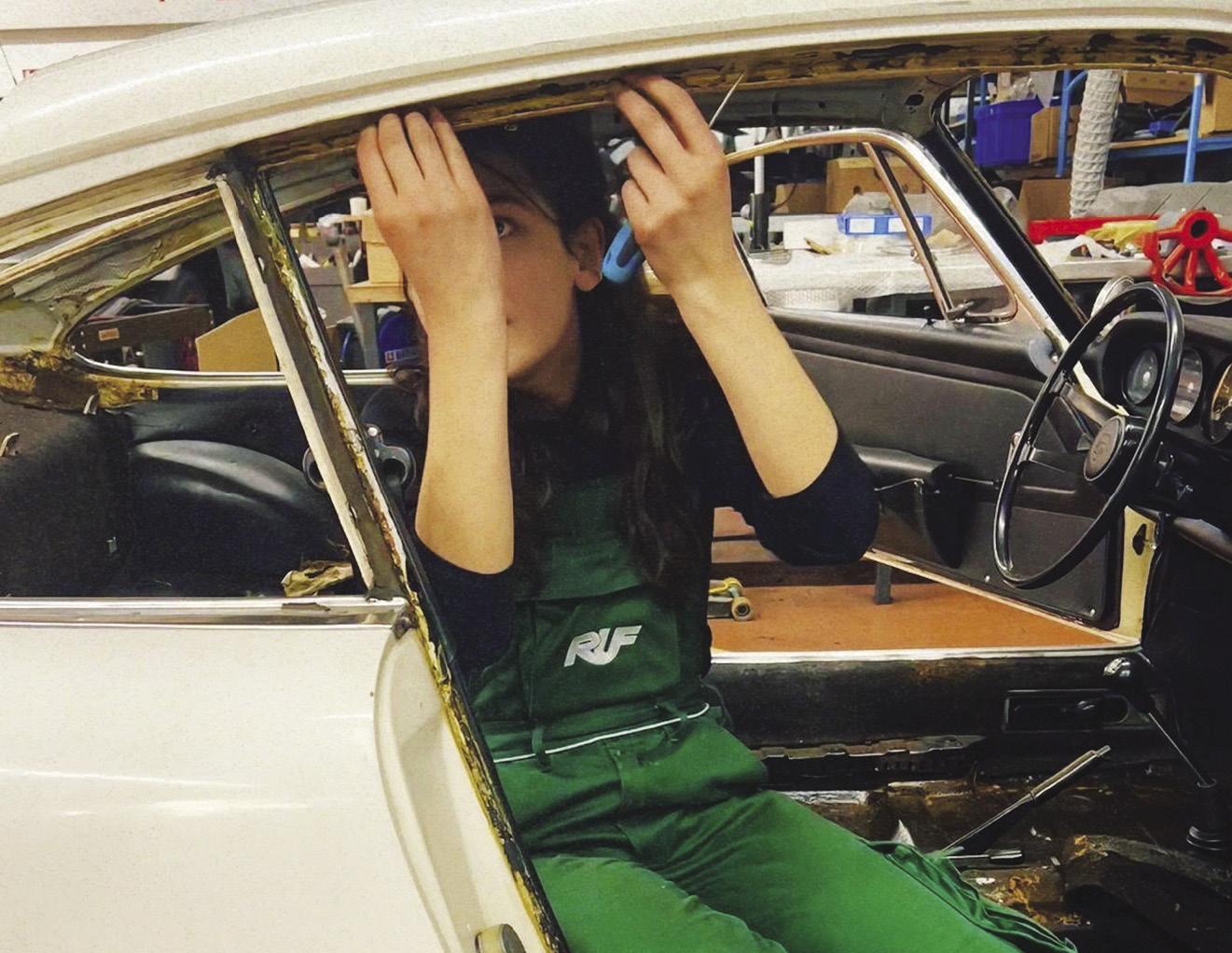
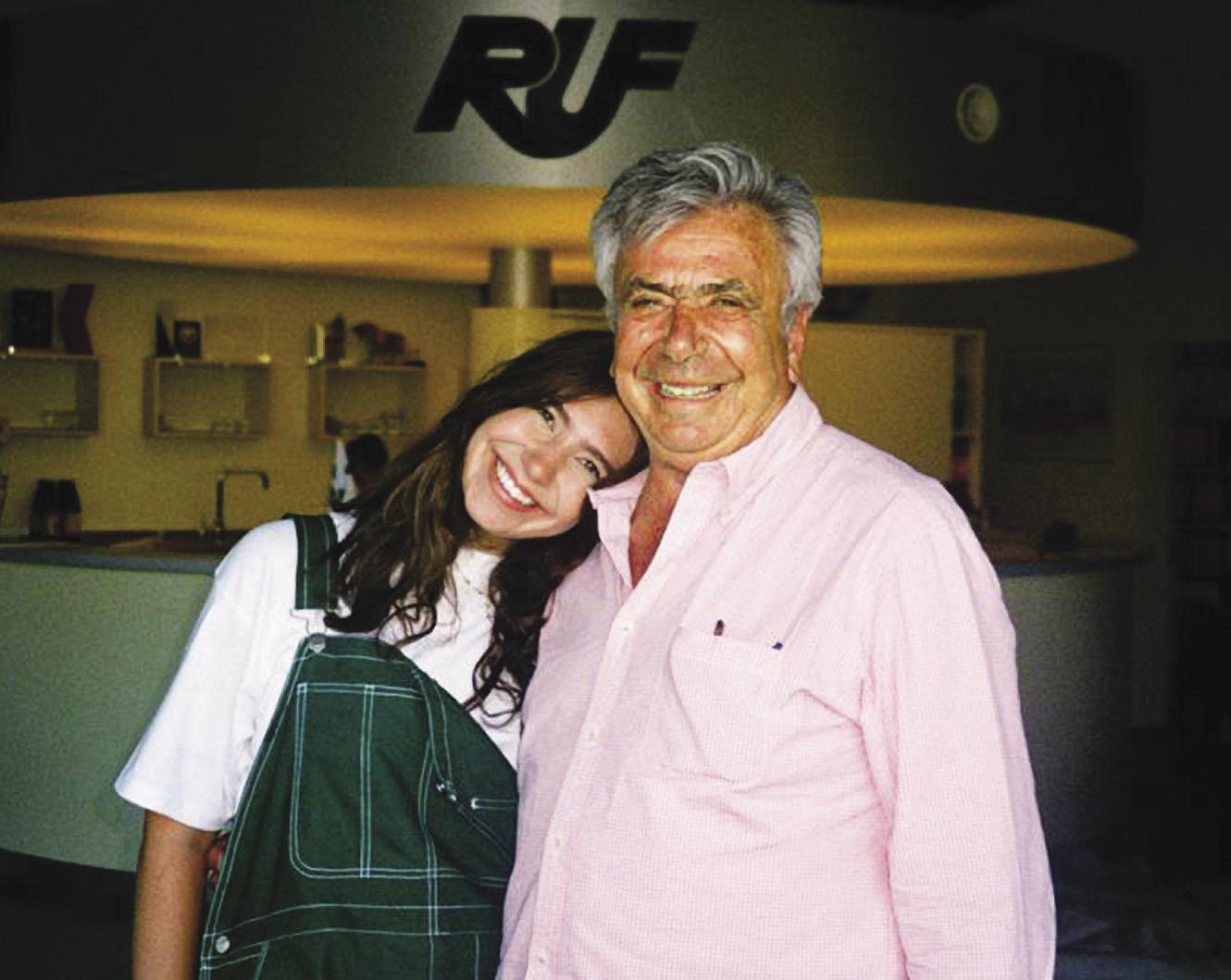
technical and R&D [research and development] aspects of projects. I understand mechanics and I get involved in the development and the test-driving of our cars, too.”
In an effort to broaden her horizons and as part of her university studies, Aloisa took a six-month internship in 2023, at the Petersen Automotive Museum in Los Angeles. “It was incredibly enriching,” she says. “It provided an alternative perspective of all aspects of the industry: hot rods, low-riders, all kinds of vehicles from the American car collection. I gained great experience to take back to the family business.”
Left and below: Aloisa at work restoring the 912.
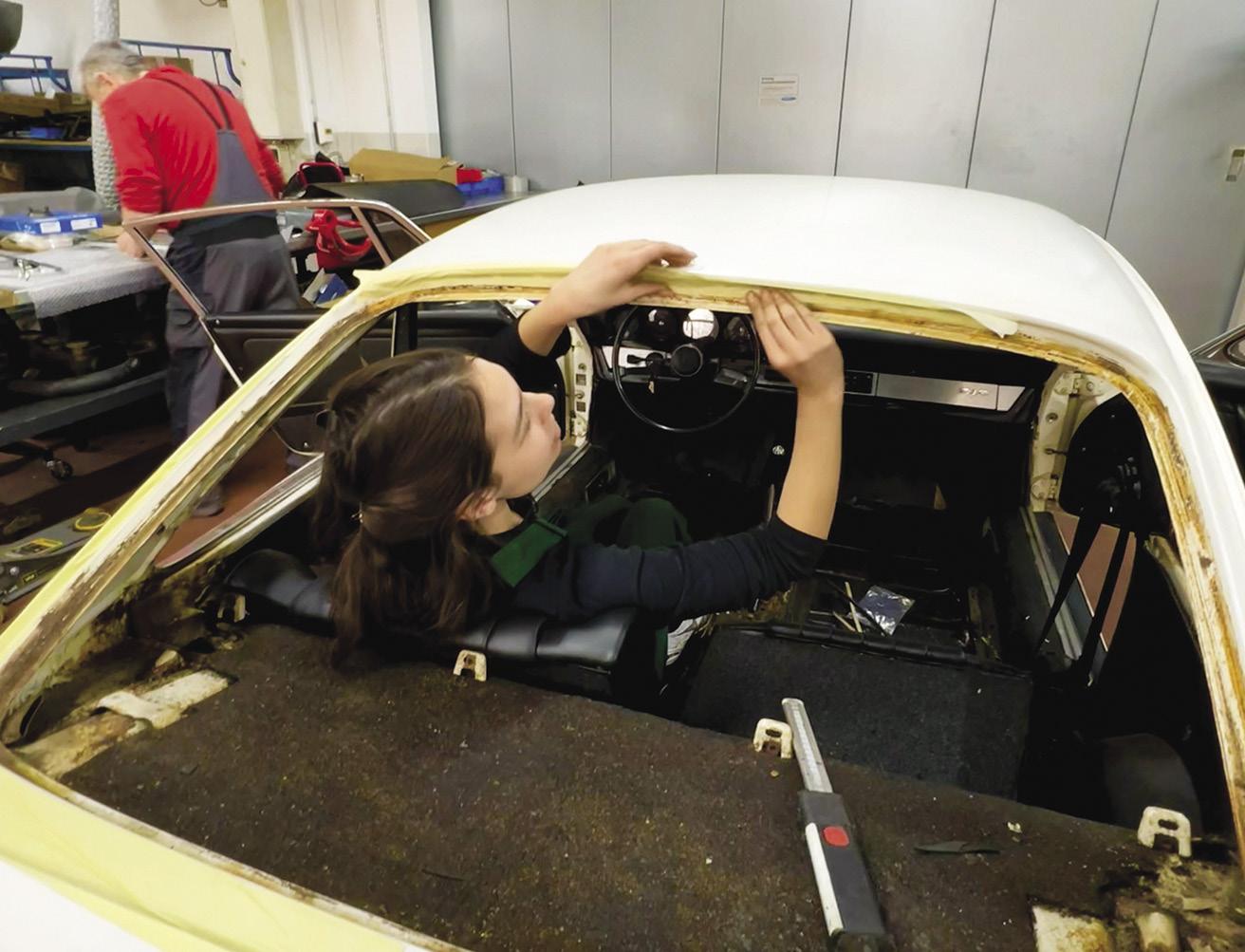
“WE NEED TO RETAIN THE CHARM OF A FAMILY BUSINESS, MAINTAIN QUALITY, AND STILL BE COOL AND ATTRACTIVE TO A YOUNGER AUDIENCE. AND ALWAYS LOOK AHEAD, BECAUSE AFTER ALL, THAT’S WHERE THE FUTURE LIES.”
– Aloisa Ruf
Despite her depth of knowledge, experience, academics, and passion, when asked if she faces challenges being a woman in a traditionally male-dominated environment, Aloisa is candid: “Occasionally, yes. Although it is hard to distinguish whether people are discriminating because of my gender or my age. Sometimes someone will ask, ‘Whose girlfriend are you?’ But usually if you come to the table with honesty and integrity, people recognize that you are authentic. I try to be humble.”
Certainly, neither her age nor her gender have stymied her role in some of the company’s most prestigious projects. In 2022, Aloisa helped launch the RUF Bergmeister, a
Pebble Beach Concours d’Elegance INSIDER 75
Aloisa with her father, Alois Ruf, inside the family-run firm founded by her grandfather in 1939.
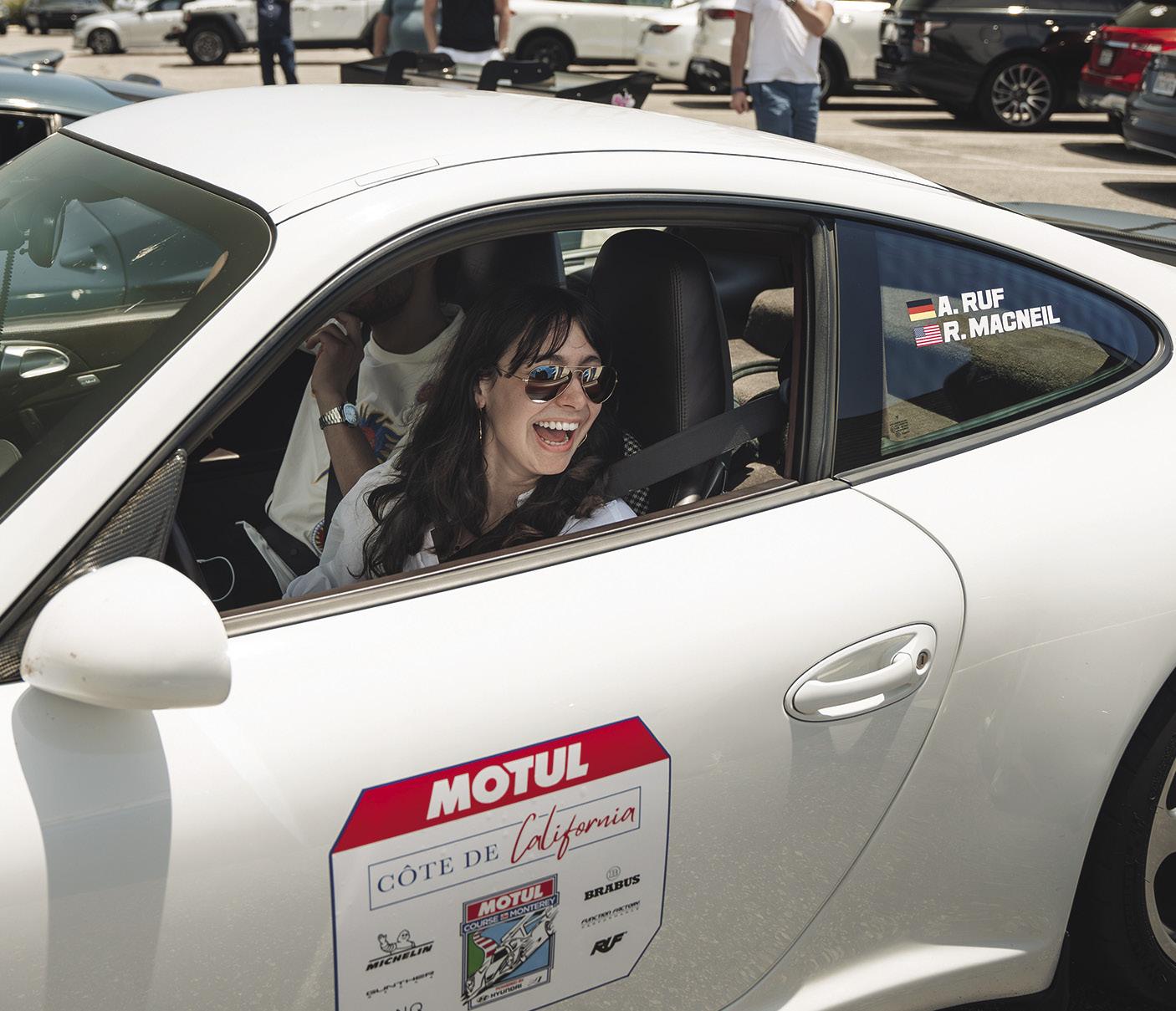
Above: Aloisa participated in Motul’s inaugural Côte de California Rally, driving from Los Angeles to Monterey in May 2023.
Top Right: The Rufs (father Alois driving, Aloisa riding shotgun, with mother Estonia and sister Nathalie in back) cross the awards ramp at the 2023 Pebble Beach Concours with their 1963 Porsche 901 Prototype “Quickblau” Karmann/ Reutter Coupe, which placed First in Class.
Right: The Rufs share the book that documents Quickblau as the oldest 911 in the world.
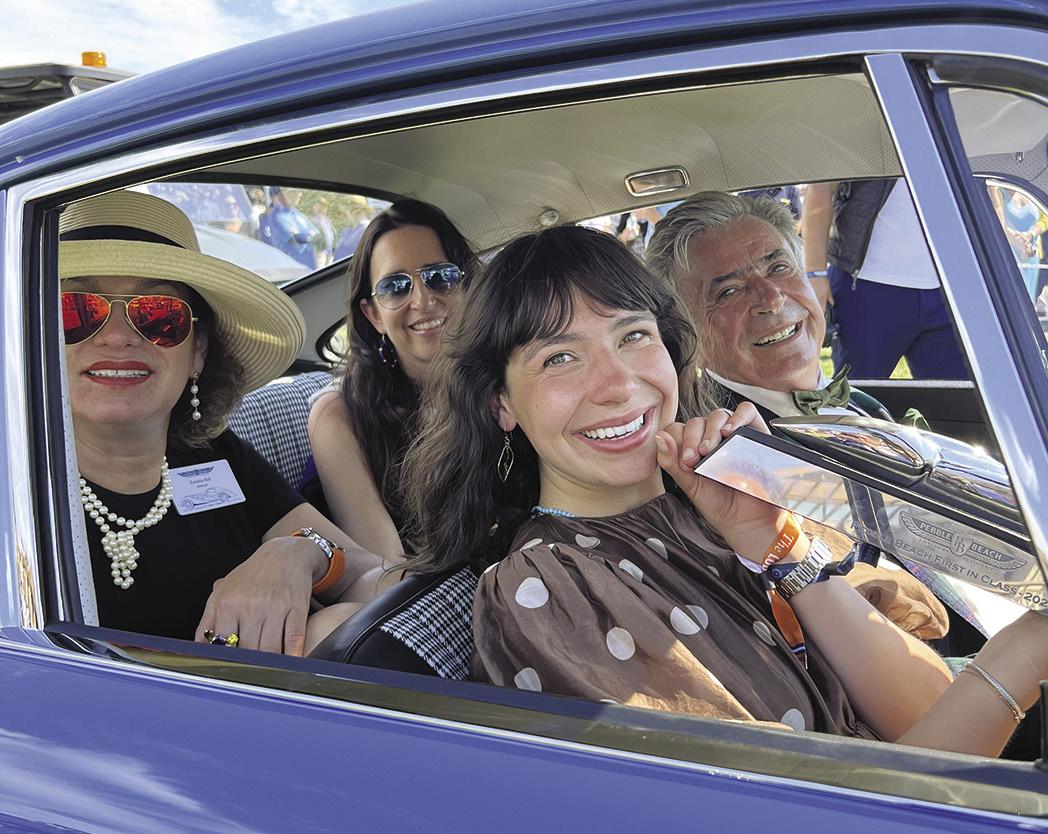

tribute to the ultra-rare Porsche 909 Bergspyder, crafted from a 993 cabriolet body-shell. Then in 2023, she was instrumental in the creation of the RUF R Spyder, a classic speedster with the underpinnings of a 911 GTB, dressed in silver with neon yellow accents. “The car is stunning,” she enthuses. “Our strength is in creating niche one-off projects that push us to our limits.”
In 2008, one of RUF’s niche one-off projects was an electric vehicle (EV) based on a Porsche 911. “EVs are important and here to stay,” she says. “Unfortunately, the politicization of the EV is hurting the nascent industry. Until there is an infrastructure in place, we cannot simply switch from combustion to electric overnight. There has
to be much more development in solar, wind, and hydro power to support the industry. The combustion engine has been around for 130 years and is not about to disappear. Besides, it tickles us and brings us joy!”
Something else that brings obvious joy to this 22-year-old is her relationship with her family and the evolution of the family business. “I think it is important that we do not grow too fast or become too big. (The company currently has around 90 employees). Our strength is in the RUF team and our personal relationship with the client. We need to retain the charm of a family business, maintain quality, and still be cool and attractive to a younger audience. And always look ahead, because after all, that’s where the future lies.”
76 Pebble Beach Concours d’Elegance INSIDER

“The World’s Most Prestigious Car Show.” — FINANCIAL TIMES ©2024 Pebble Beach Company. Pebble Beach® Pebble Beach Concours d’Elegance®, and their underlying images are trademarks, trade dress and service marks of Pebble Beach Company. AUGUST ADVANCE TICKETS AVAILABLE AT pebblebeachconcours.net PEBBLE BEACH
THE OBEROI CONCOURS d’ELEGANCE IN INDIA
Celebrating Generations of Automotive Style
BY CHRIS BOCK
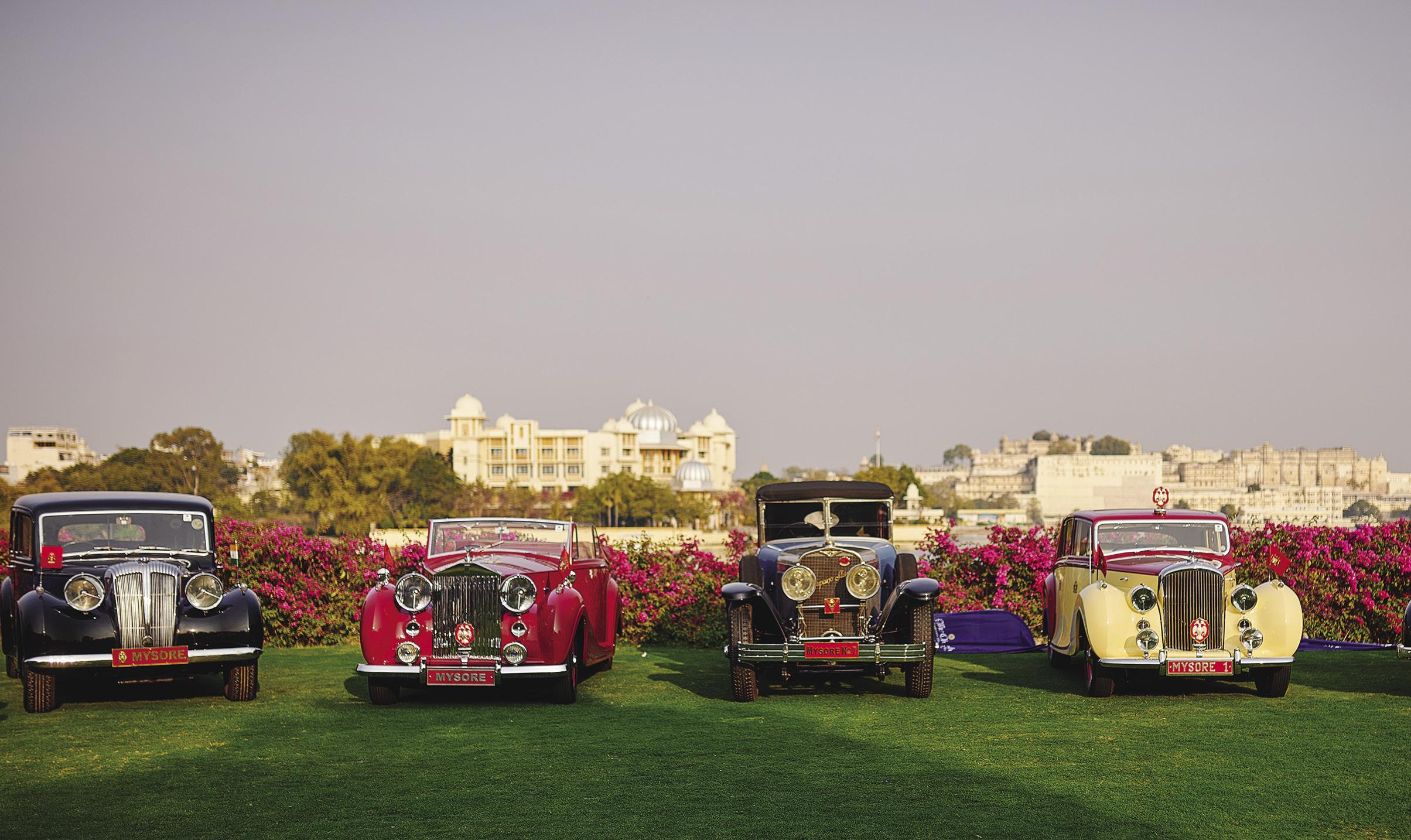
A shared love of cars transcends both time and distance no matter how far you travel.
I was honored to be included in the panel of Judges for the inaugural Oberoi Concours d’Elegance, held at the amazing Oberoi Udaivilãs in Udaipur, India, in midFebruary. The decision to participate was easy as Sandra Button was to be the Chief Judge and Manvendra Singh Barwani was the Curator of the concours. Manvendra is a longtime friend of the Pebble Beach Concours d’Elegance, having been instrumental in bringing many great Indian entries to the show—one of many reasons we presented him with the prestigious Lorin Tryon Award in 2018. He has also been an Honorary Judge at Pebble Beach for many years.
Travel time found Sandra and Martin Button and me leaving Florida after the conclusion of our Selection Committee meetings and flying to Delhi via Doha, Qatar. Landing in Delhi in the middle of the night we were met by representatives from the Oberoi Hotel there, beginning what was to be the most gracious and completely welcoming treatment by Oberoi staff throughout our visit. The Oberoi Concours is the brainchild of Arjun Oberoi,
Executive Chairman of EIH, parent company of The Oberoi Group, operators of India’s finest hotels.
After a night to catch up on sleep, we flew to Udaipur with Arjun and his wife, Mila, giving us a wonderful chance to get acquainted. Next we took a thrill-packed ride (Indian traffic is unique!) through Udaipur to reach the launch that was to take us across Lake Pichola to the incredible 50-acre Oberoi Udaivilãs, the site of the upcoming Concours. Soon to join us were Steve and Kimmy Brauer, with Steve sharing his knowledge as Chief Honorary Judge at Pebble Beach. Also there was Pebble Beach regular Chip Connor.
The Concours was a three-day affair. Entrants and judges first gathered together on a Friday, the approximately 100 cars and motorcycles were judged on Saturday, and Sunday was filled with related events and the awards presentation.
We judges worked in two-man teams, and I was fortunate to be paired with Nigel Matthews, a familiar face from many years of Pebble Beach judging. We were very soon to learn that the judging process required more time than is common, as the owners and restorers of the cars were so proud of their vehicles that they wanted to share both the full histories and intimate details of their cars. Most
Musings from Our Chief Judge CHRIS BOCK
78 Pebble Beach Concours d’Elegance INSIDER
The Cars of the Maharajahs class focused on cars once owned by the Maharajah of Mysore: a Daimler DE27, a Rolls-Royce Silver Wraith, a Hispano-Suiza H6B, and a Bentley Mark VI.
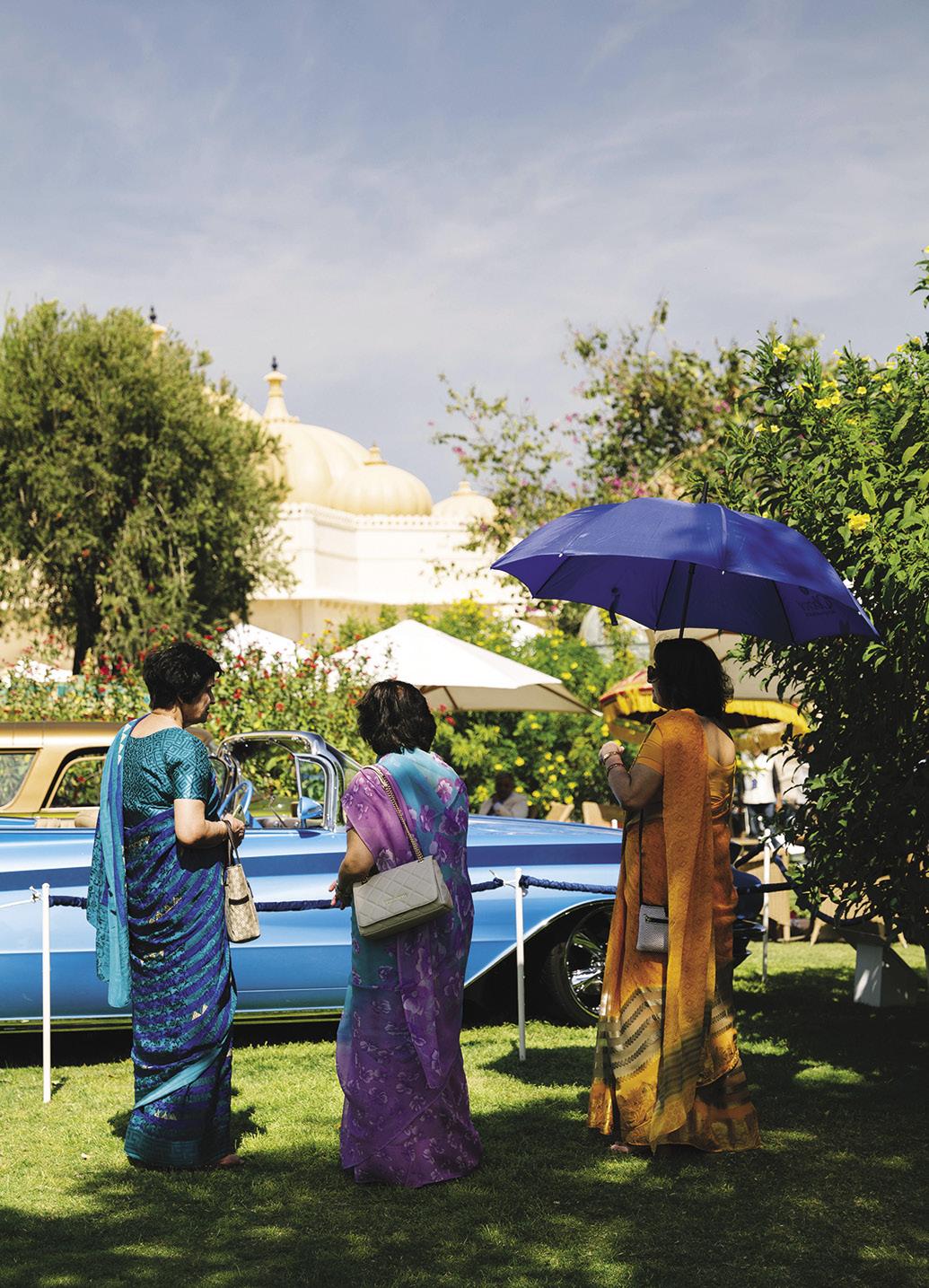

of the vehicles had lengthy Indian histories, and many still belong to the original owner’s families. One entry in our group was being passed from the fourth to the fifth generation of a family, and they had a scrapbook with every document pertaining to the car—from its delivery invoice in 1937 to the present, including not only the complete maintenance history of the car but numerous photos of the five generations of family members who had enjoyed it. Its presence at the concours was as much a matter of celebration as competition.
Equally proud and engaged with the entries were the local Indian restorers who were anxious to share their work. In some cases, the vehicles had been preserved through the years, while in others the cars had fallen prey to the Indian climate and required massive efforts to return them to their original grandeur. I was really impressed with the quality of the Indian restorations, their attention to detail, and their insistence on originality.
An interesting array of classes were present, including PreWar European Classics, Cadillacs from the Dawn of the Jet Age, Prewar Rolls-Royce Limousines, Italian Classics, and Indian Cars of the Masses, as well as a variety of motorcycle groups. Nigel and I judged the Italian
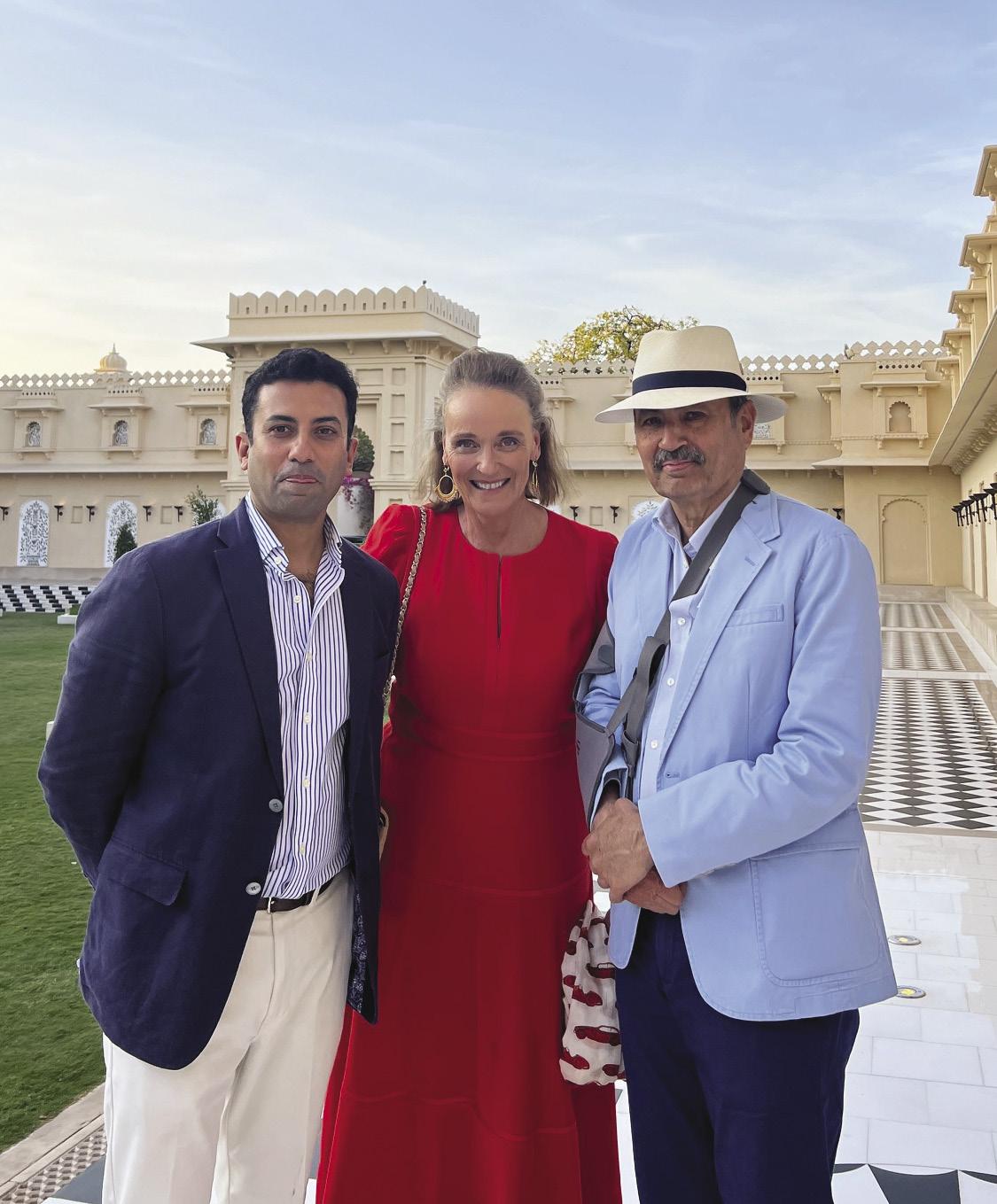 Sandra Button with Oberoi Concours organizers Siddraj Singh and HH Manvendra Singh Barwani. Button served as Chief Judge.
Bedecked in beautiful saris, ladies from some of India’s royal houses peruse a custom Buick Electra.
Sandra Button with Oberoi Concours organizers Siddraj Singh and HH Manvendra Singh Barwani. Button served as Chief Judge.
Bedecked in beautiful saris, ladies from some of India’s royal houses peruse a custom Buick Electra.
Pebble Beach Concours d’Elegance INSIDER 79
A 1929 Mercedes-Benz 630 K and a 1933 Fiat Balila Spider overlook serene Lake Pichola.
from Our Chief Judge
Musings
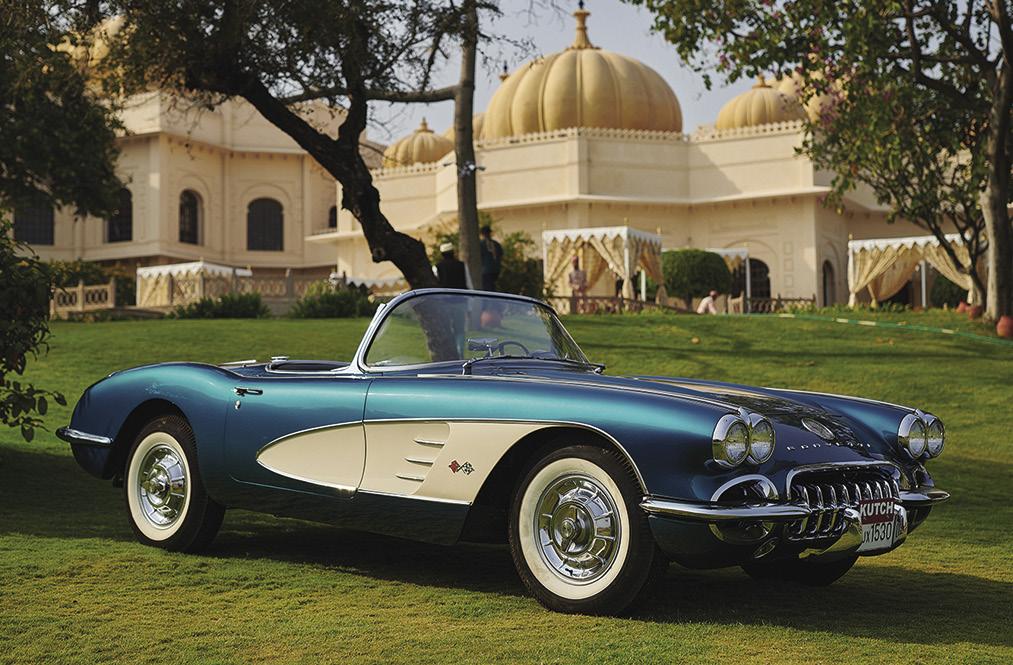

Classics, which was a fascinating group of Lancias from the 20s and 30s, plus a 1922 Ansaldo—a rare marque that required some research as I had never before seen an example of this high-quality Italian car. We also judged Prewar American and European Classics, a group from which came the Best of Show—a stunning 1939 Lagonda V12 Drophead Coupe, which will be on the lawn at Pebble Beach this August.
Saturday evening saw an elegant fashion show followed by a grand dinner for all involved.
On Sunday two “talks” (we call them forums) found participants enjoying, among others, a really fun match up of Jacky Ickx and Jochen Mass, who could do “stand up” with the best of them. Then, following another full day of display, the winners were driven past a reviewing
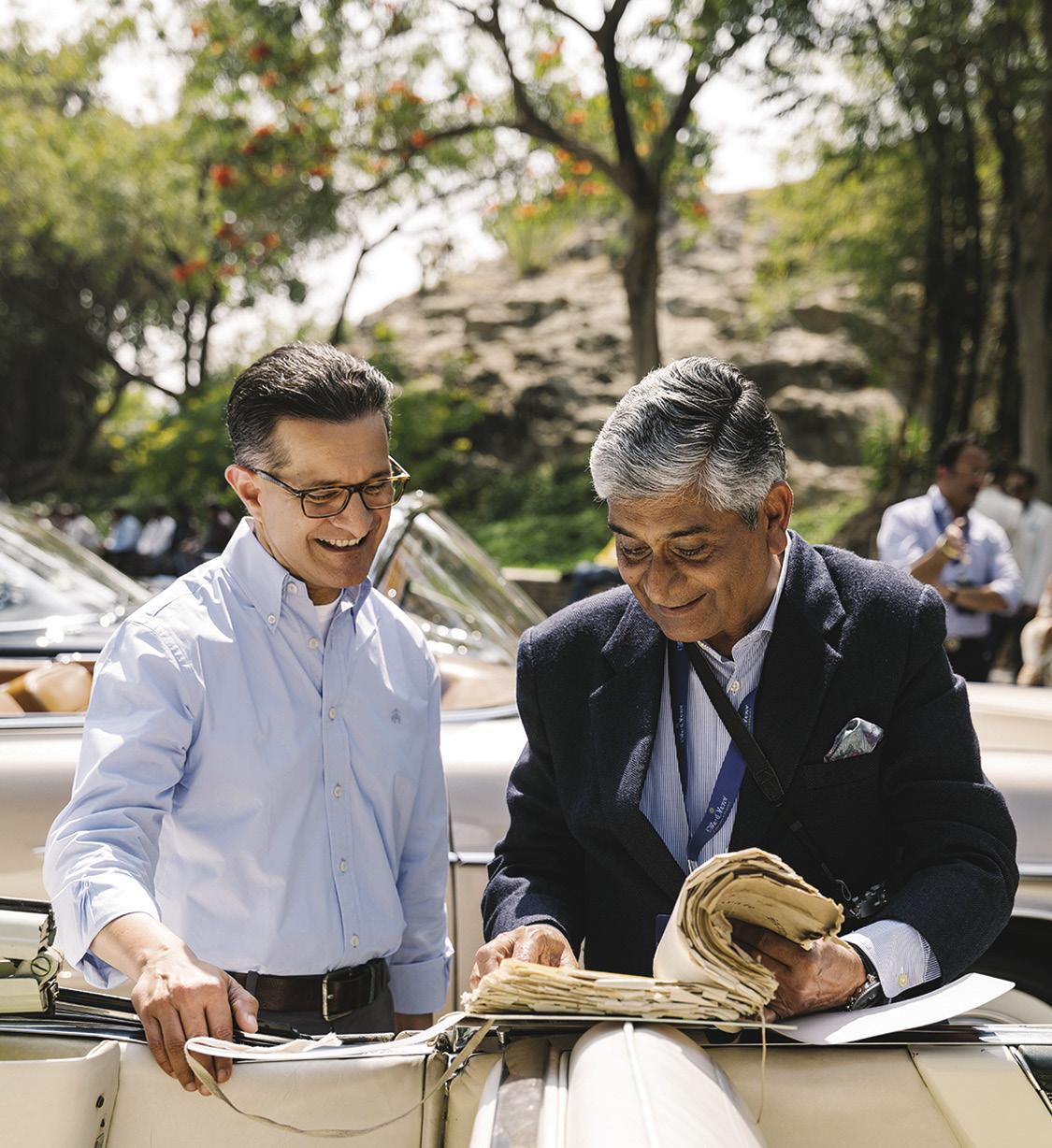
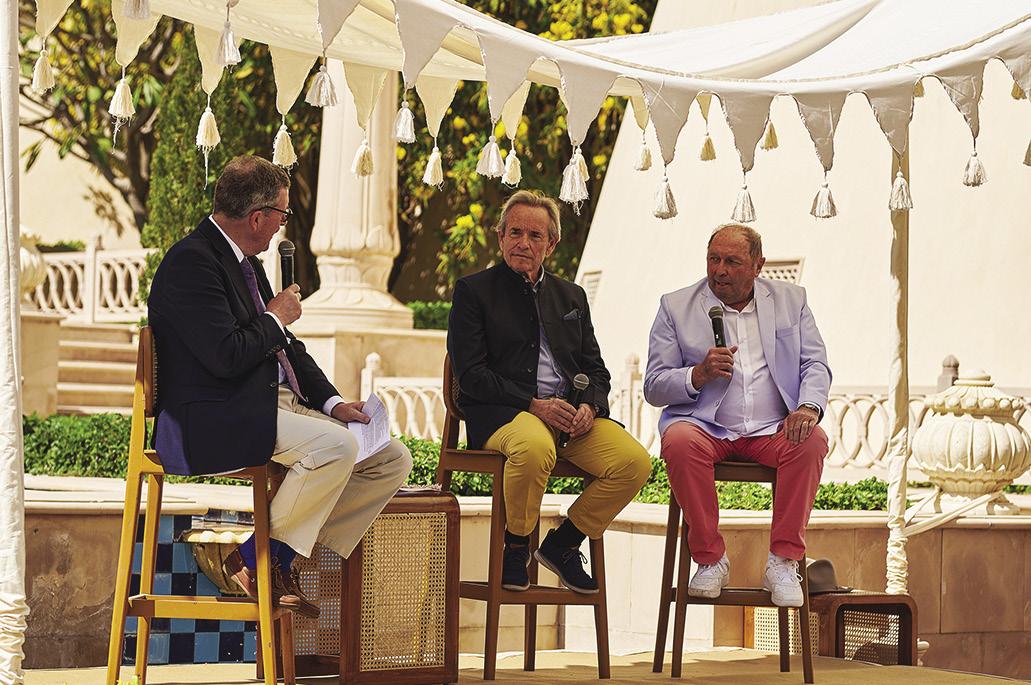

CHRIS BOCK 80 Pebble Beach Concours d’Elegance INSIDER
A Figoni-bodied 1935 Delahaye 35 MS Roadster poses with some of the Oberoi’s many domes as a backdrop.
Opposite, clockwise from top left: A one-owner 1958 Corvette from the Maharajah of Kutch; Vikram Oberoi, MD, of Oberoi Hotels, listens with interest as Sudhir Kasliwal shares the detailed records of a 1956 Cadillac Convertible previously owned by the Bikaner royal family; Richard Charlesworth interviews racing greats Jacky Ickx and Jochen Mass; Pebble Beach Concours Chairman Sandra Button steps forward to serve as Oberoi Chief Judge; HRH Prince Michael of Kent takes a spin in a replica steam car made in India.

“One entry in our group was being passed from the fourth to the fifth generation of a family, and they had a scrapbook with every document pertaining to the car—from its delivery invoice in 1937 to the present...”
– CHRIS BOCK
from Our Chief Judge
Musings
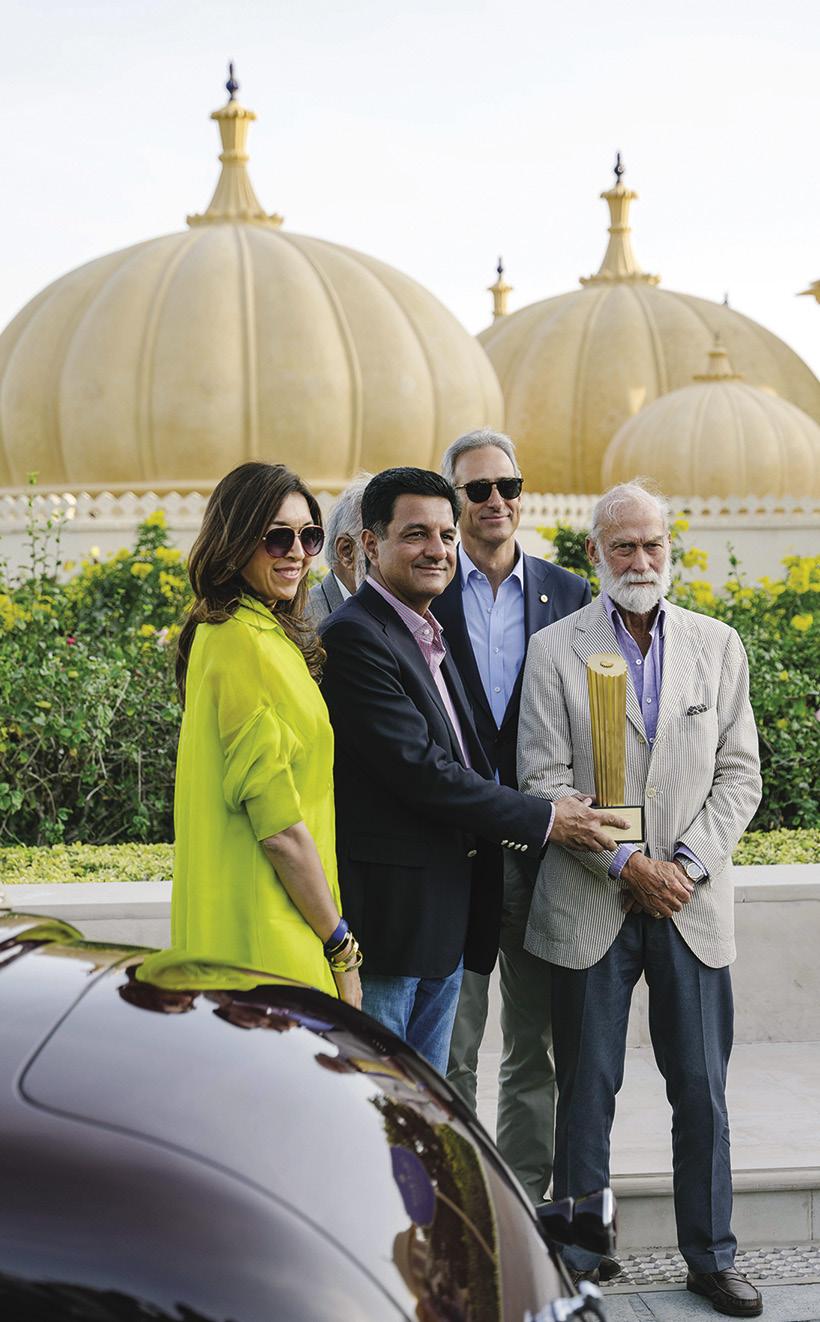

Here and left: Arjun Oberoi, HRH Prince Michael of Kent, and others congratulate Nishant Dossa on his Best of Show-winning 1939 Lagonda V12.

stand to receive their trophies. Simon Kidston acted as Convenor, or Master of Ceremonies, with the various Judges, including HRH Prince Michael of Kent and HH Maharajah Yaduveer Krishnadatta Chamaraja Wadiyar of Mysore, making the presentations. As the day ended, Arjun and Mila Oberoi hosted the Judges and Officials at a beautiful dinner overlooking Lake Pichola.
The Oberoi Concours was a wonderful success in a spectacular location. The attention to detail, the gracious hospitality of the Oberoi family, the hard work of Manvendra Singh Barwani in gathering a fascinating field of unique vehicles, the Judging expertise of Sandra Button and her carefully selected International Team of Judges, and the incredible setting all ensured that this was an event to be long remembered. I surely hope that this was just the first of many Oberoi Concours to follow.
A quick hop to Mumbai, a night at the incredible Oberoi Hotel there, and a 16-hour direct flight to San Francisco, and I was back to reality after an amazing experience. Admittedly, it was a bit of an adjustment after a week of being so wonderfully spoiled during my stay in India— no roses on my pillow, no one to press my clothes, no incredible meals, no personal butler at my beck and call. . . .
One could get used to such things!
CHRIS BOCK
Above: Butler Vaishnavi Desai was attentive to any needs of Pebble Beach Concours Chief Judge Chris Bock, who served on Oberoi’s judging panel.
82 Pebble Beach Concours d’Elegance INSIDER


The paramount platform for luxury automotive lifestyle worldwide.
never forget the one that sparked your driving dreams. dupontregistry.com
You
Four Pebble Beach Insiders
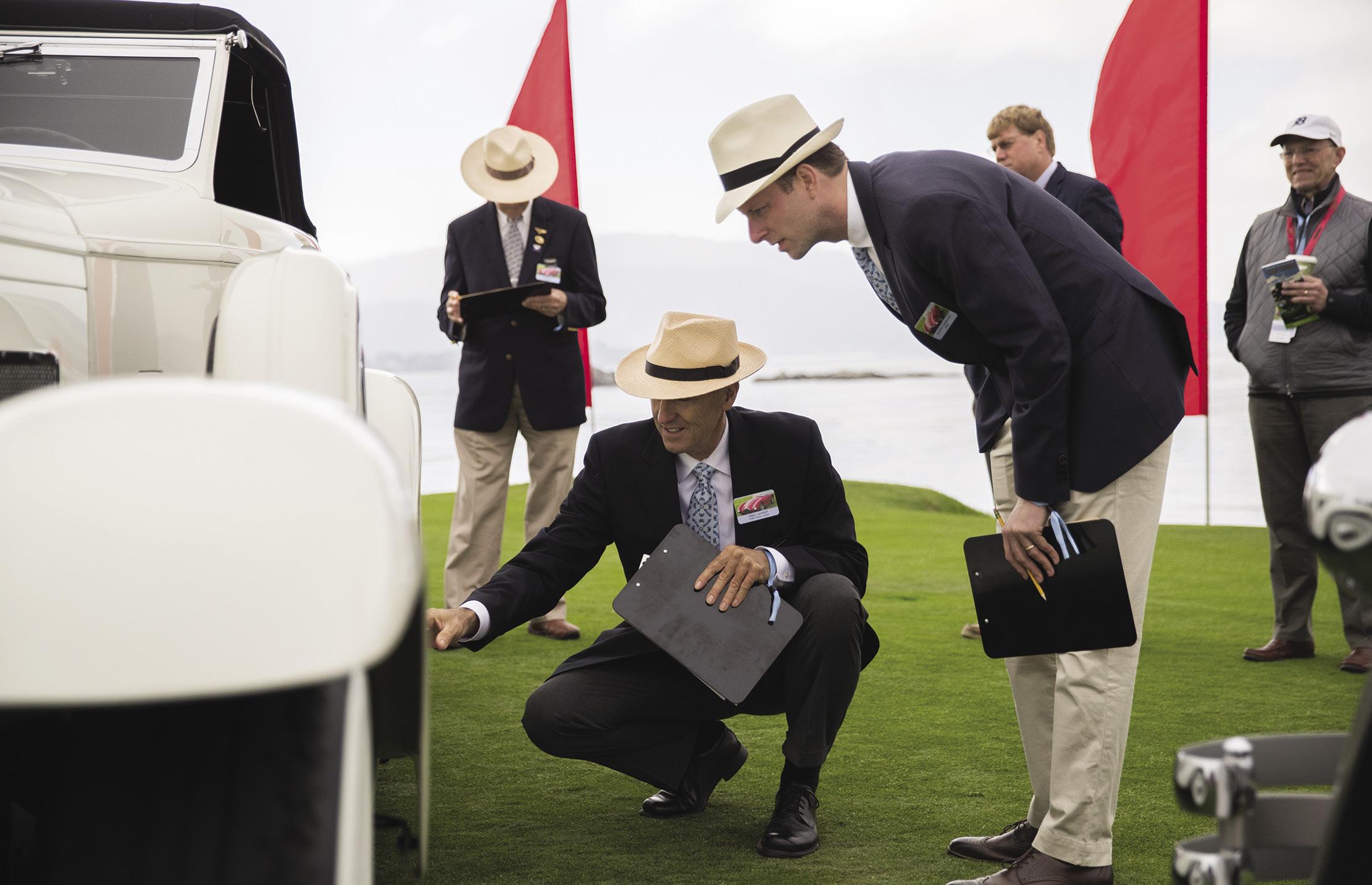
Jonathan Sierakowski (leaning forward), the newest member of our Selection Committee, joined our judging teams in 2017.
JONATHAN SIERAKOWSKI
Jonathan Sierakowski has served as a Judge at Pebble Beach since 2017. At a young age he developed a passion and focus for prewar coachbuilt cars, and throughout his career this has been an area of primary focus.While passionate about discovering and documenting provenance, he enjoys driving and can be frequently spotted out with his family in their 1934 Packard. He is also the organizer of the annual Duesenberg Tour.
Why cars? I grew up in New England, and by virtue of that geography was immersed in the early history of the United States, with field trips to many historic sites within a short drive. I also grew up in one of the many old mill towns in that part of the country. An antique car on the road would catch my interest, but it wasn’t until I had the opportunity to see an unrestored Horch 853 in my early teens that I connected my appreciation of historicity to prewar automobiles in particular and became interested in stories of who constructed and owned these cars so many years ago. I have to credit my dad for taking me to browse at a local restoration facility, and Butch Gordon for
providing the opportunity to work at his shop and further develop a love of old cars. The rest is history.
If you could go back in time, what historic automotive event or person would you want to see and why? I’d love to attend the 1933–34 Chicago World’s Fair. There were many great cars on display, such as the Duesenberg Twenty Grand, the Packard Car of the Dome, and the Cadillac V-16 Aerodynamic Coupe. Beyond the automotive displays was the optimism espoused in the overall theme of the event; held during the worst years of the Great Depression, it was dubbed “A Century of Progress.” The most famous advertising artwork contains Art Deco representations of science, industry, architecture, and air travel. There was an implicit promise that a better tomorrow—fueled by technological innovation—was just around the corner.
What Pebble Beach Concours moment do you remember most? I am a driving enthusiast, and while seeing exceptional cars placed on the 18th fairway on Sunday is always special, I equally appreciate the sights and sounds of the cars preparing for and taking off on the Tour d’Elegance on Thursday morning. It’s a wonderful
4 FOR THE ROAD Cars in the Lives of
84 Pebble Beach Concours d’Elegance INSIDER
way to preview and engage with the cars in close quarters, while visiting with friends and having a cup of coffee.
A few years ago I was privileged to drive the Tour in one of the surviving Bentley Speed Six Le Mans team cars. It was extraordinary to be behind the wheel of such an incredible piece of history—and when I had the opportunity to open it up on a clear stretch of road, it provided a small glimmer of the exhilaration felt by team drivers in period. I’ll always hold this as one of my fondest Pebble memories.
If you could walk the Pebble Beach Concours show field with just one person, who would you choose, and what car(s) would you most hope to see and why? If I could walk the Concours field with anyone, it would be Franklin Hershey, and I would like to look at the Duesenbergs. Hershey was gone before I became involved with cars in a serious way, but I find it remarkable that he was one of several period coachwork designers who remained involved with automobiles into the collector era. What a treat it would be to hear the stories behind specific coachwork designs, to learn about competition with others in the field and interactions with clients like George Whittell, and to listen to his reflections upon seeing his designs elevated into the fine art sphere.
CRISTINA CHEEVER
Cristina Cheever holds the role of Senior Vice President, Live Media & RR1 and is responsible for all experiential marketing and private club membership across Robb Report and Penske Media Corporation’s art titles including ARTnews, Art in America, and Artforum. Prior to joining Penske, Cristina spent 20+ years leading marketing and communications efforts at iconic luxury marques, including Porsche Cars North America, Aston Martin, and Jaguar.
Why cars? My love and passion for cars began the day I drove my first classic car—a 1965 Jaguar Series 1 Coupe. It was beyond exciting and terrifying! The proud owner tossed me the keys during my first days on the job in the auto industry, and I could not resist. Since then, I have had the opportunity to drive several iconic cars and have had the pleasure of meeting amazing individuals and illustrious drivers. I have been blessed to have experienced rightseat time with legends that I will not soon forget: Hurley Haywood, Carroll Shelby, Phil Hill, Jacky Ickx, Denise McCluggage, Hélio Castroneves, Mark Webber, Martin Brundle, David E. Davis, Jay Leno, Patrick Long, and Patrick Dempsey—just to name a few! People are truly the “why cars” for me.
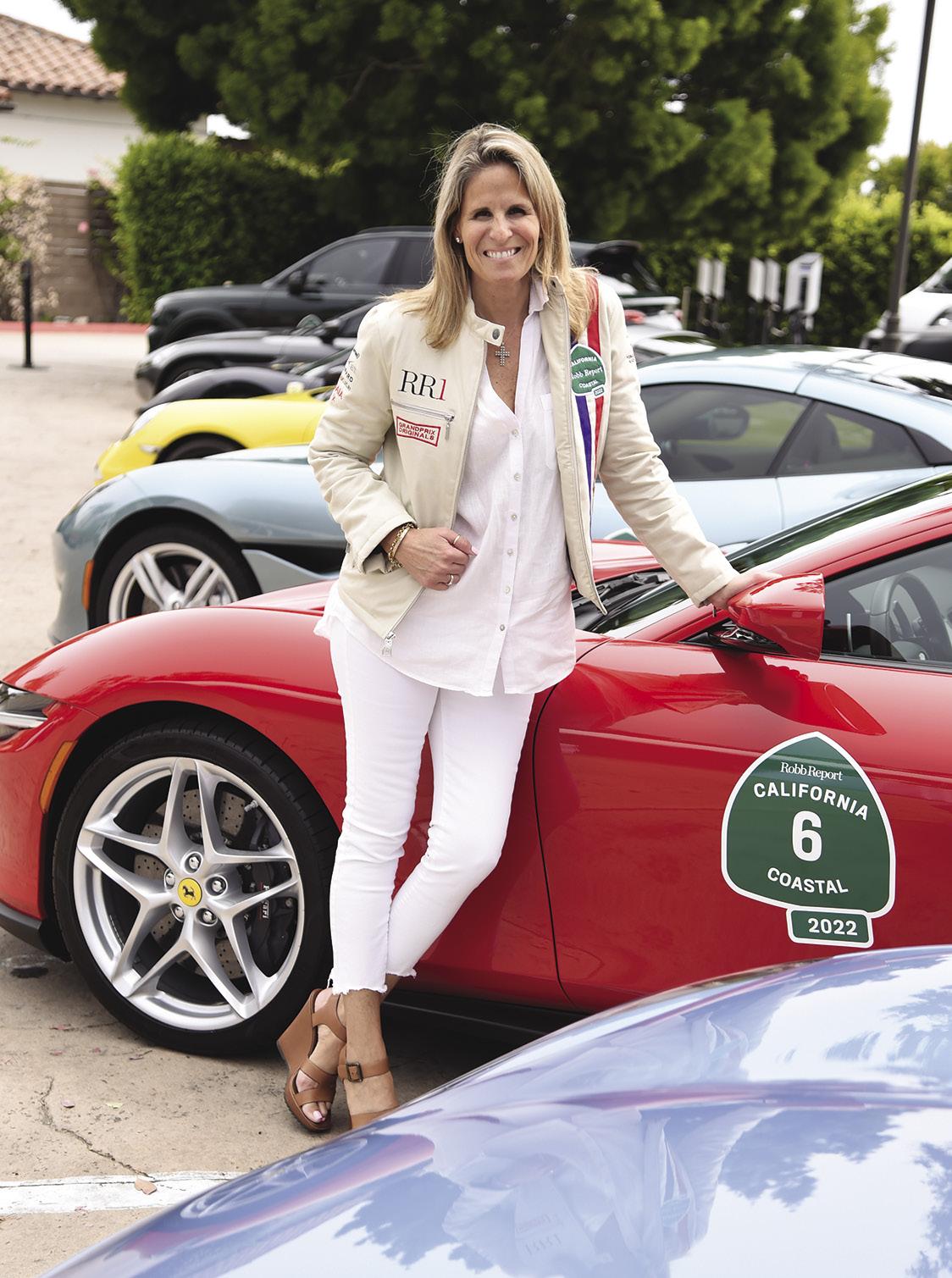
If you could go back in time, what historic automotive event or person would you want to see and why? As a first generation Italian-American, each year I dream of being part of the most breathtaking race in the world— the Mille Miglia. The original in 1927 was quite different from the event it has become today, but in my opinion, it remains an undeniable gathering place for enthusiasts! It bestows unforgettable moments, stunning landscapes, delicious meals, and the opportunity to form unique and treasured friendships. The thrill of the Mille for me is being able to drive in a classic car, maybe something red, and Italian, and beyond rare—a Ferrari 250 GTO circa 1963 sounds just about perfect.
What PBC moment do you remember the most and why? There are so many incredible moments that stand out in my mind. I have been attending the Pebble Beach Concours d’Elegance since 2000, when I was working for Jaguar and we showcased the Jaguar F-type concept. It was an unbelievable way to kick off the next 23 years of Concours events! My most memorable year was when I had the honor of pulling together not one, but 12 of the remaining16 Jaguar XKSS models produced in 1957 for a unique 2010 display. Up until that day, there had never been that many examples of the XKSS in the same place at the same time—except, of course, at the assembly plant that gave birth to them! I also had the chance to
Cristina Cheever pauses for a moment amidst cars on the 2022 Robb Report California Coastal Rally.
Pebble Beach Concours d’Elegance INSIDER 85
organize a rally from Casa Palmero to Laguna Seca for some hot laps and then visited the historic Mission San Carlos Borromeo in Carmel. To top it all off, I rode onto the Concours field during Dawn Patrol in a road-going version of the D-type formerly owned by the famed Steve McQueen!
If you could walk the Pebble Beach Concours show field with just one person, who would you choose, and what car(s) would you most hope to see? Maybe not your average answer, but it would be amazing for me to walk concours field with my three kids; they hear me speak with so much joy and excitement about this event each year, and it would be incredible to see their faces as we pass some of the most iconic and historic pieces of art while meeting some of the coolest people on the planet!
TIM LAYZELL
Tim Layzell started drawing and painting cars when very young, and at age 13 he won a young motoring artist award from the British Racing Drivers’ Club. From that moment on, he has been painting in a few different distinctive styles, capturing scenes from motorsport history and road cars in beautiful backdrops. He has created all three of our posters this year, as he has for several previous years.
Why cars? From a very early age, I was taken to Vintage Sports Car Club events, watching cars from the 1920s through the 1950s on race tracks and hillclimbs in the UK. I would get home from these events and draw pictures of the cars I’d seen and race my brother around the house on pedal go-karts! I dreamt of racing a historic car one day, and I am now lucky enough to race at events like the Goodwood Revival. I would love to try one at Laguna Seca!
If you could go back in time, what historic automotive event or person would you want to see and why? I am always drawn to the Mille Miglia around Italy and the Targa Florio in Sicily. I think it must have been incredible to watch the Mille, seeing drivers like Stirling Moss, Juan Manuel Fangio and Peter Collins race wheel to wheel through the beautiful scenery. But for me I think watching the Targa Florio, seeing local legend Nino Vaccarella blast through the streets with the crowds erupting and the sounds bouncing off the walls, must have been mind-blowing. I have driven the route, and it’s stunningly beautiful.
What Pebble Beach Concours moment do you remember most? One of the highlights of the Concours every year is the incredible atmosphere when the cars are coming onto the field at Dawn Patrol, but I actually love

the end of Concours Sunday, too. There are people with rosettes and trophies, but all the entrants are winners for getting a car to the field, and that shines through in that period of the day for me. Having painted a few of the cars for the posters every year, I get very excited to see these cars on the show field in the flesh.
If you could walk the Pebble Beach Concours show field with just one person, who would you choose, and what car(s) would you most hope to see?
Hopefully my nephew is going to make it over from the UK for this year’s event. Despite being only 13 years of age, he has an encyclopedic knowledge of historic racing cars, so to see and share such legendary vehicles with their incredible stories that have often only been seen in books would be amazing. It’s so important to share our passion with the next generation. I personally love 1950s to ’60s GT racing cars, so a Ferrari 250 is always a favorite in my eyes; they never fail to make my jaw drop!
GEORGE WINGARD
A builder, businessman and former Oregon State Senator, George Wingard has been showing cars at Pebble Beach since 1977. He won the Lorin Tryon Trophy in 2012 for his contributions to the collector car world.
4 FOR THE ROAD Cars in the Lives of
Pebble
Four
Beach Insiders
86 Pebble Beach Concours d’Elegance INSIDER
Tim Layzell shares his original art for the 2015 Pebble Beach RetroAuto poster, focused on the cars of Briggs Cunningham.
Why cars? When I was 15 years old I traded a box of fireworks with my sister’s boyfriend to get my first car—a Model T Ford. It didn’t run, but I worked on it and made it run even before I could get a license to drive it. My second car was a 1916 Buick. I saw it in a field and asked the lady who owned it if she would sell it. She said, “Sell it! Just please take it away!” So I did. I got it running, kept it running, and sold it for $270 in 1953, which paid the tuition for my first year of college. Some years later a guy called me and said, “Would you like to have your Buick back?” I did want it, and I own it to this day, I am the sixth owner. This was the AHA! moment when I decided that buying and collecting cars was a good idea. I was Hooked!
Through my young years, though, an old mechanic in Lakeview taught me about cars and let me know there were a lot of cars out there worth buying and collecting. And later, Phil Hill encouraged me to continue collecting.
If you could go back in time, what historic automotive event or person would you want to see and why? I would have liked to experience the 1914 French Grand Prix. It is one of the most important races in history, and I am fortunate to own the winning car today.
What Pebble Beach Concours moment do you remember most? The 1982 Pebble Beach Concours d’Elegance, when I received the Gwenn Graham Trophy for Most Elegant Convertable and was just one vote short of Best of Show. My wife and two daughters were with me at that time.
If you could walk the Pebble Beach Concours show field with just one person, who would you choose, and what car(s) would you most hope to see? I would love to walk the show field with Phil Hill. Phil once told me a touching story about his first meeting with famous American race driver Ralph De Palma. When Phil was 12 years old he rode his bicycle halfway across Los Angeles to hear De Palma talk about some of his famous racing exploits. During the question-and-answer session young Phil had raised his hand and addressed Ralph as Mr. De Palma. Ralph, being a little hard of hearing, thought he said Mr. De Paolo and admonished him severely in front of the crowd. At that point, a dejected hero-worshiping fan of De Palma sadly got on his bike and rode home.
Phil told me this story when we were asked to drive around the Indy 500 track—Phil was to drive and I was to be his riding mechanic— to celebrate Ralph De Palma’s 1915 Indy win in the 1914 French Grand Prix–winning Mercedes that I had just restored. It was a publicity event put on by Mercedes-Benz, which was hoping to celebrate another Indy
500 win some 80 years later. Unfortunately for Mercedes they didn’t even make it to the starting grid that year, but fortunately Phil and I had become better acquainted.
There will never be another Phil Hill. He earned his spurs as a racing professional by hard work and by developing an uncanny sense of how to survive. He succeeded when others didn’t because he had a sense of his limits and those of the machinery he was driving. He was also a professional mechanic, and he, too, started learning his mechanical skills by working on a Model T Ford. His sense of automotive and mechanical artistry allowed him to win Best of Show at the 1955 Pebble Beach Concours in a 1931 Pierce-Arrow Le Baron Town Car—and again in 1977 in a Packard 343 Eight Murphy Convertible Sedan.
To me Phil Hill’s most endearing quality was his total lack of self-aggrandizement. Perhaps he gained some of this down-to-earth quality as that boy of 12 when he was embarrassed by another world-famous race driver in front of a group of racing enthusiasts. I asked him once who he regarded as the best race driver ever. Without hesitation he said, “Five-time world champion Juan Manuel Fangio.” Then he hastened to add, “Stirling Moss could get more out of a race car than any other driver” he had known. Phil worked hard to become one of the best in the world, and he was.
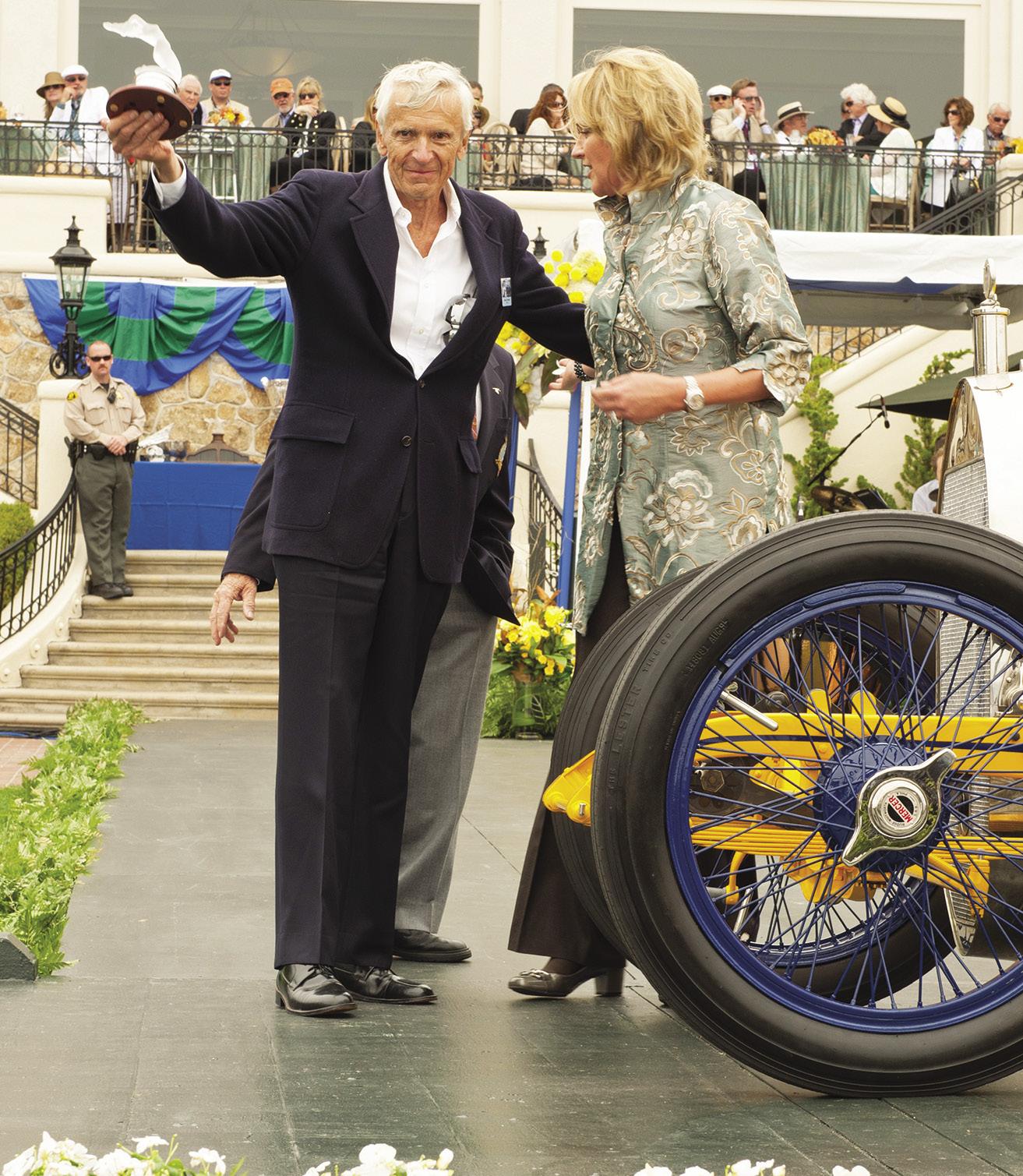
George Wingard was the 2012 recipient of the Lorin Tryon Trophy for his service to the
Pebble Beach Concours and the collector car community.





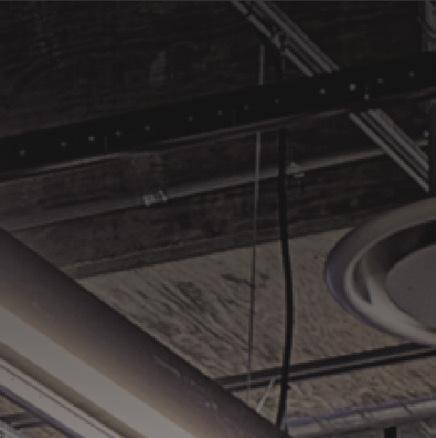


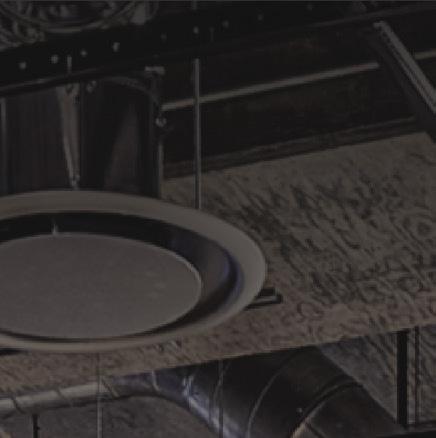






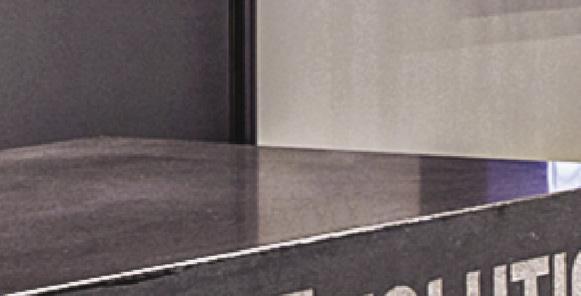
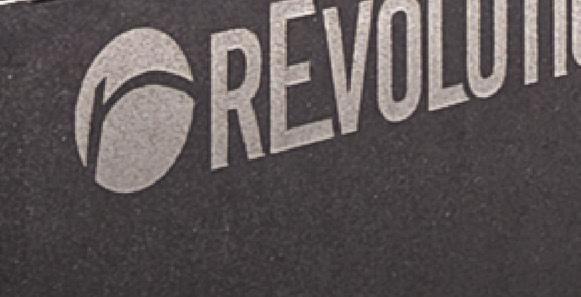

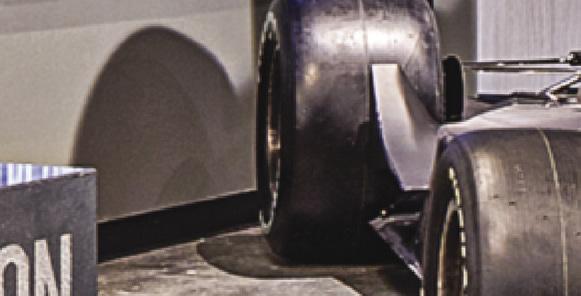



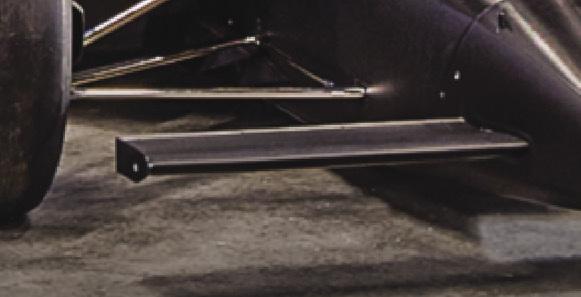



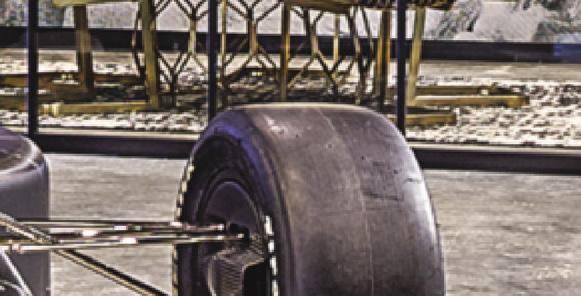





Gooding & Company’s monumental sale of the 1931 Duesenberg Model J Long-Wheelbase “Whittell” Coupe in 2011.
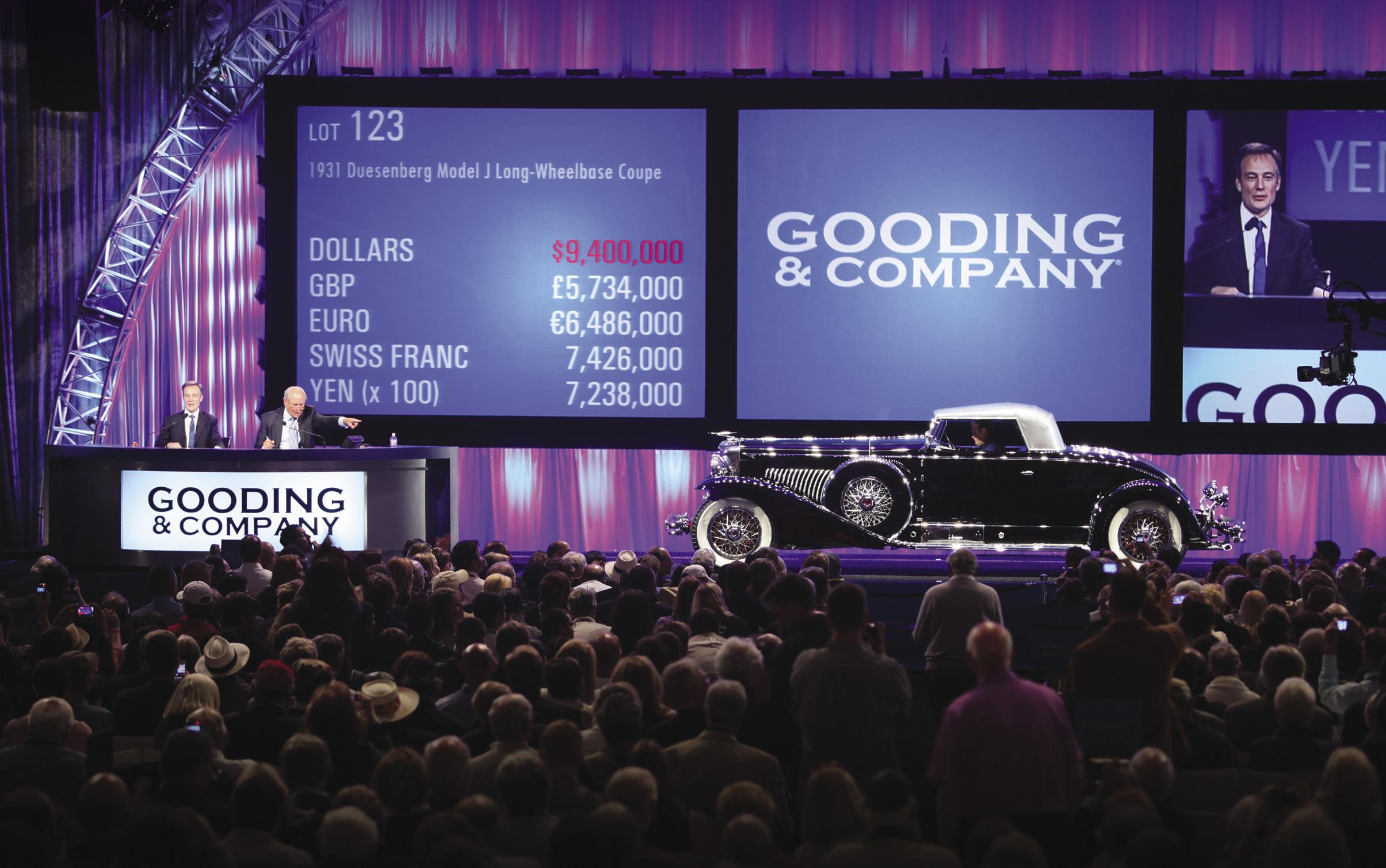
A 20-YEAR PARTNERSHIP
Gooding & Company and the Pebble Beach Concours d’Elegance
This year marks 20 years since Gooding & Company held their first auction as the official auction house of the Pebble Beach Concours d’Elegance.
In 2004, the Company, then a startup, opened its doors, delighting the car collecting community and quickly gaining a reputation for setting records and consigning some of the world’s finest automobiles. These cars would not only go on to win many titles on the Concours competition field, but create lasting collaborations and a culture of stewardship.
Of the first Pebble Beach auction, President and CoFounder David Gooding recalls, “It was a real sense of achievement and a feeling that we had carved our niche in the collector car community. Our sale had a distinct look and feel, from the catalog to the sales presentation, auctioneer, and overall philosophy of the company. To have the highest selling car of the weekend with the sale of the Mormon Meteor, Gooding & Company had signaled that we were here to stay.”
SANDRA BUTTON
Chairman of the Pebble Beach Concours d'Elegance
“I first met David Gooding in 1990, when he was involved in organizing the first Pebble Beach Auctions, presented at that time by Christie’s, and over the years I learned to trust and value his opinions.
“We set a very high bar regarding what we expected from Gooding & Company at their first auction here, and they met that—and more—right out of the gate. Gooding & Company, like the Concours, is committed to the pursuit and presentation of great cars—and ours has been a true partnership over the years. In making its name and setting multiple auction records here, the company has added to the prestige of Pebble Beach in the process.
“Along the way, Gooding & Company has hosted several big moments for our charities and those of others, so that as we pursue our automotive passion, we are also raising money for people in need. For that we are grateful.
“I hope our partnership lasts another 20 years!”
GOODING & COMPANY Pebble Beach
Auctions
Pebble Beach Concours d’Elegance INSIDER 89
Pebble Beach Auctions
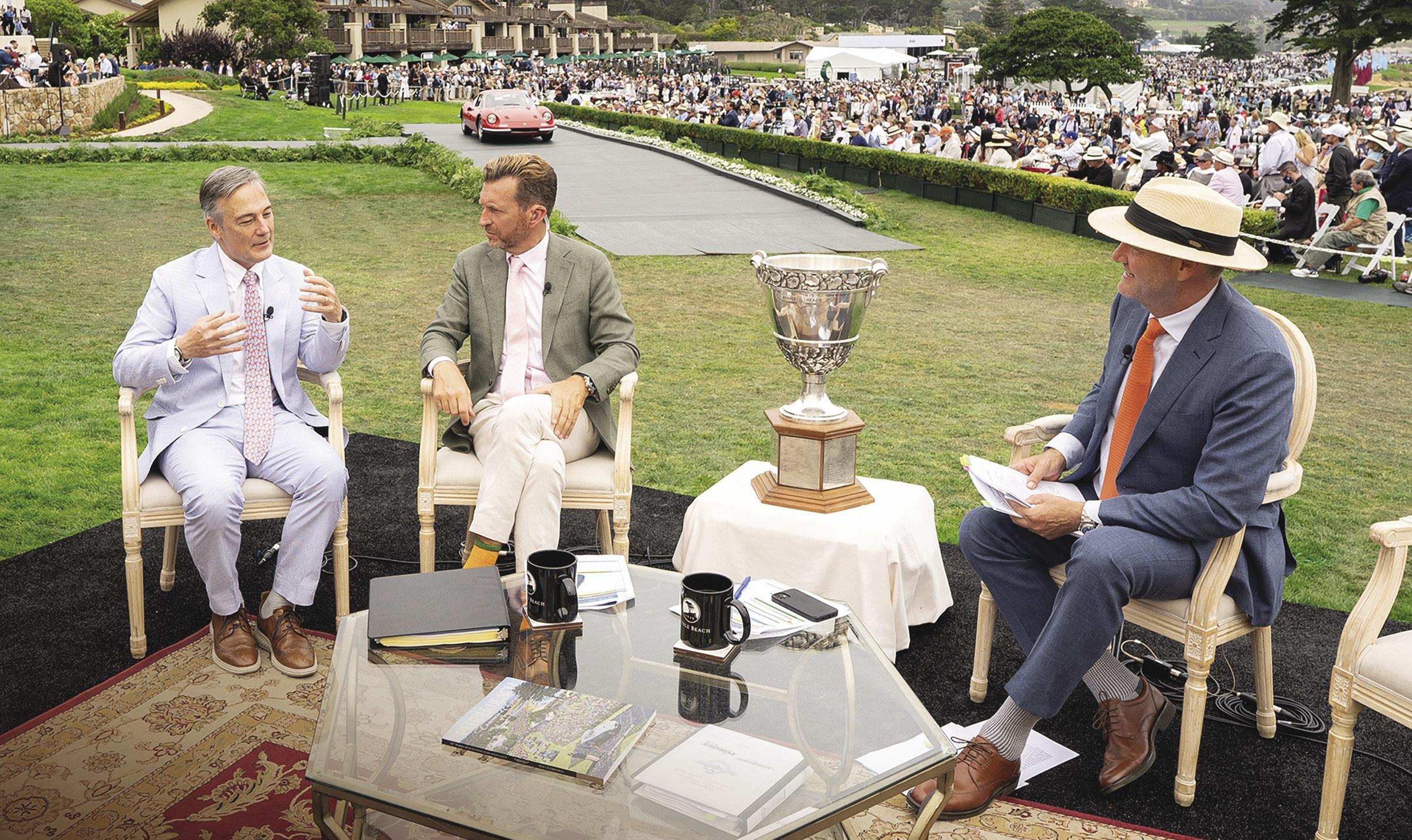
STEPHEN BRAUER
Collector, Chief Honorary Judge, and Committee Member
“I cannot forget the 1936 Mercedes-Benz 540K owned by Gisela von Krieger, or the Short-Chassis SSJ, or the Whittell Coupe. Those cars were just so spectacular. Integrity always reigns supreme at Gooding & Company, which is why it attracts so many true connoisseurs and bidders. Not to mention, Gooding has a massive and valuable knowledge base, even if it’s all in David’s head. Having grown up with the cars, David’s memory is staggering. Beyond that, consignors really get the best presentations, marketing skills, and best auction team. It’s the advice I always share with my friends for their cars.”
BRUCE MEYER
Collector
“I can’t believe it’s been 20 years. We were all just kids! The Gooding & Company auctions are a reunion from around the world of likeminded enthusiasts and collectors. It’s more like a fun party with old friends, with popcorn included. Then there are the one-of-a-kind offerings and record prices. This could not happen without the honorable
foundation and image led by David, bolstered by worldclass logistics, graphics, PR, and catalog presentations led by [co-founder] Dawn—it’s a winning combination of two very bright, classy, and loveable leaders and friends.”
CHIP CONNOR
Collector
“I enjoy the entire scene of Gooding & Company’s Pebble Beach Auctions, from the people to the lots on offer. Integrity, professionalism, and depth of knowledge are core characteristics of how they operate.”
FRITZ BURKARD
Collector
“In 2021, our cars were delayed in getting to Pebble Beach due to Covid. My family and the whole team were devastated they did not make the Concours. Still, I was able to buy a Bugatti Type 35C at the Gooding & Company auction on Saturday. Their team made the impossible possible, and we were able to show the Bugatti the next morning at the Concours. We even received the Chairman’s Trophy. It remains a wonderful family memory and a beautiful example of trust.
GOODING & COMPANY
Gooding & Company President and Co-Founder David Gooding talks with The Torque Show hosts Justin Bell and Tommy Kendall as they livestream the 70th Pebble Beach Concours d’Elegance.
90 Pebble Beach Concours d’Elegance INSIDER
After being sold by Gooding & Company at its first Pebble Beach Auction, the 1935 Duesenberg SJ “Mormon


“Of course, I cannot forget the Passion of a Lifetime auction, when the Bugatti Type 59 King of Belgium nearly caused me a heart attack. It is a nice coincidence that we will show the car this year at the Pebble Beach Concours. It is evident that professionalism and seriousness come first, but when you are managed by family, you can enjoy the fun side of the business.”
JONATHAN SEGAL
Collector
“Every time I sell and buy a car with Gooding & Company in Pebble Beach, it’s great. It has been truly fun every time. I so appreciate David Brynan and David Gooding fostering the development of my collection and giving me sage advice about cars—they give an honest opinion on whether or not to pursue a car. I’ve really never had a conflict where they put themselves first. They sold my 1950 Gilco-Alfa Romeo 6C 2500 Supergioiello Coupe with a record price for that car. It was totally their doing. Nobody else could have achieved that price. There was another time that Gooding bought six bottles of champagne for my posse after I bought a Maserati. Good memories.”
COLIN FEICHTMEIR
Collector, Judge, and Committee Member
“I think back on the early Pebble Beach auctions fondly as everything seemed so new, but my favorite climatic moment has to be the sale of the Duesenberg SSJ in 2018. It was an unrepeatable car that no one thought would ever be for sale, and the perfect recipe for a bidding war. From David Gooding initially teasing “you will never believe what we will offer this August” to the unveiling and finally, the gavel coming down, it was an incredible event to witness. Even at the time I realized it was one of those moments the hobby will be talking about for decades.
“Walking into the Gooding tent at Pebble is like visiting a convention for the most influential and knowledgeable people in the hobby. It is the cars that draw the informed collectors in, and they know that anything they are told about what is offered is accurate and dependable. That reliability and quality of consignments go hand in hand to create a culture of excellence.”
Meteor” Speedster returned to the Pebble Beach Concours in 2007 and was named Best of Show.
Pebble Beach Concours d’Elegance INSIDER 91
Celebrated auctioneer Charlie Ross and David Gooding at the rostrum at the very first Pebble Beach Auction presented by Gooding & Company, in 2004.
Pebble Beach Auctions
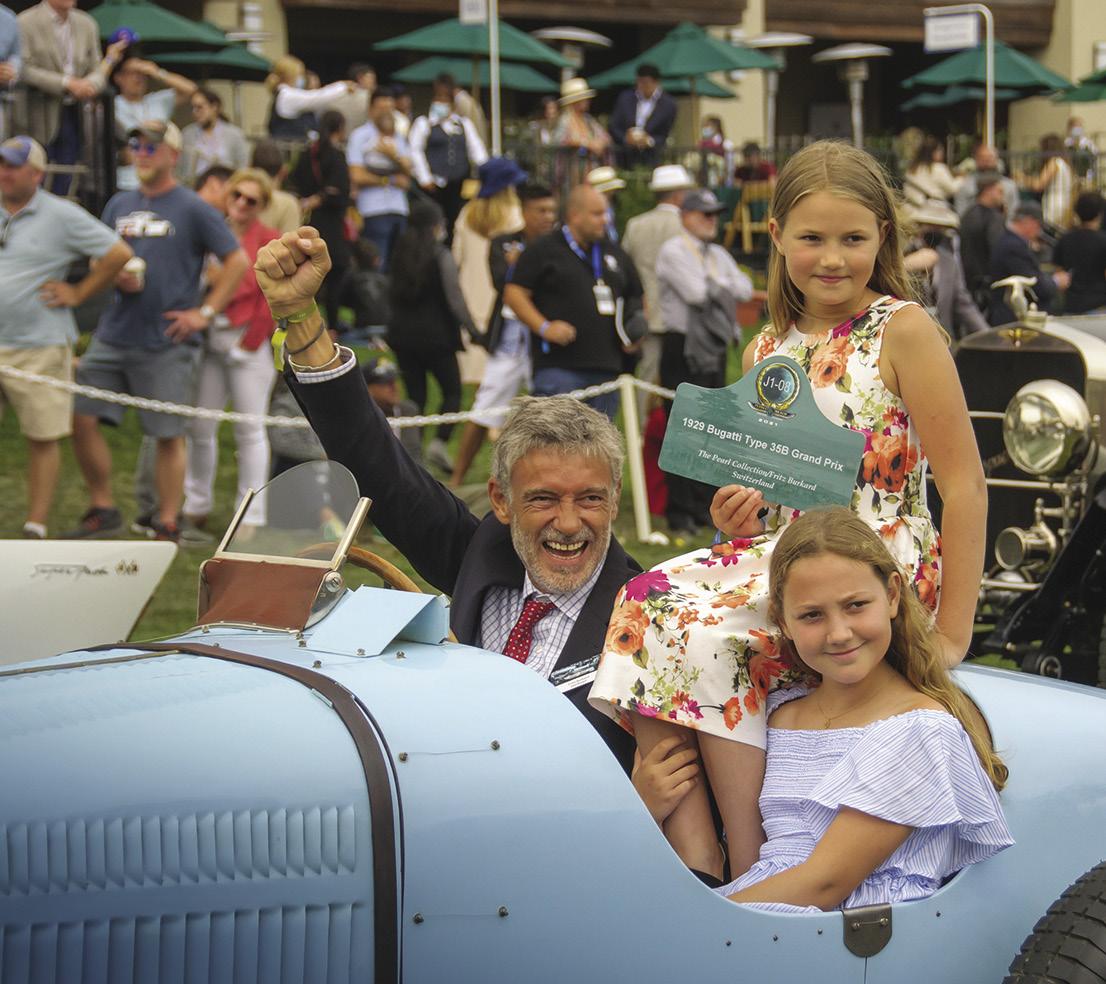
KEN GROSS
Writer, Judge, and Committee Member
“Gooding & Company always presents the highest quality cars, artfully described and catalogued. In some cases, like the George Whittell Duesenberg Coupe, and the Baroness’ Mercedes-Benz 540K Special-Roadster, they even offer a small book that’s an instant collectors’ item. And then there’s Charlie Ross.
“Charlie Ross is unquestionably the best auctioneer in the business. Smart, witty, focused, and fast, he casts a spell over the room—especially with important cars. Charlie appreciates the drama and savors the moment—he coaxes, encourages, even begs and admonishes bidders and they rise to the occasion. He’s entertaining and efficient—and he never loses his place. His mellifluous British accent alternates between charming and a gentle scolding. His enthusiasm is contagious. The cars are the show, of course, but so is Charlie.”
KEITH MARTIN
Publisher, Sports Car Market
“There is a genuine sense that everyone cares when you are at a Gooding auction, from the front desk to the auctioneer to the fellows wrangling the cars. They are always there to answer your questions and do what it takes to help you get the best possible results, whether buying or selling. Something often overlooked is how the atmosphere of a Gooding auction is the same, no matter the location. The tents seem to have the same configuration, and the interiors are always flooded with natural light during the
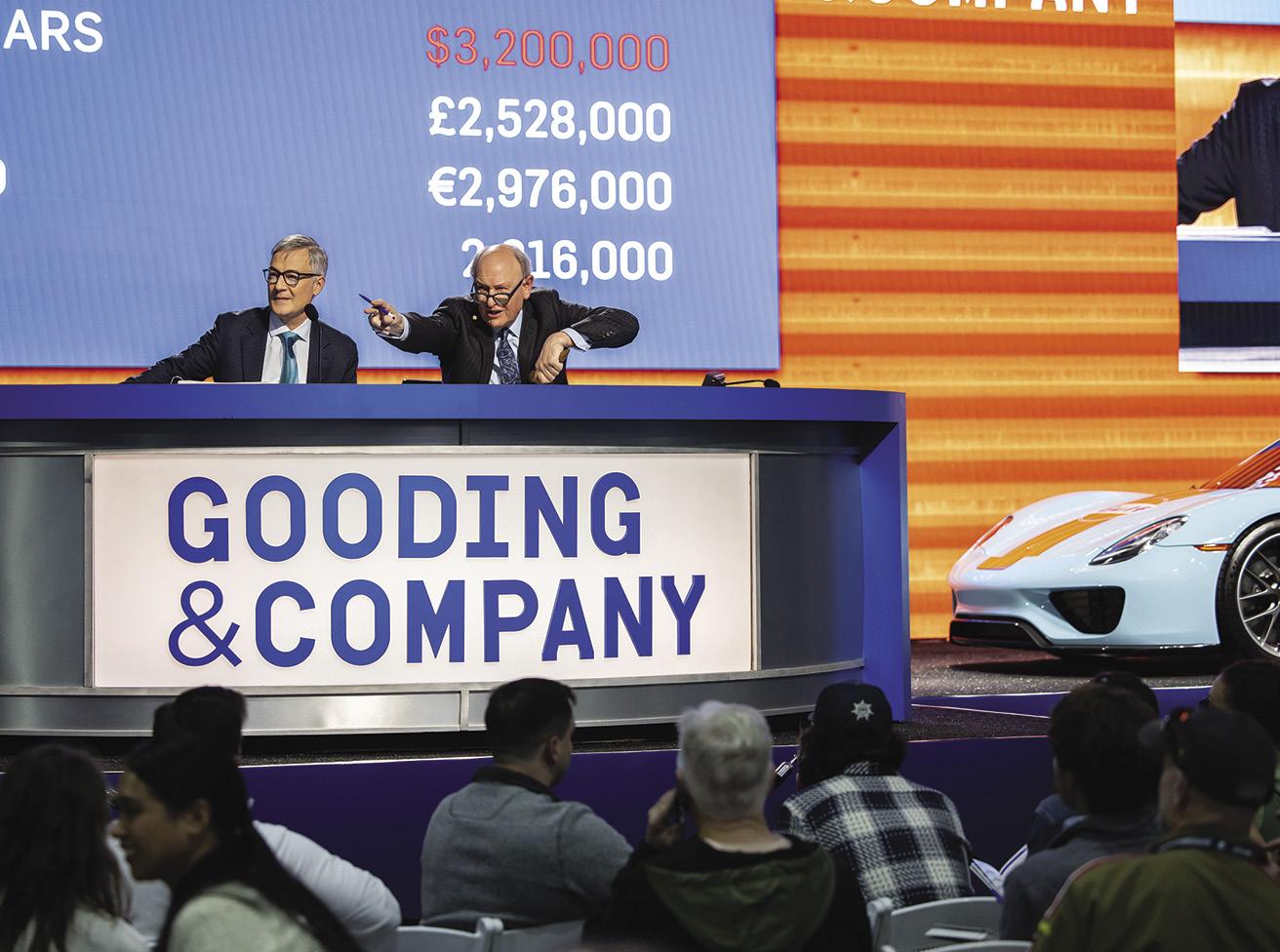
day. No matter the location of the auction, you always feel like you are ‘coming home’ when you enter their tent.
“I especially appreciate that every car that crosses the block is treated with the same underlying respect, whether it be the BMW Isetta that Gooding & Company sold for us or a multi-million-dollar Ferrari. The banter is always upbeat, positive, and respectful to all parties involved.”
GLENN MOUNGER
Collector and Former Co-Chairman of Pebble Beach Concours d’Elegance
“I was involved in bringing Gooding & Company to Pebble Beach and getting the 1935 Duesenberg SJ Speedster, the Mormon Meteor, as the cover car for the first auction. That car had been in Knox Kershaw’s family for decades, but he is a friend and I knew he was thinking of selling it. I told him the best possible place to do that would be Pebble Beach, and I was sure David would do well by it.
“I still remember the excitement when the Mormon Meteor crossed the stage, selling at what would be the first of many world record prices for Gooding & Company. They have been a perfect fit as the official auction house of the Pebble Beach Concours d’Elegance.”
In this momentous 20th year, Gooding & Company will continue to sell the most original, historical, and sought-after vehicles in existence, searching the world over to find them. This year’s Pebble Beach Auctions will undoubtedly deliver recordsetting sales, momentous collaboration, and proud clientele, as has been the Gooding & Company standard for the last two decades.
GOODING & COMPANY
When Covid delayed Fritz Burkard’s Concours entry at sea, he found and purchased this Bugatti Type 35C from Gooding & Company to showcase.
92 Pebble Beach Concours d’Elegance INSIDER
Gooding and Ross at the rostrum in recent days.
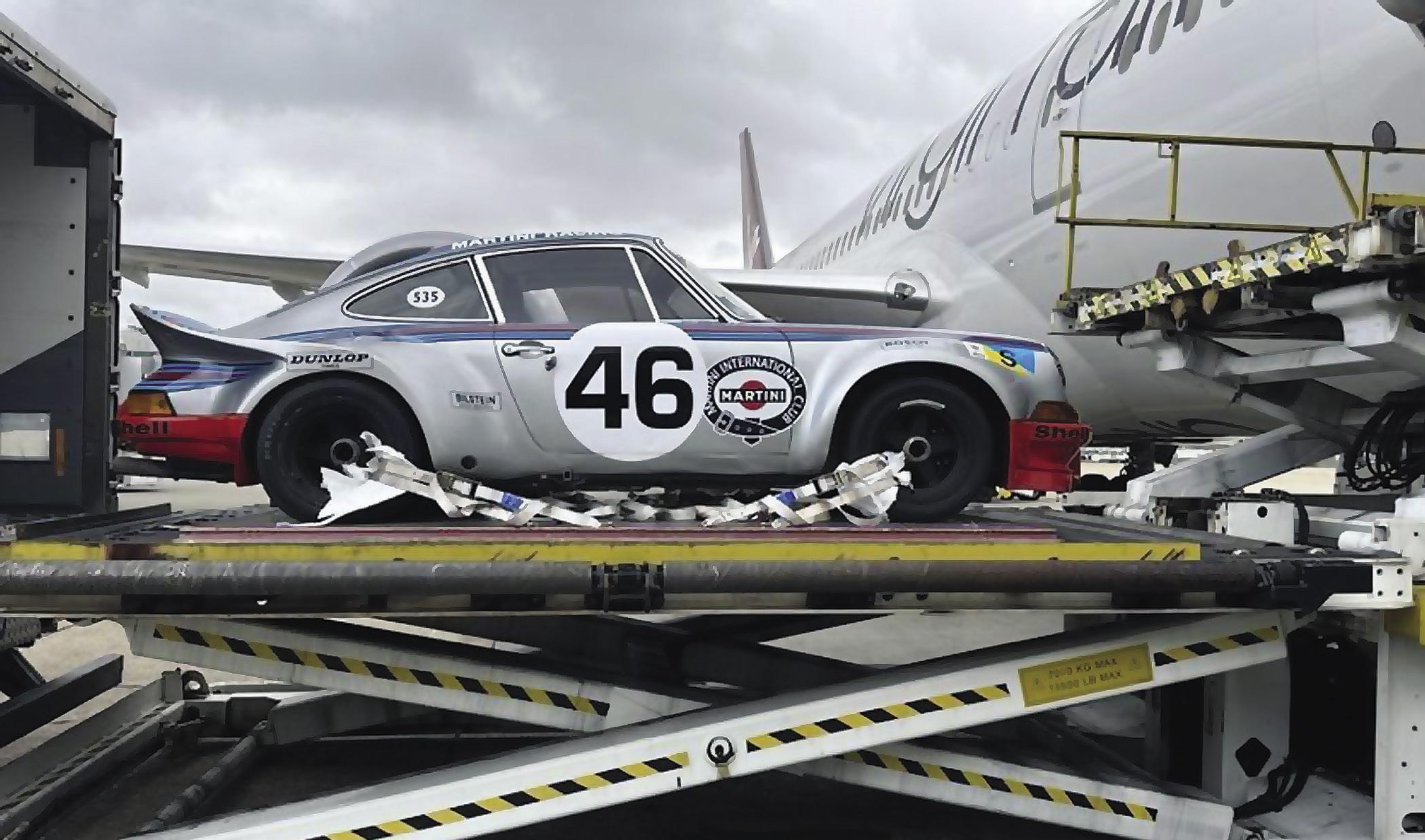
FRIENDS & FACES
2023 PEBBLE BEACH CONCOURS d ’ELEGANCE
Kelly Whitton and Robert Webster in their Mercedes-Benz 300 SL line up for the Tour with other Motoring Classic participants.

Occupants eagerly await the day’s events in a 1954 Aston Martin DB2/4 Bertone Coupé shown on behalf of
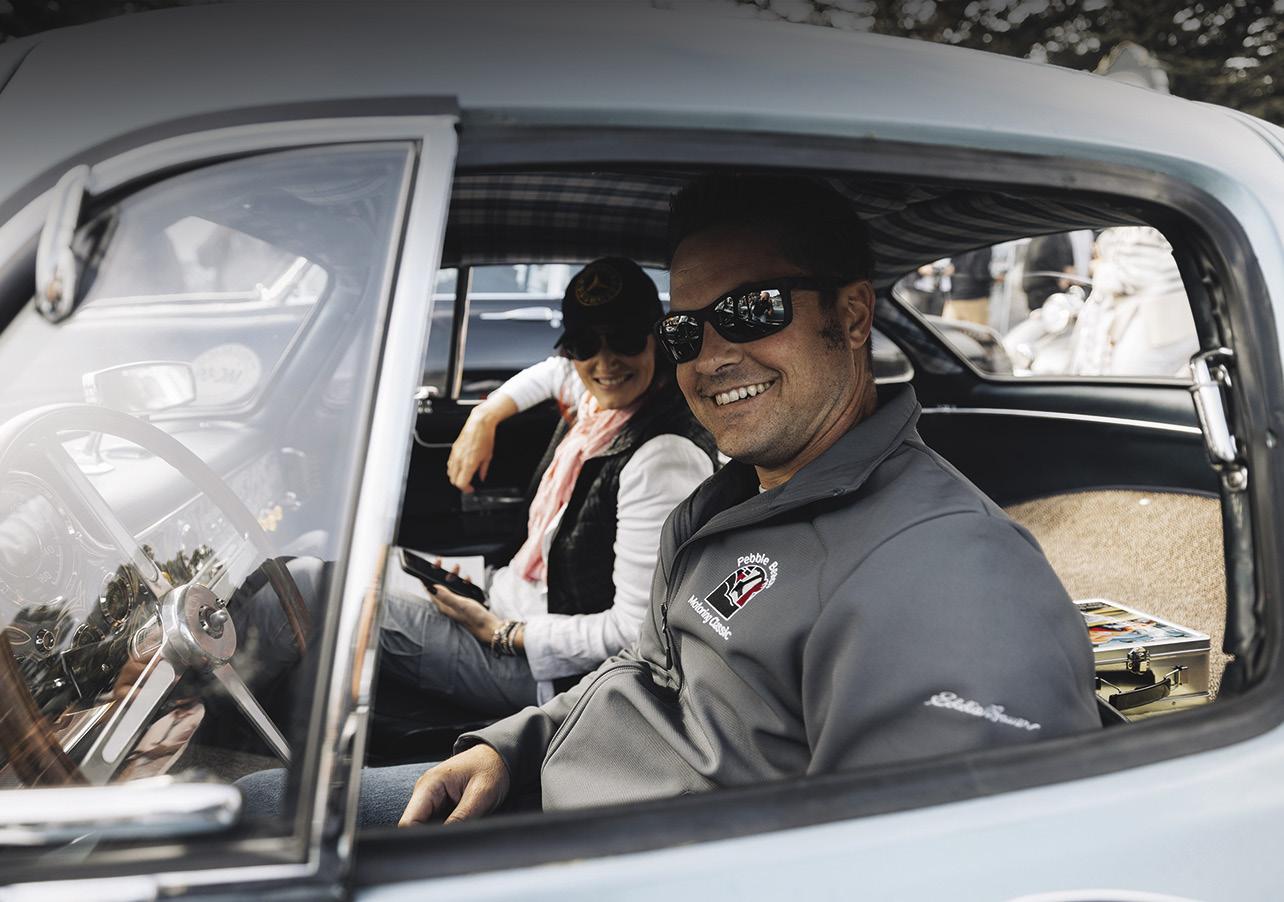
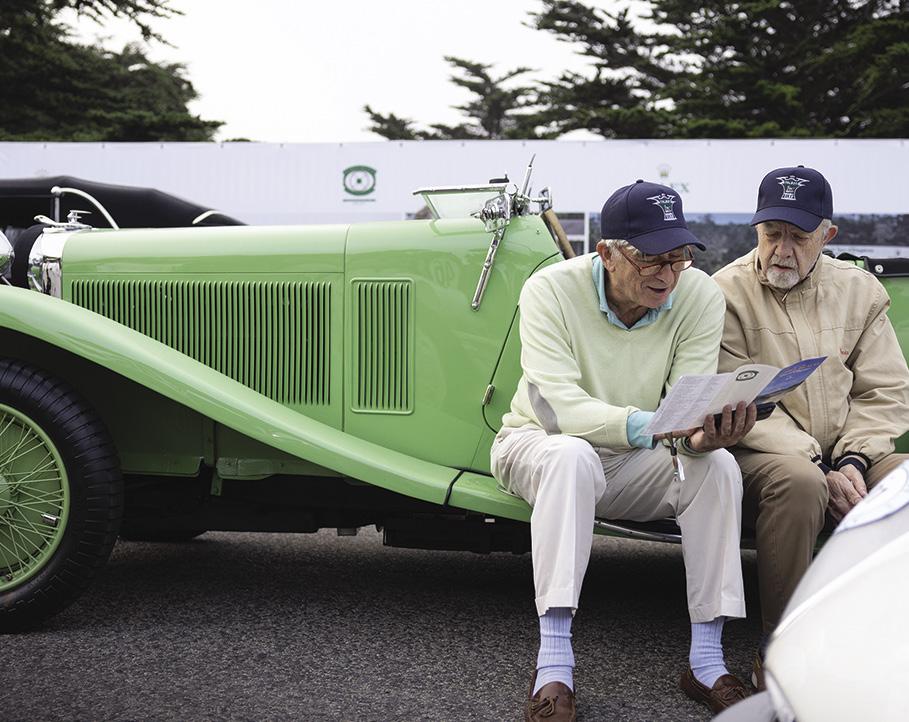
the
and
board
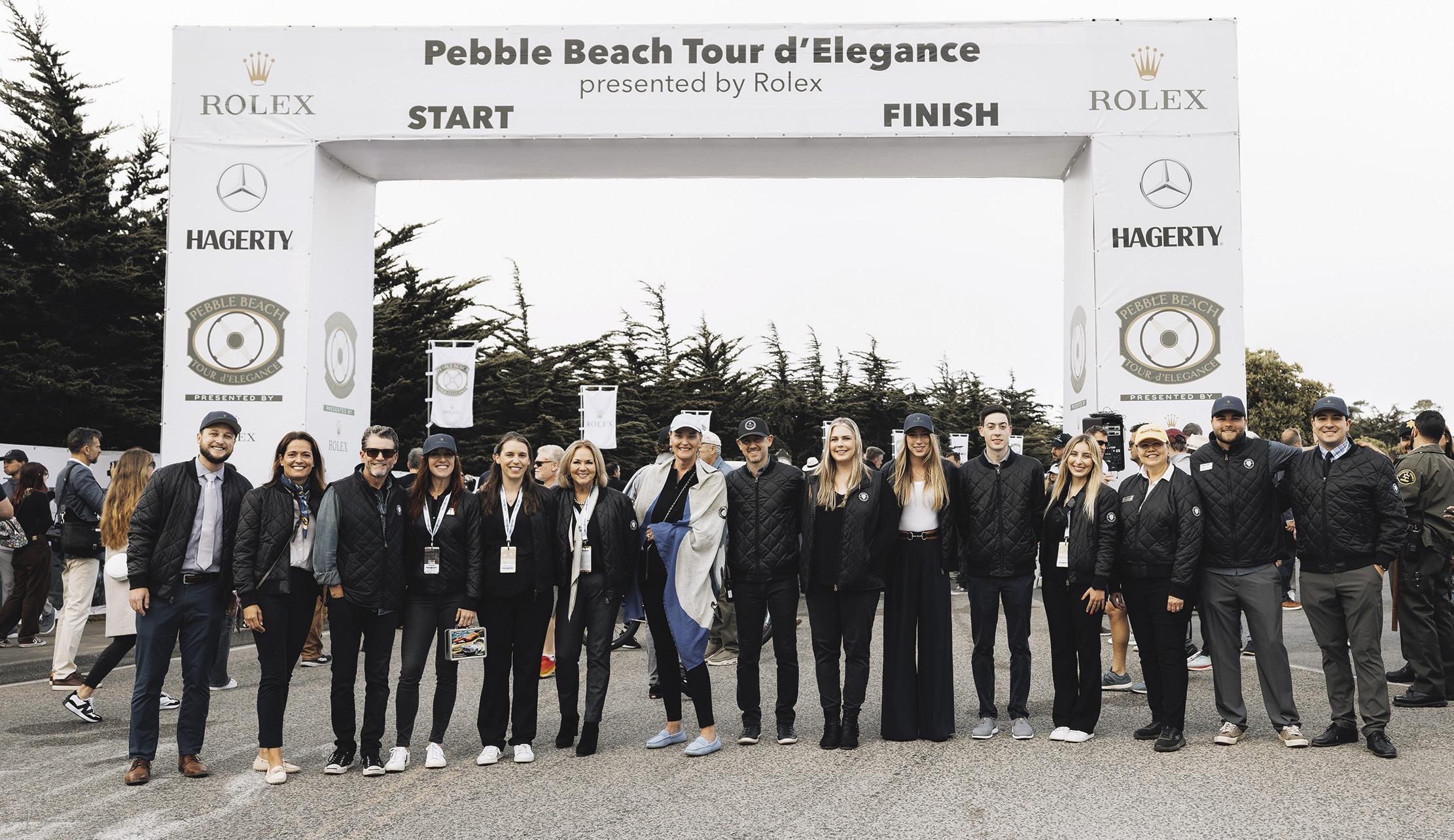
SOCIAL SEEN See & Be Seen at Pebble Beach Automotive Week
Richard Lisman
his restorer, Tony Dutton, relax on
running
of Lisman’s class-winning 1932 Talbot AV105 Fox and Nicholl Vanden Plas Tourer.
Alberto Gutierrez.
94 Pebble Beach Concours d’Elegance INSIDER
Sandra Button (in wrap) and many of her Concours team members pause amidst final preparations for the Pebble Beach Tour d’Elegance.
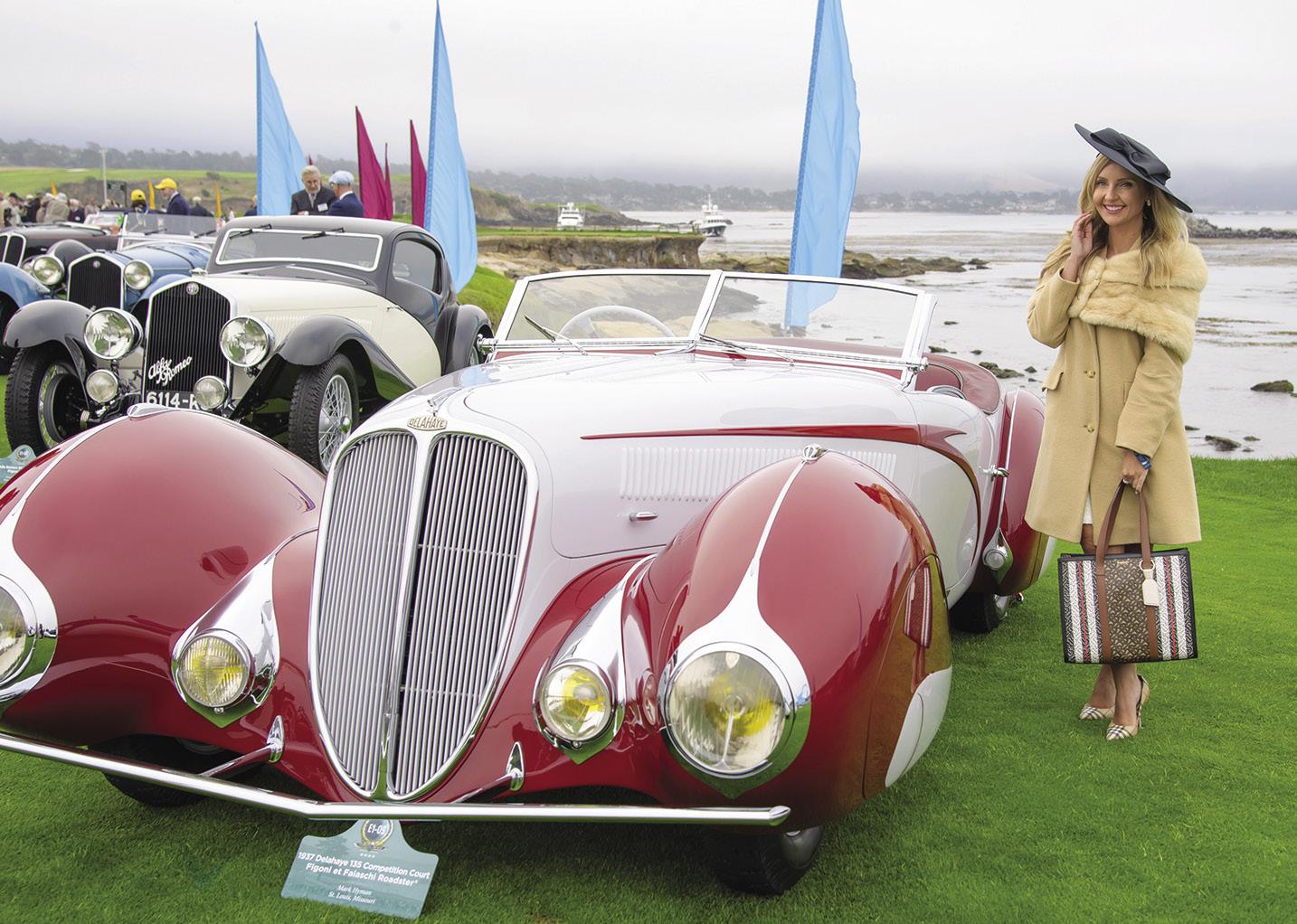

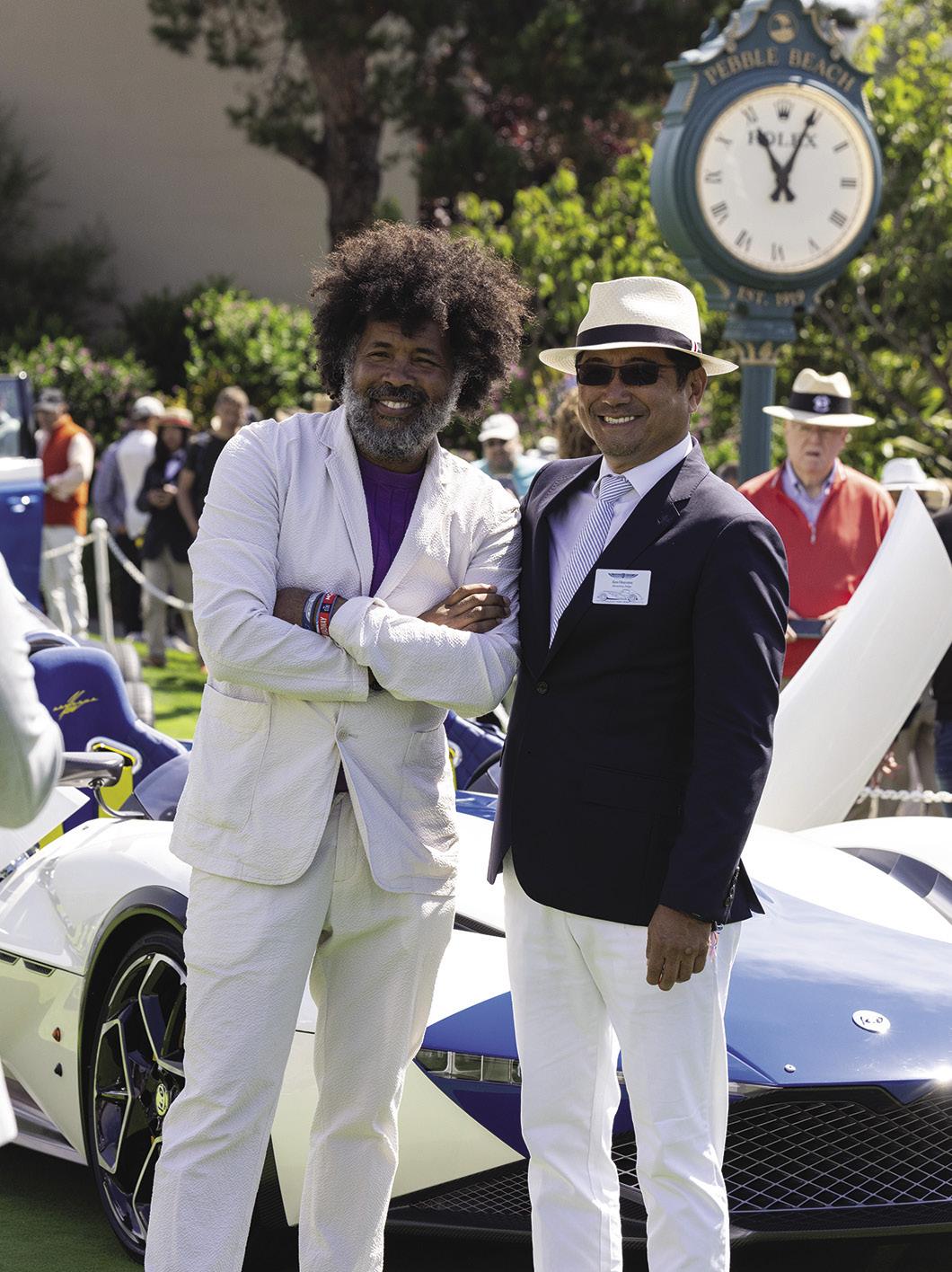
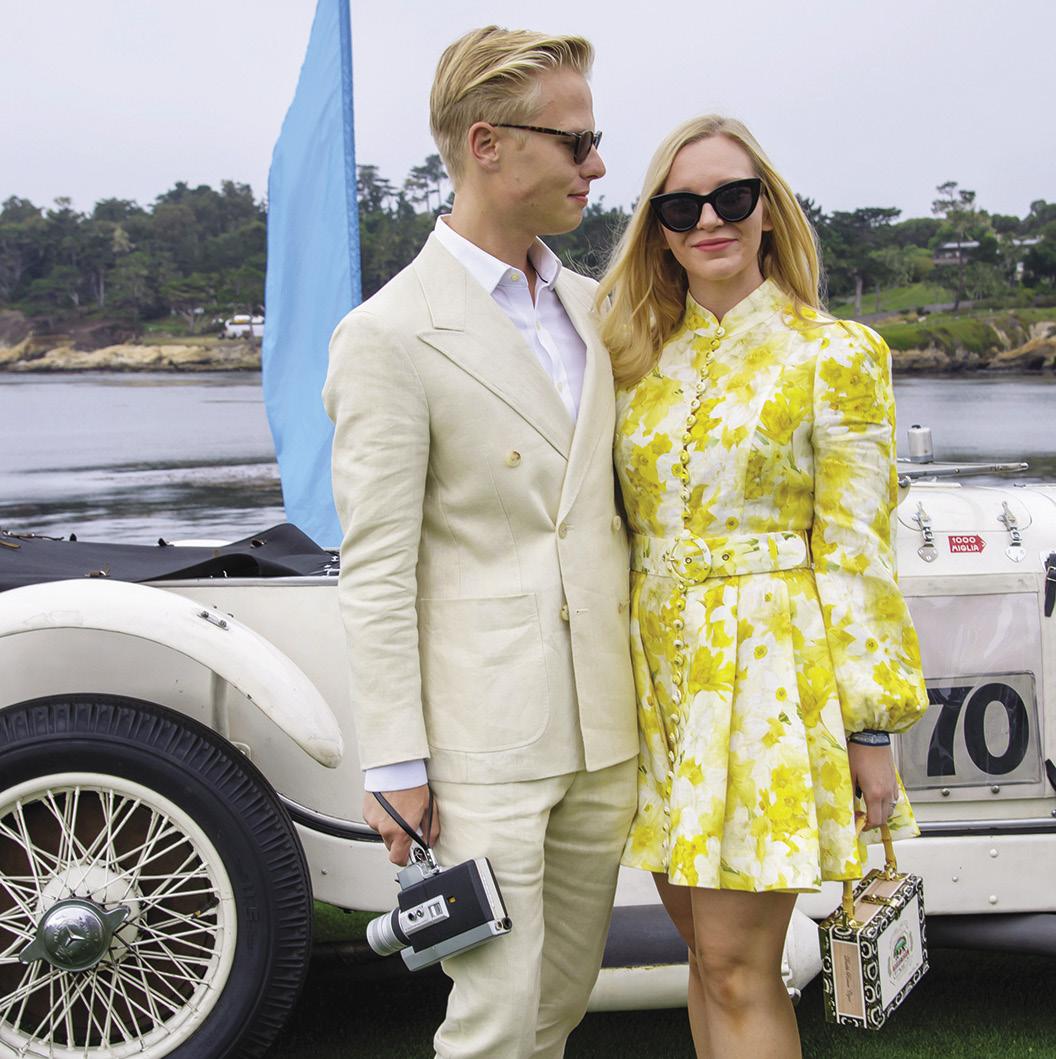
 Above: Wes and Victoria Anderson prove that style is all about the details!
Left: Splashed with colors to match the Ferraris shown on the first fairway of the Pebble Beach Golf Links.
Ken Okuyama holds court on the concept lawn, sharing his Birdcage kode61 with model and fellow collector car enthusiast XXXX Elo.
Shelby Knick helps to accent the magnificent pipes of the Keller Collection’s 1908 Benz Grand Prix race car.
Isabella Gillespie admires the dramatic style of Mark Hyman’s 1937 Delahaye 135 Competition Court Figoni et Falaschi Roadster.
Above: Wes and Victoria Anderson prove that style is all about the details!
Left: Splashed with colors to match the Ferraris shown on the first fairway of the Pebble Beach Golf Links.
Ken Okuyama holds court on the concept lawn, sharing his Birdcage kode61 with model and fellow collector car enthusiast XXXX Elo.
Shelby Knick helps to accent the magnificent pipes of the Keller Collection’s 1908 Benz Grand Prix race car.
Isabella Gillespie admires the dramatic style of Mark Hyman’s 1937 Delahaye 135 Competition Court Figoni et Falaschi Roadster.
INSIDER 95
Pebble Beach Concours d’Elegance

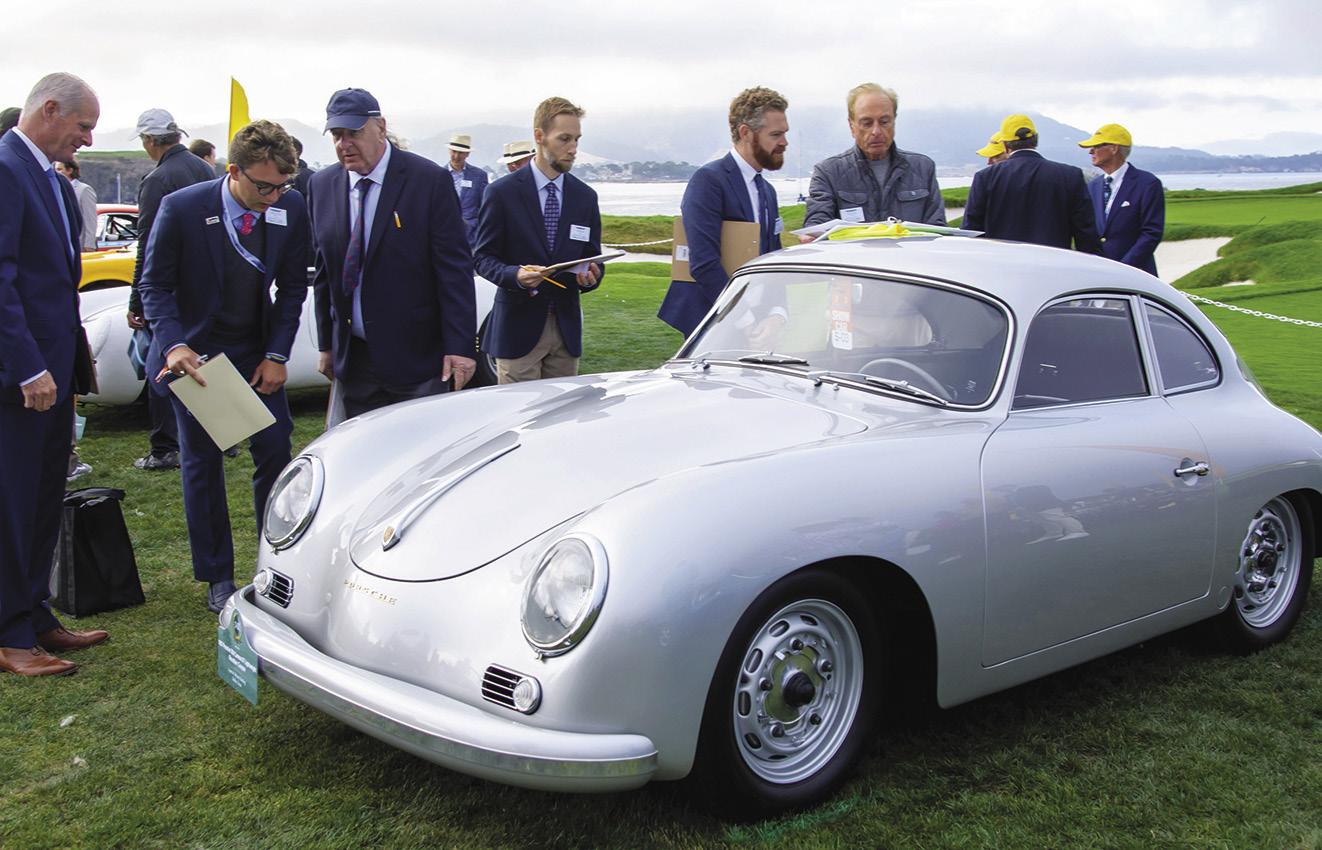
FRIENDS & FACES
Left: Lime green provides a nice accent to the papaya orange livery of the 1969 McLaren M8B-2 of Mouse Motors.
Below: At a special Forum session, Concours Chairman Sandra Button interviewed noted designer Gordon Murray.


SOCIAL SEEN
Above: Our Porsche judging team at work.
96 Pebble Beach Concours d’Elegance INSIDER
Right: The Figoni-bodied 1933 Alfa Romeo 6C 1750 Gran Sport of David and Adele Cohen strikes a lovely pose at the edge of Carmel Bay.

For more than 60 years, Reliable Carriers have transported everything from dream cars to daily drivers across the U.S. and Canada. With a variety of specialty haulers in our fleet, including 400+ fully-enclosed, air-ride-equipped transporters, we have both the capacity and the specialized equipment to move your unique automobile. We are proud to offer service that stands apart, capability that stands above and peace of mind that comes through 5 million dollars of insurance and GPS tracking on every load. That’s capability. That’s flexibility. That’s Reliability. 800.521.6393 reliablecarriers.com

PROUD SPONSOR OF THE PEBBLE BEACH CONCOURS d ’ELEGANCE® The Pebble Beach Concours d’Elegance Logo ® is a trademark and service mark of Pebble Beach Company. Used by permission.
WE ARE RELIABLE
63 YEARS OF PROVEN, QUALITY SERVICE.
CARRIERS. VEHICLES TAKEN SERIOUSLY.


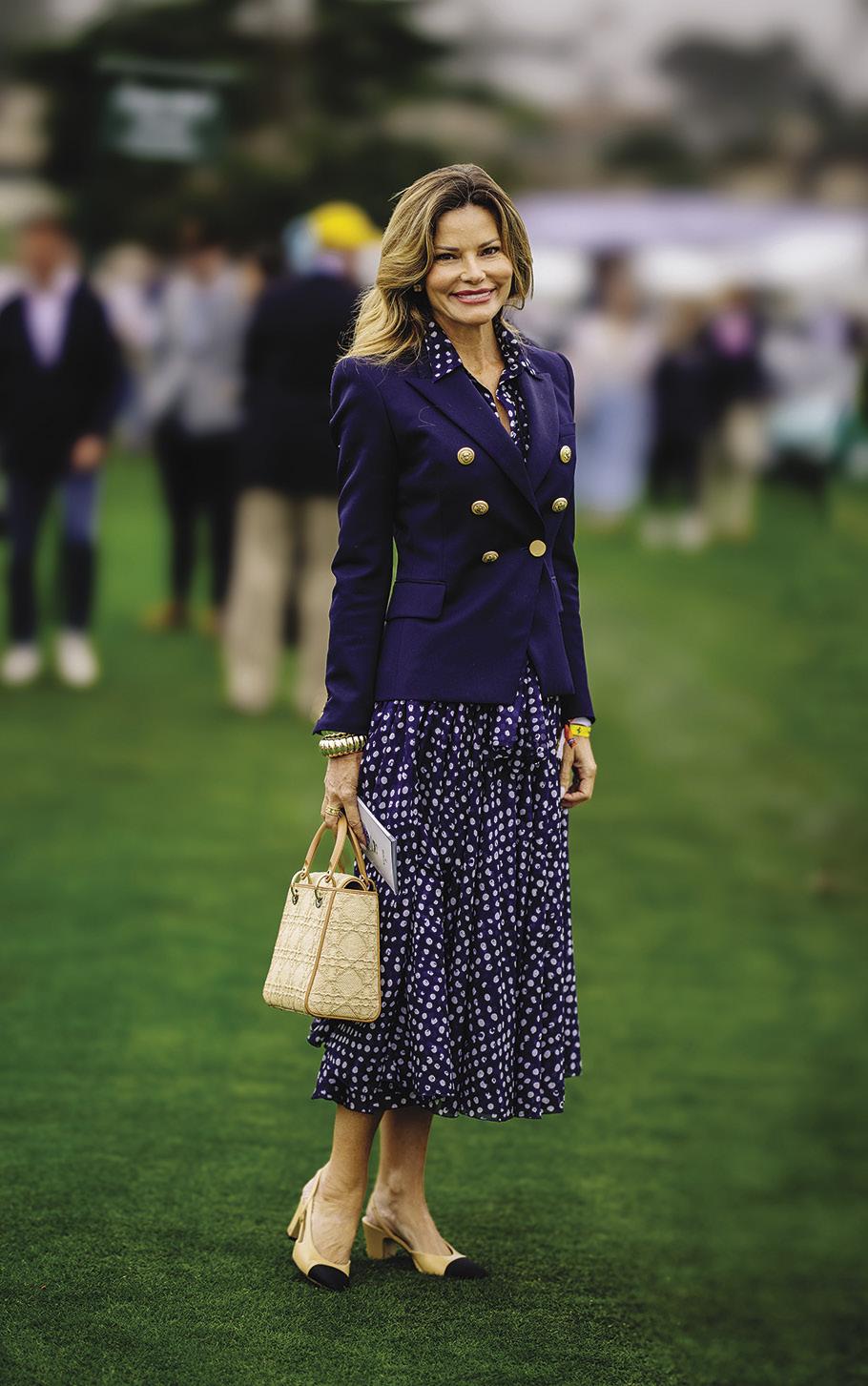

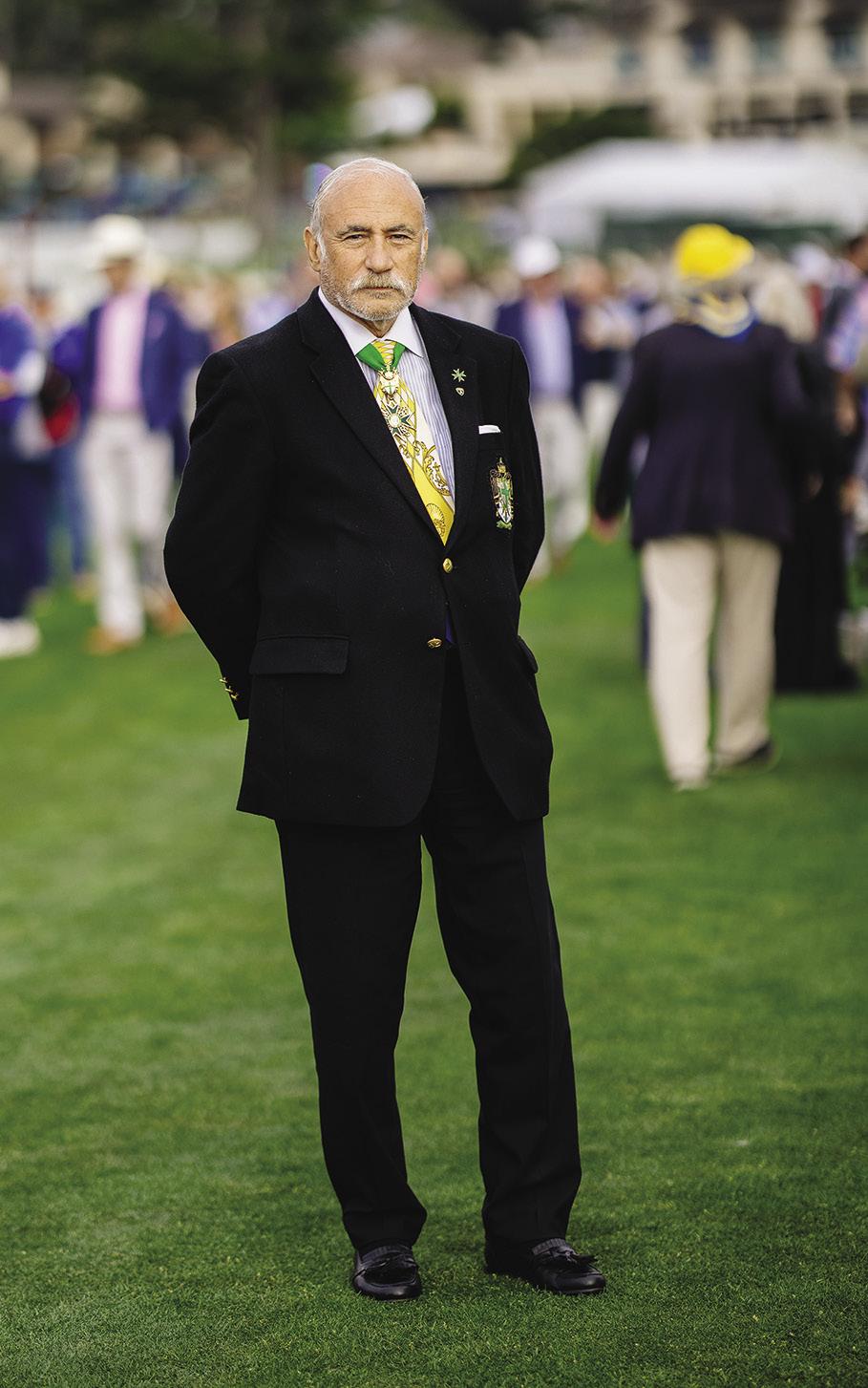

SOCIAL SEEN 98 Pebble Beach Concours d’Elegance INSIDER

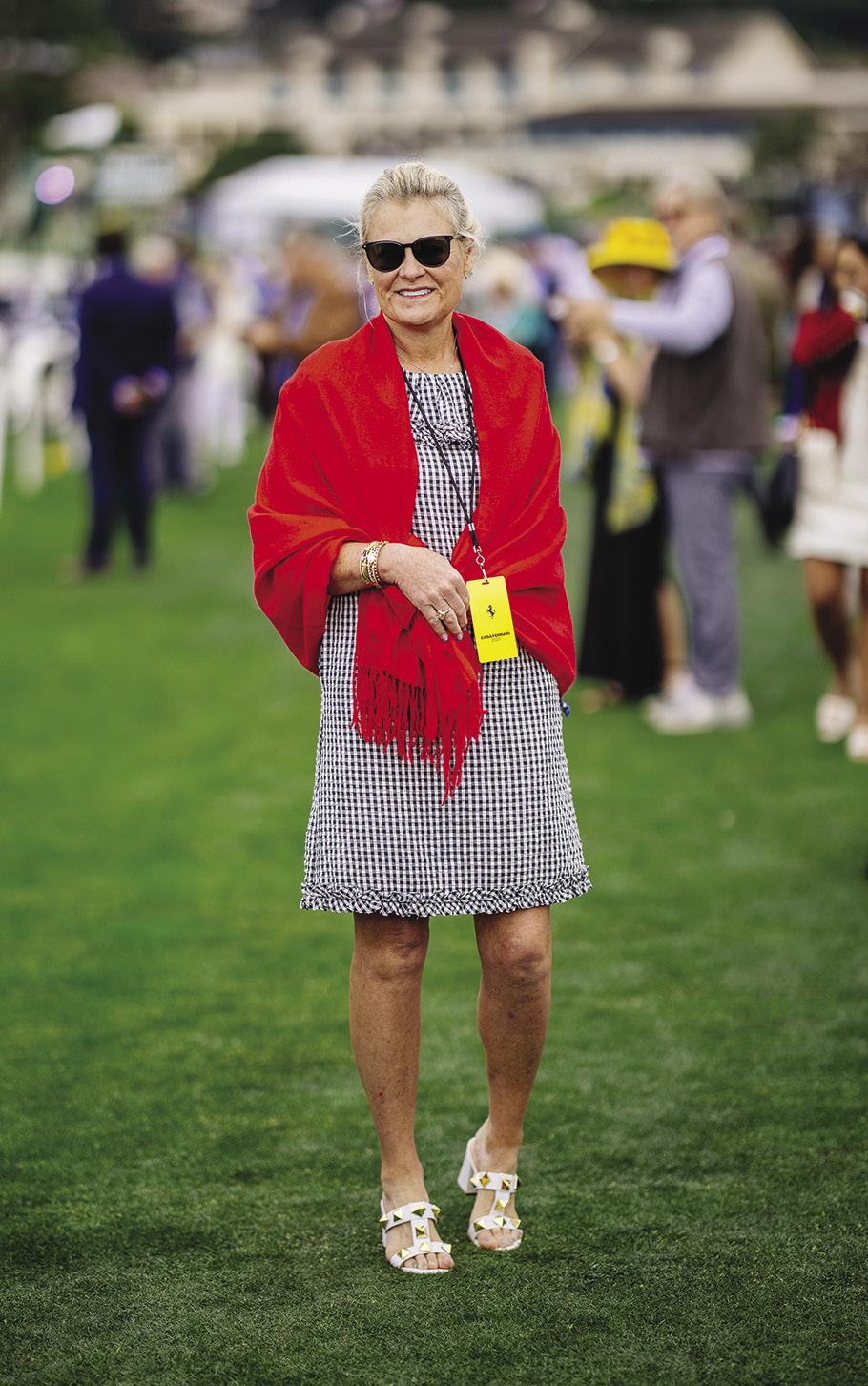


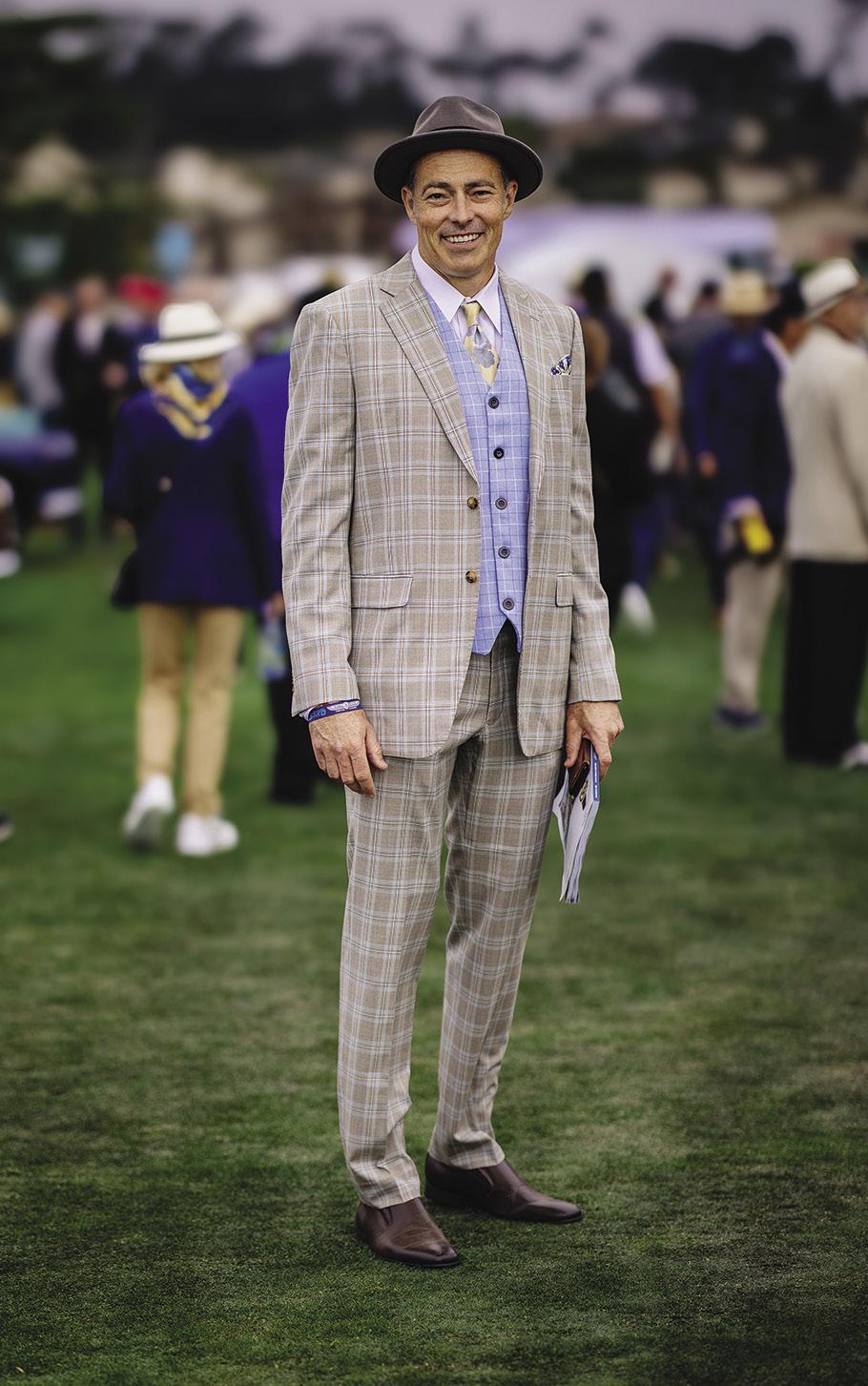
CONCOURS STYLE
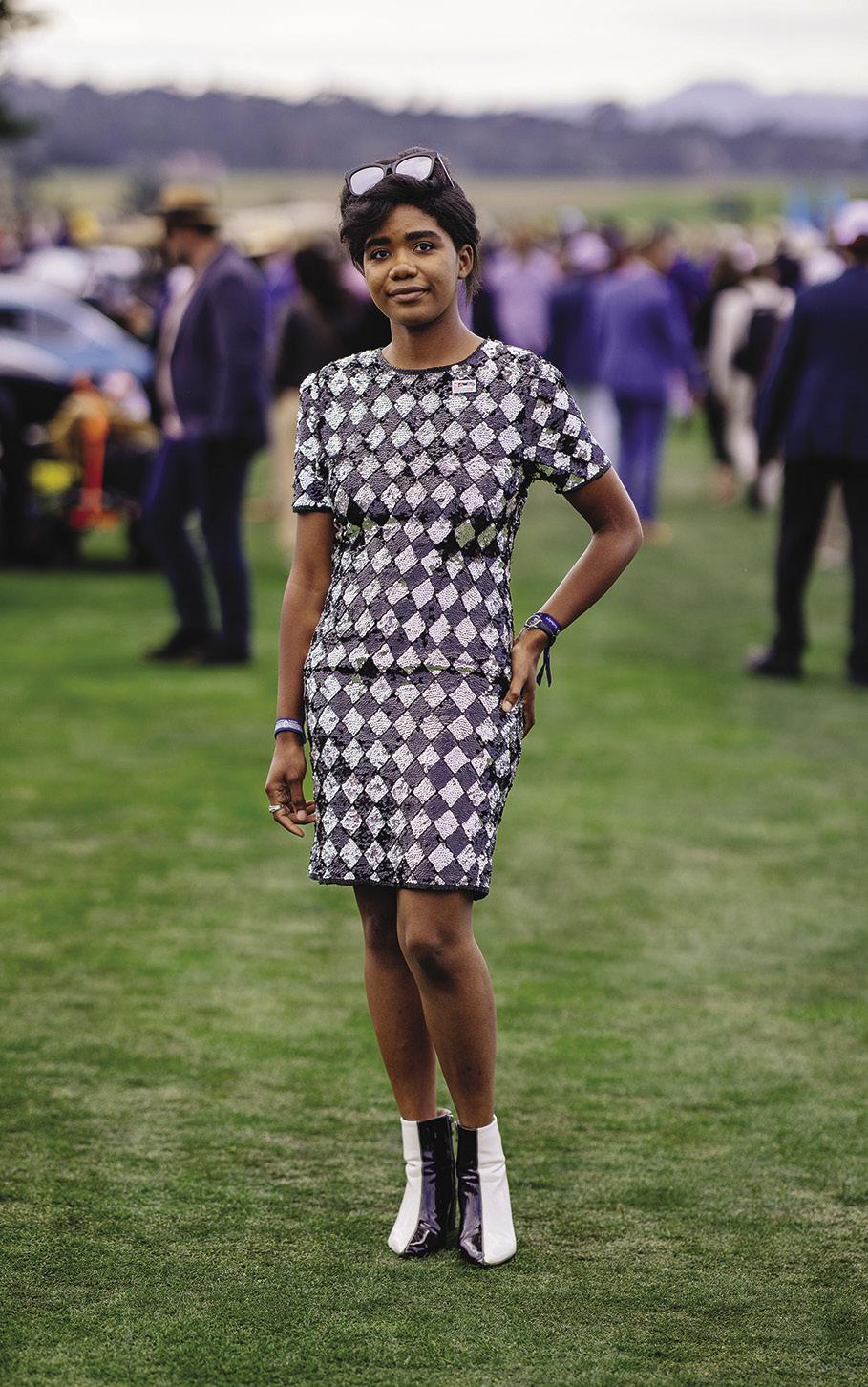
INSIDER 99
Pebble Beach Concours d’Elegance
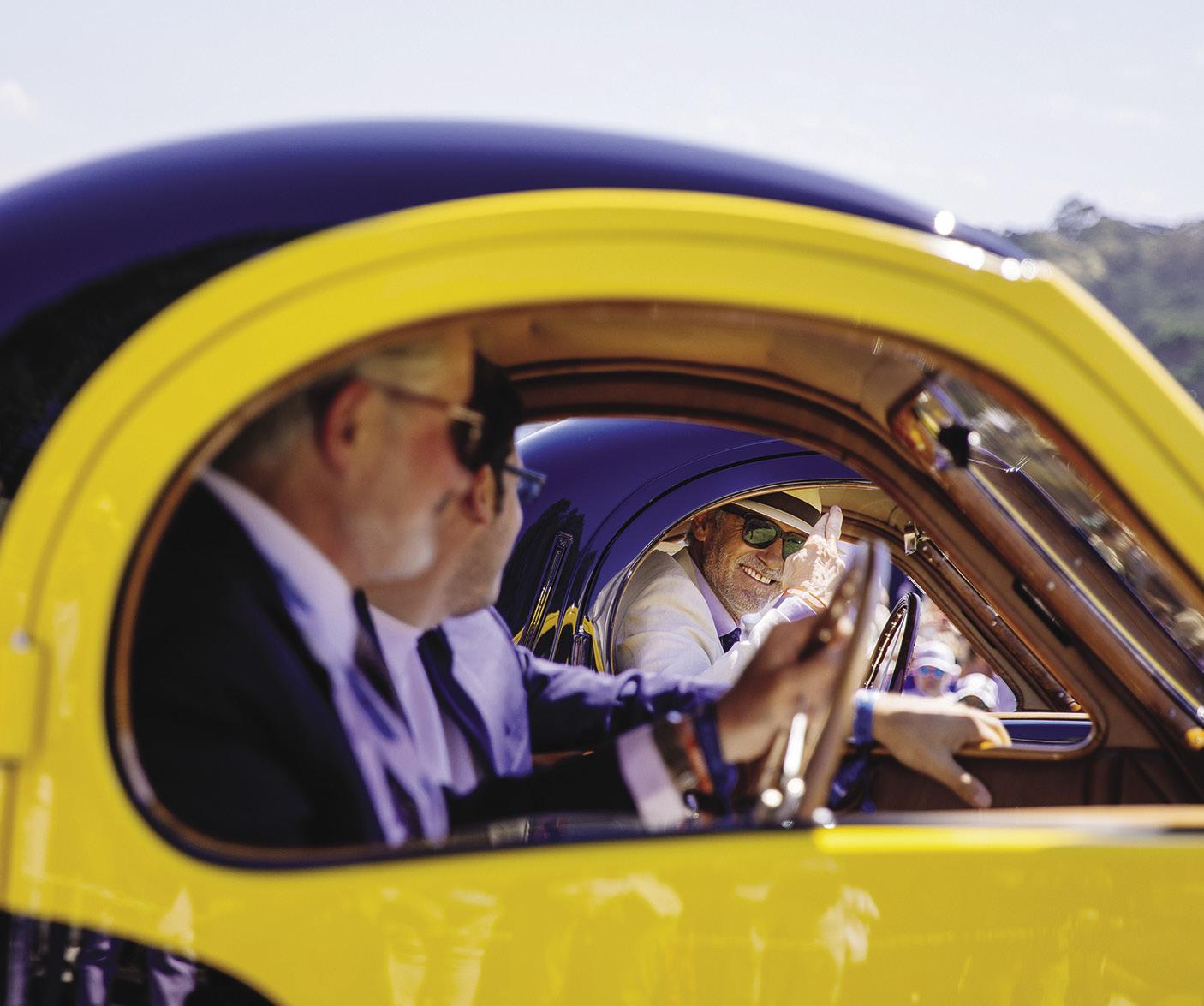
Chip Connor and Fritz Burkard wish each other good luck as they wait for the announcement of Bugatti Type 57 class winners.



FRIENDS & FACES
Above: New Master of Ceremonies Amanda Stretton gets a warm welcome from Tommy Kendall, Martin and Sandra Button, and Justin Bell.
Top Right: Alois Ruf and his family celebrate the class win of their 1963 Porsche 901 Prototype “Quickblau” Karmann/Reutter Coupe.
Middle Right: Celebrating the win of the Auriga Collection’s 1930 Mercedes-Benz 710 SS Special Roadster. Right: Red hot!

SOCIAL SEEN
100 Pebble Beach Concours d’Elegance INSIDER
MONTEREY | 16–17 AUGUST 2024
THE ANNUAL RETURN TO MONTEREY CAR WEEK, WHERE EXEMPLARY, REMARKABLE, AND RARE ARE THE RULE WITHOUT EXCEPTIONS
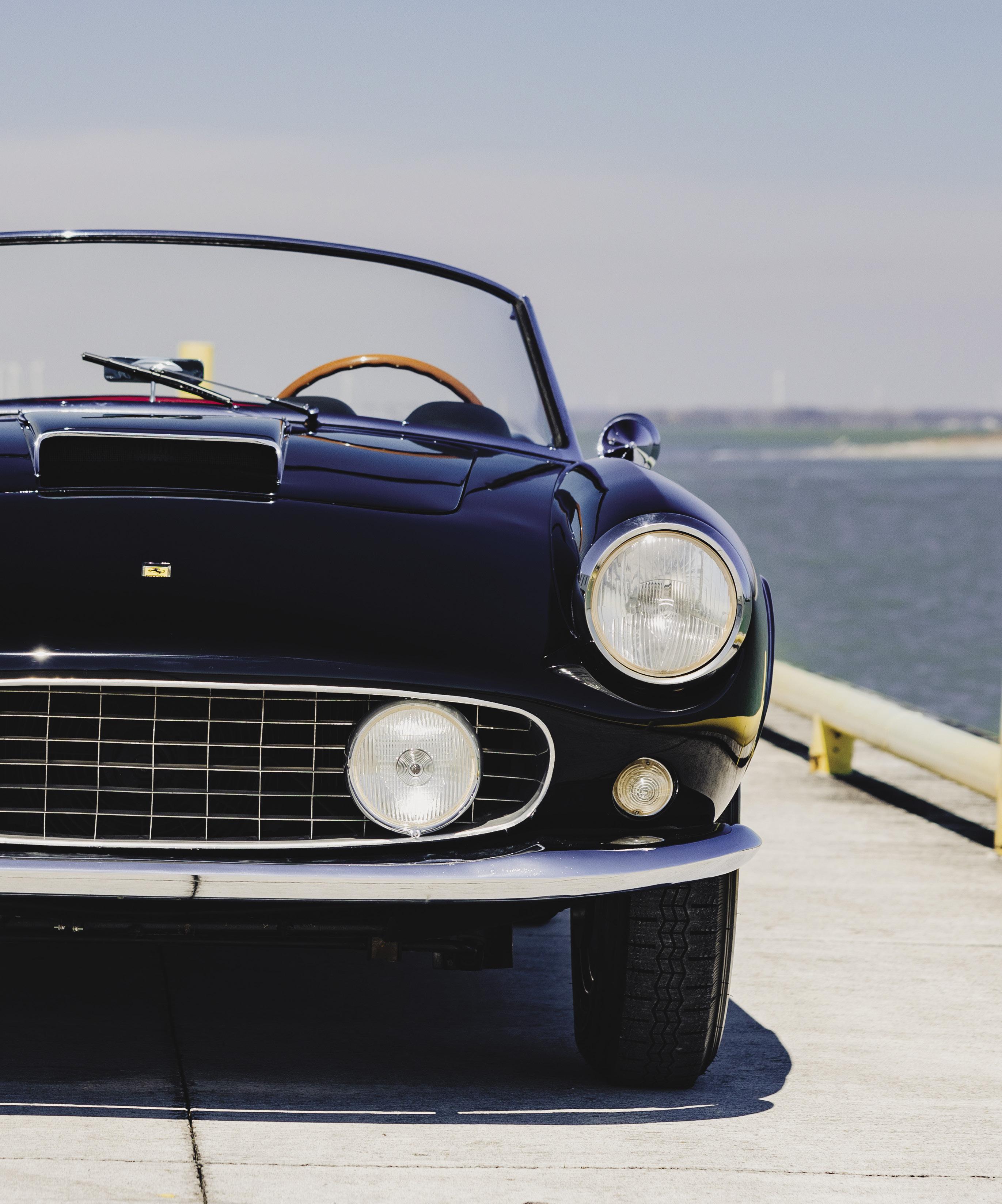

Consignment: OFFERED WITHOUT RESERVE
CALIFORNIA
310 559 4575 HEADQUARTERS +1 519 352 4575 FLORIDA +1 954 284 4575 info@rmsothebys.com CONSIGN TODAY
1959
RM Sotheby’s Lic. No. 84391
+1
Early
Ferrari 250 GT LWB California Spyder Estimate: $5,550,000 - $6,500,000 USD
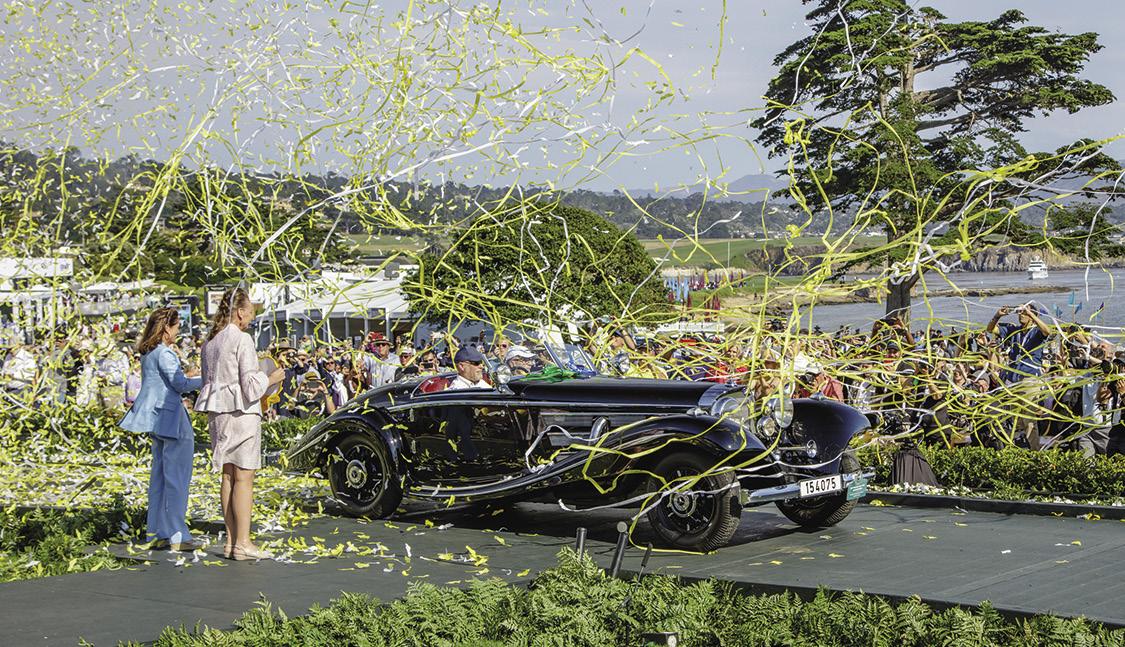
73 RD PEBBLE BEACH CONCOURS d ’ELEGANCE
On Sunday, August 18, over 200 of the most prized collector cars in the world roll onto the 18th fairway of Pebble Beach Golf Links—where they strive to be recognized as the best. The automobiles are judged for their historical accuracy, their technical merit, and their style, and the best garner reward and recognition.
Time/Date: 7 am to 5 pm, Sunday, August 18
Location: The Lodge at Pebble Beach and the 18th fairway of Pebble Beach Golf Links
Schedule: Dawn: Show field opens to car entrants
5:30 am: Show field opens to spectators with a credential
8 am: Judging Commences 1:30 to 5 pm: Awards Ceremony & Charity Drawing
General Admission Tickets are $495 through July 31 and $595 thereafter.VIP tickets range from $1,100 to $4,500. All tickets can be purchased online at pebblebeachconcours.net/tickets.

26 TH PEBBLE BEACH TOUR d ’ELEGANCE
presented by Rolex
On the Tour, Concours participants trace portions of scenic 17-Mile Drive and Highway One from Pebble Beach to Big Sur and back, showcasing elegance in motion for all to enjoy.
Time/Date: 9:30 am to 2 pm, Thursday, August 15
Schedule: 7 am: Cars line up on Portola Road near Pebble Beach Golf Academy
9:30 and 9:45 am: Cars depart, tracing portions of 17-Mile Drive and Highway One
Noon: Cars return to Pebble Beach
Noon to 2 pm: Participants enjoy a luncheon at Mercedes-Benz
Spectators welcome; for a map of the Tour d’Elegance route, go to pebblebeachconcours.net/tour.

PEBBLE BEACH MOTORING CLASSIC
The Motoring Classic is the ultimate road trip for enthusiasts, winding down the West Coast from Seattle to Pebble Beach, arriving just in time for Pebble Beach Automotive Week. The scenic 1,500-mile route for the 19th annual trip climbs the Cascade Mountains, takes in Crater Lake, and crosses the Golden Gate Bridge.
Dates: Monday, August 5 to Wednesday, August 14
Location: Woodmark Hotel in Kirkland, Washington to The Lodge at Pebble Beach
Schedule: August 5: Participants gather in Kirkland, Washington
August 6: 8:30 am Departure from the Woodmark Hotel
August 14: 4 pm Arrival at Casa Palmero at Pebble Beach
Spectators welcome for departure and arrival; times subject to change.
CALENDAR OF EVENTS 2024 Pebble Beach Automotive Week
102 Pebble Beach Concours d’Elegance INSIDER
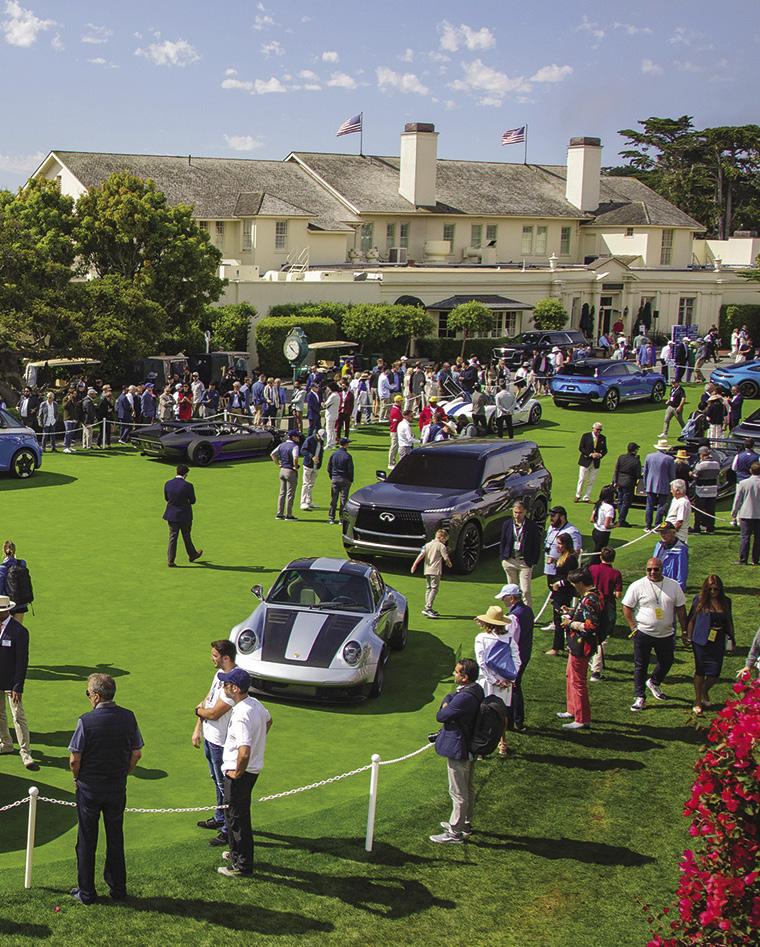
DISPLAYS, DEBUTS AND RIDE & DRIVES
Many automotive and luxury goods manufacturers will be hosting displays and unveiling new cars and concepts throughout Concours week. Ride & Drives will also be offered. Watch our website for the latest information regarding new car debuts and other exciting events.
Dates: Thursday, August 15 to Sunday, August 18, subject to individual manufacturer.
Location: Concours Village near the Pebble Beach Golf Academy, as well as the first and third fairways of Pebble Beach Golf Links and nearby locales beginning on Thursday, August 15.
The Concept Lawn, featuring the latest concepts and new cars, is held on the practice putting green in front of The Lodge at Pebble Beach in tandem with the Concours on Sunday, August 18. Cars load onto the Concept Lawn beginning in the afternoon on Saturday, August 17.
Most exhibits are open to the public without a fee.
PEBBLE BEACH AUCTIONS
presented by Gooding & Company
The Pebble Beach Auctions presented by Gooding & Company offer car collectors the opportunity to not only see but acquire automobiles of the highest quality, provenance, and design.
Viewings:
10 am to 6 pm, Wednesday, August 14
9 am to 6 pm, Thursday, August 15
9 am to auction’s end, Friday, August 16
9 am to auction’s end, Saturday, August 17
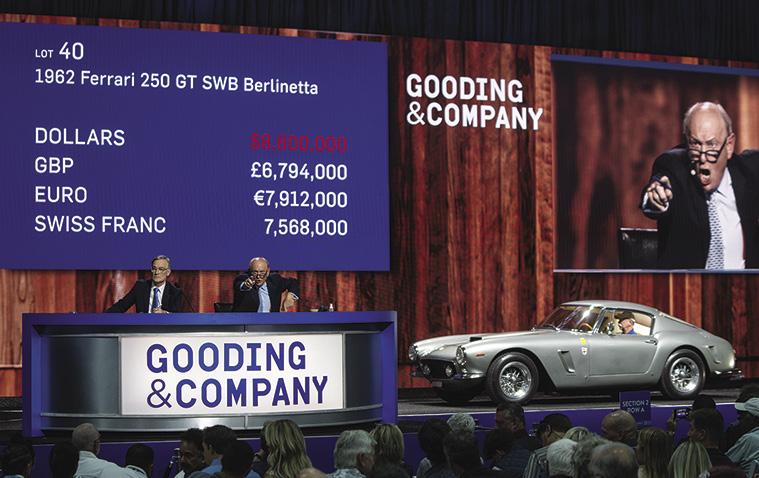
Auctions:
5 pm, Friday, August 16
11 am, Saturday, August 17
Location: Parc du Concours near the Pebble Beach Golf Academy
Fee of $50 admits one person to all auction events; purchase of catalog for $120 admits two to all auction events; bidder registration fee of $200 includes catalog, admission and reserved seating for two.

PEBBLE BEACH CLASSIC CAR FORUM
presented by Alliant Private Client
PEBBLE BEACH RETROAUTO
RetroAuto has established itself as a wellcurated marketplace for the true automotive enthusiast, showcasing rare collectibles, historic automobilia, art, and literature as well as luxury items, technological tools, and official Pebble Beach Concours d’Elegance merchandise.
Time/Dates: 9 am to 6 pm, Thursday, August 15 through Saturday, August 17, and 8 am to 6 pm, Concours Sunday, August 18
Location: Concours Village near the Pebble Beach Golf Academy
Open to the public without fee.
The Forum offers a series of must-see panels and interviews featuring luminaries of the automotive world. It also provides car enthusiasts with the opportunity to see, hear, and even meet their heroes. Forum sessions and panelists will be announced at pebblebeachconcours.net/forum.
Dates: Thursday, August 15 through Saturday, August 17

Location: Concours Village near the Pebble Beach Golf Academy
Purchase tickets early as most Forum sessions do sell out! Tickets go online in early summer and must be purchased in advance. For further information and to purchase tickets, please visit pebblebeachconcours.net/forum.
Pebble Beach Concours d’Elegance INSIDER 103
OUR SHARED LEGACY
Changing Lives & Caring for Great Cars

Some words, some deeds, some gifts have an impact that lasts far beyond the life of any one person—or even one longtime event. At the Pebble Beach Concours d’Elegance we hope to have an impact on both our local community and the car world that lasts long into the future.
Through our charitable giving, in partnership with Pebble Beach Company Foundation, we strive to support educational and advocacy efforts that truly better the lives of children and their families. We also partner directly with programs training the next generation of auto enthusiasts to create and care for great cars, while honoring great automotive leaders who have gone before us.
This past year, for example, we worked to vet and fund a new program at nearby Rancho Cielo teaching at-risk teens how to repair and restore collector cars. Contributions were made in memory of Don Williams, a leading automotive legend who participated in the Concours for over 50 years, sharing more cars than anyone else in his lifetime.
We invite you to join with us in these efforts.

We welcome your individual donations. We also welcome current and future gifts designated through financial plans, trusts or estates. For further information on planned giving, or to make a donation via wire or stock transfer, please contact Judith Ann Raible at jraible@pebblebeachconcours.net.
We hope you will join with us in making certain that our shared legacy continues long into the future.
We have been attending the Pebble Beach Concours for over 25 years and have watched Sandra evolve the show to become the premier concours in the world. That prominence and the charitable underpinning of the show was very appealing as we considered our personal philanthropic objectives.We want to see young people continue the great tradition of preserving classic cars and a great concours!
— MEG M c CARTHY, PEBBLE BEACH CONCOURS LEGACY DONOR
TRADITIONS
Charity Giving
Craig Kappel and Meg McCarthy shared a 1954 Mercedes-Benz 300 S Cabriolet at the 2023 Pebble Beach Concours, placing Third in Class.
Above: Rancho Cielo students Christian Vasquez and Anthony Trejo at work under the guidance of instructor Tom Forgette.
104 Pebble Beach Concours d’Elegance INSIDER


Crafted using the same innovative formula that brought us electrified supercars and multiple IMSA championships, the all-electric ZDX is available with Type S high-performance trim and an estimated 500 horsepower, proving that while what powers our cars may change, the energy of Precision Crafted Performance never will. Unlock the Energy.

ZDX Type S preproduction model shown with optional accessories. Production model may vary. ©2024 Acura. Acura, ZDX, Precision Crafted Performance, and the stylized “A” logo are registered trademarks of Honda Motor Co., Ltd.
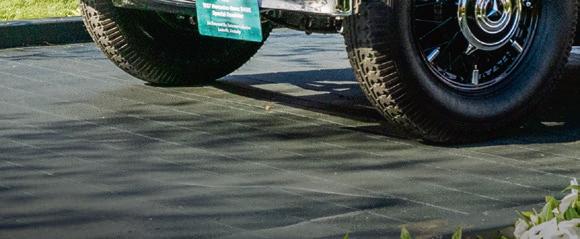


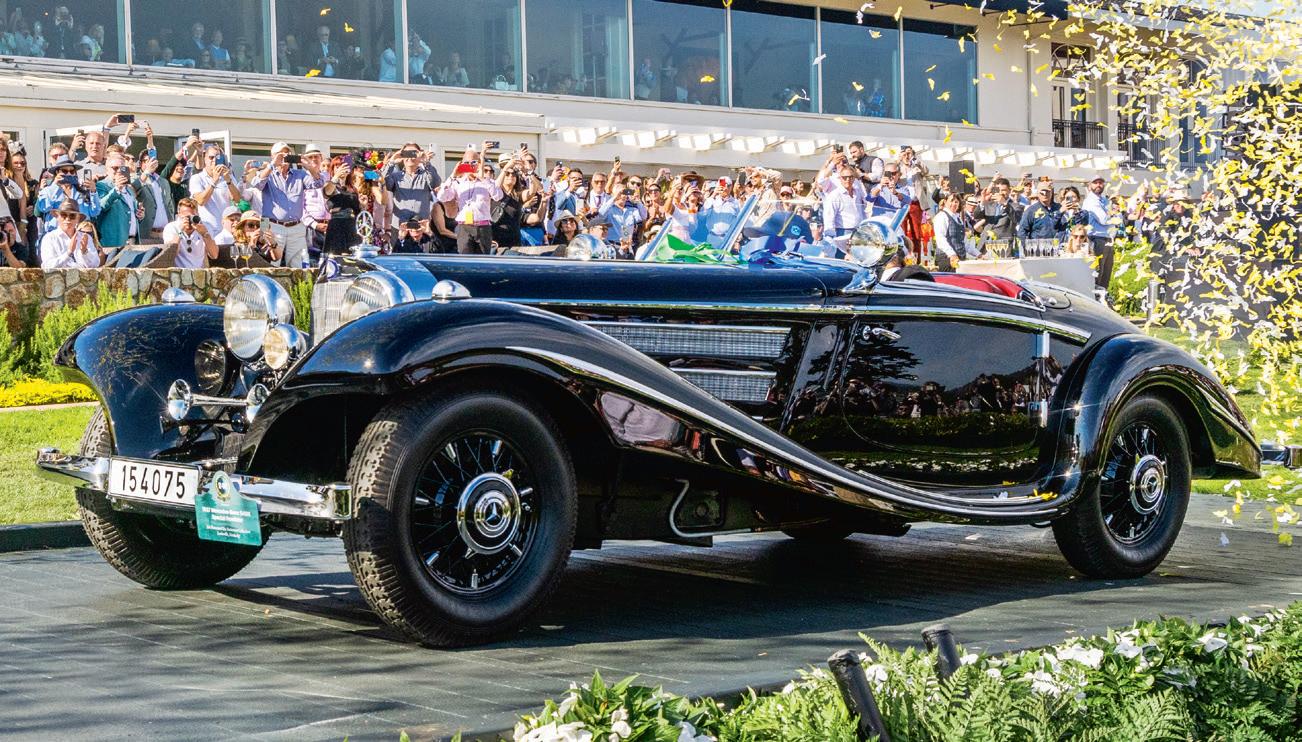





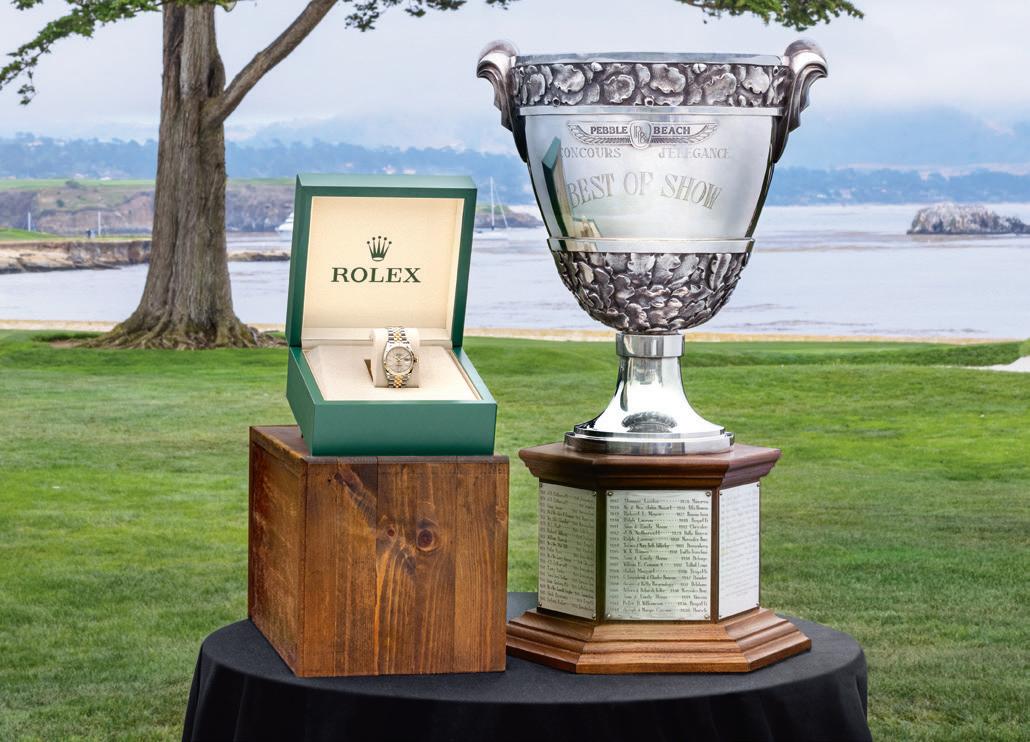






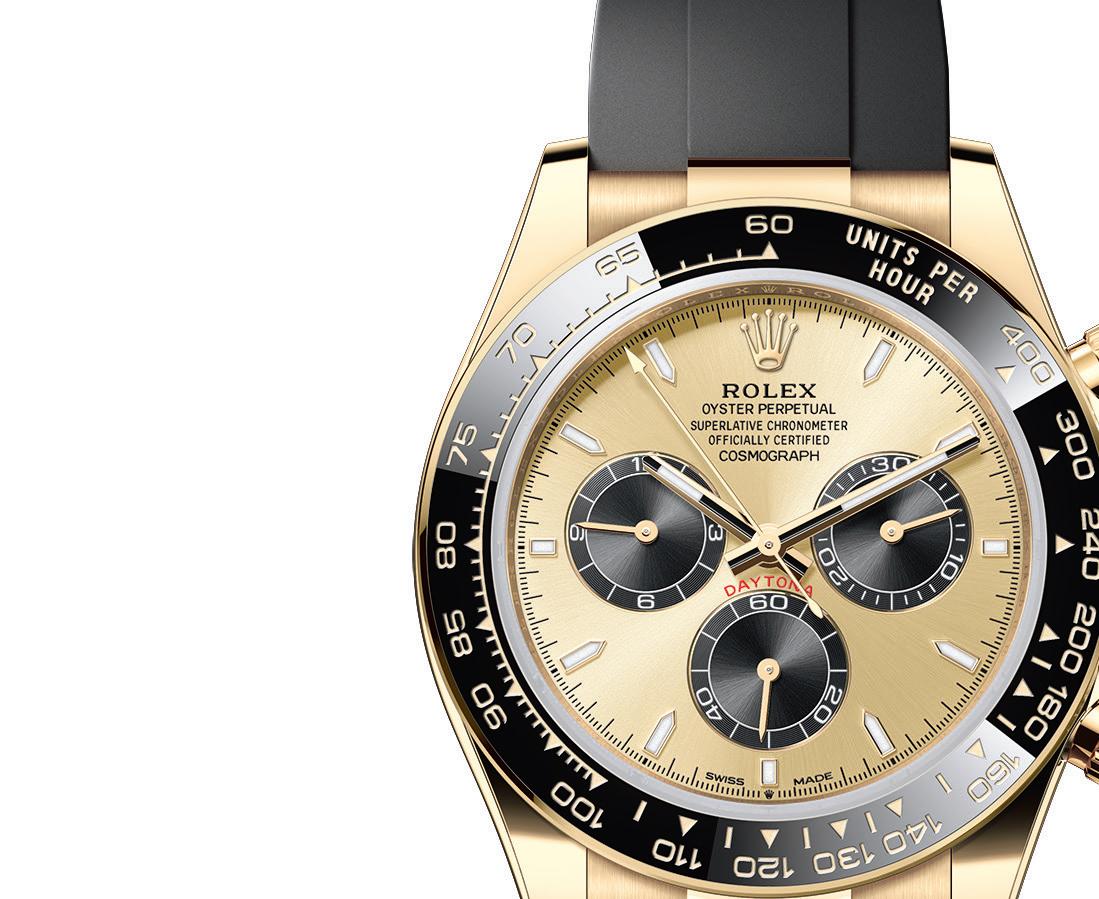
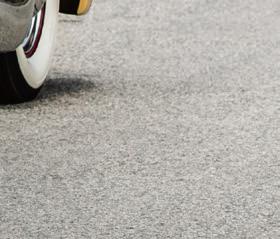
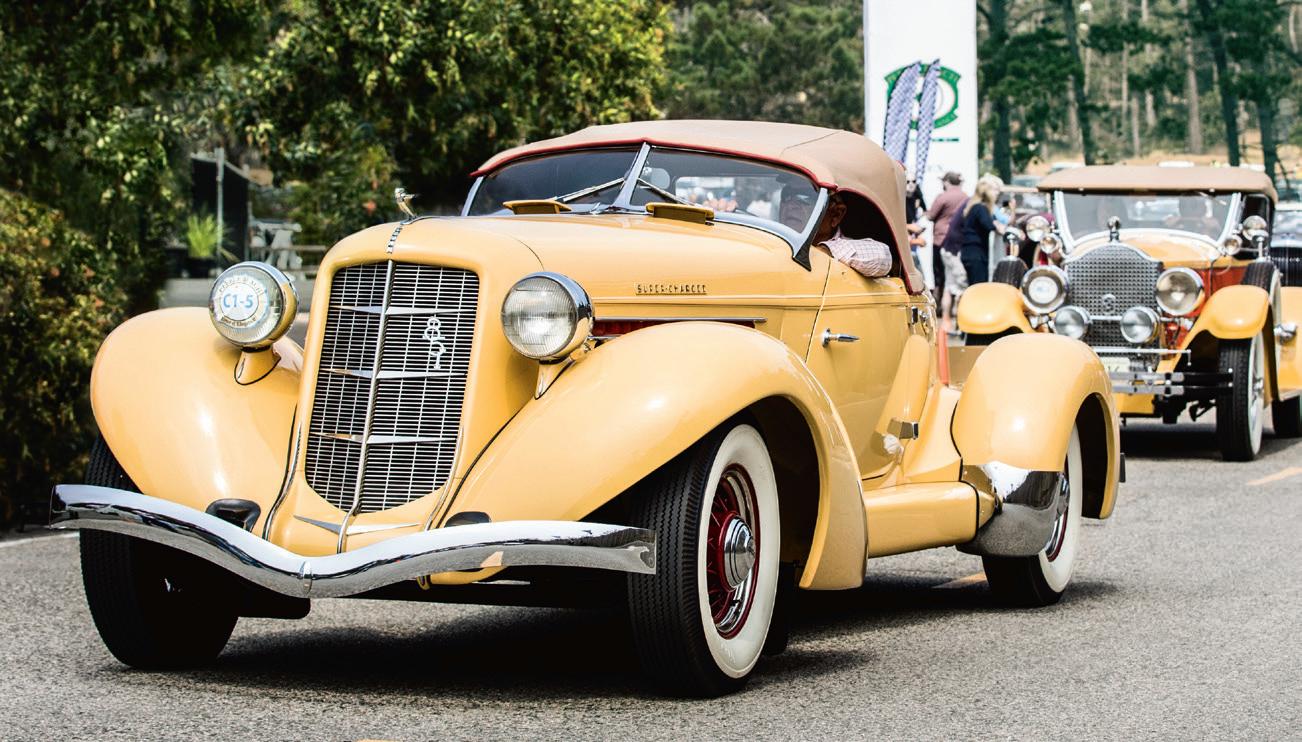











































 At the inaugural 1000 Miglia Experience in the UAE, Jacky often led the way in a 1968 Porsche 911.
Jacky (right) participates in the 2017 Kronos VW Fun Cup with his children (from left): Larissa, Vanina, Joy, Romain, and Clément.
At the inaugural 1000 Miglia Experience in the UAE, Jacky often led the way in a 1968 Porsche 911.
Jacky (right) participates in the 2017 Kronos VW Fun Cup with his children (from left): Larissa, Vanina, Joy, Romain, and Clément.


























































 Giorgetto Giugiaro in his studio.
Giorgetto Giugiaro in his studio.






















 The Lola driven by Amanda, Bob Berridge, and Gareth Evans heads into a turn amidst the 24 Hours of Le Mans in 2008.
liked the fact that I had small hands—and was willing to get them dirty!”
with Daddy. I would love for him to see me now—hosting the Pebble Beach Concours.”
The Lola driven by Amanda, Bob Berridge, and Gareth Evans heads into a turn amidst the 24 Hours of Le Mans in 2008.
liked the fact that I had small hands—and was willing to get them dirty!”
with Daddy. I would love for him to see me now—hosting the Pebble Beach Concours.”




















 Sandra Button with Oberoi Concours organizers Siddraj Singh and HH Manvendra Singh Barwani. Button served as Chief Judge.
Bedecked in beautiful saris, ladies from some of India’s royal houses peruse a custom Buick Electra.
Sandra Button with Oberoi Concours organizers Siddraj Singh and HH Manvendra Singh Barwani. Button served as Chief Judge.
Bedecked in beautiful saris, ladies from some of India’s royal houses peruse a custom Buick Electra.






























































 Above: Wes and Victoria Anderson prove that style is all about the details!
Left: Splashed with colors to match the Ferraris shown on the first fairway of the Pebble Beach Golf Links.
Ken Okuyama holds court on the concept lawn, sharing his Birdcage kode61 with model and fellow collector car enthusiast XXXX Elo.
Shelby Knick helps to accent the magnificent pipes of the Keller Collection’s 1908 Benz Grand Prix race car.
Isabella Gillespie admires the dramatic style of Mark Hyman’s 1937 Delahaye 135 Competition Court Figoni et Falaschi Roadster.
Above: Wes and Victoria Anderson prove that style is all about the details!
Left: Splashed with colors to match the Ferraris shown on the first fairway of the Pebble Beach Golf Links.
Ken Okuyama holds court on the concept lawn, sharing his Birdcage kode61 with model and fellow collector car enthusiast XXXX Elo.
Shelby Knick helps to accent the magnificent pipes of the Keller Collection’s 1908 Benz Grand Prix race car.
Isabella Gillespie admires the dramatic style of Mark Hyman’s 1937 Delahaye 135 Competition Court Figoni et Falaschi Roadster.























































